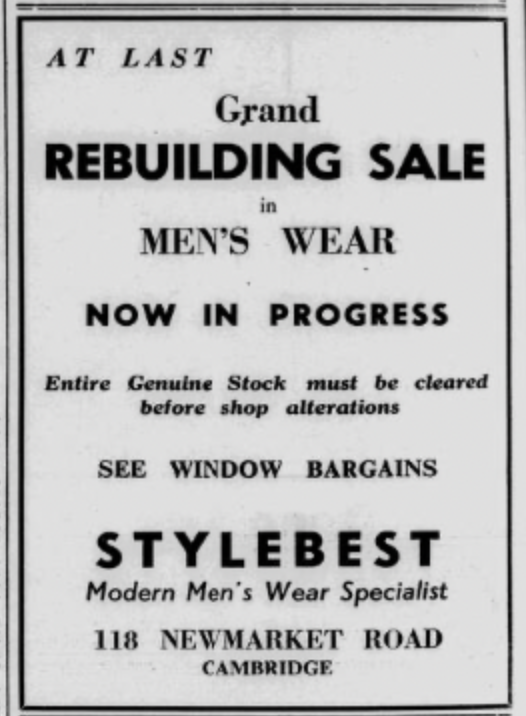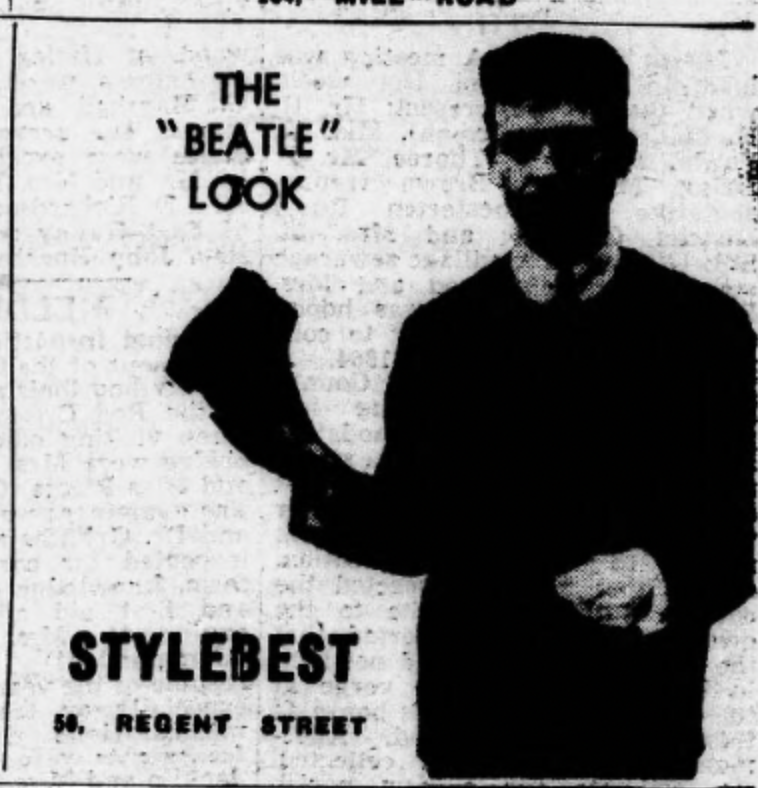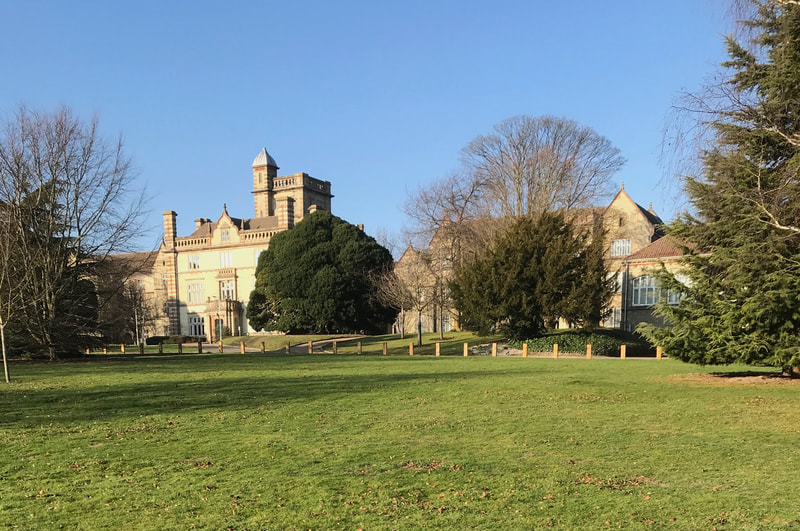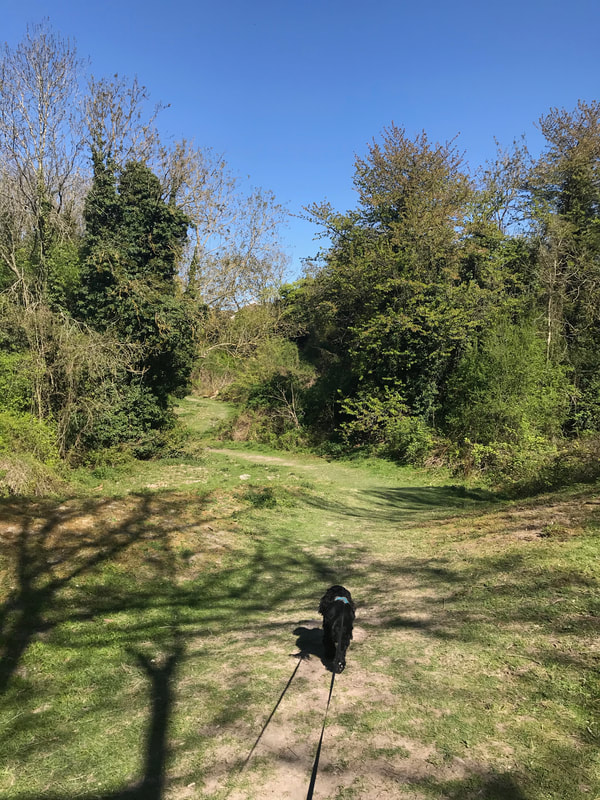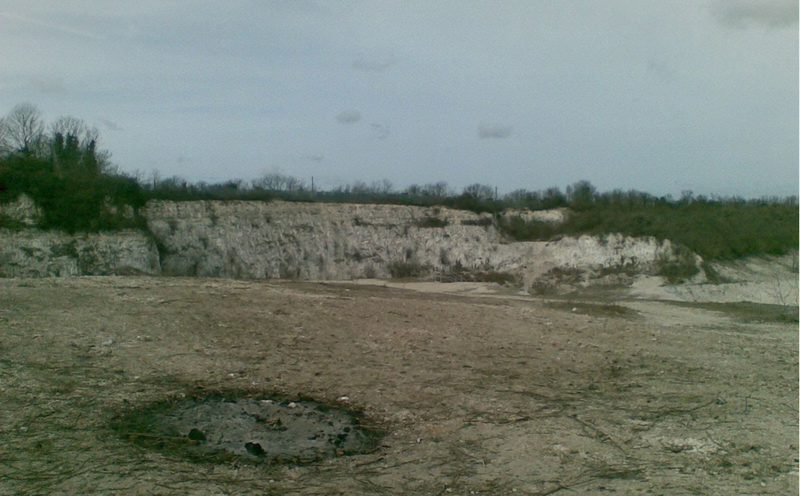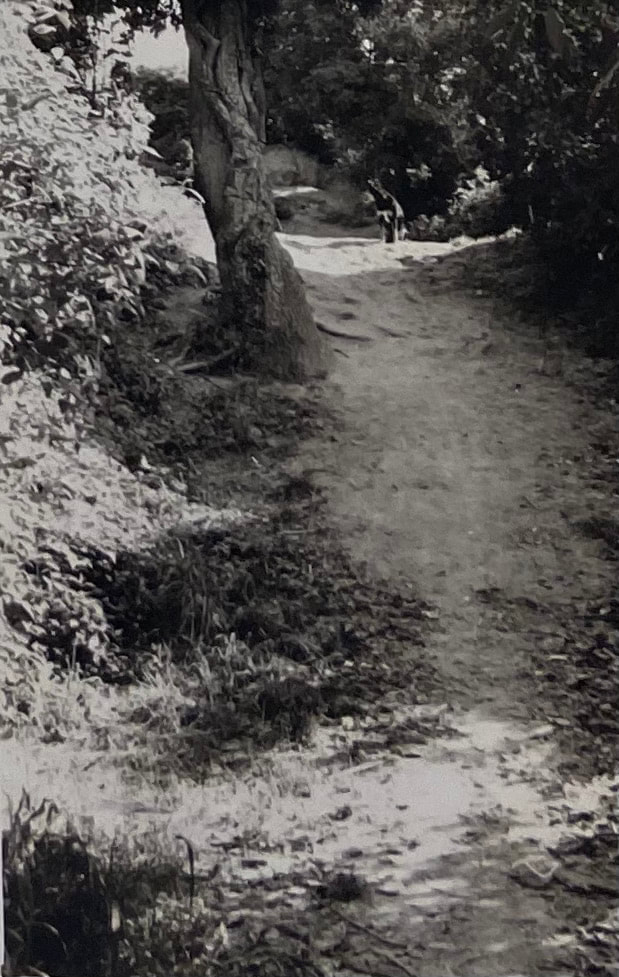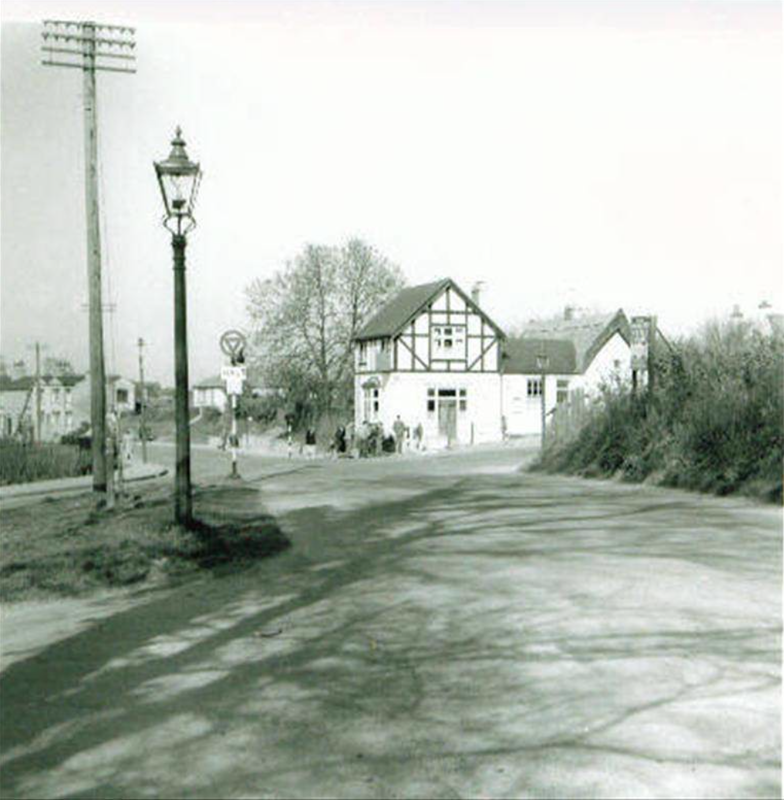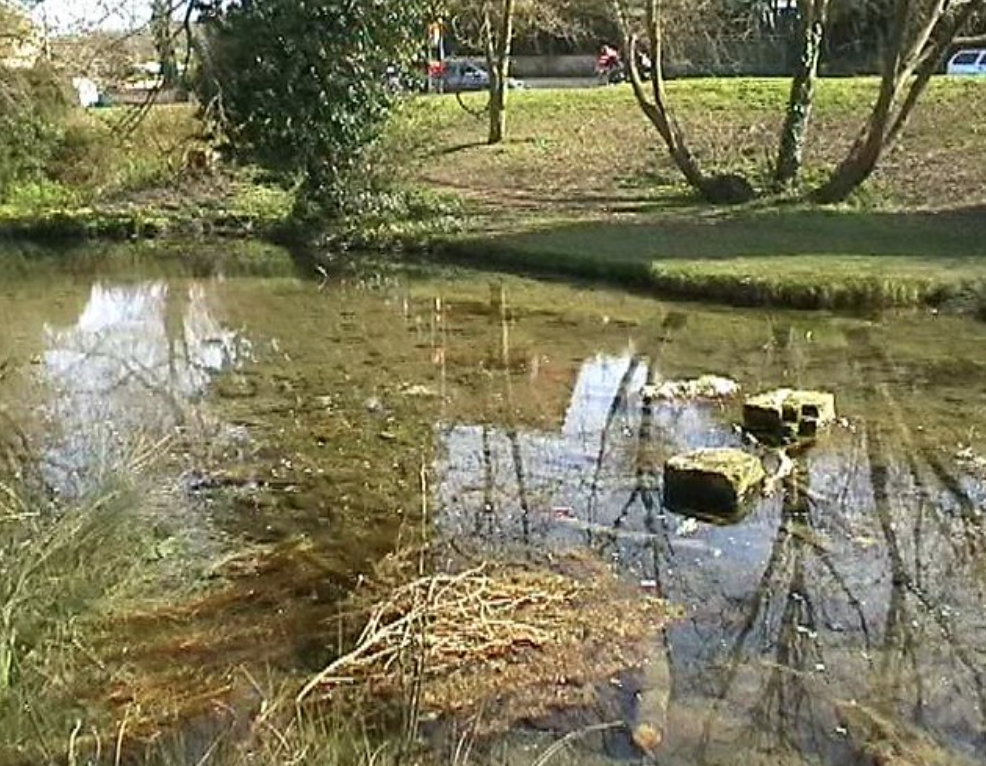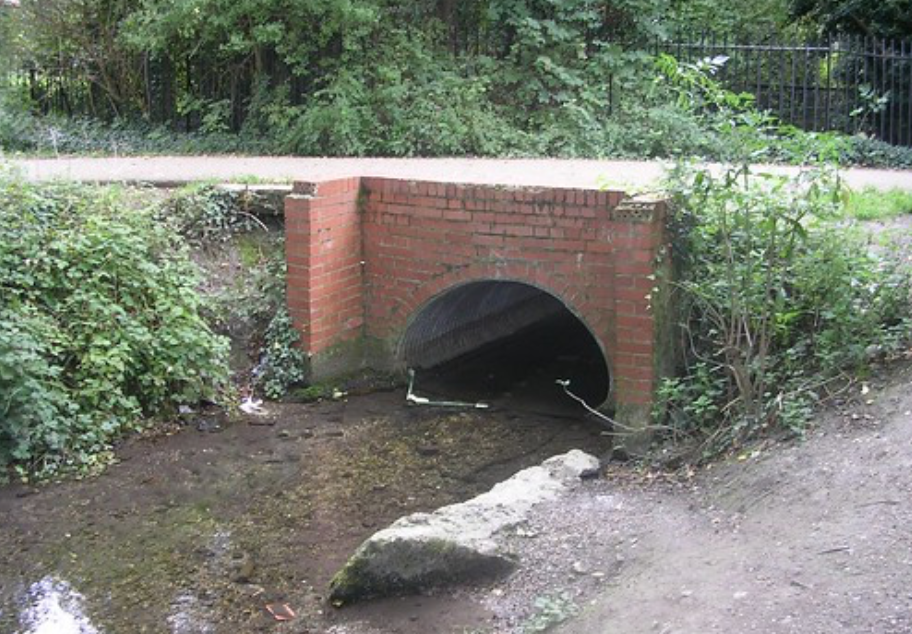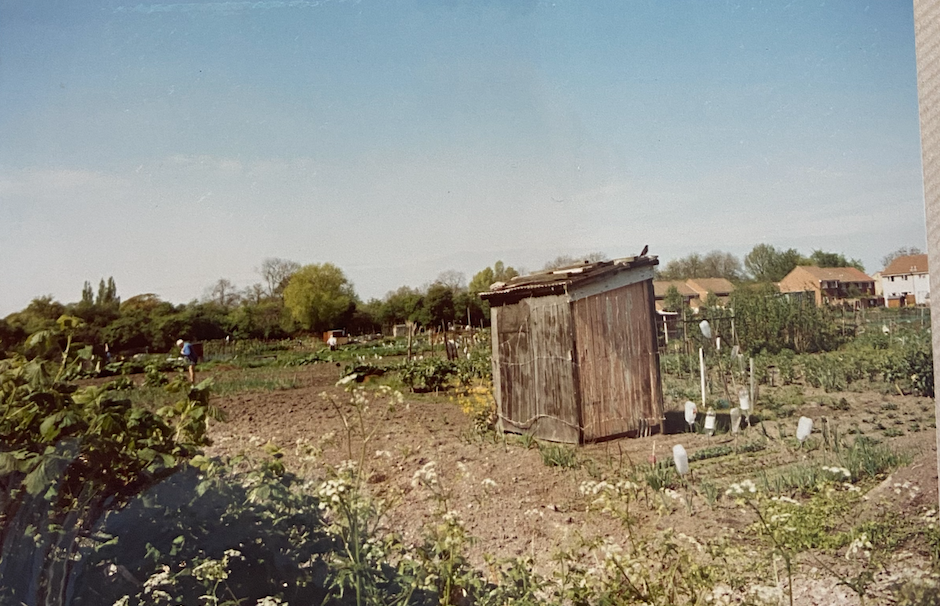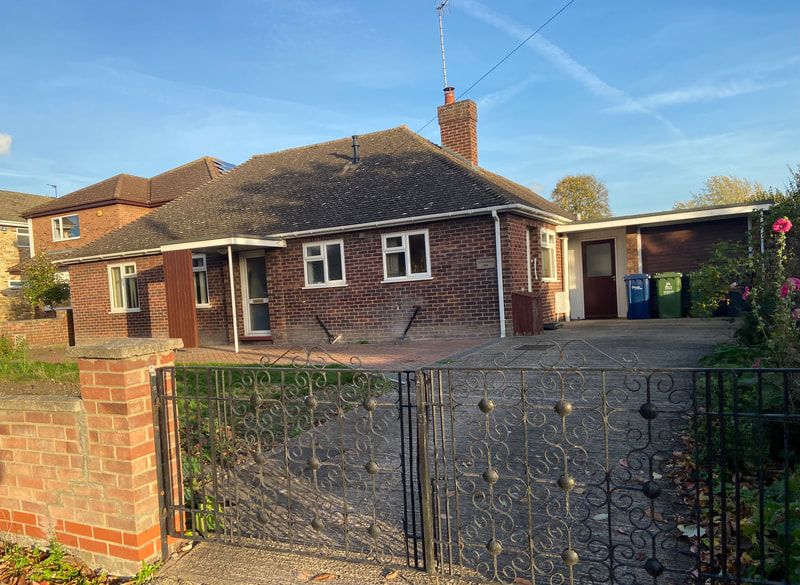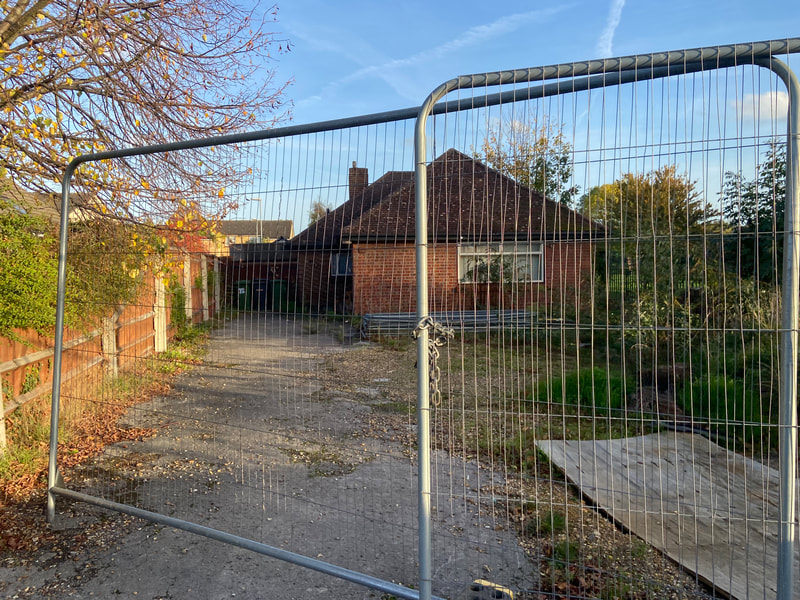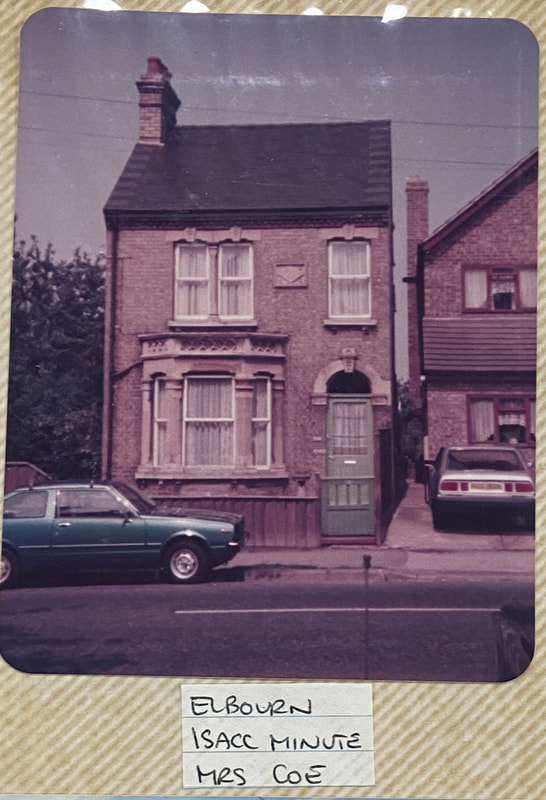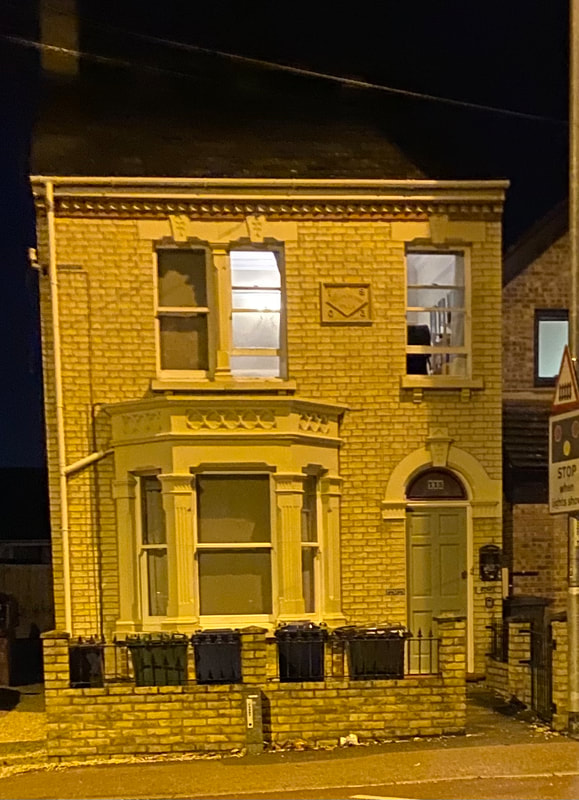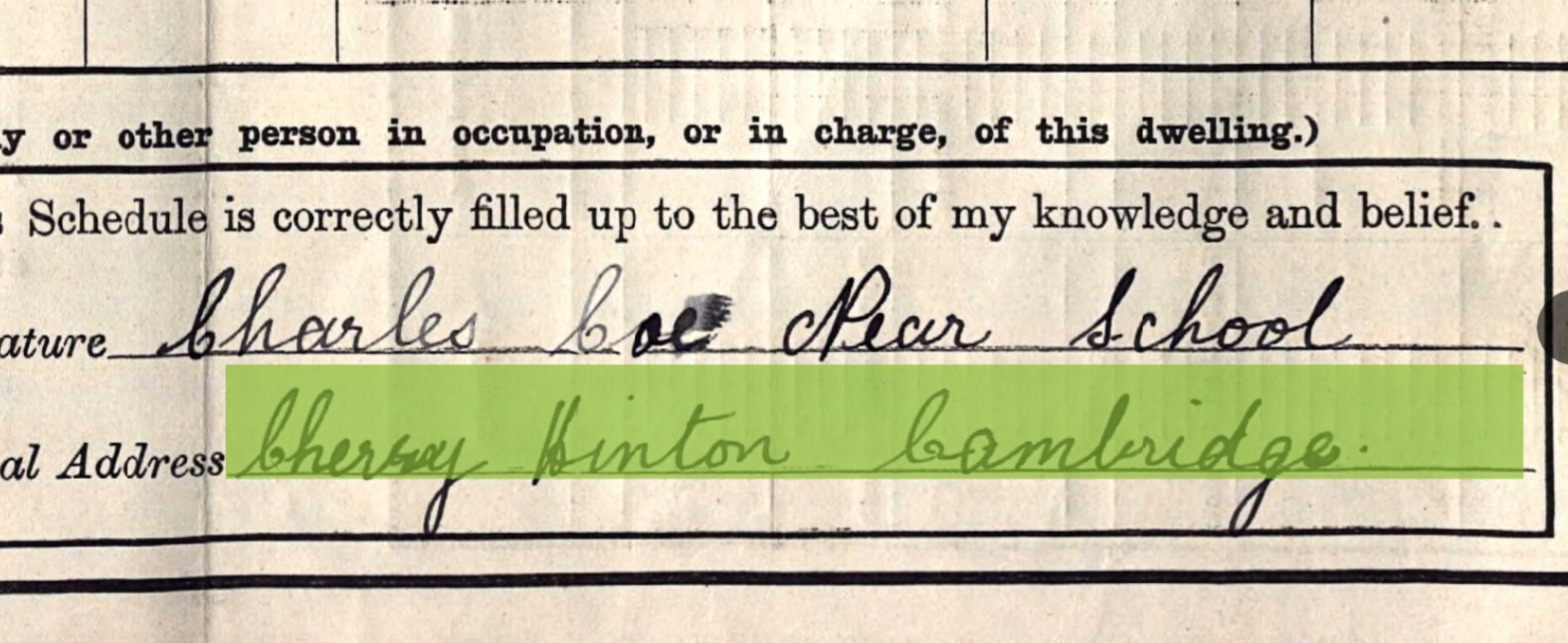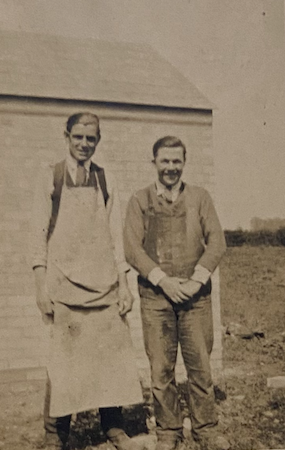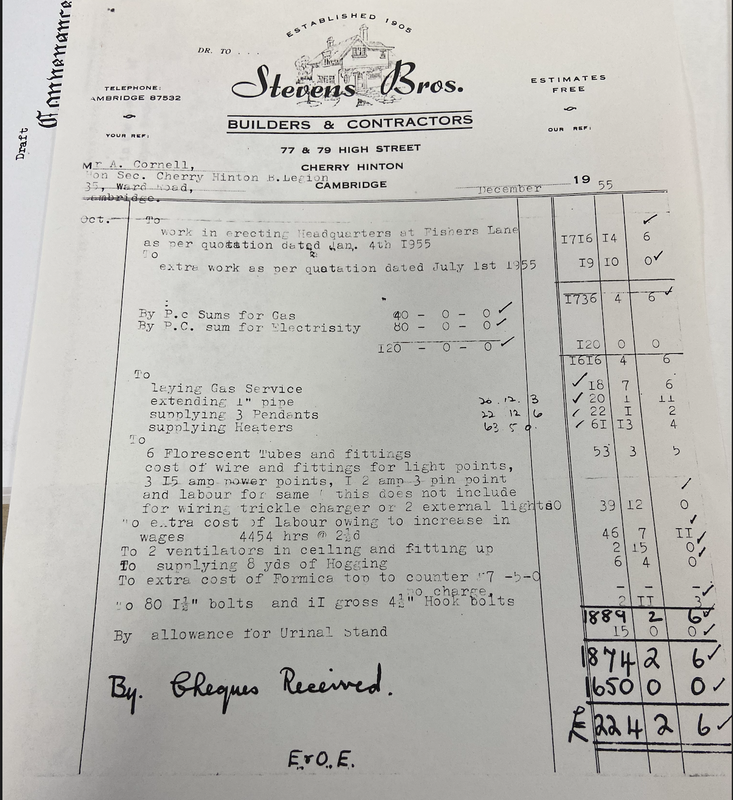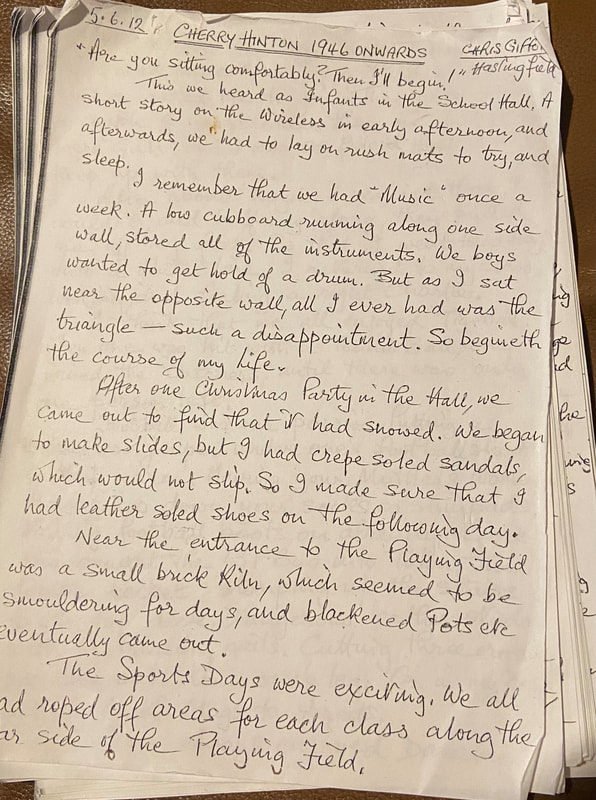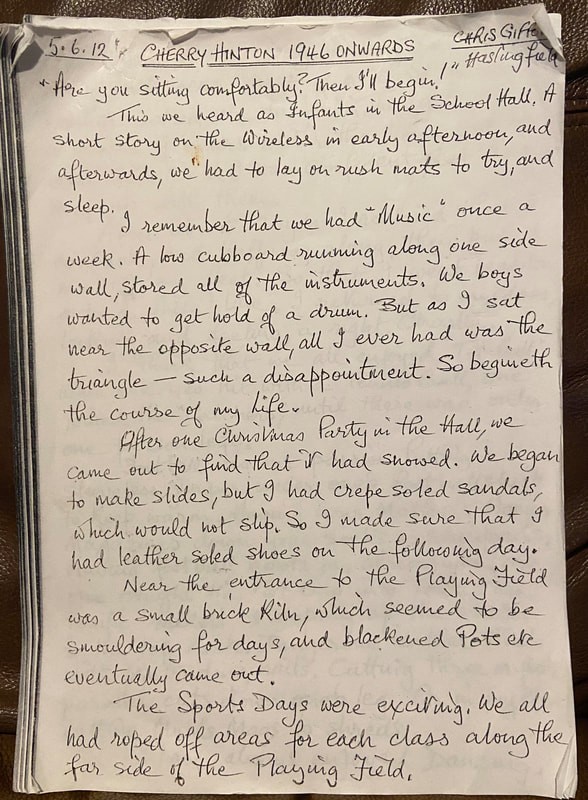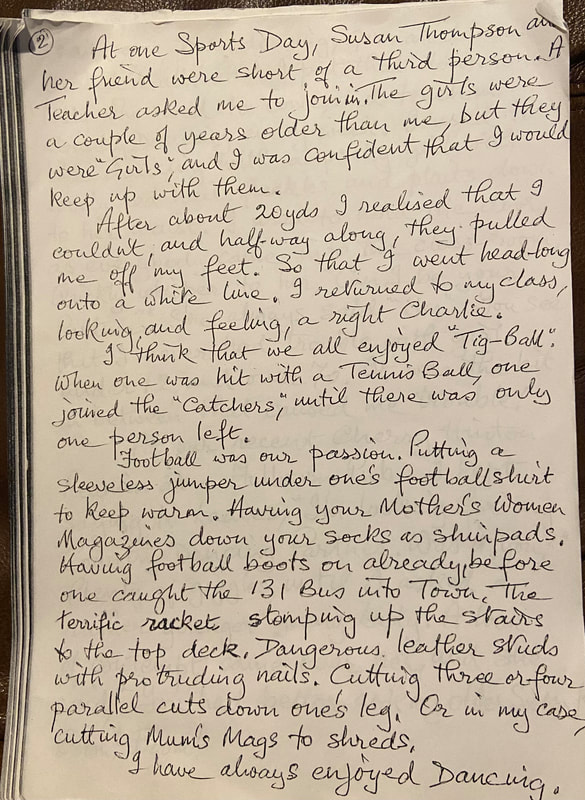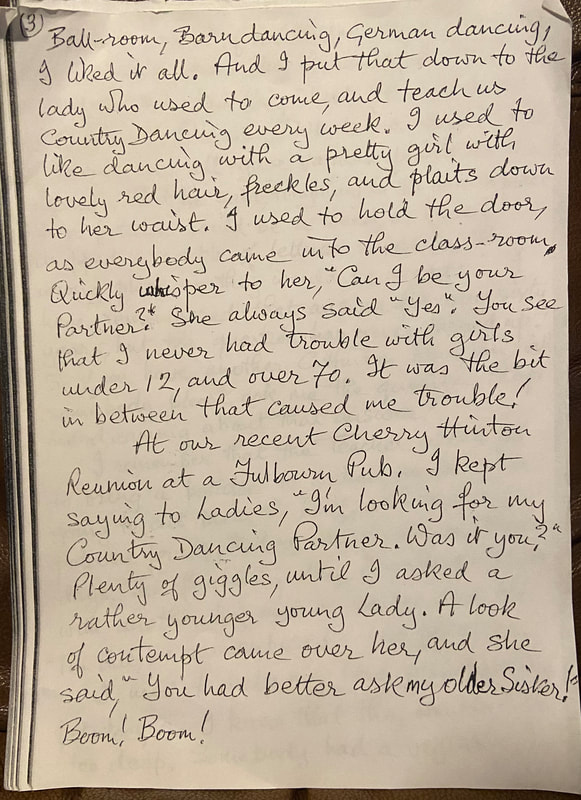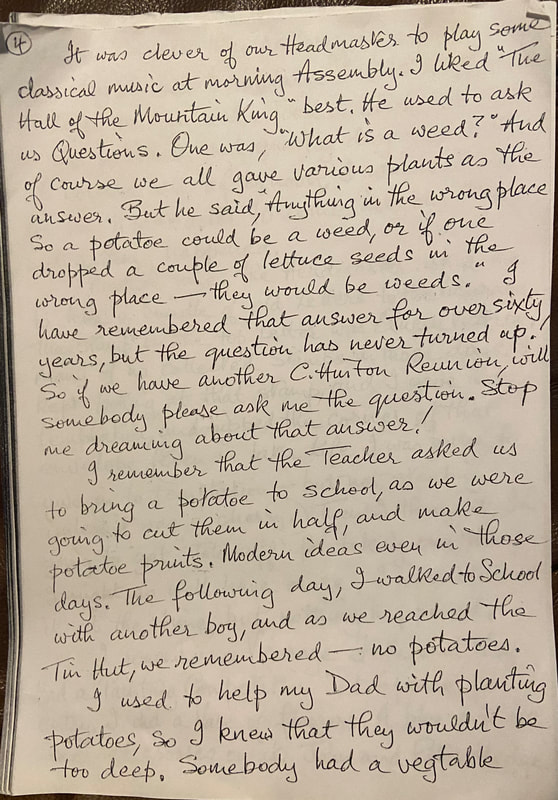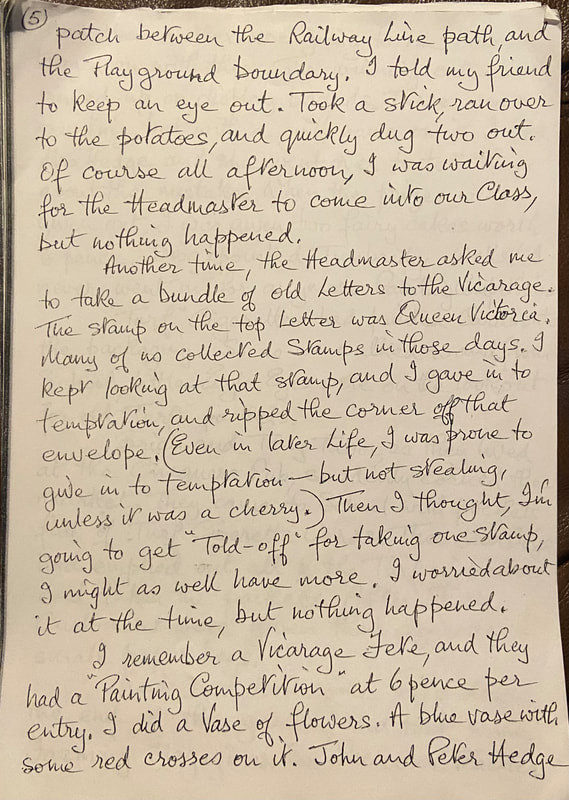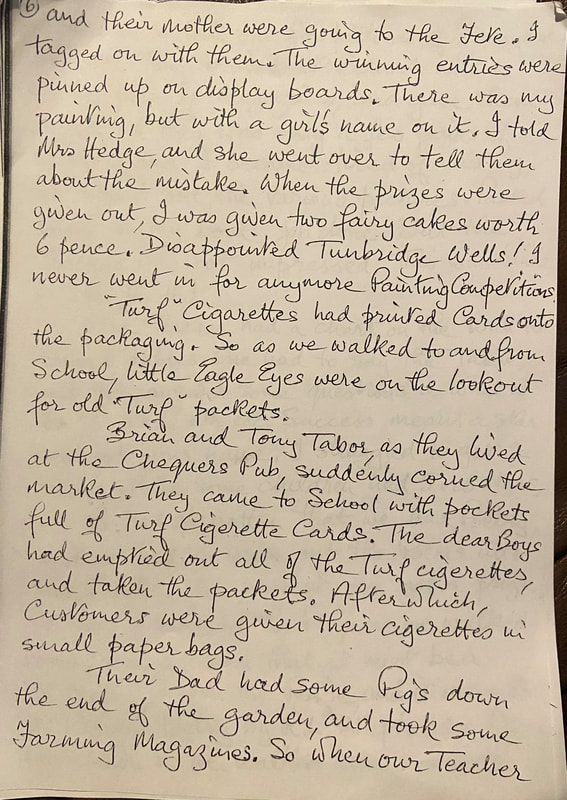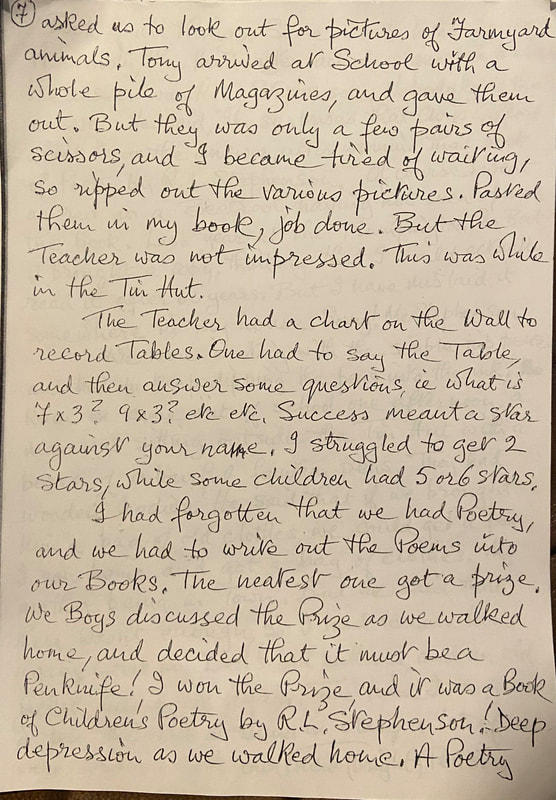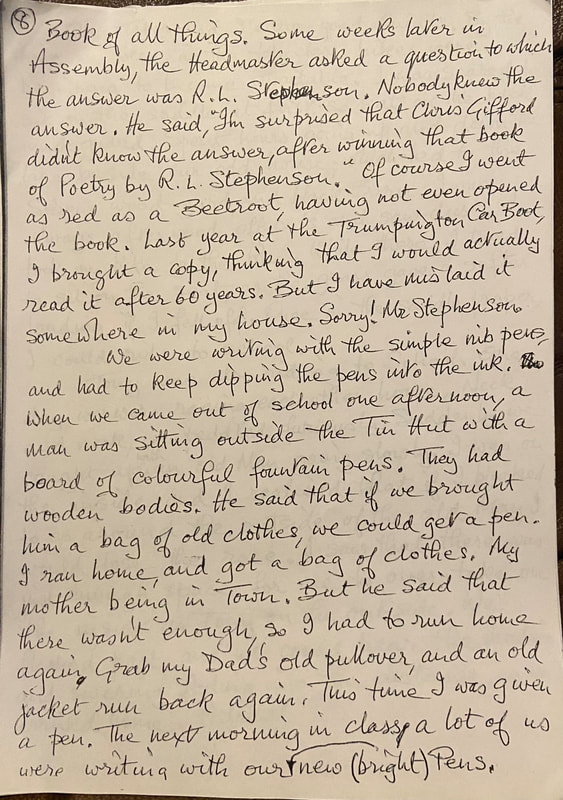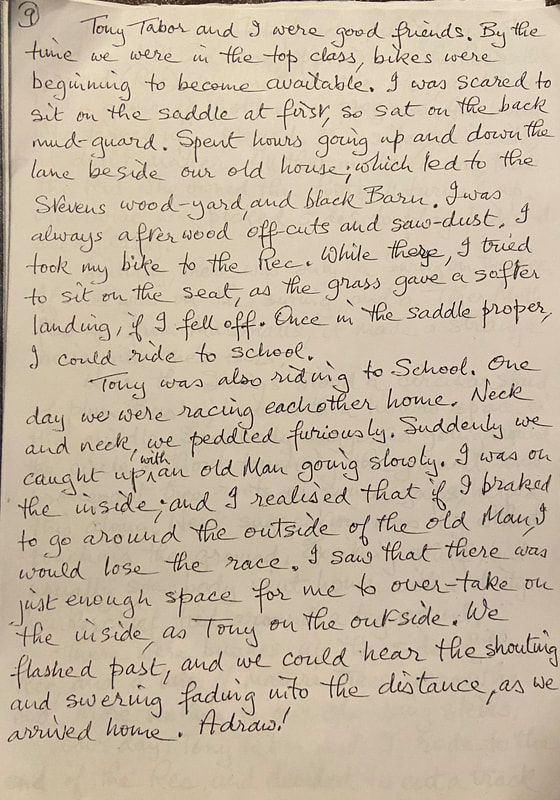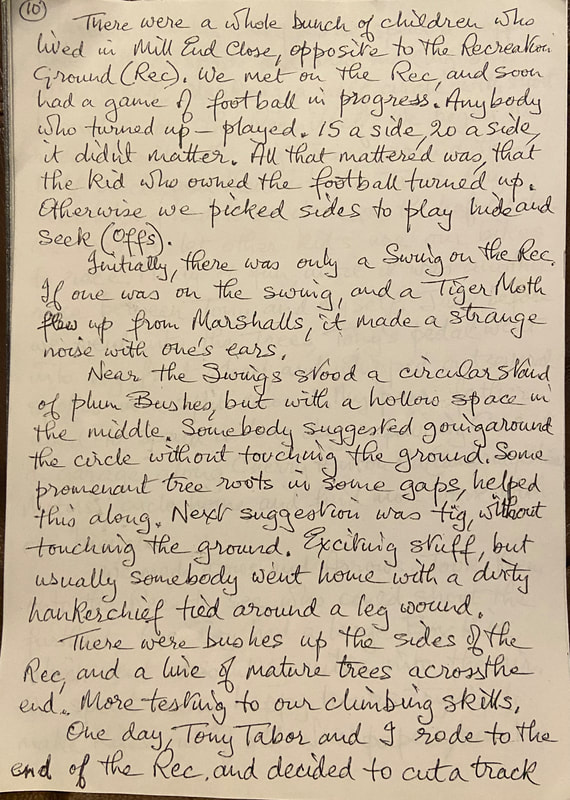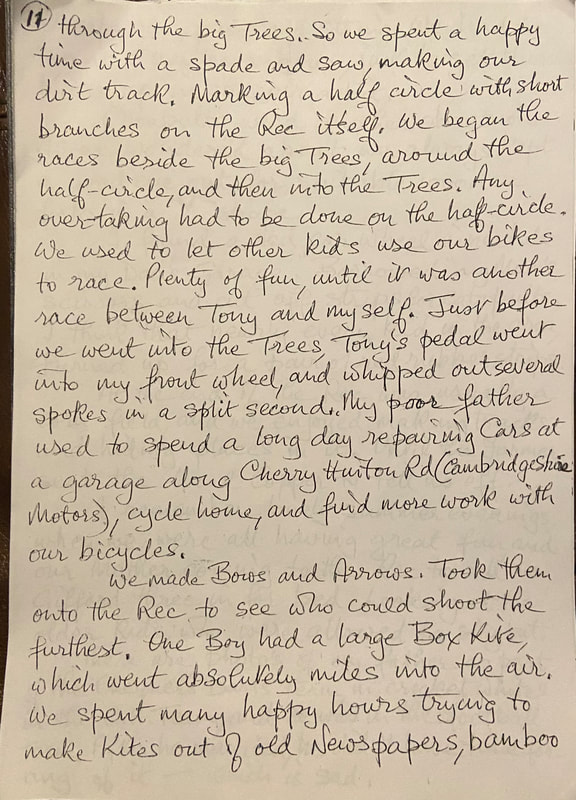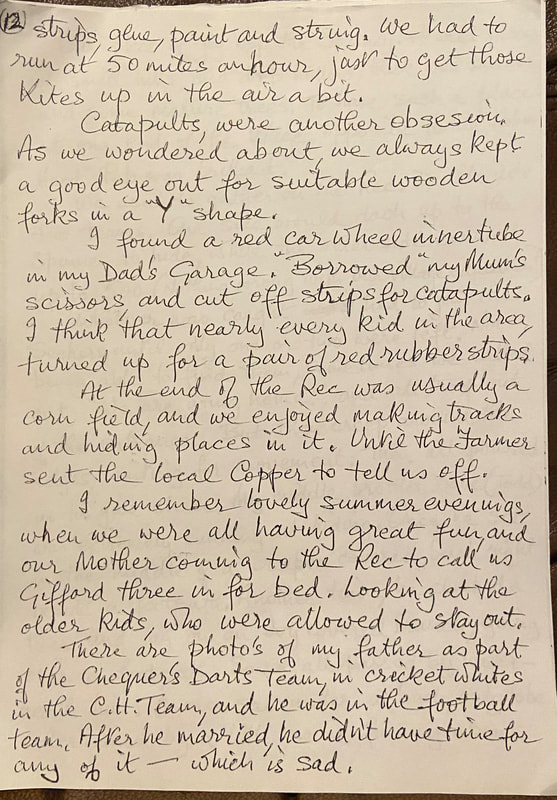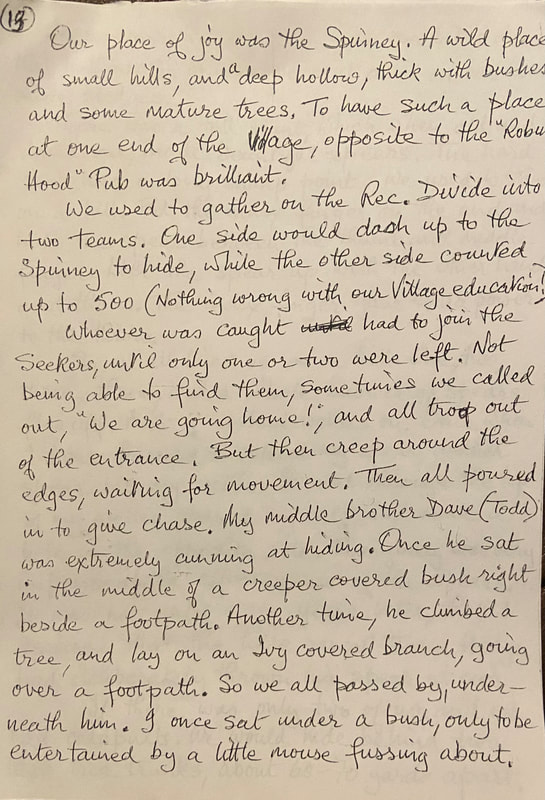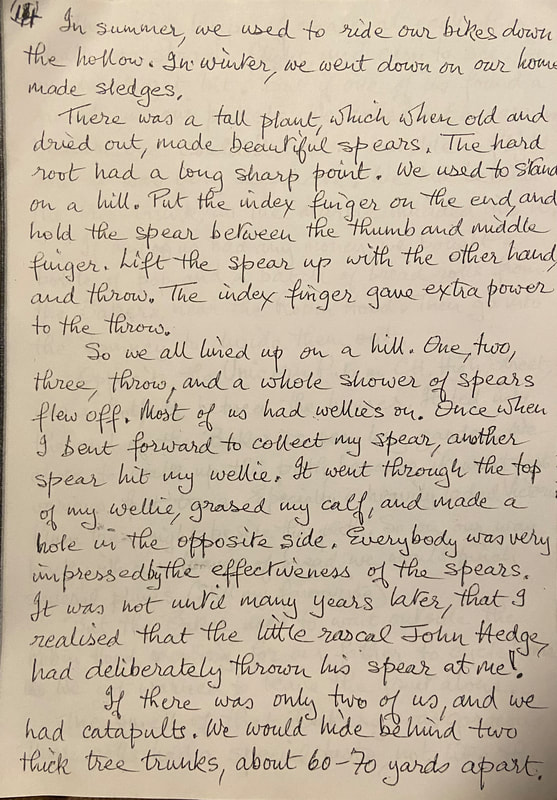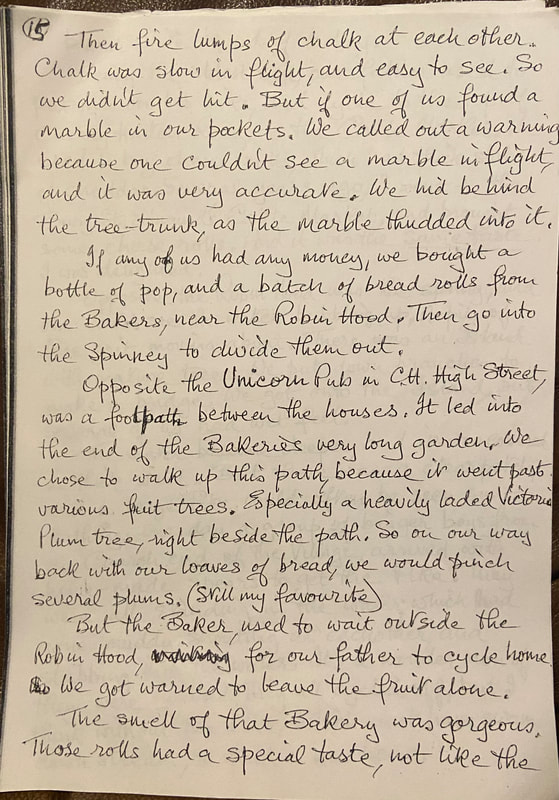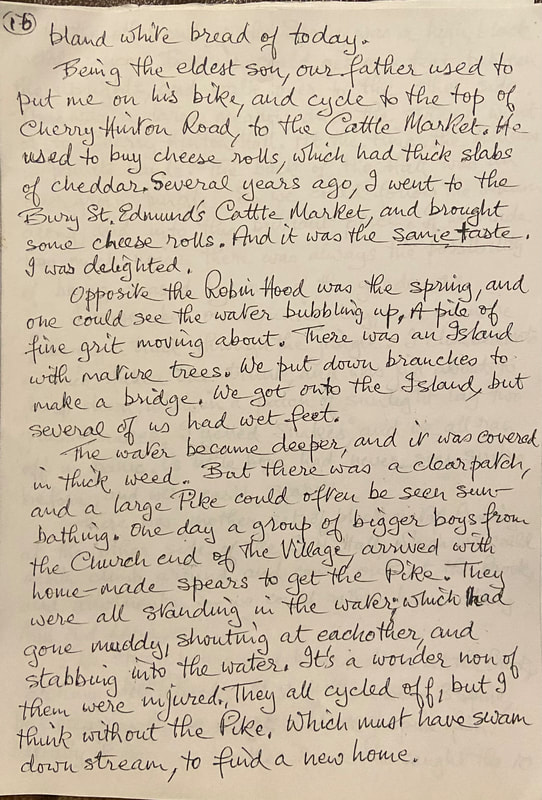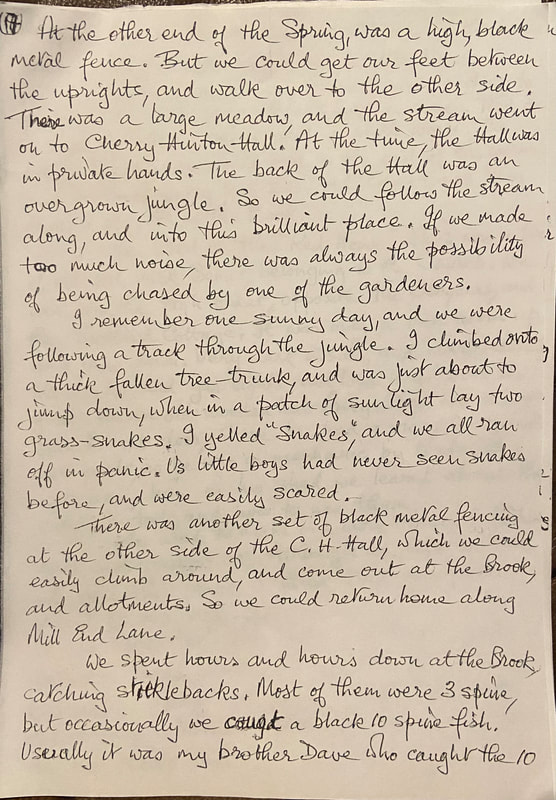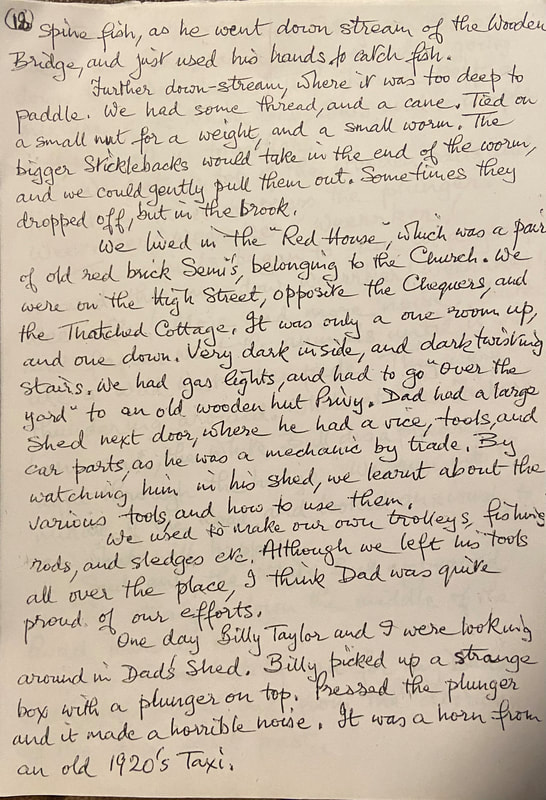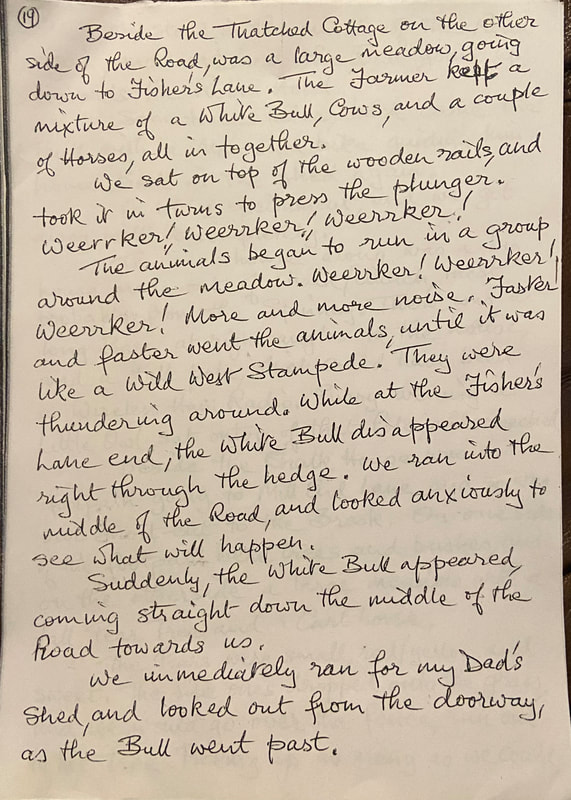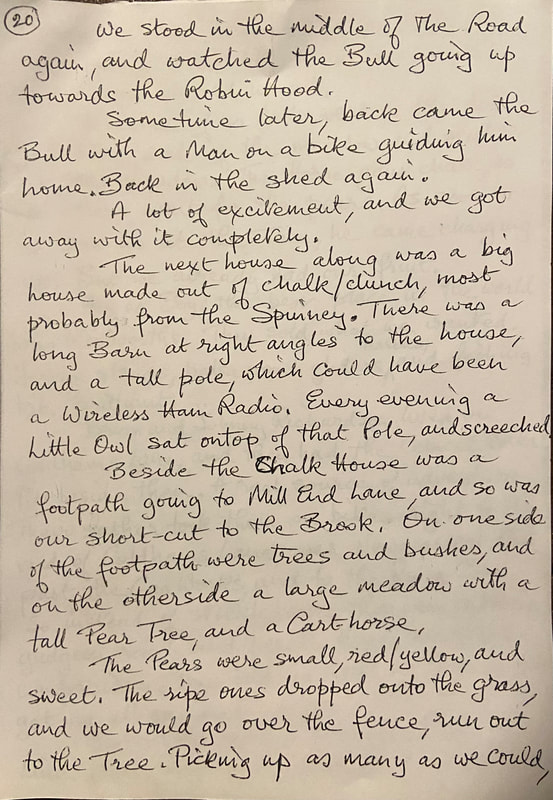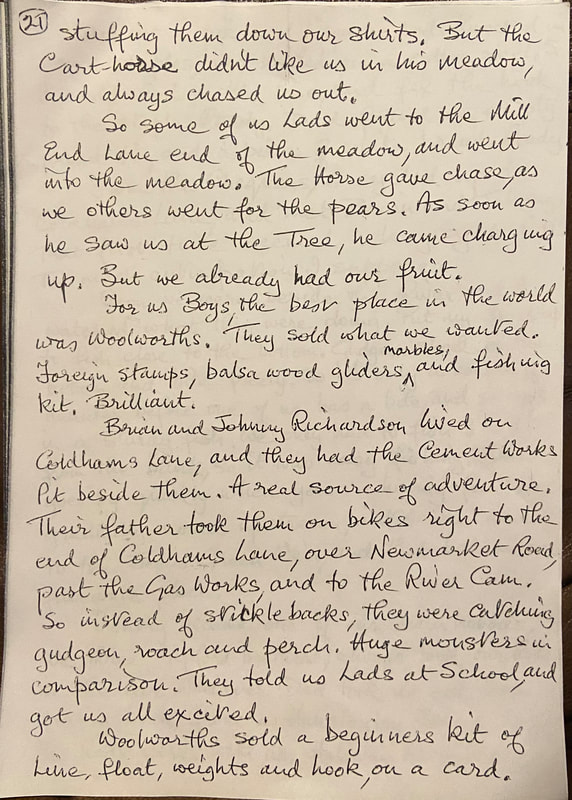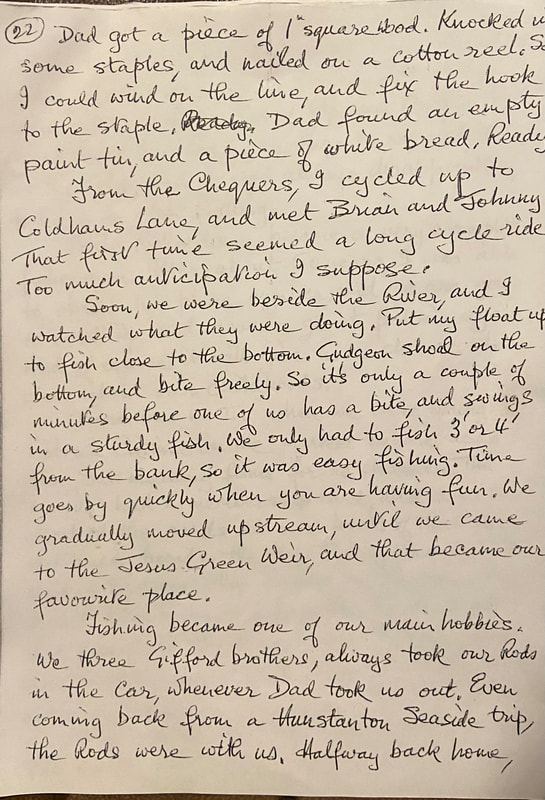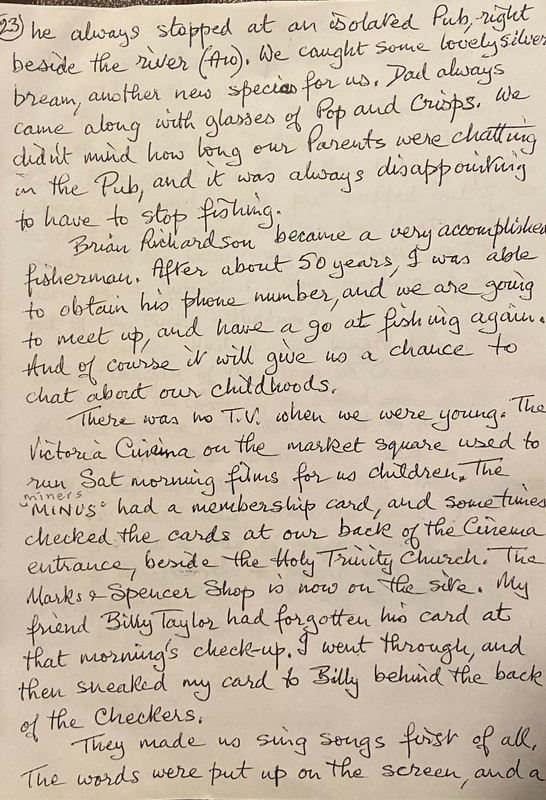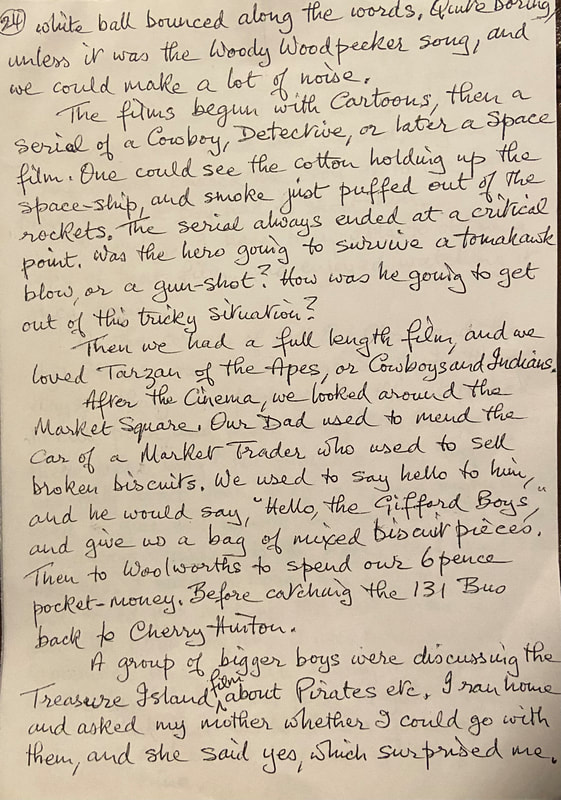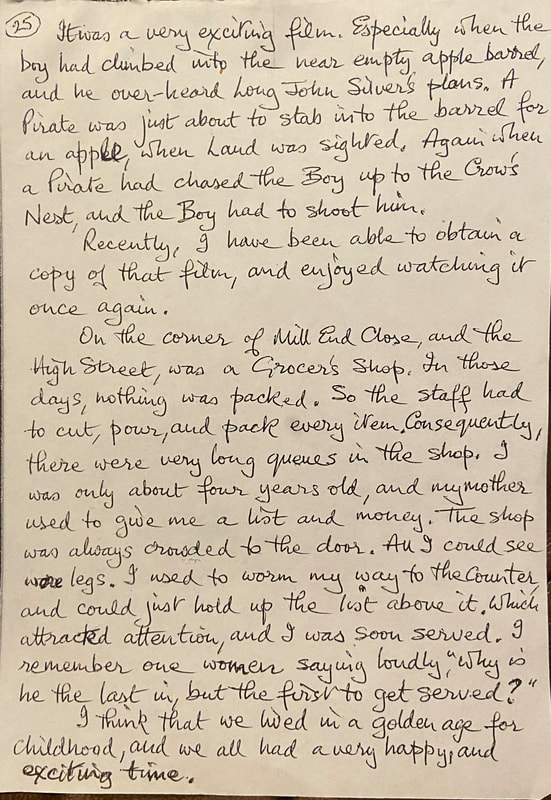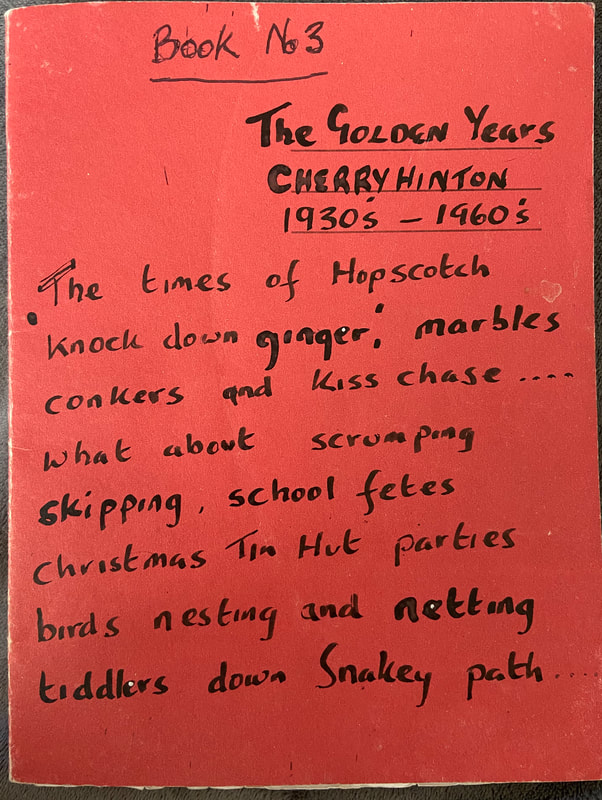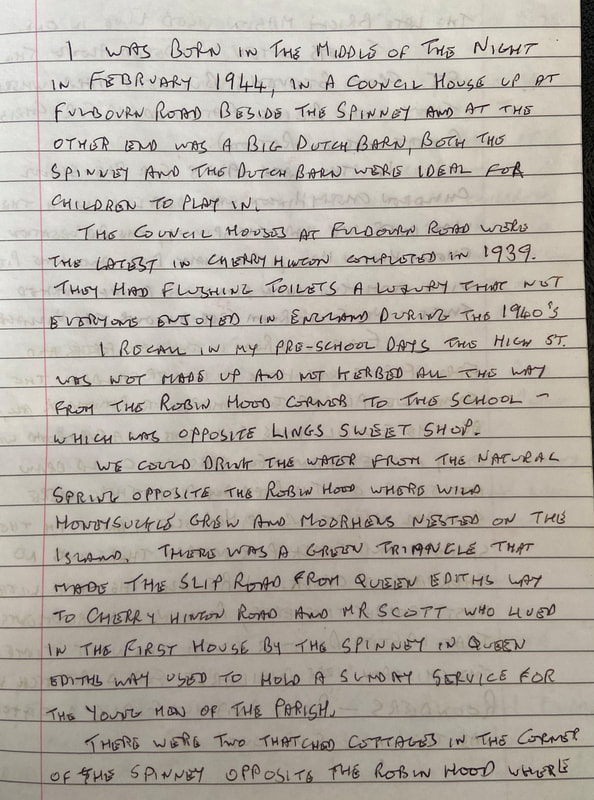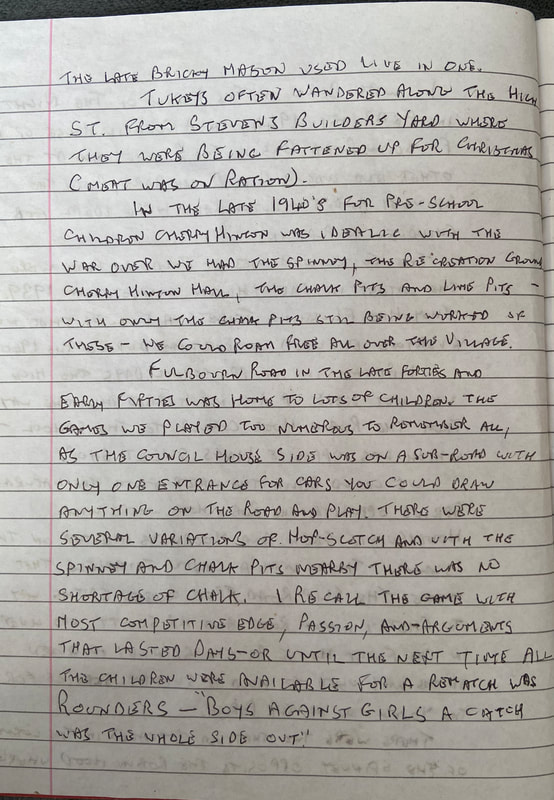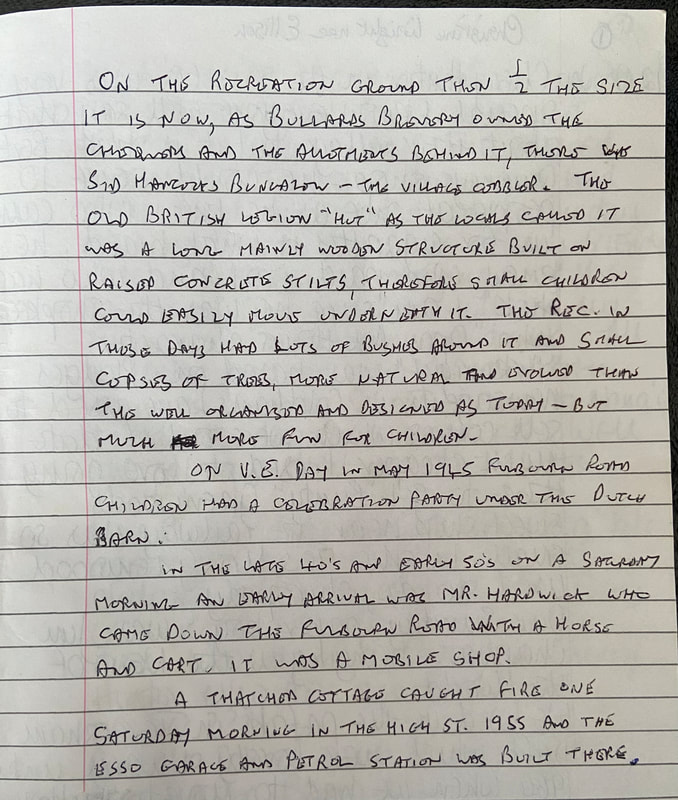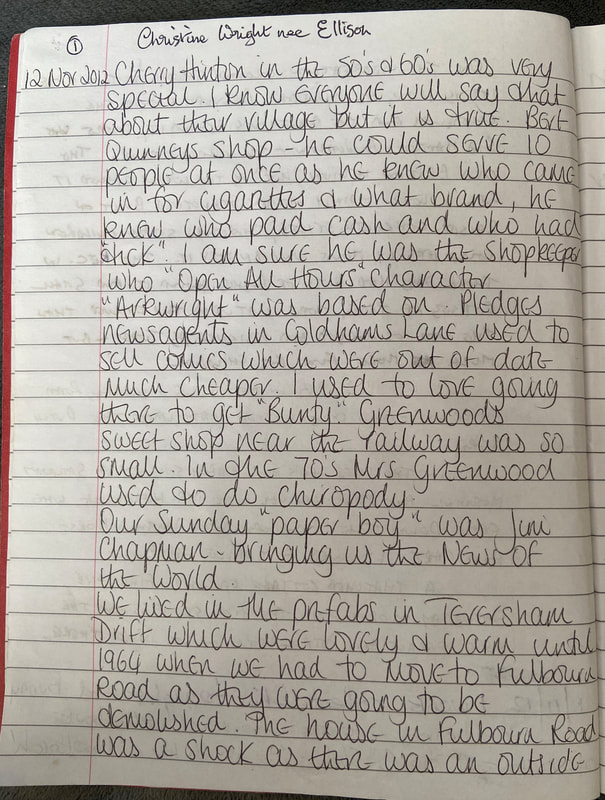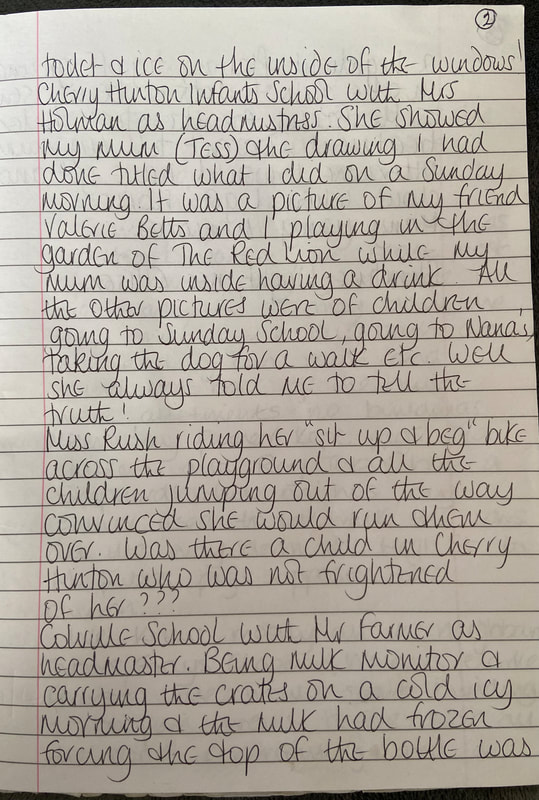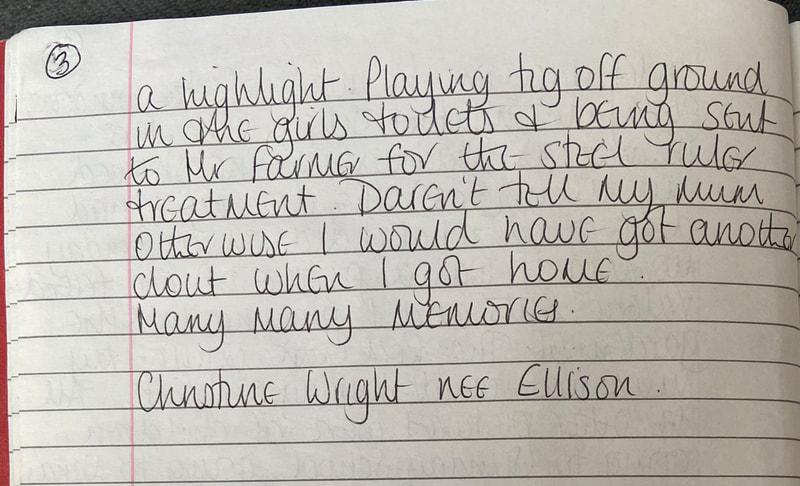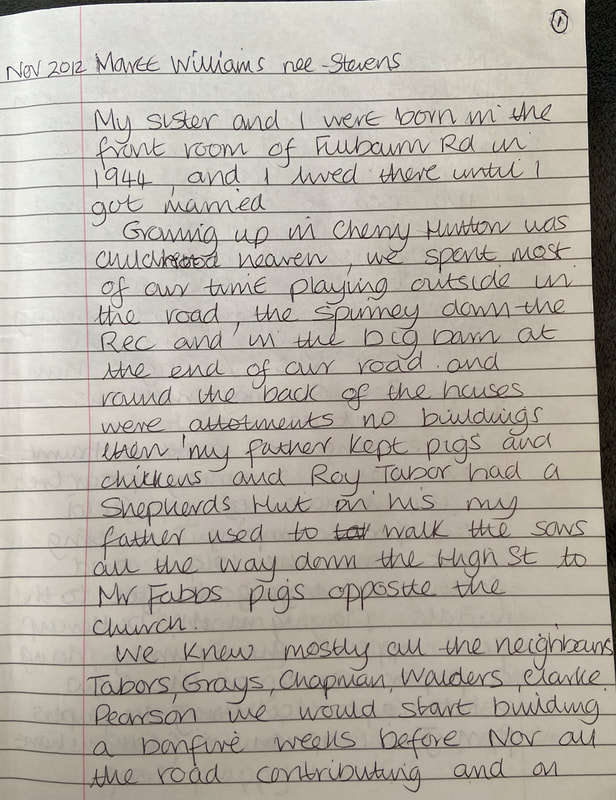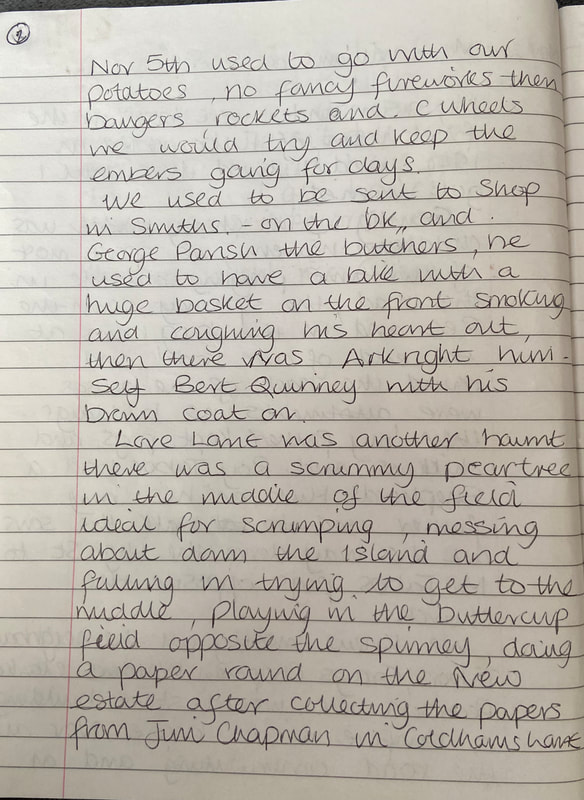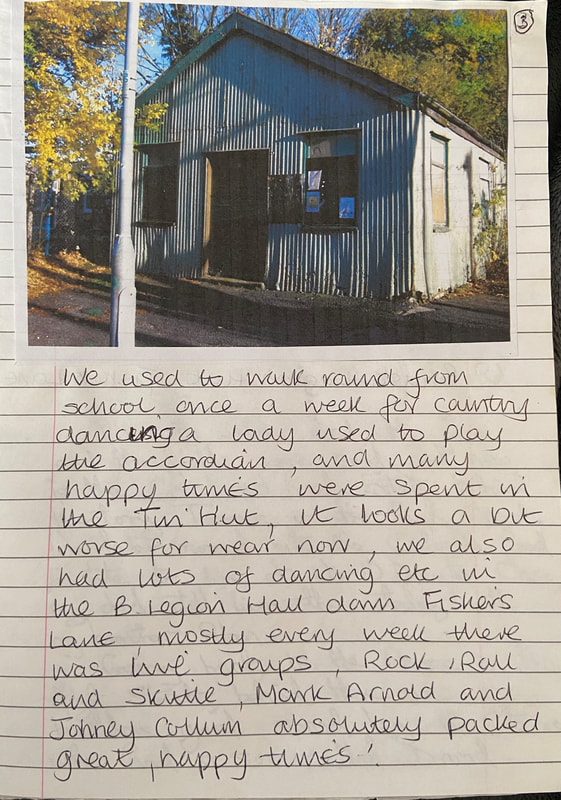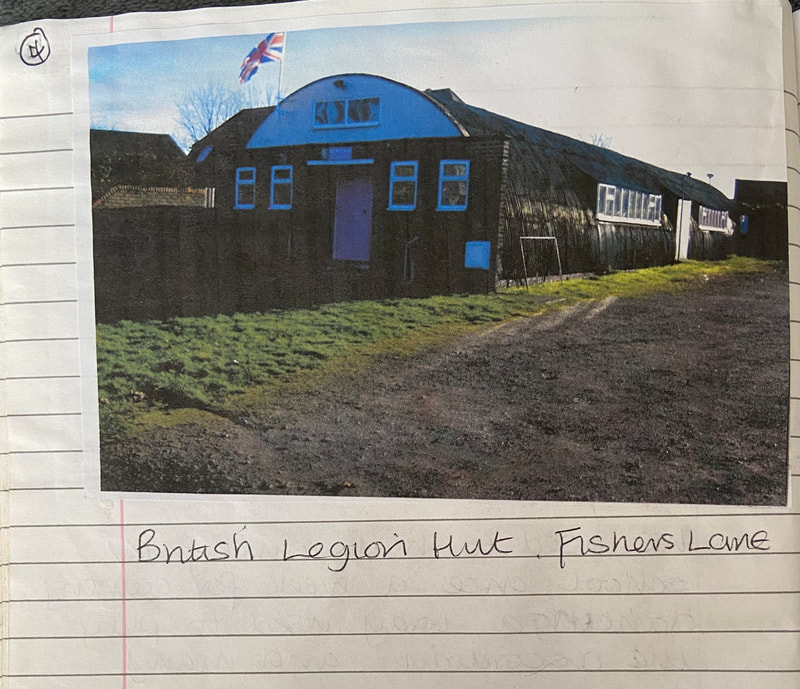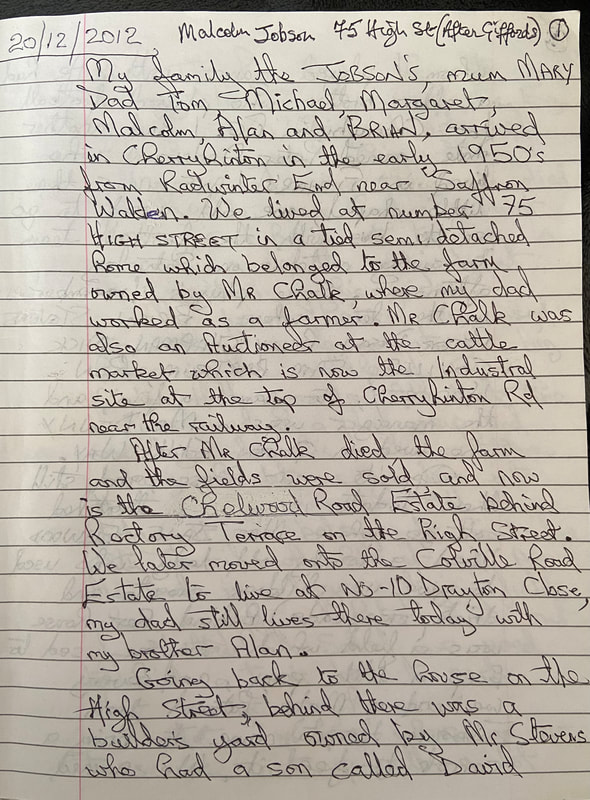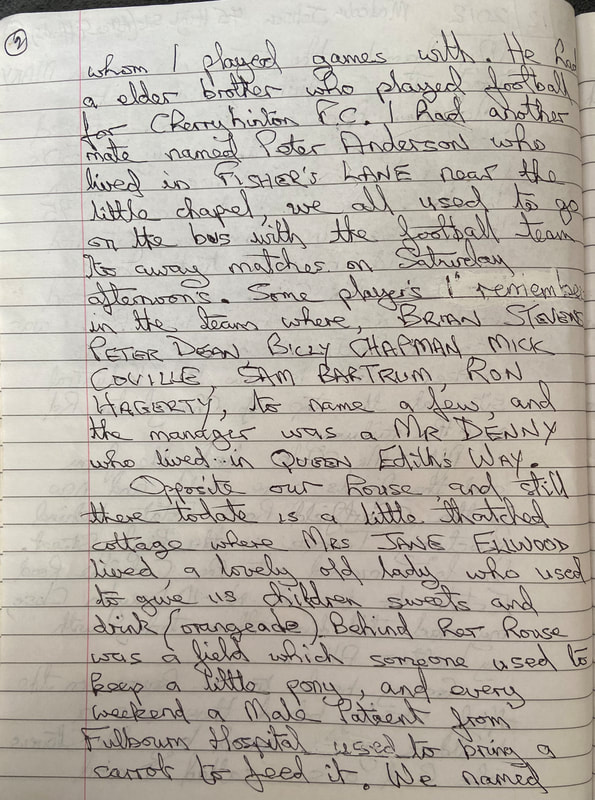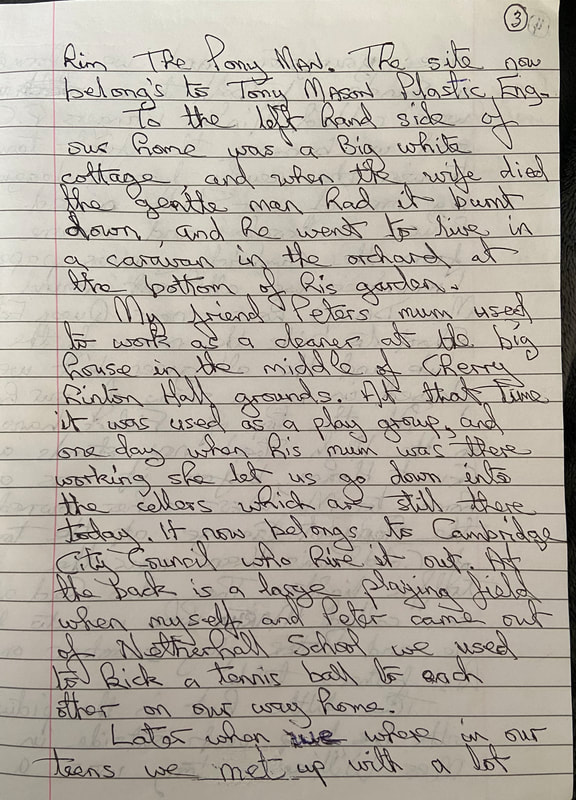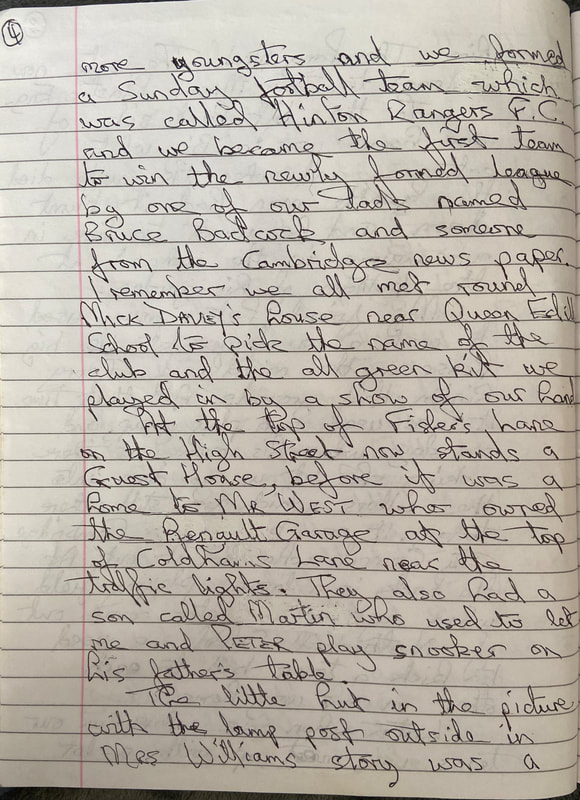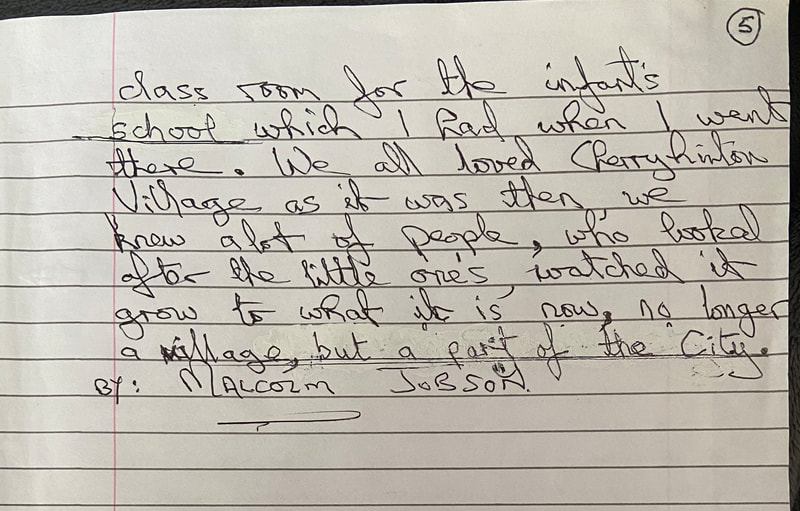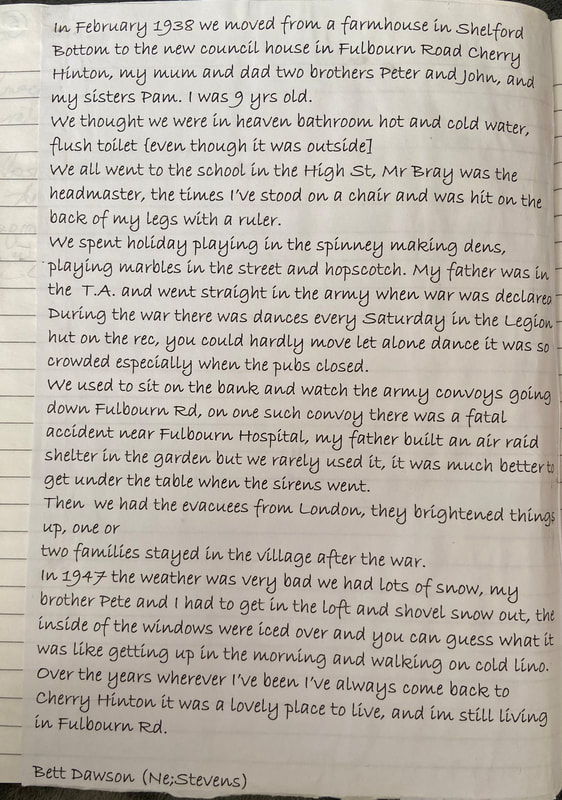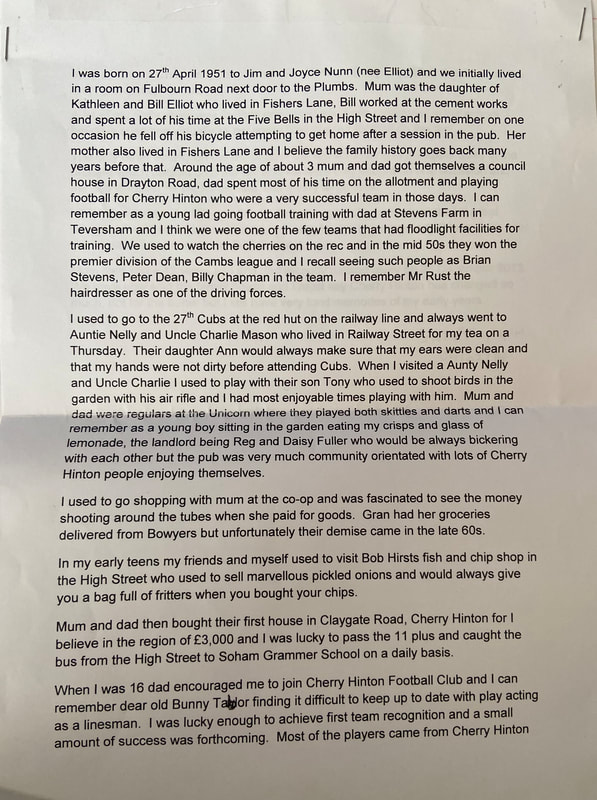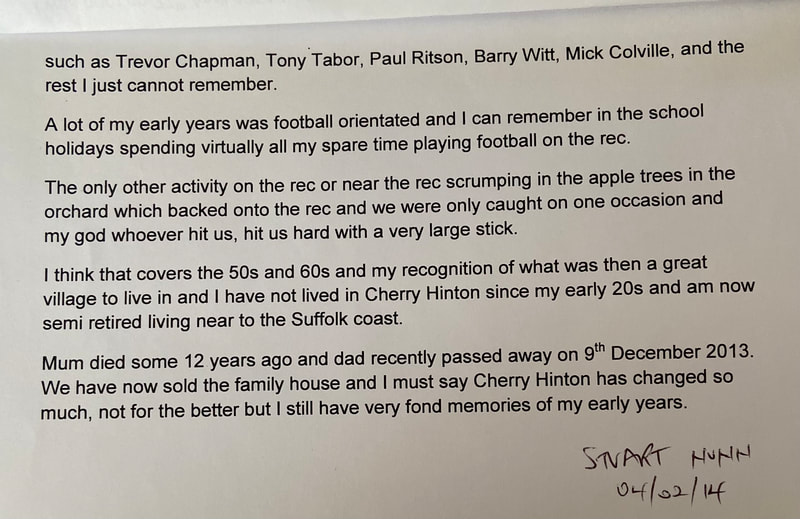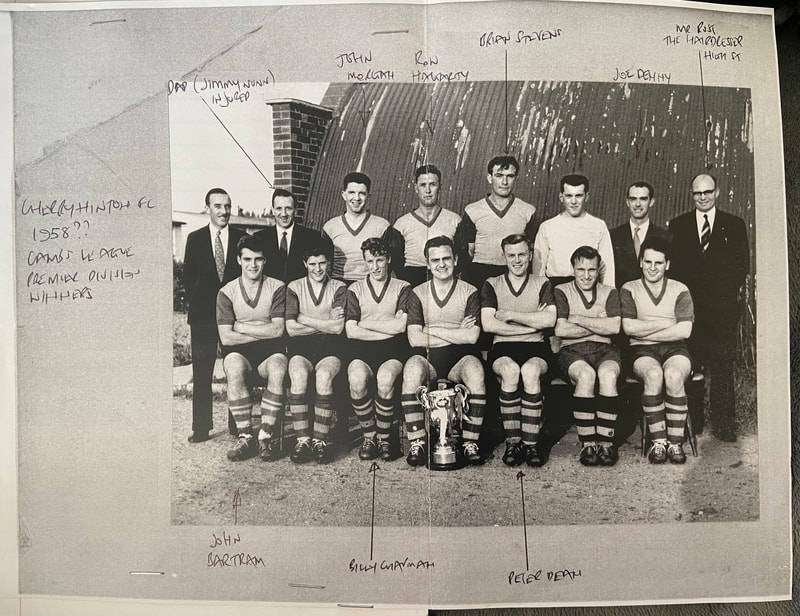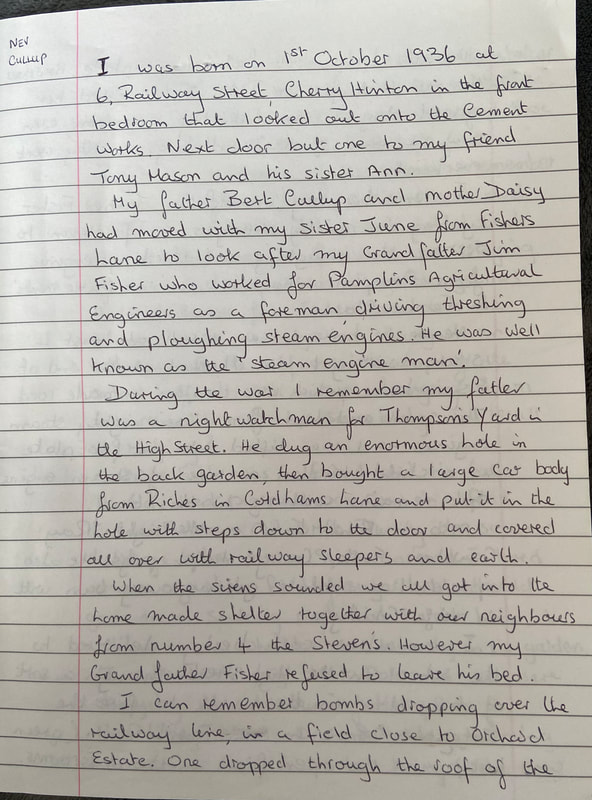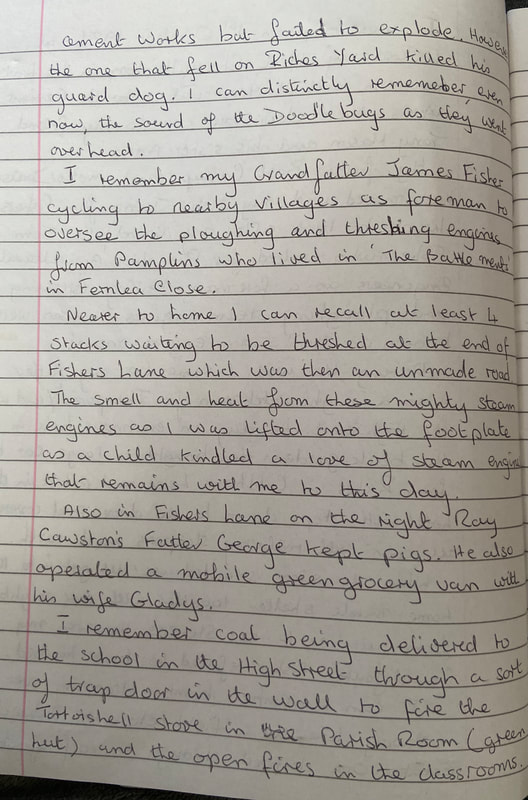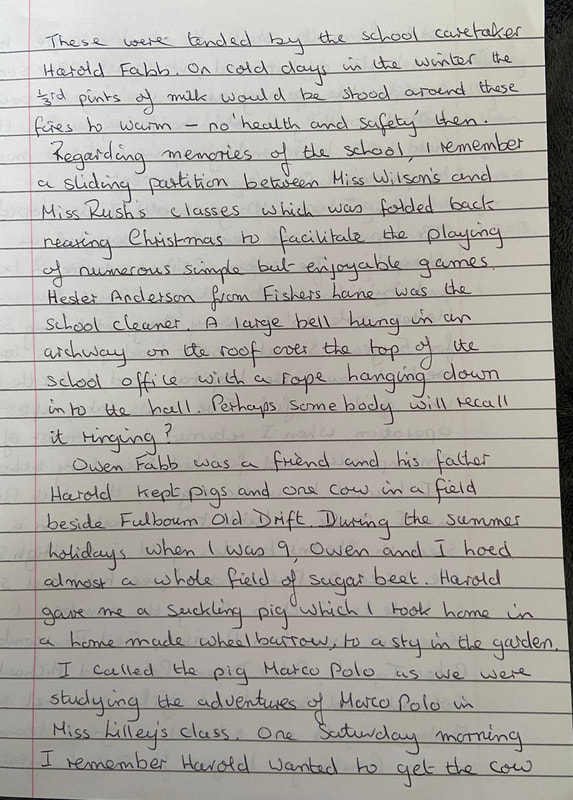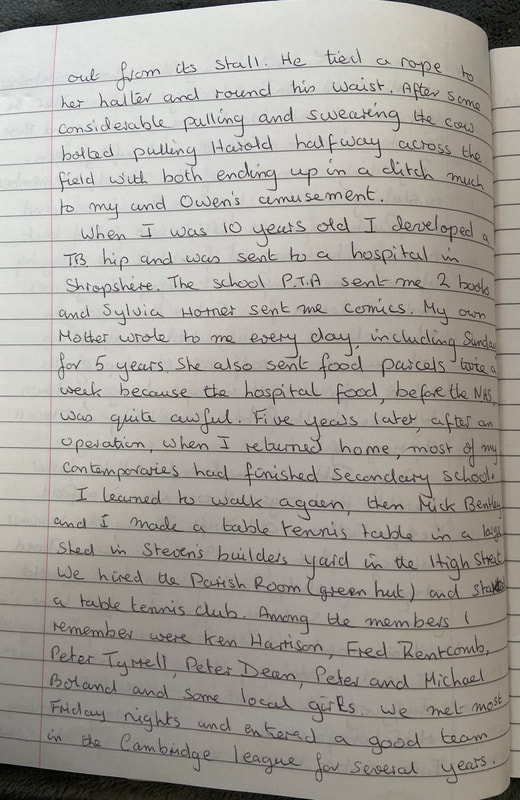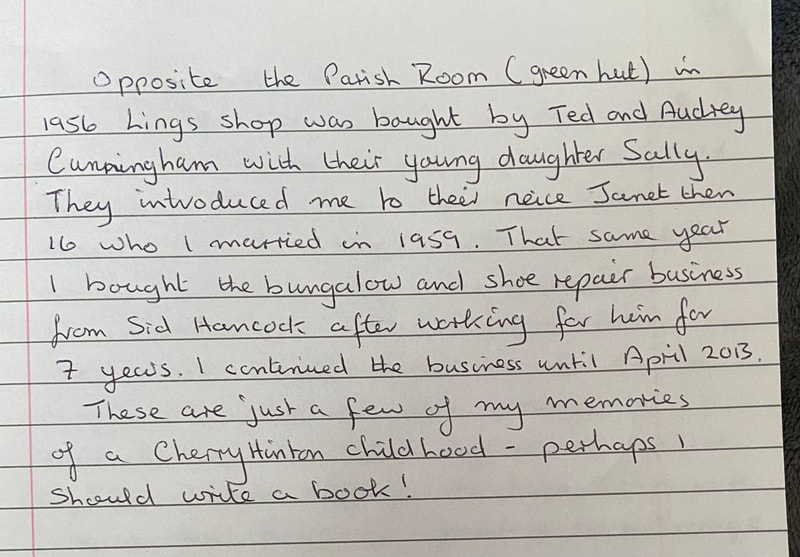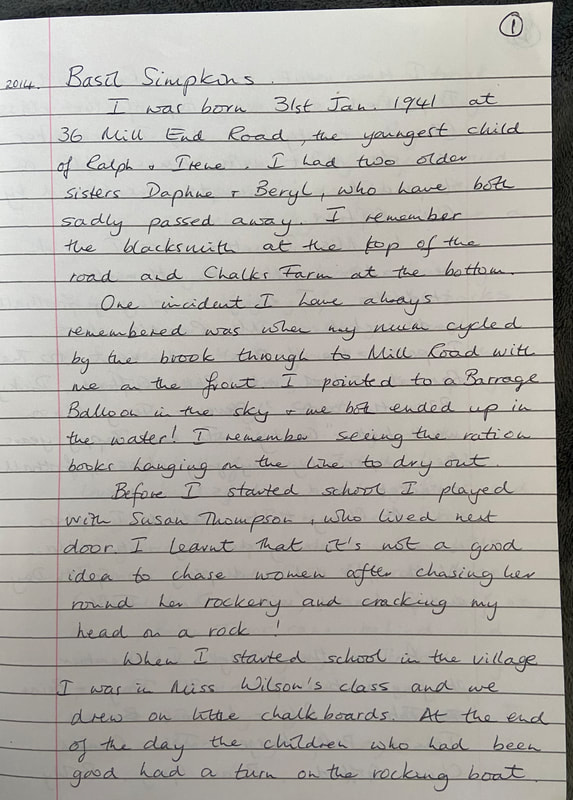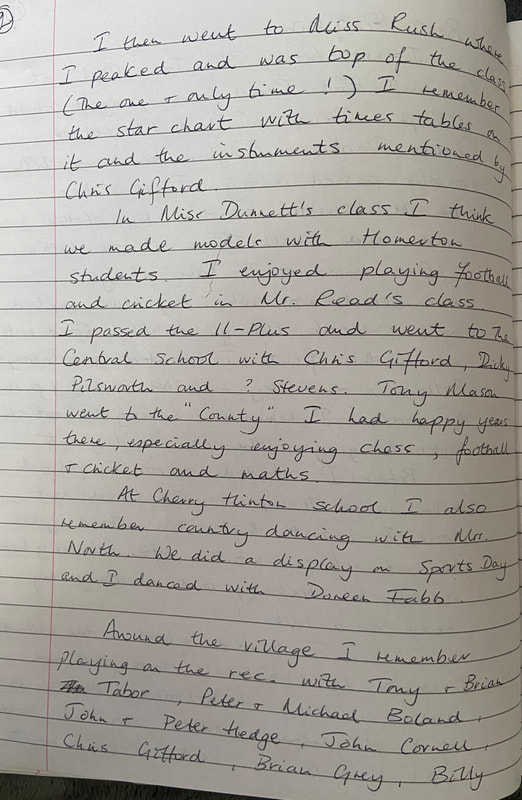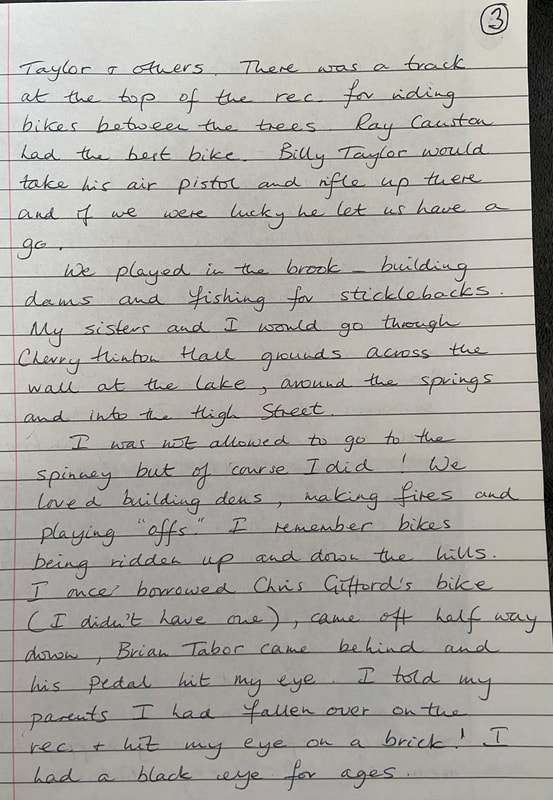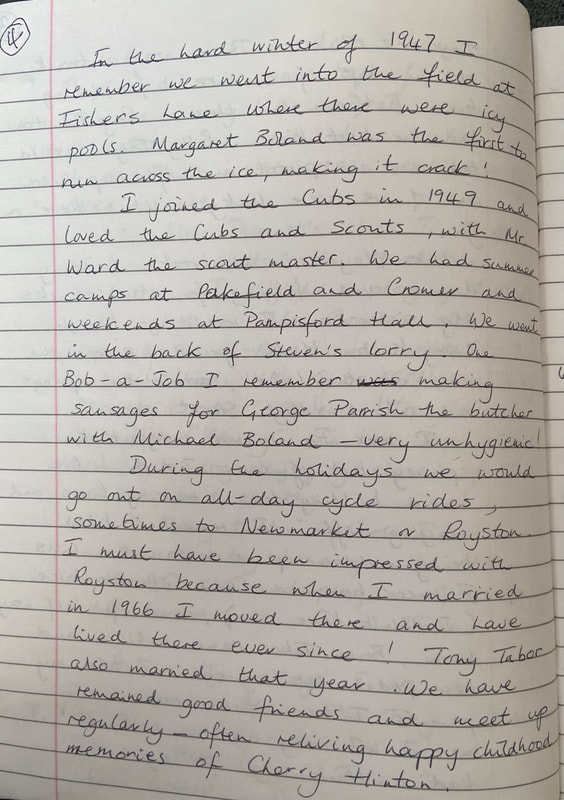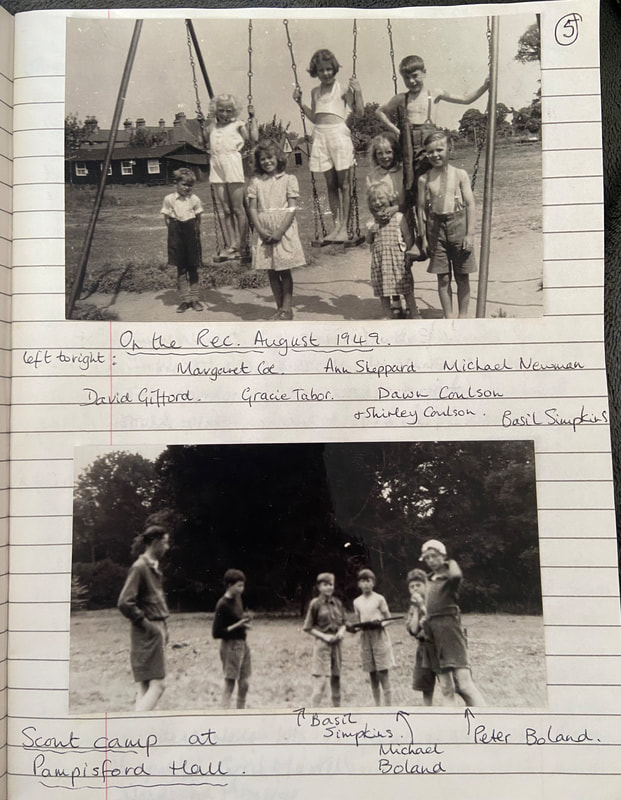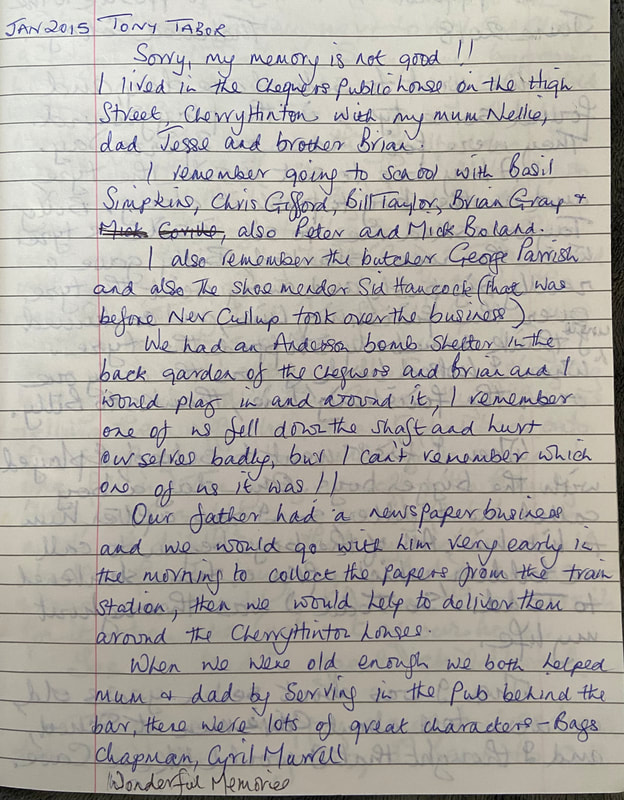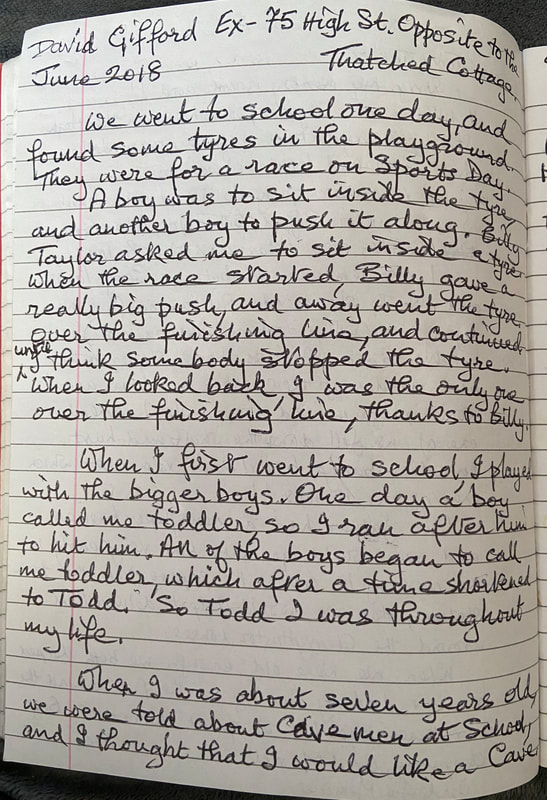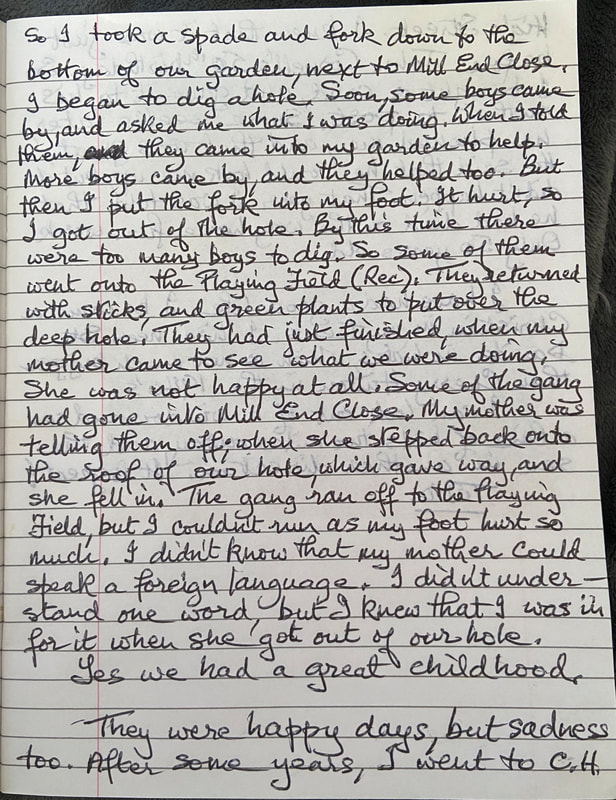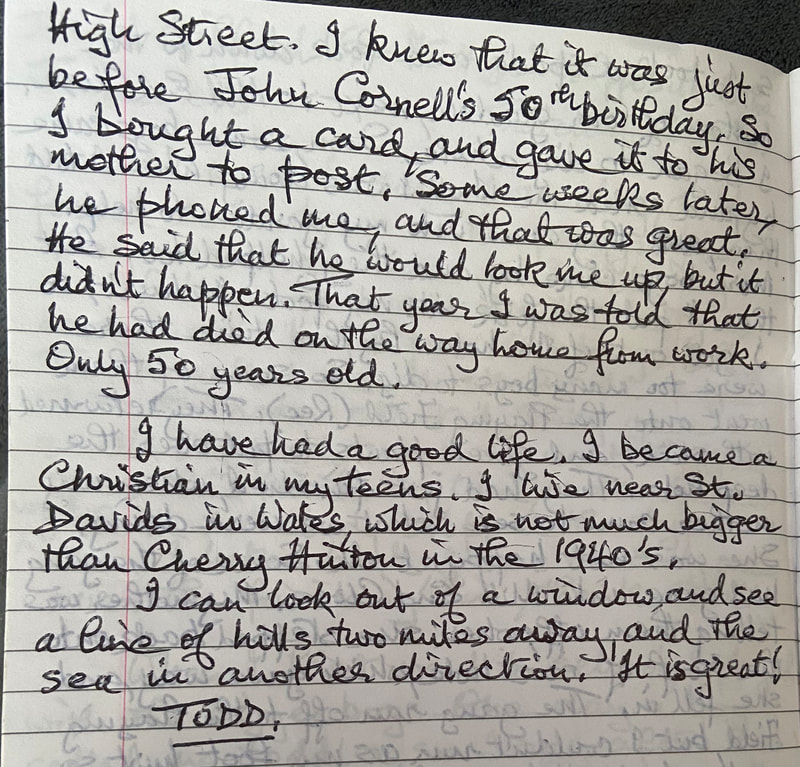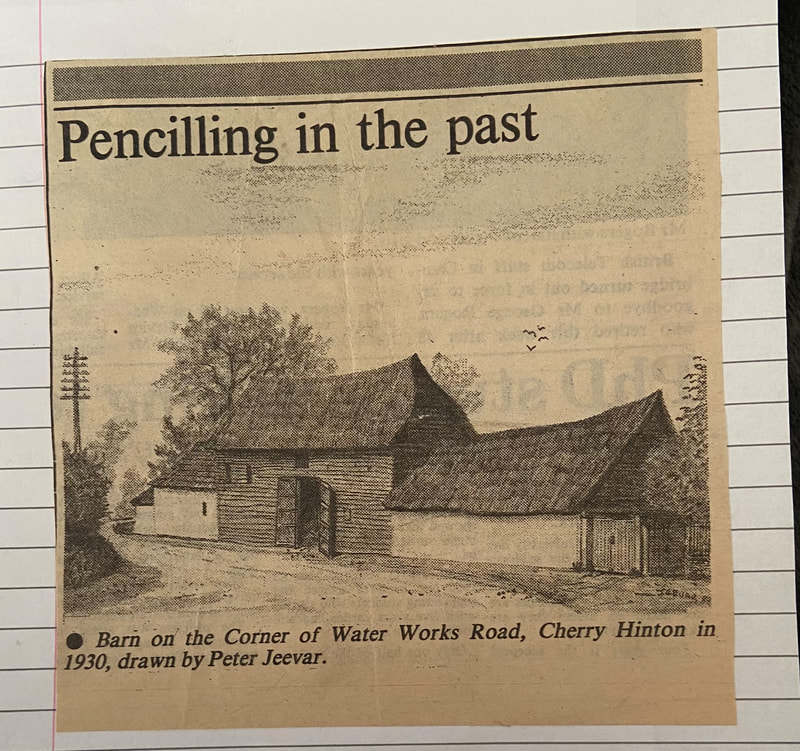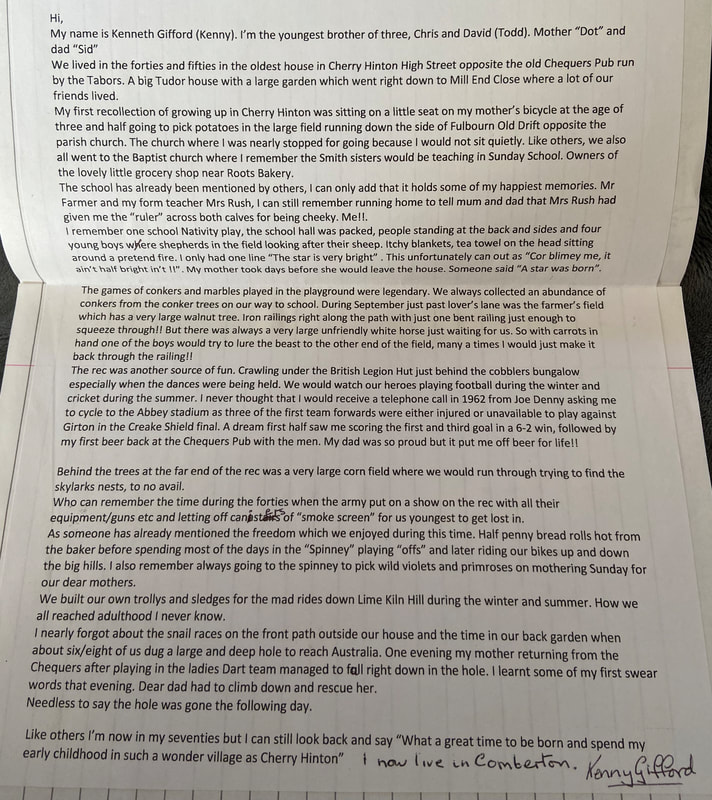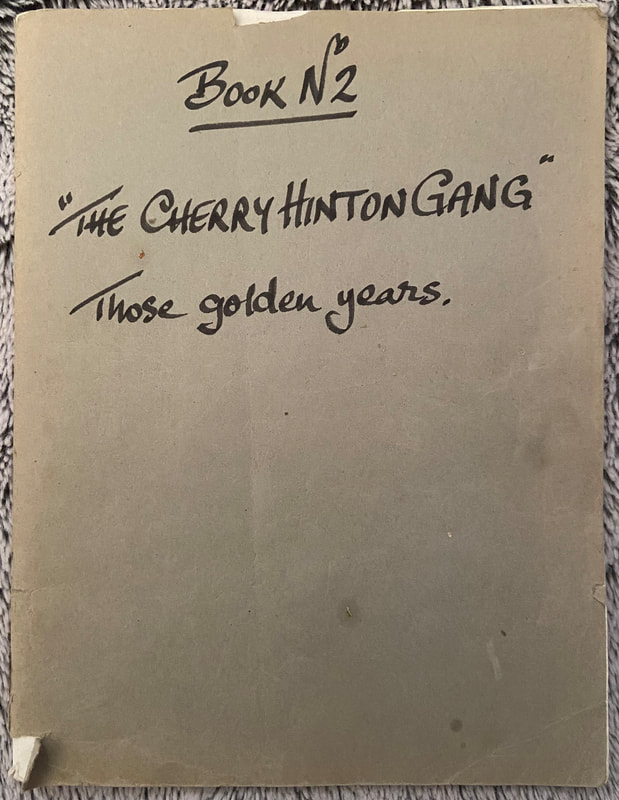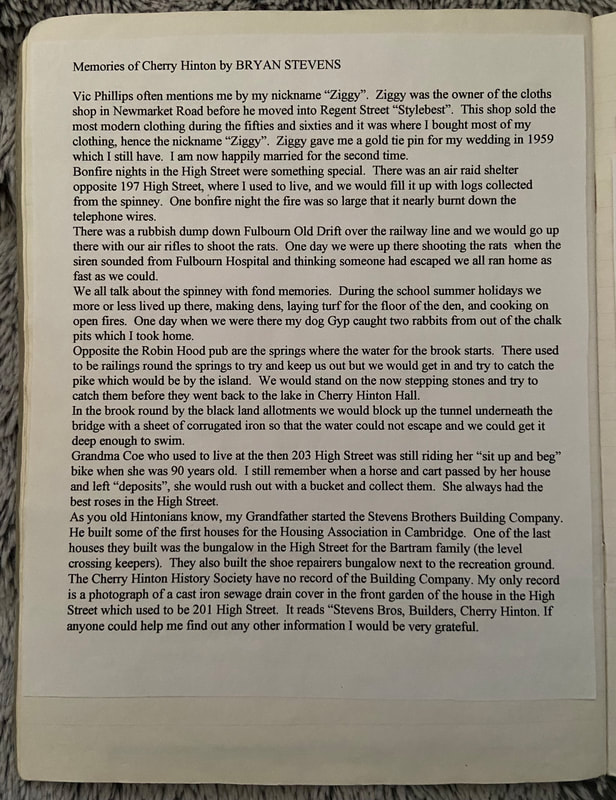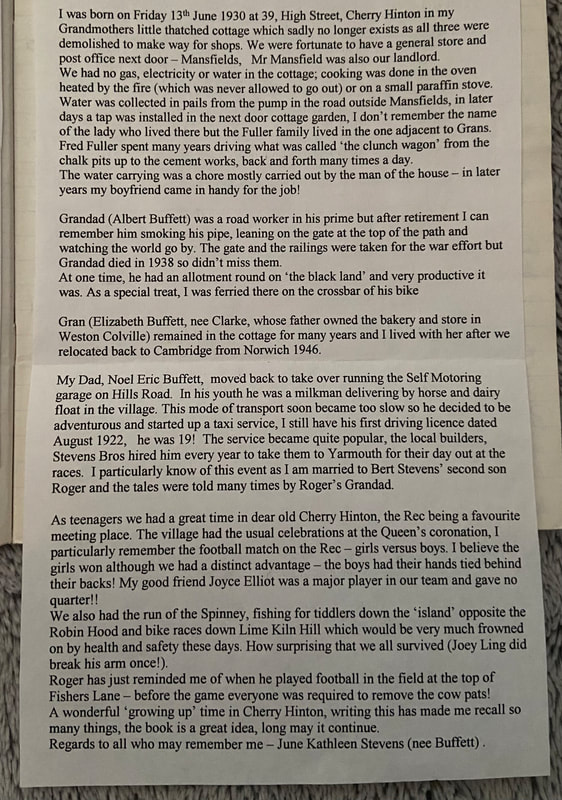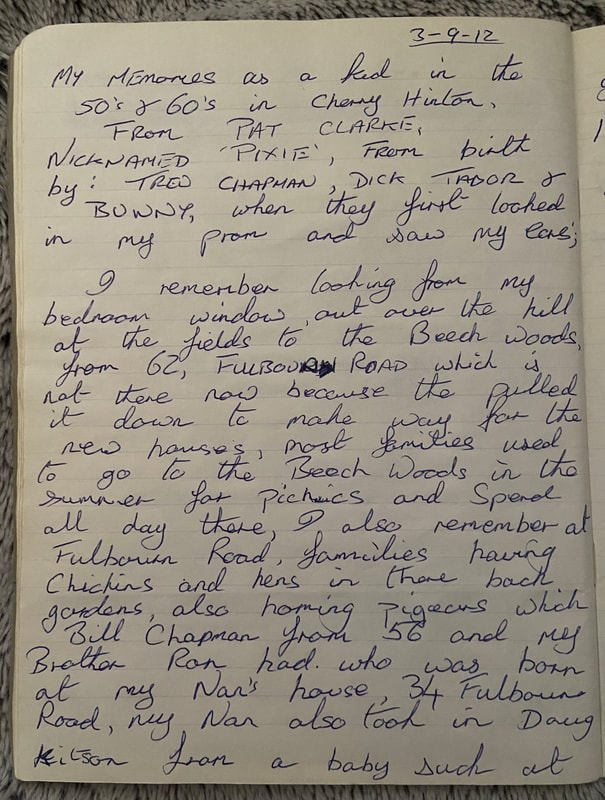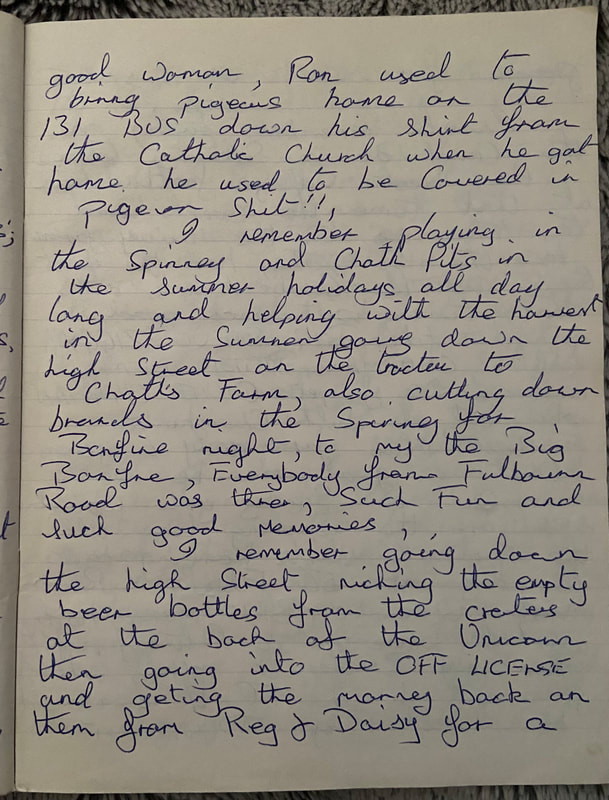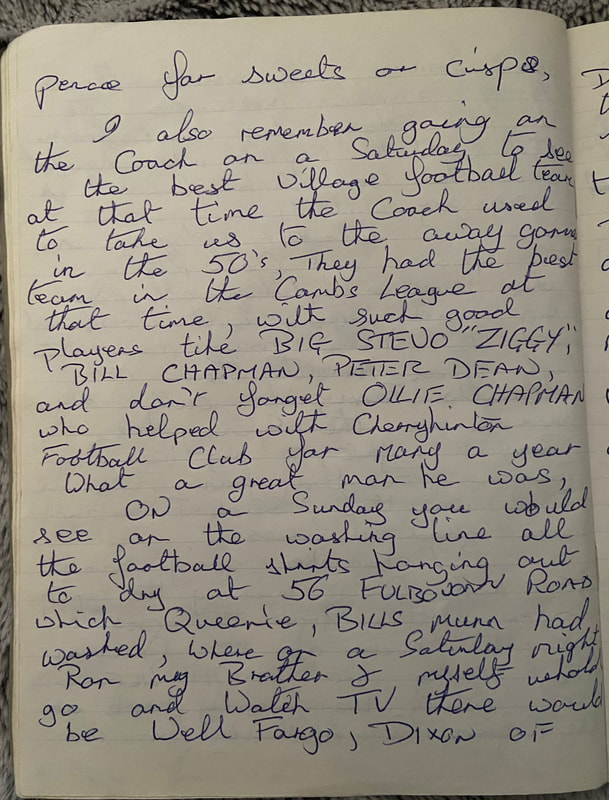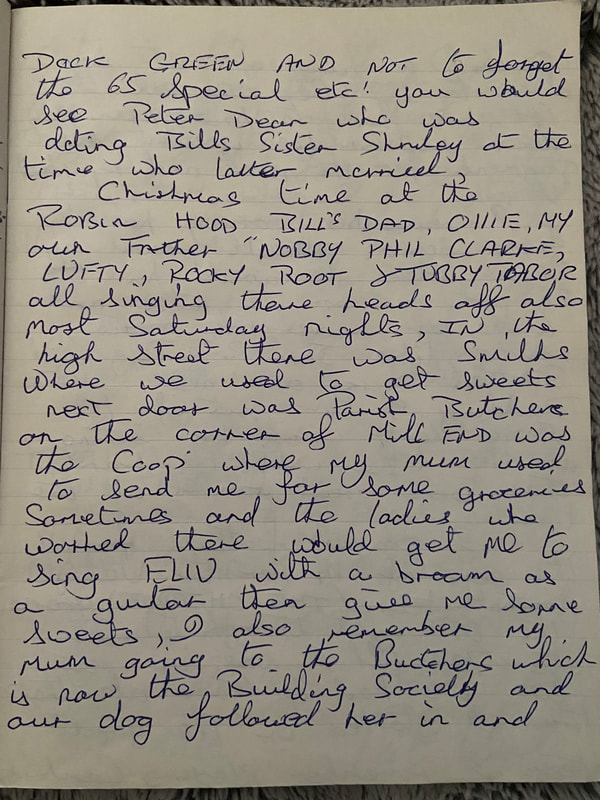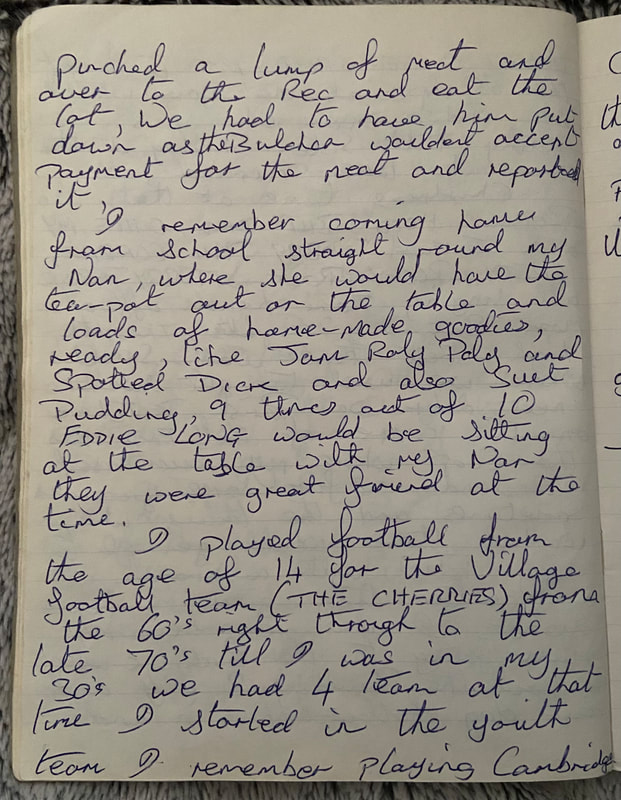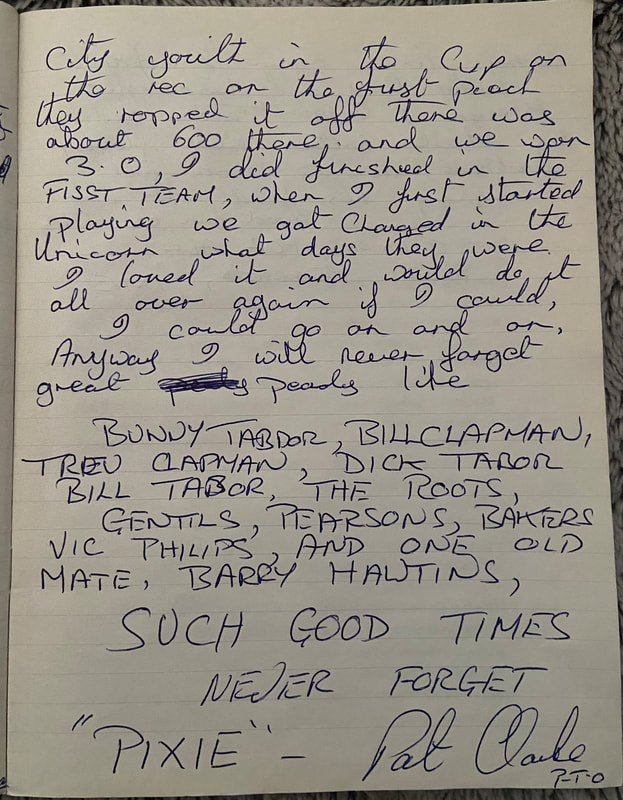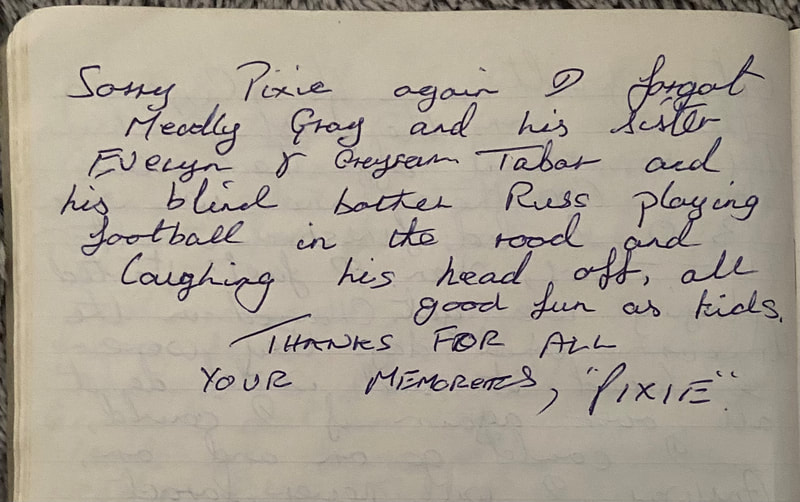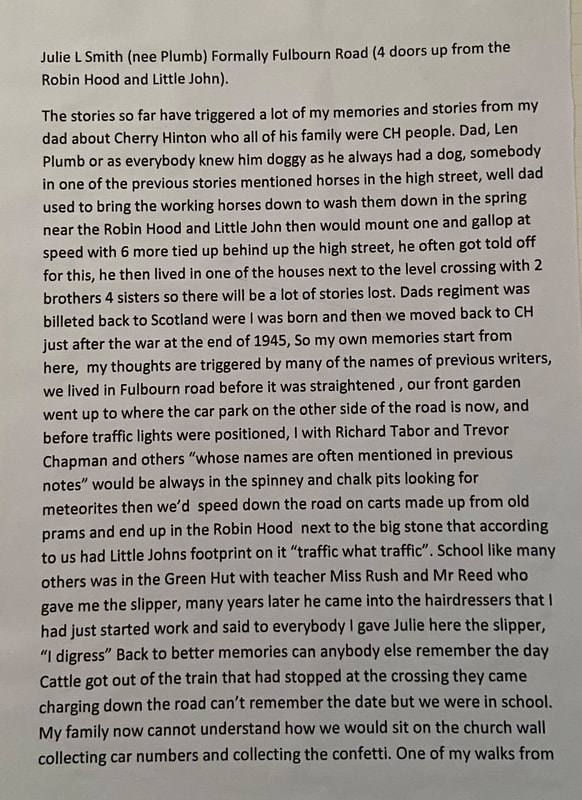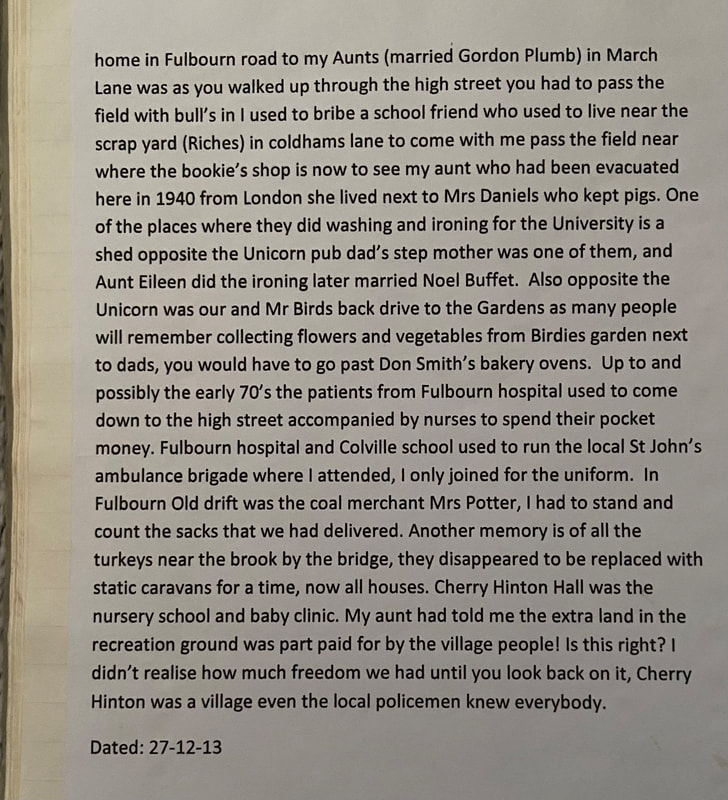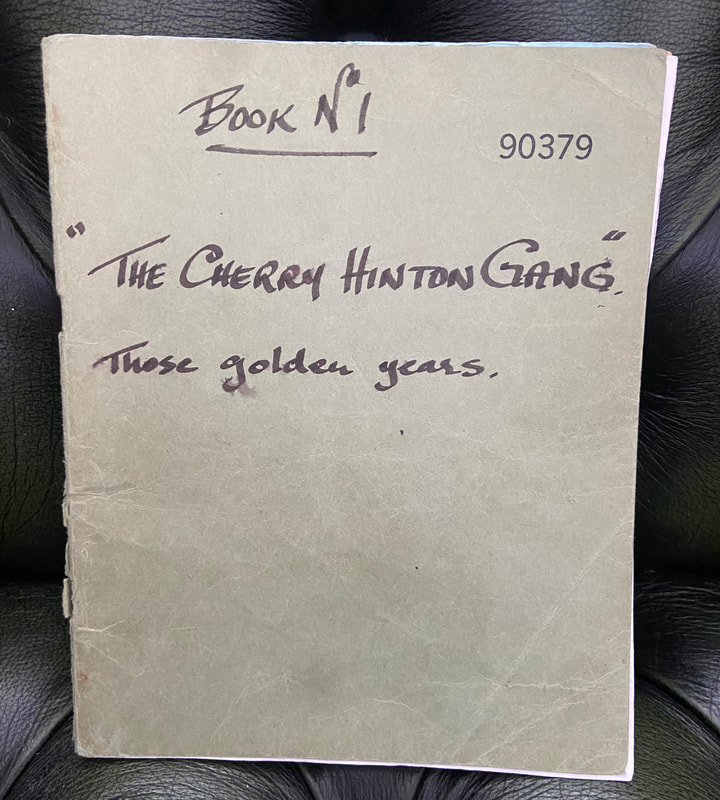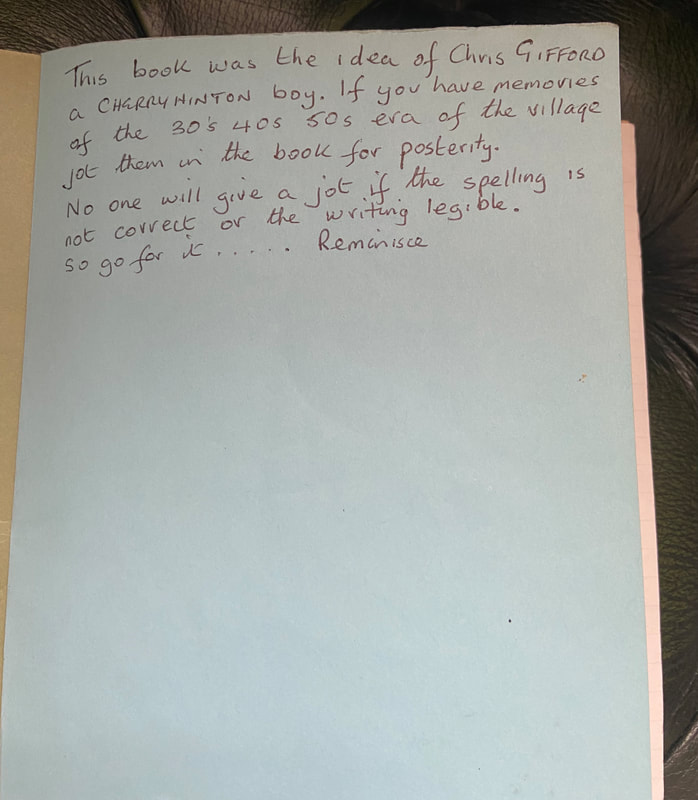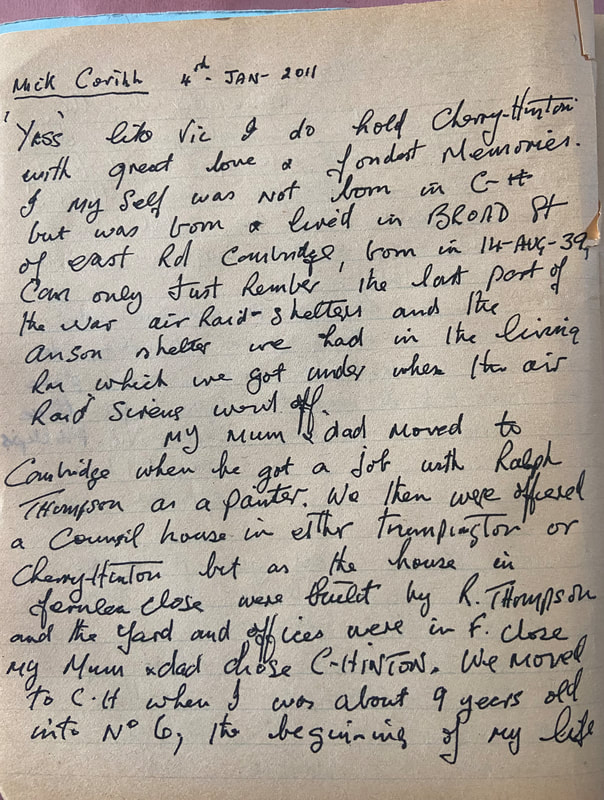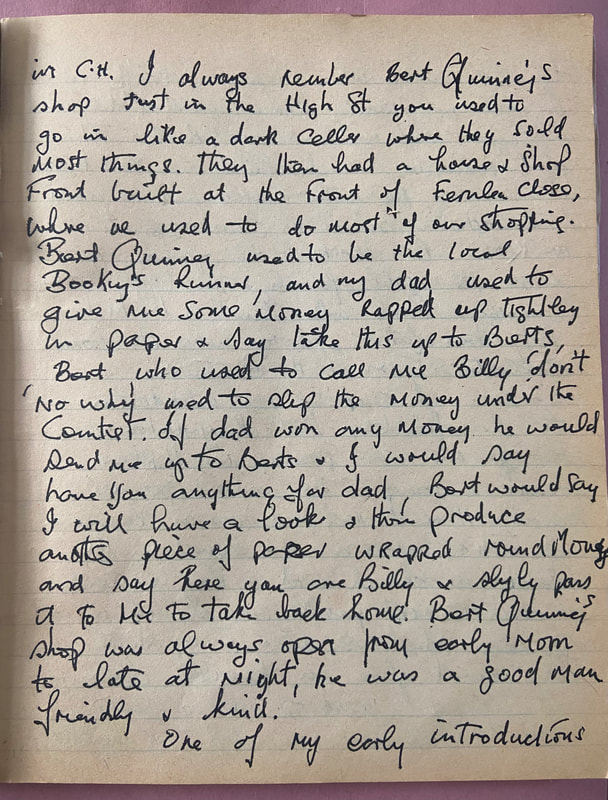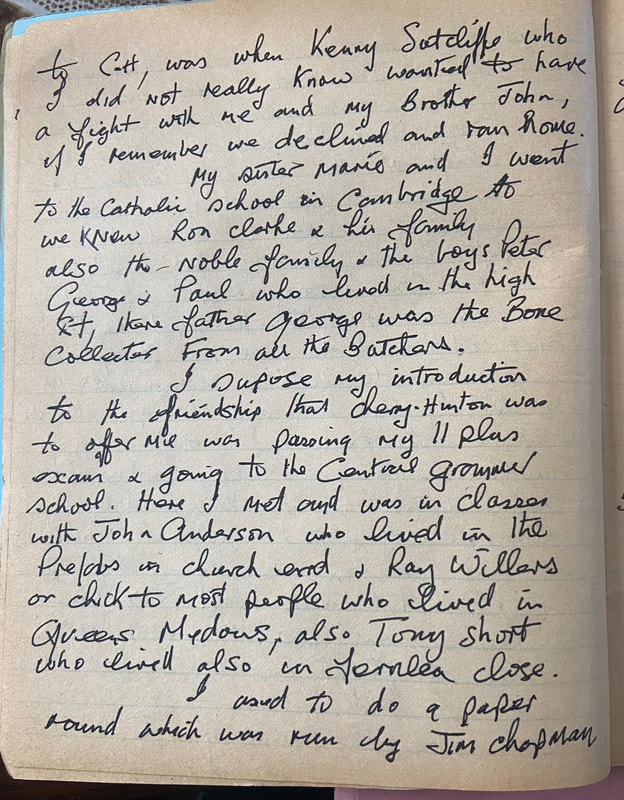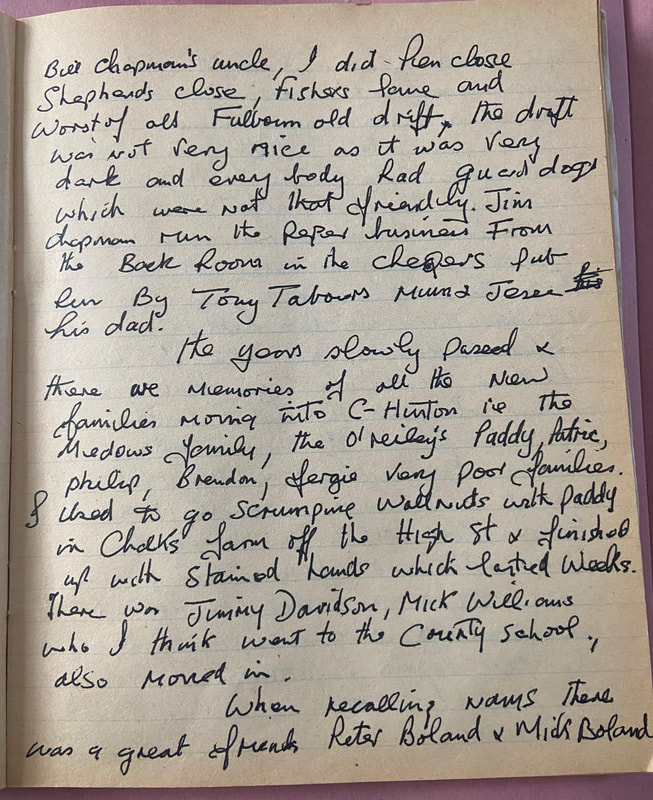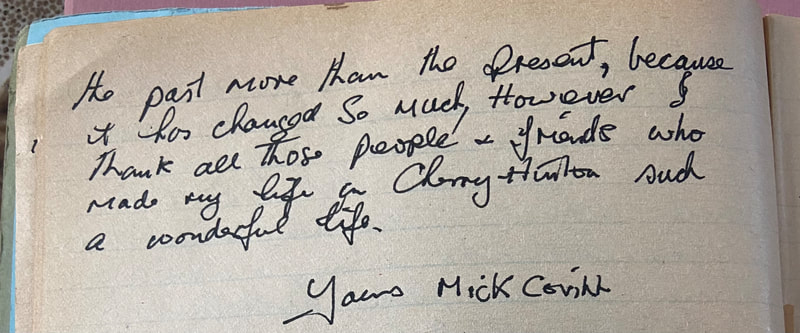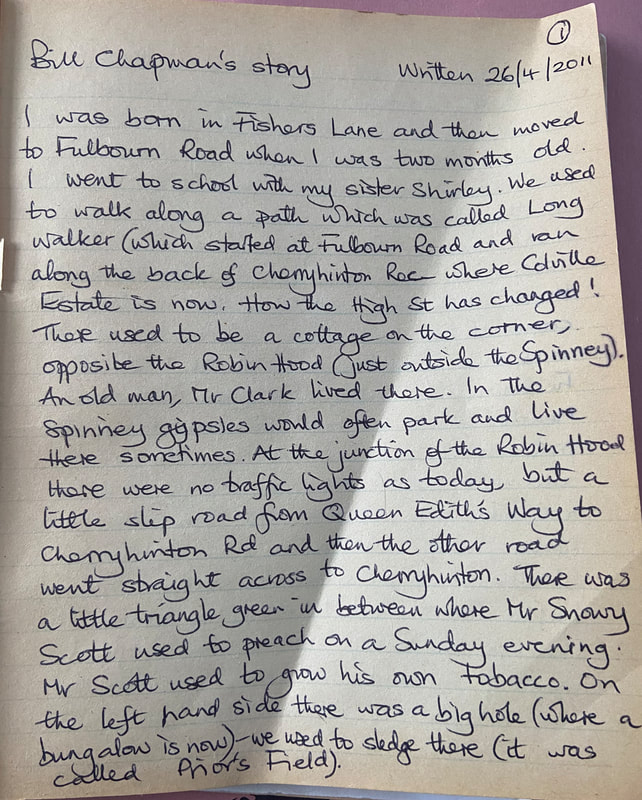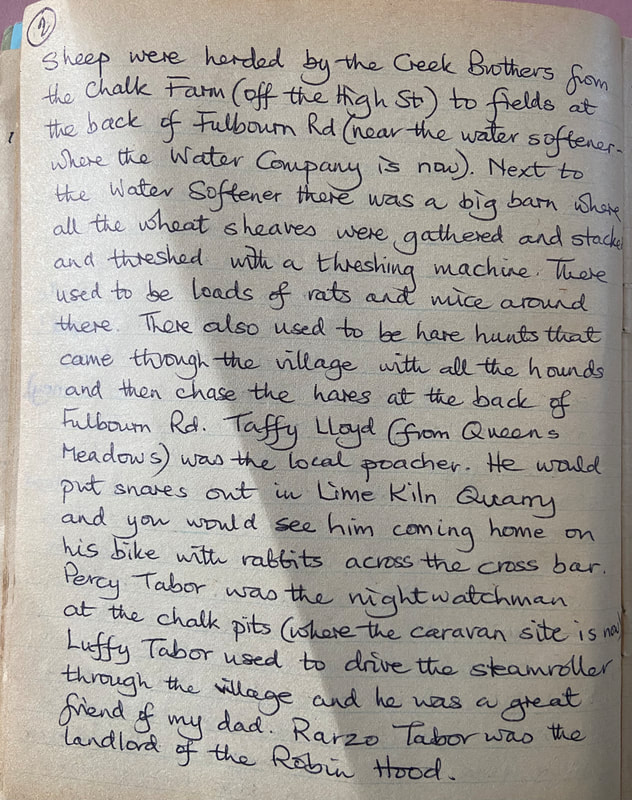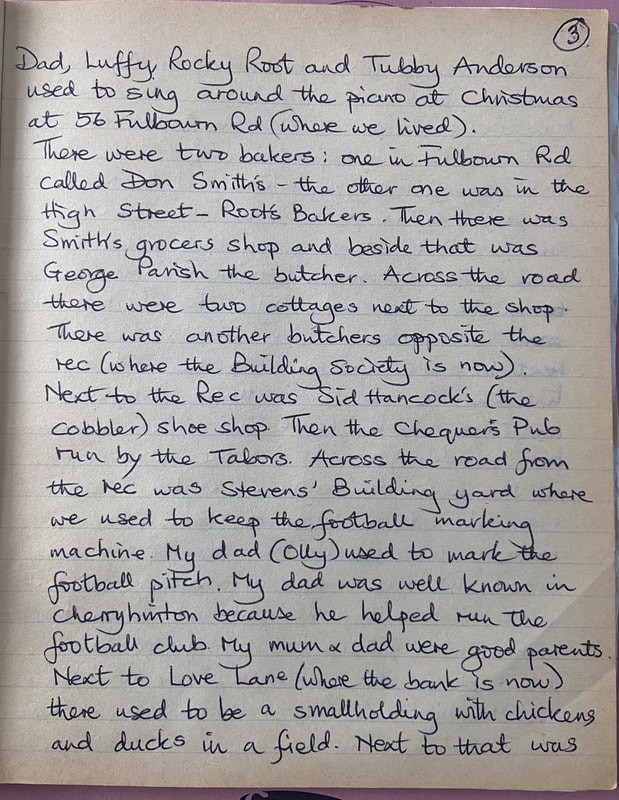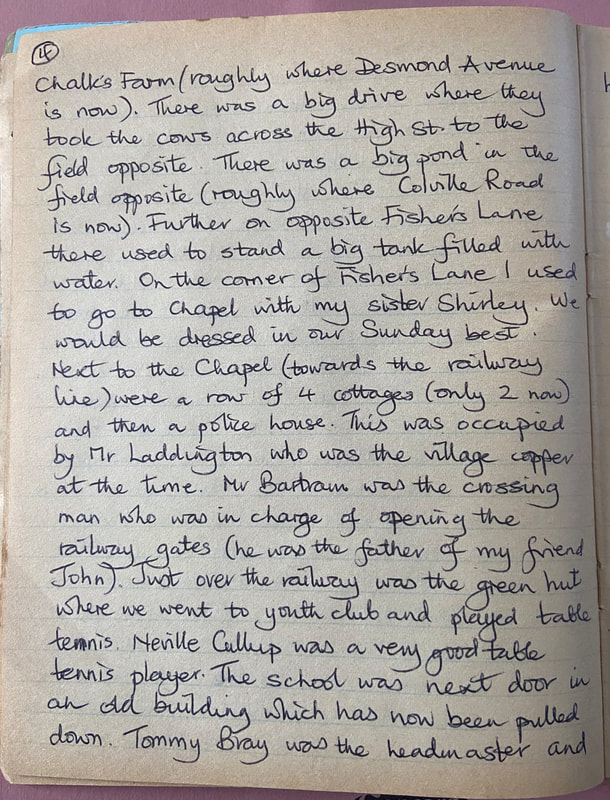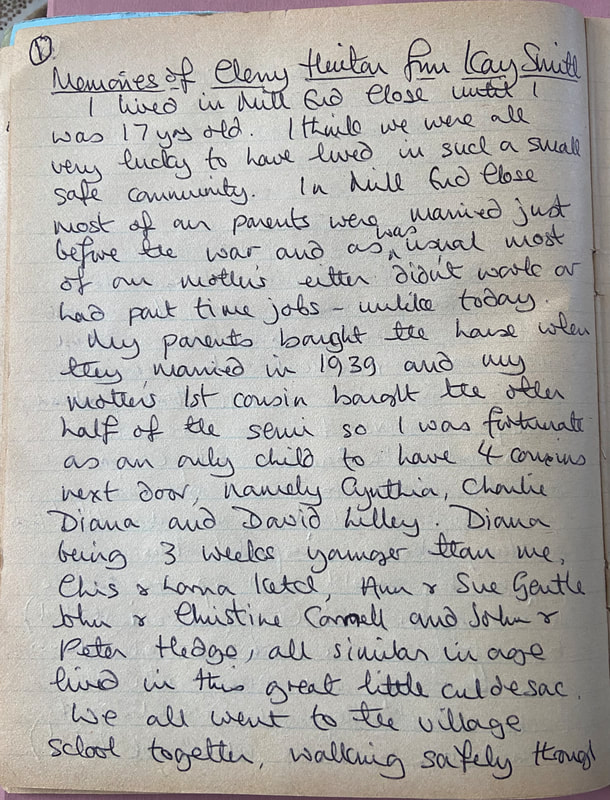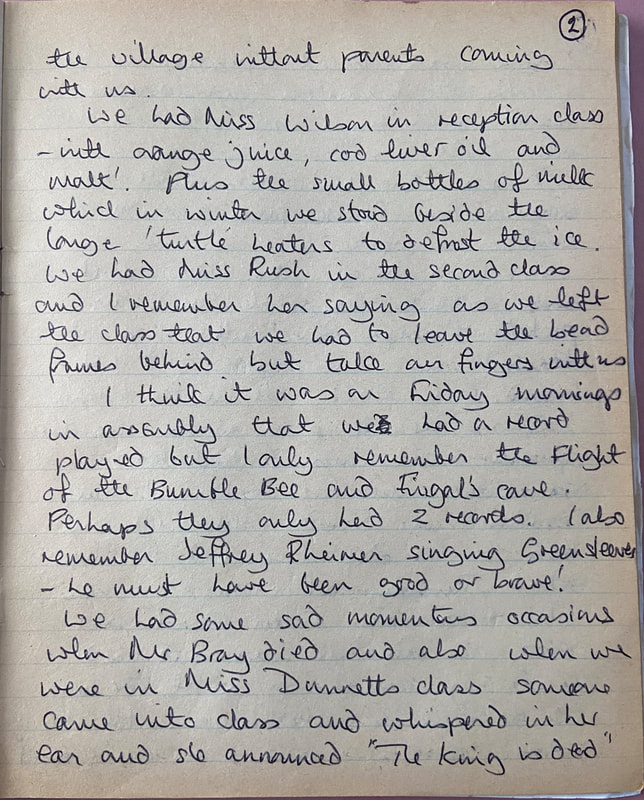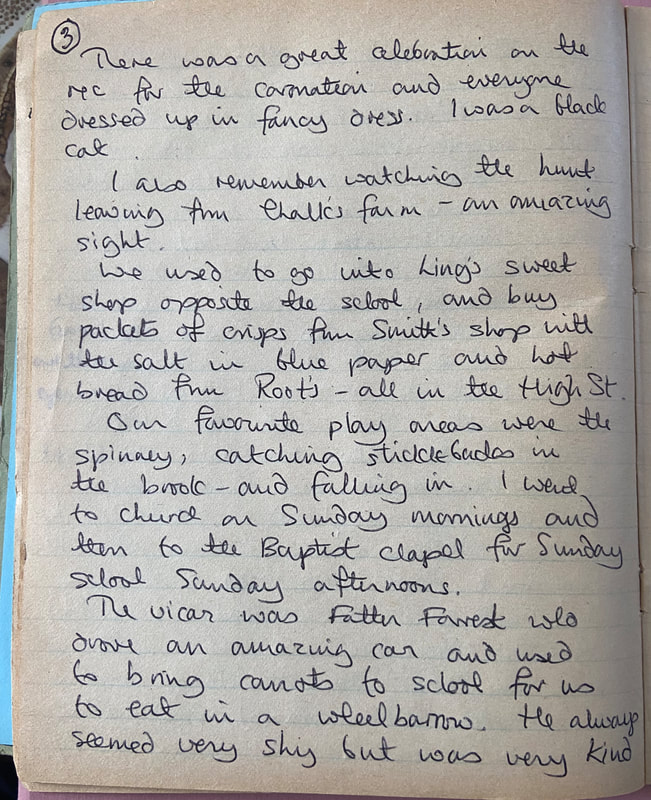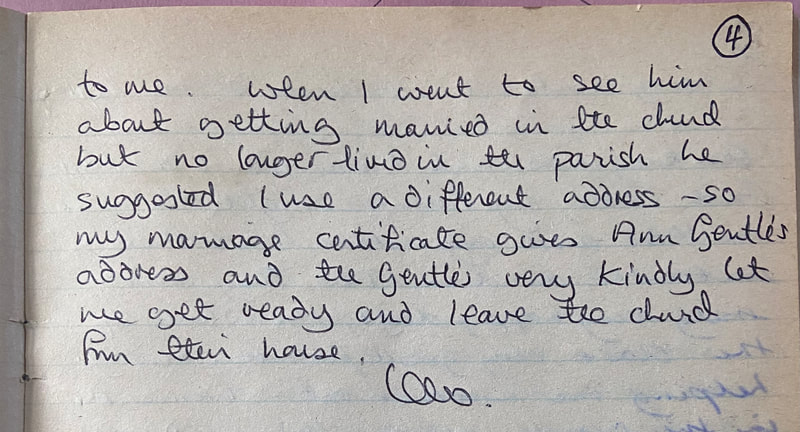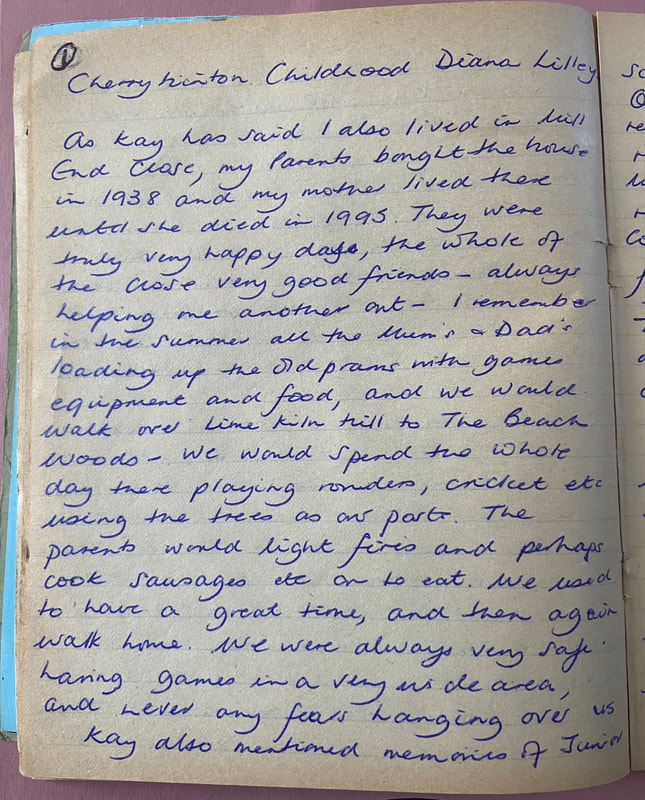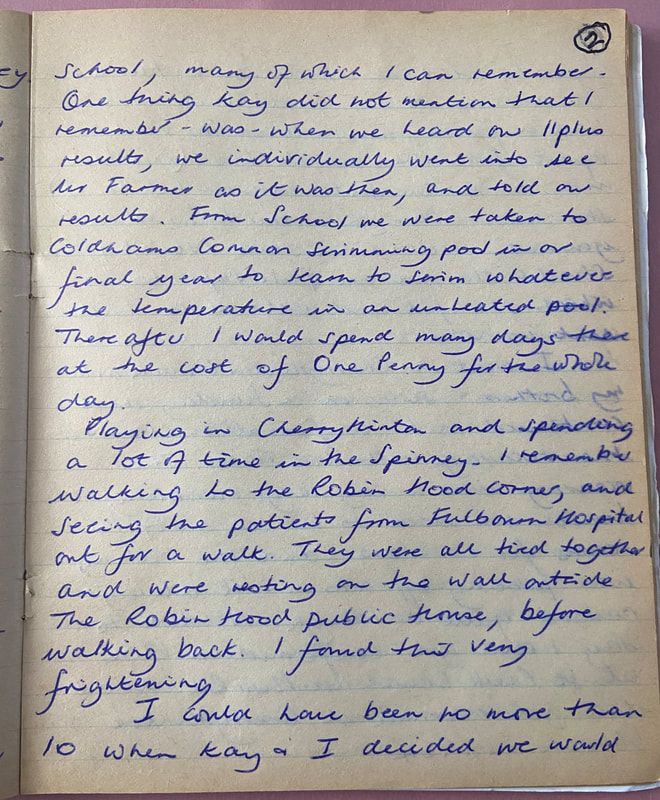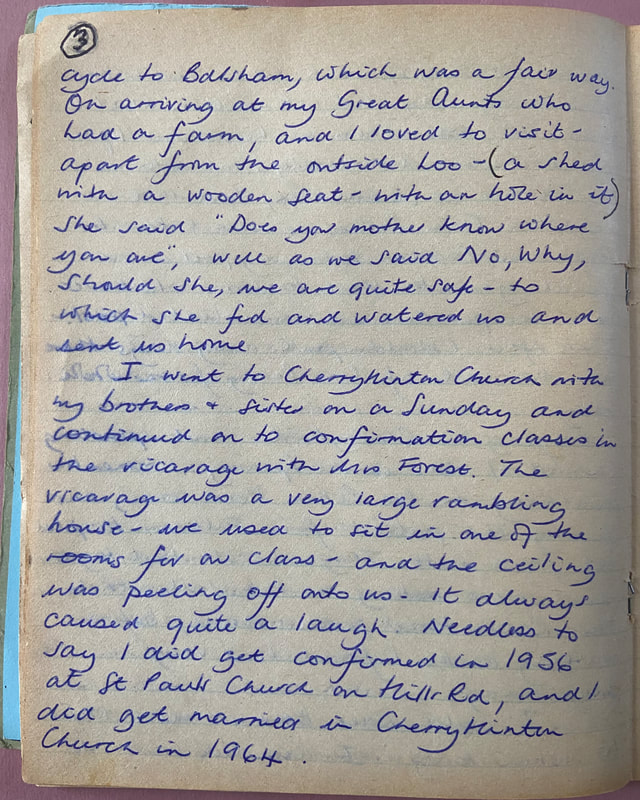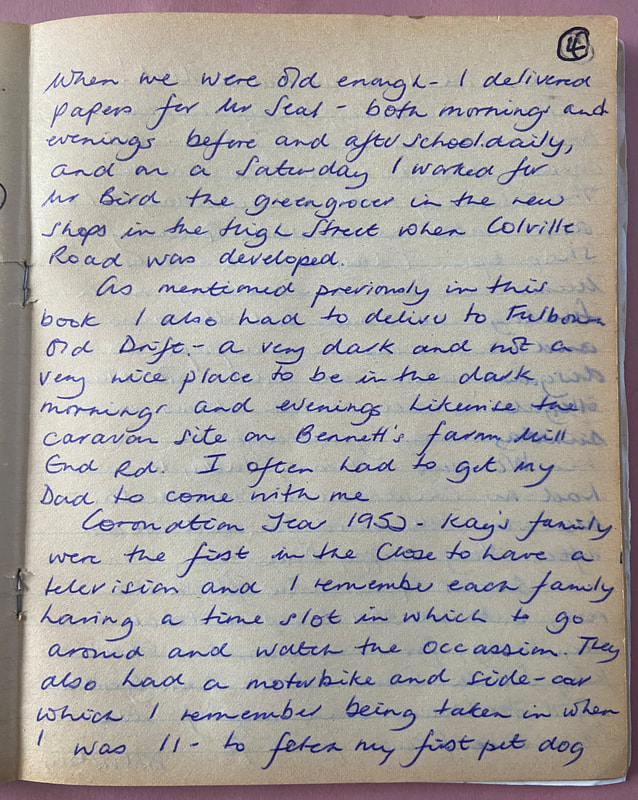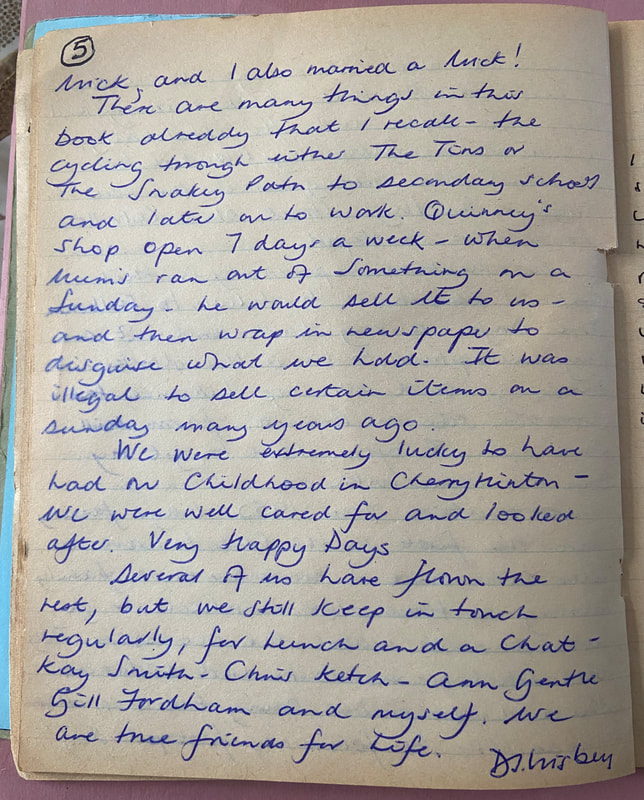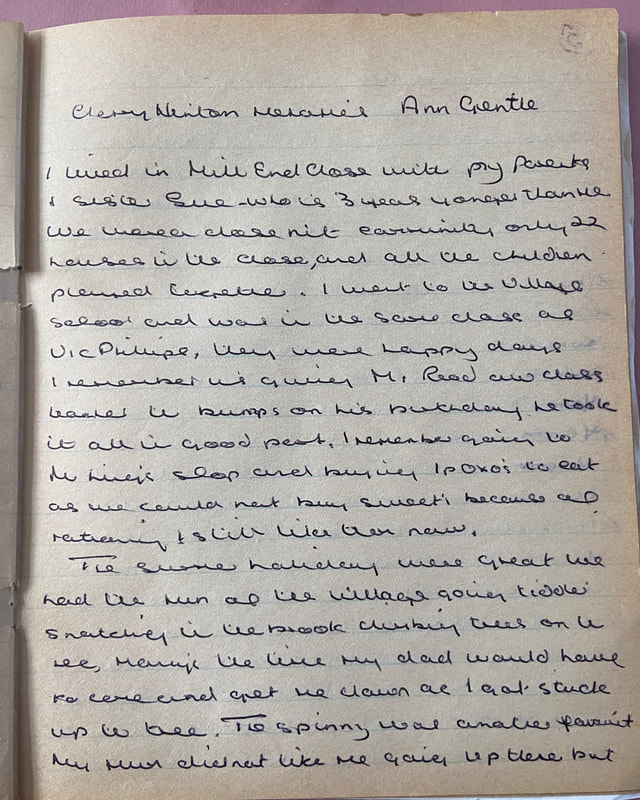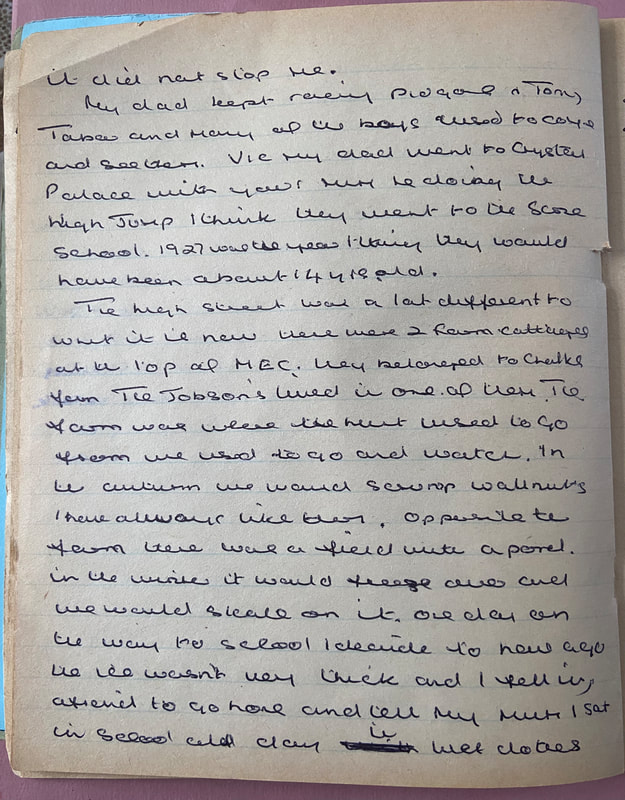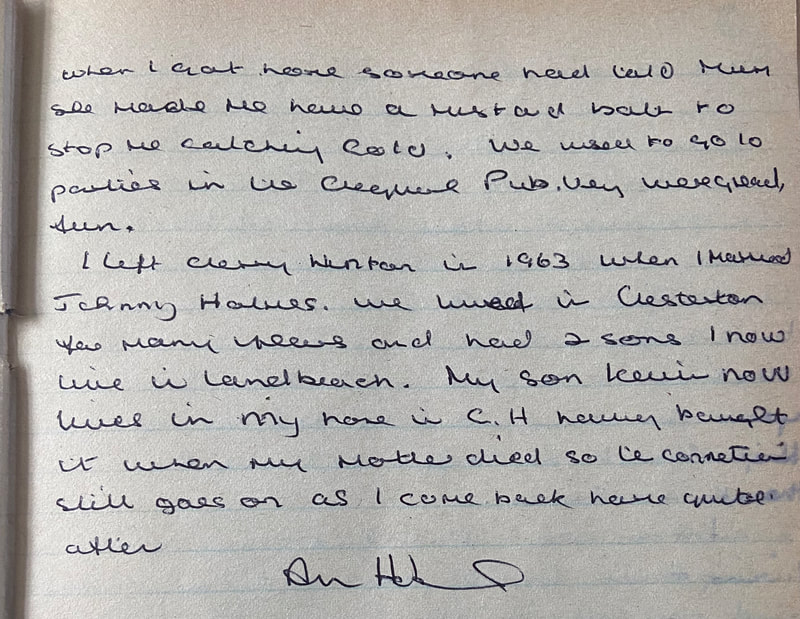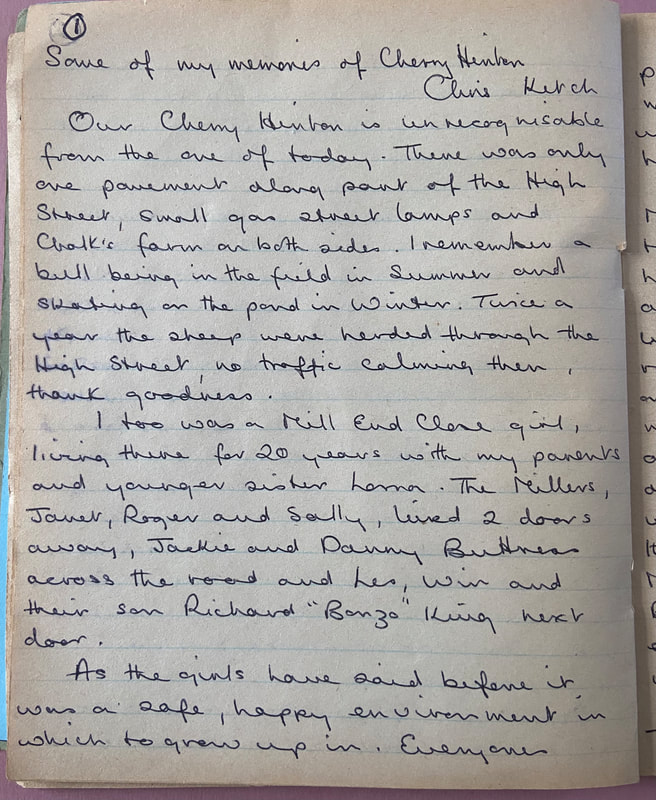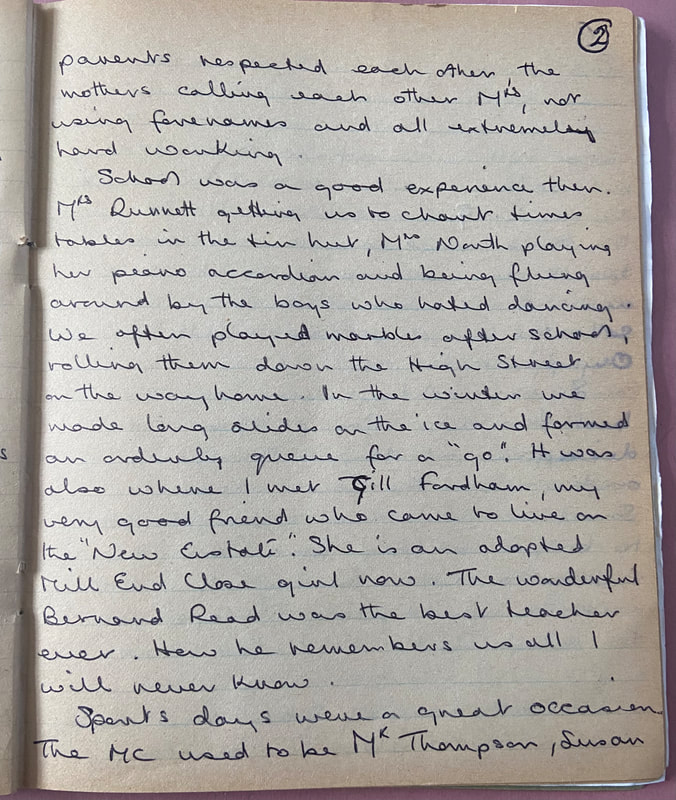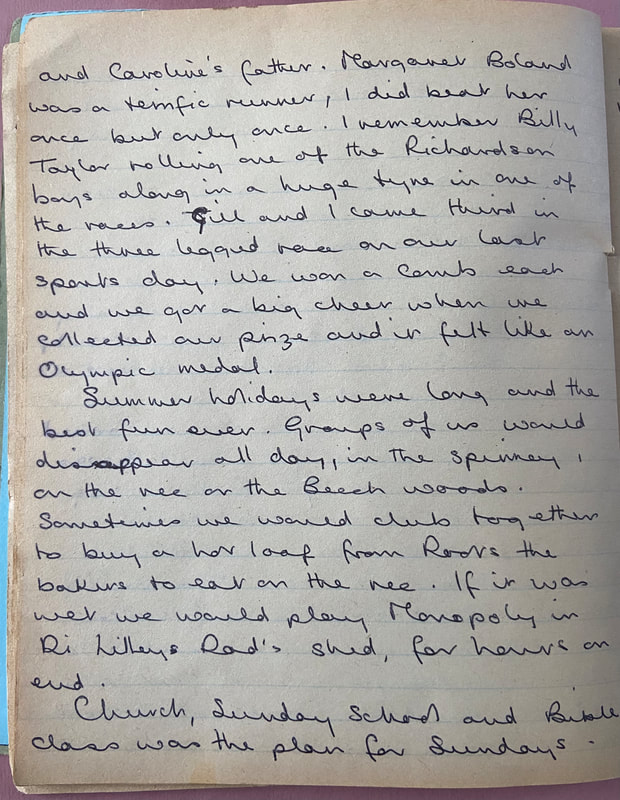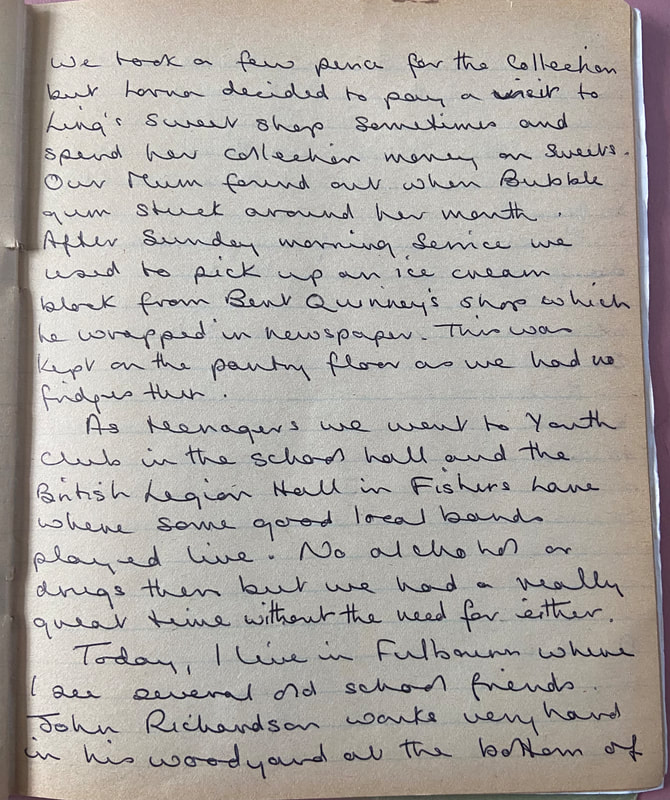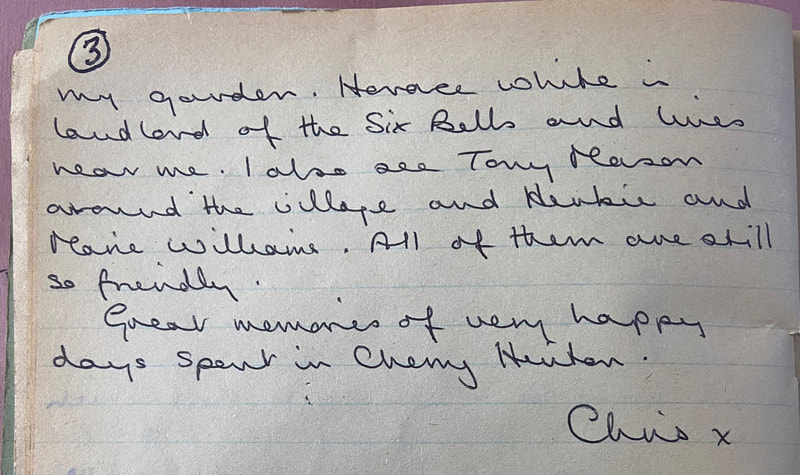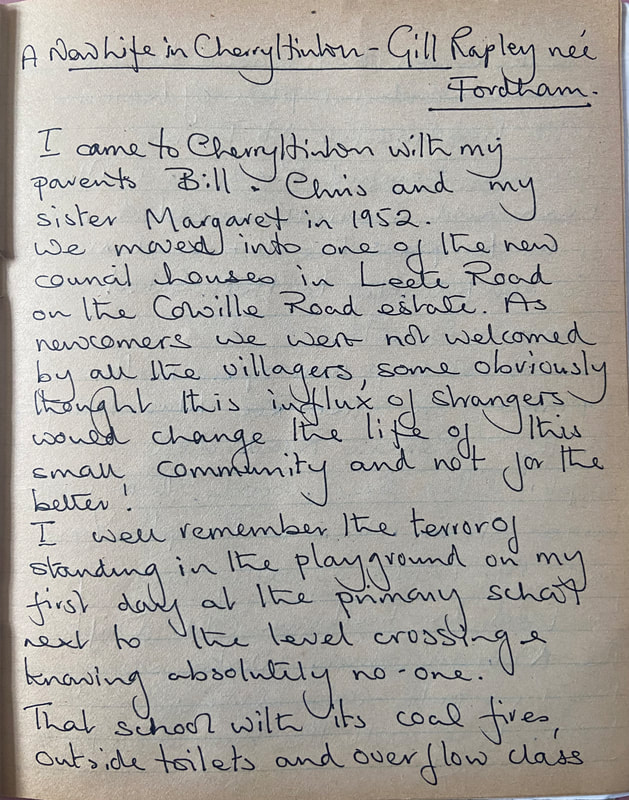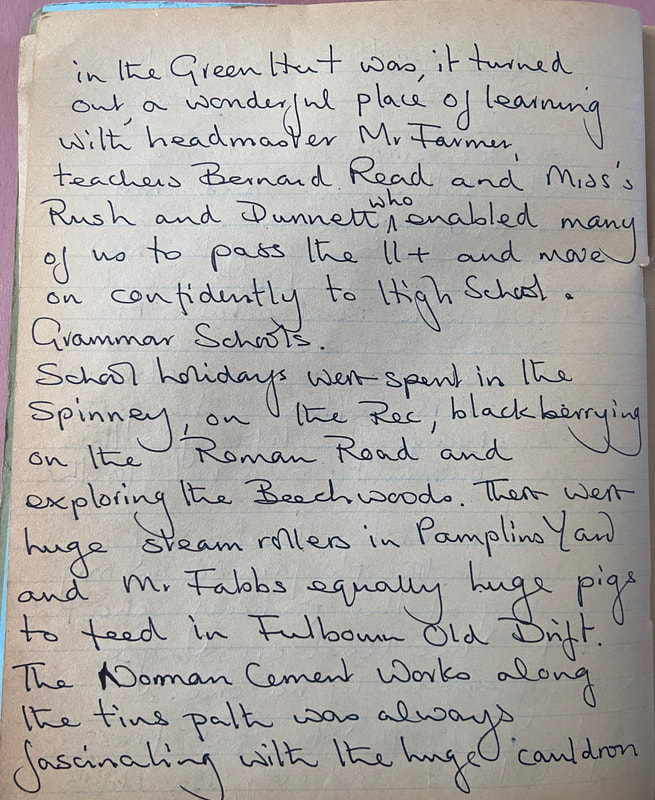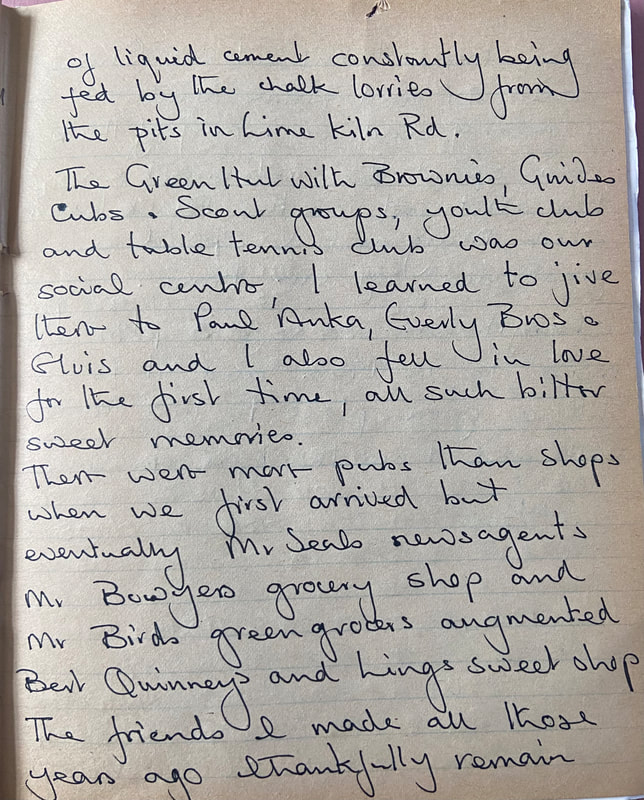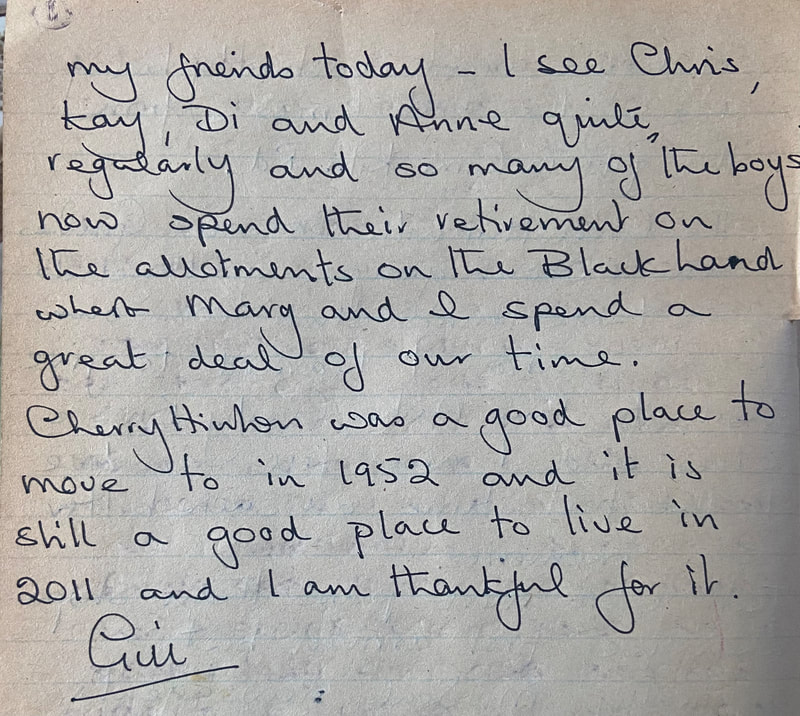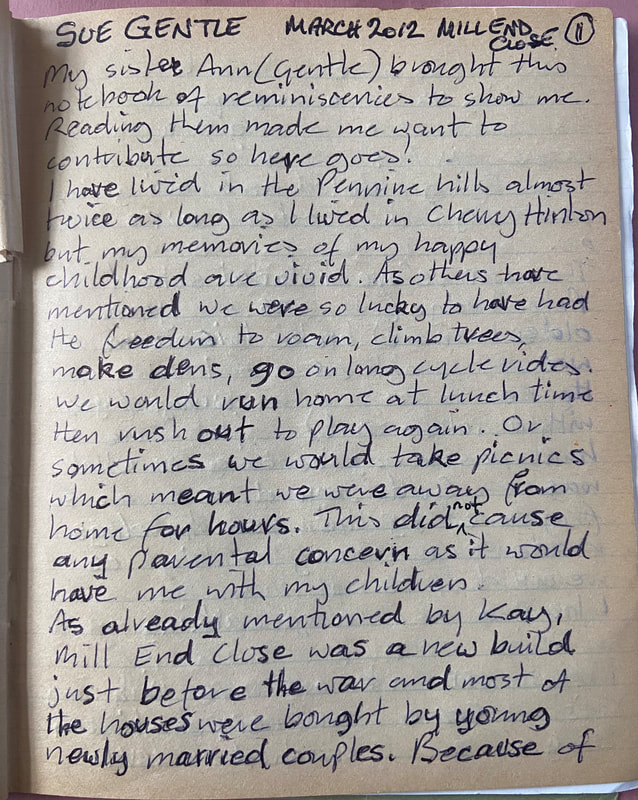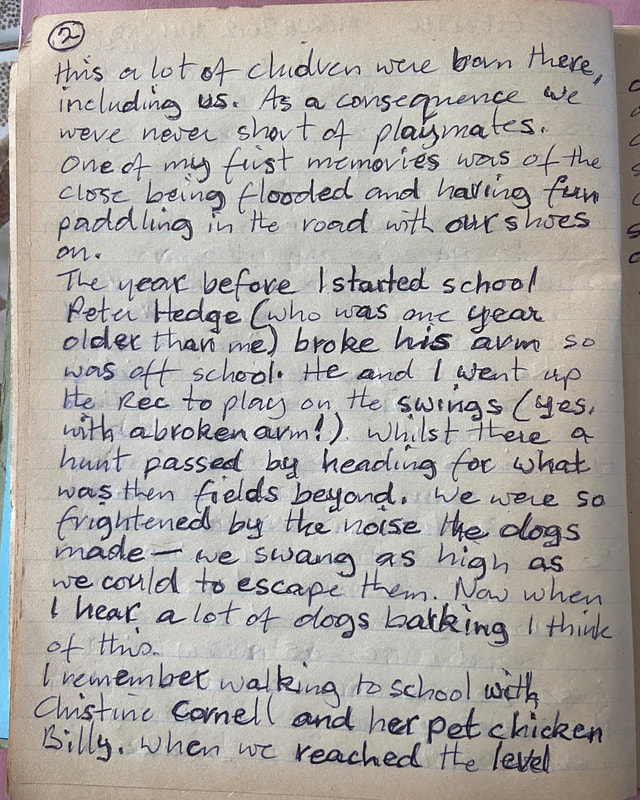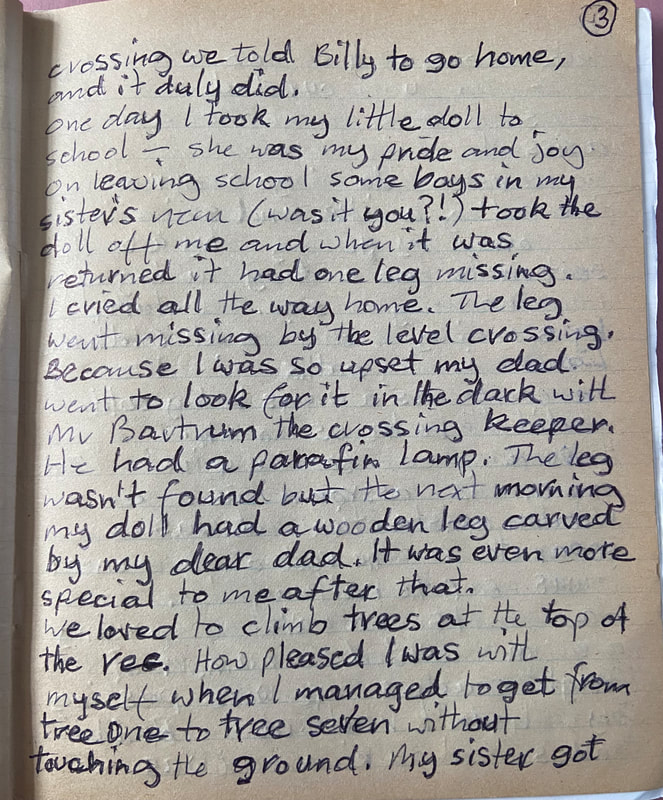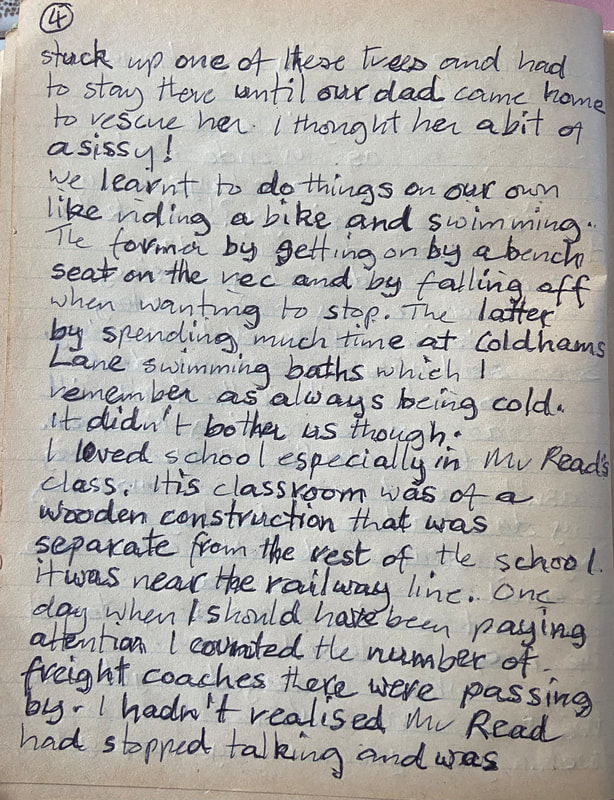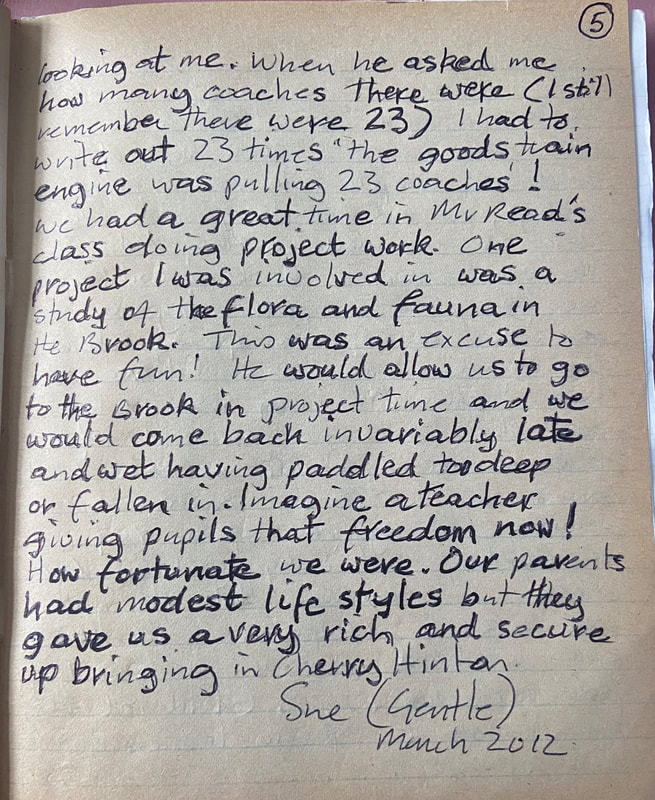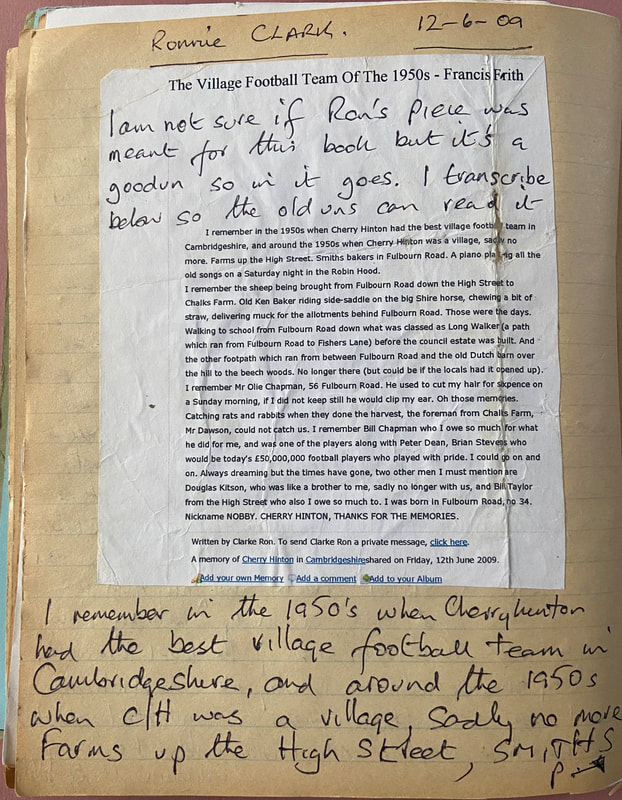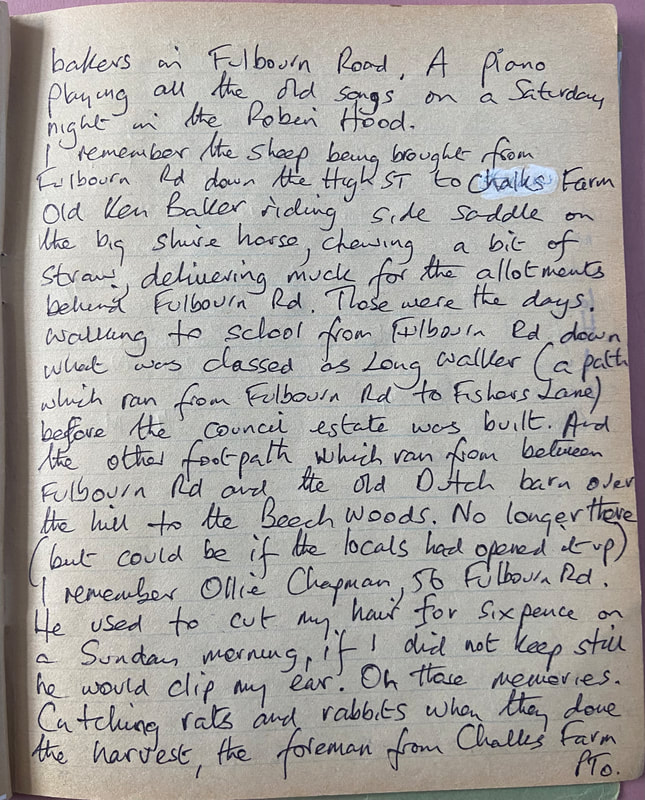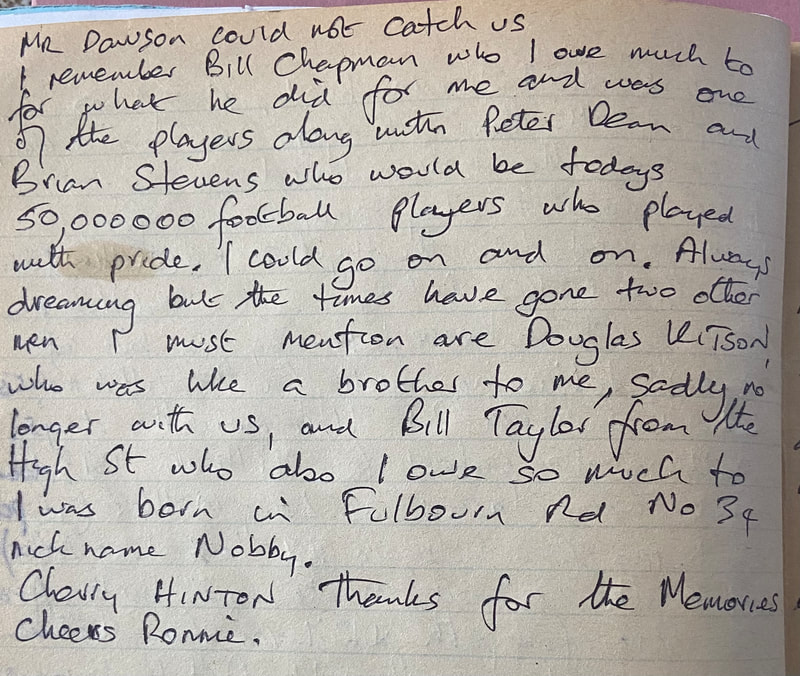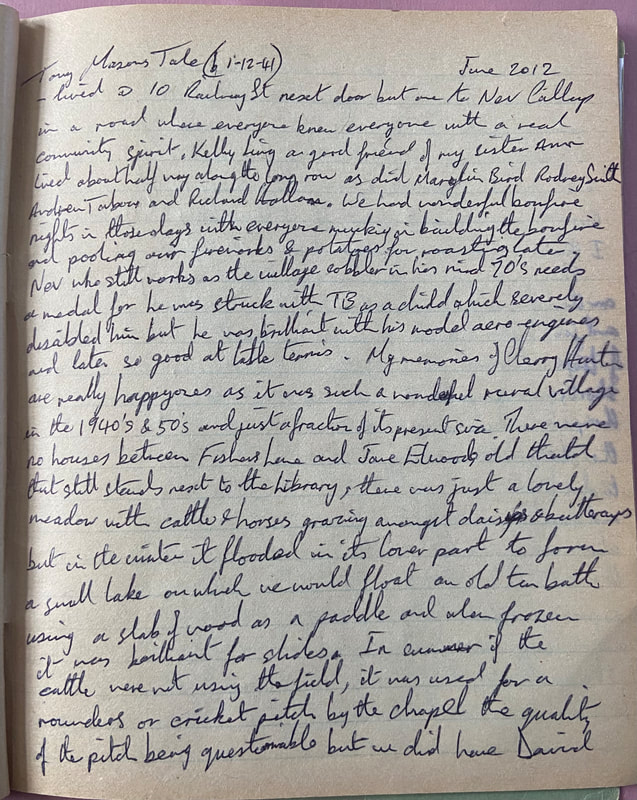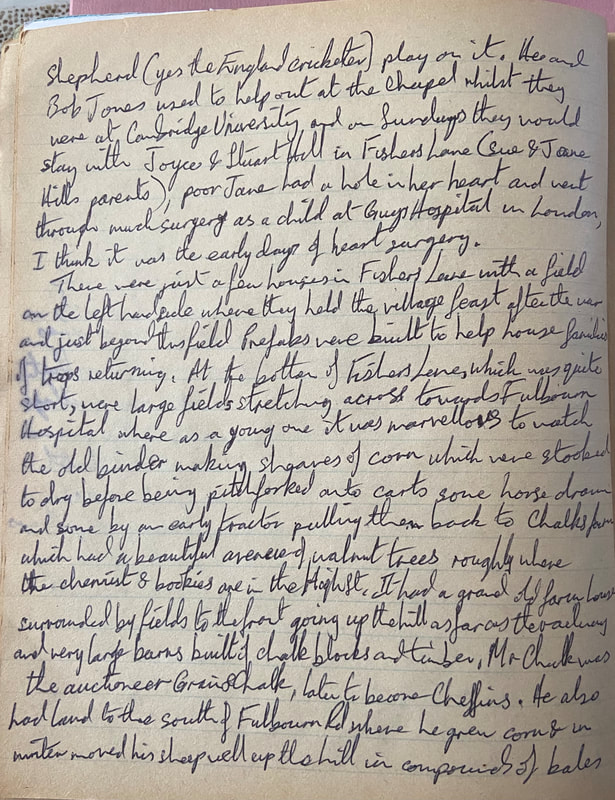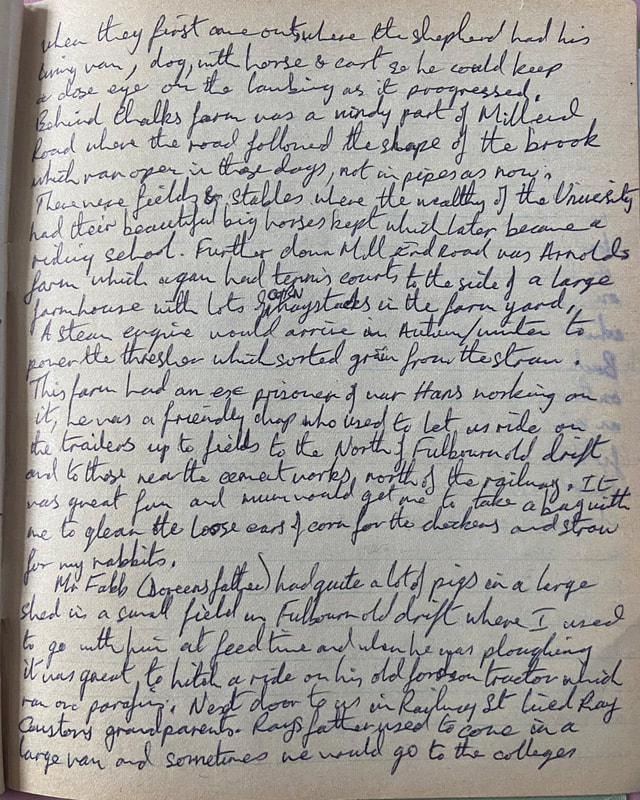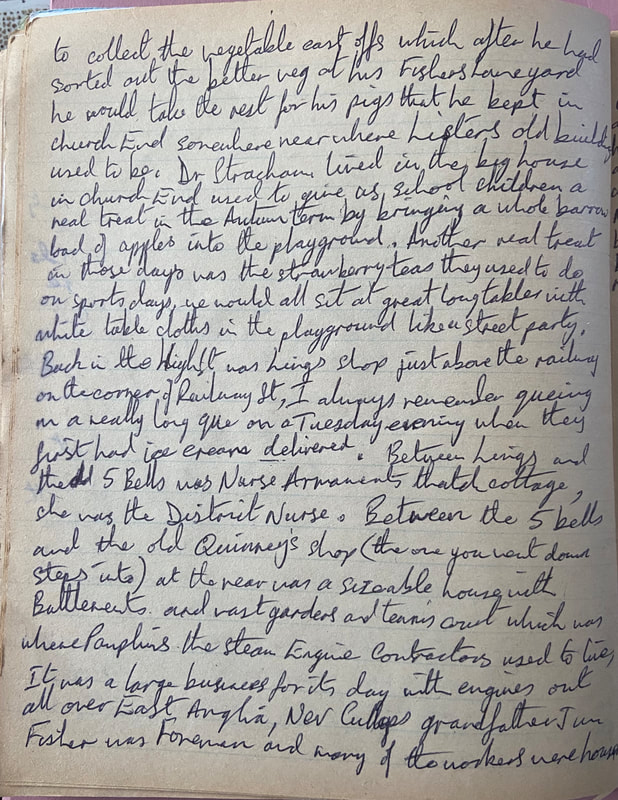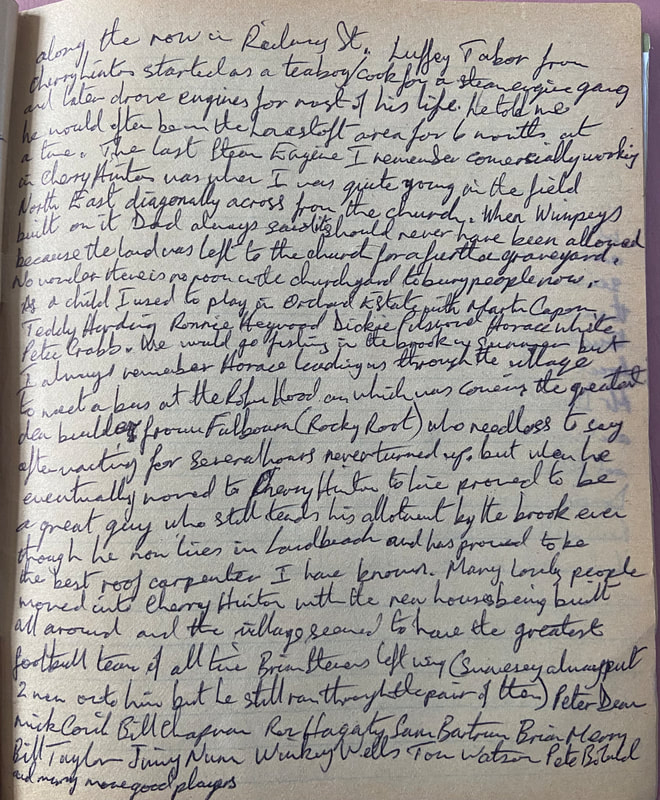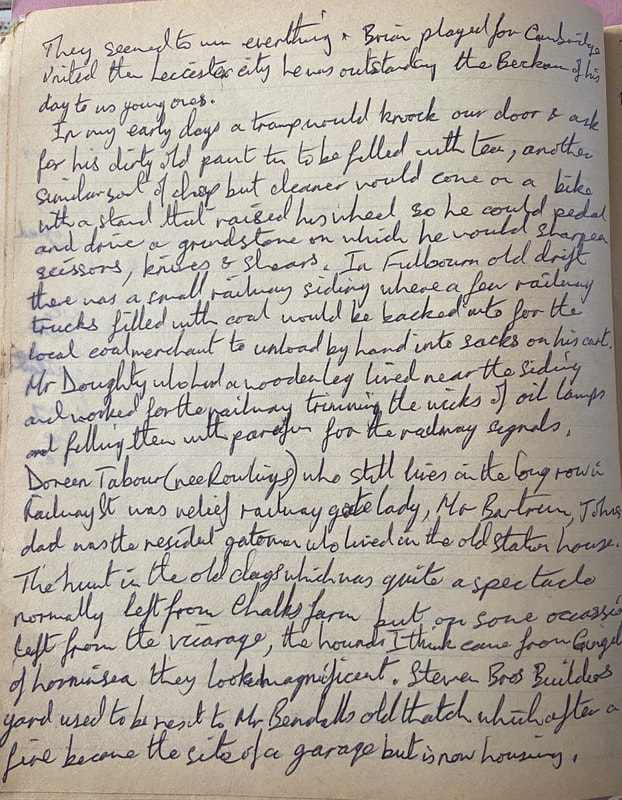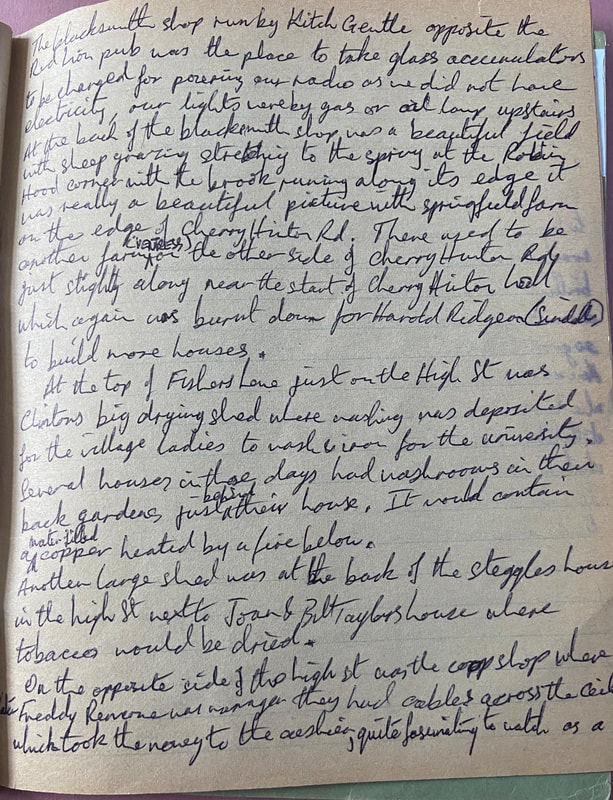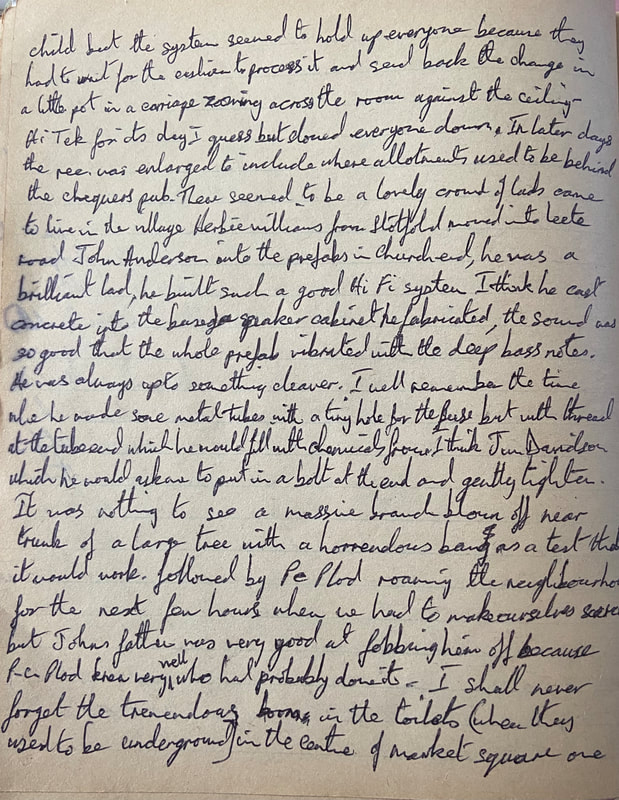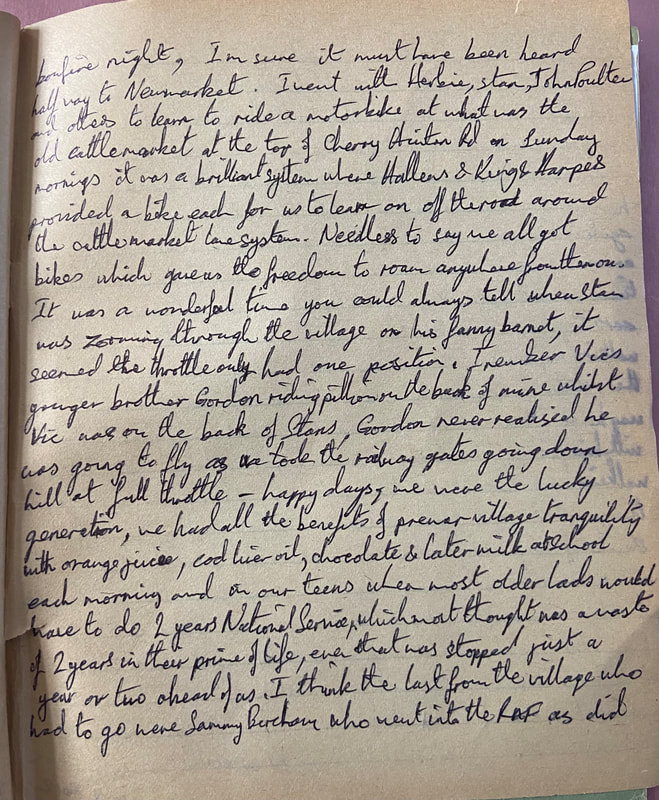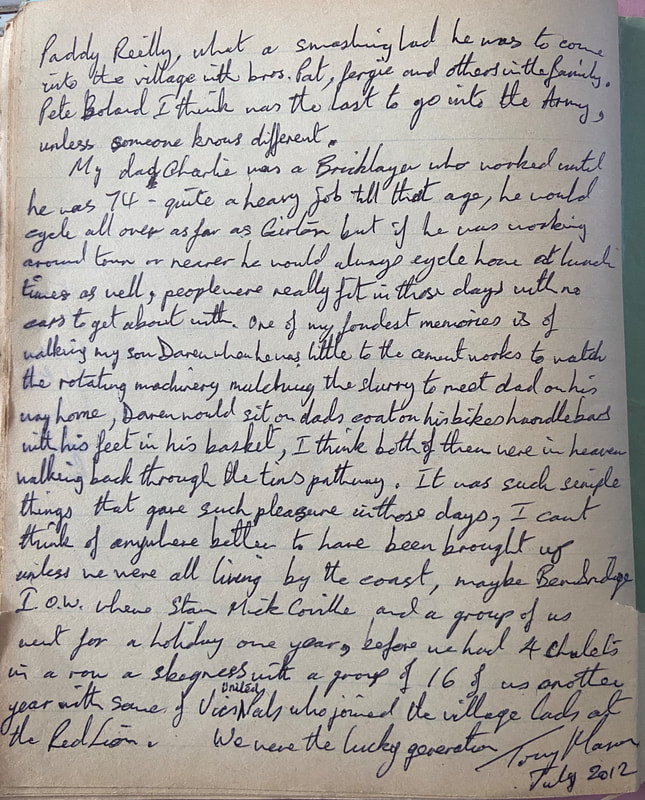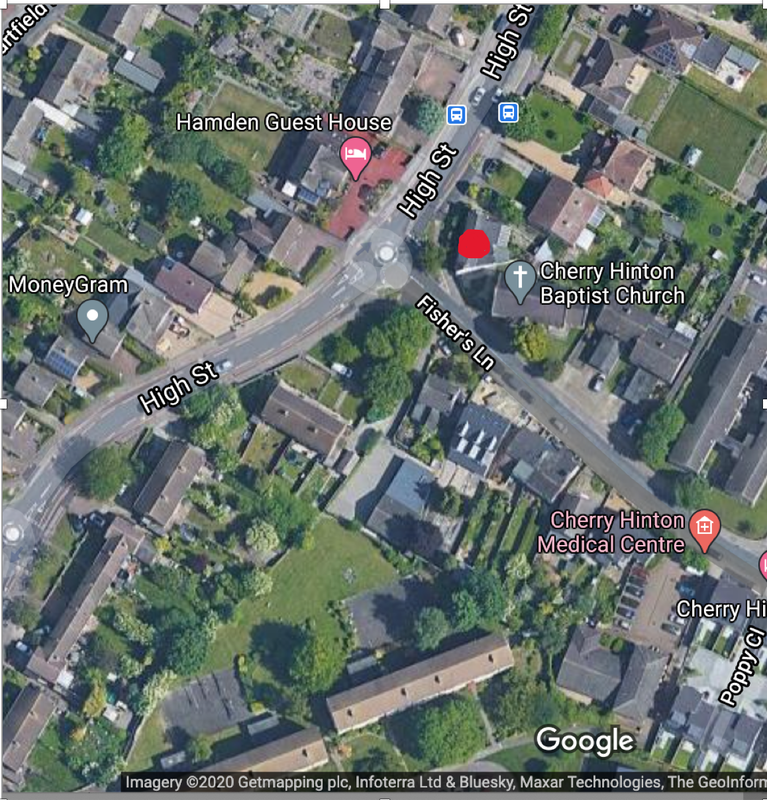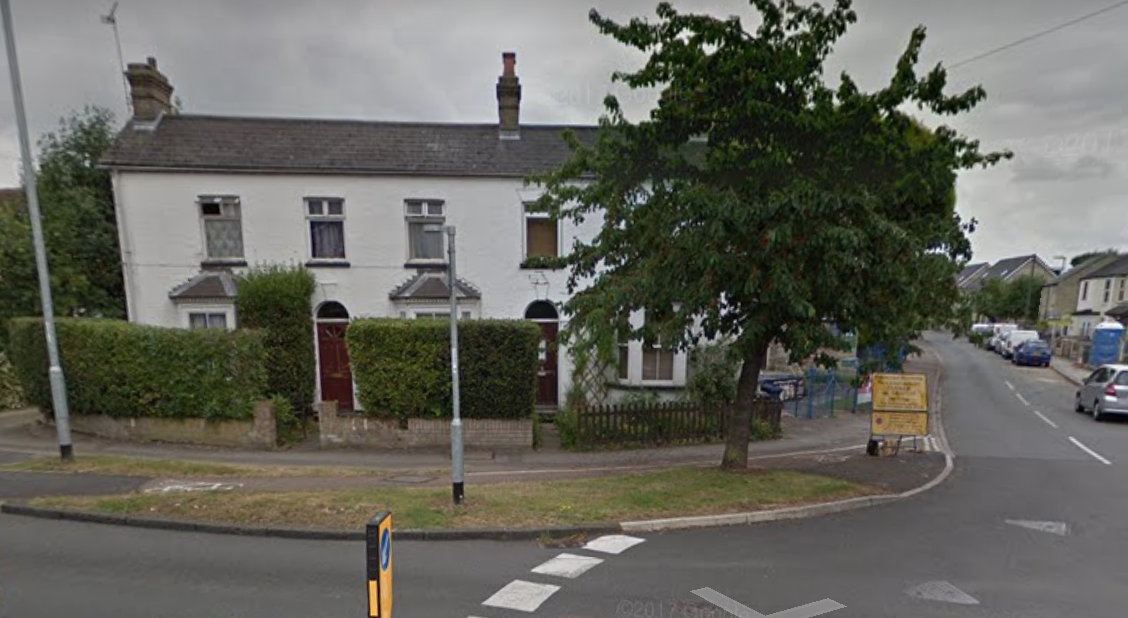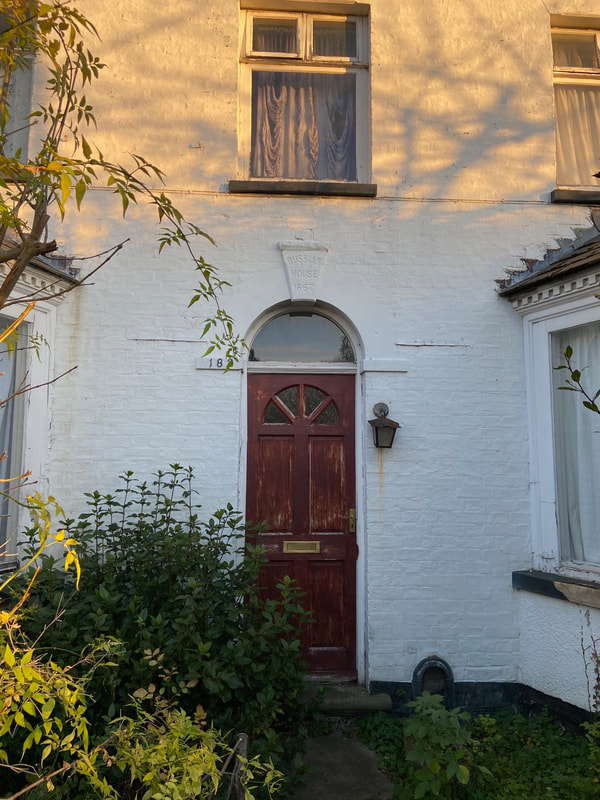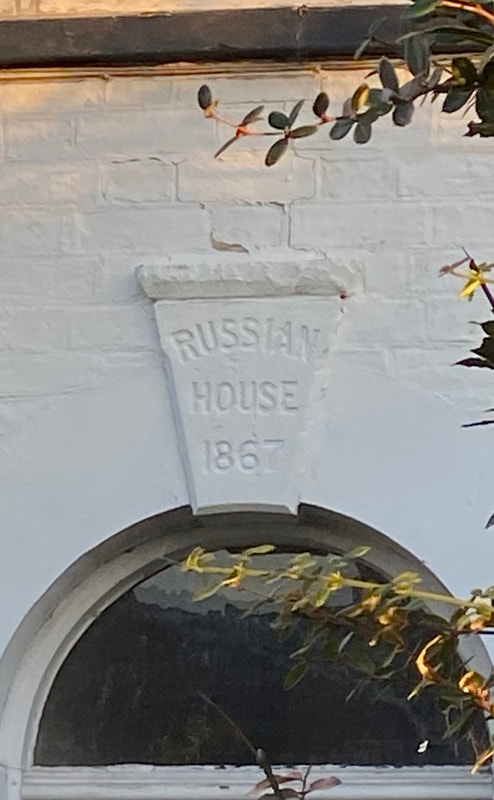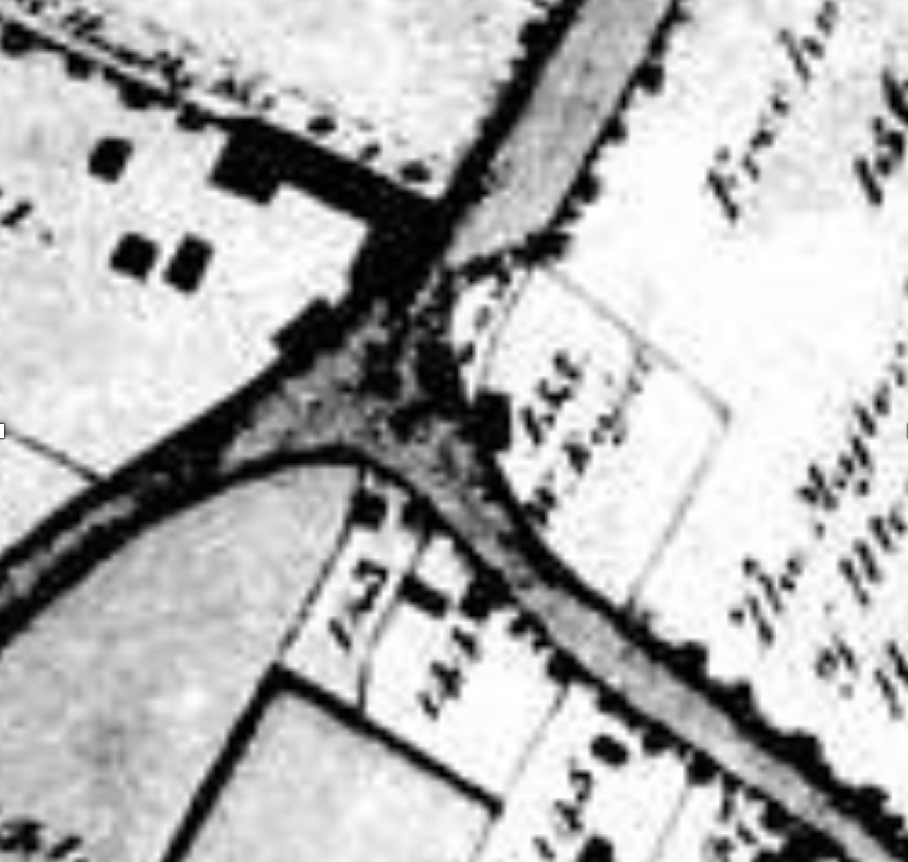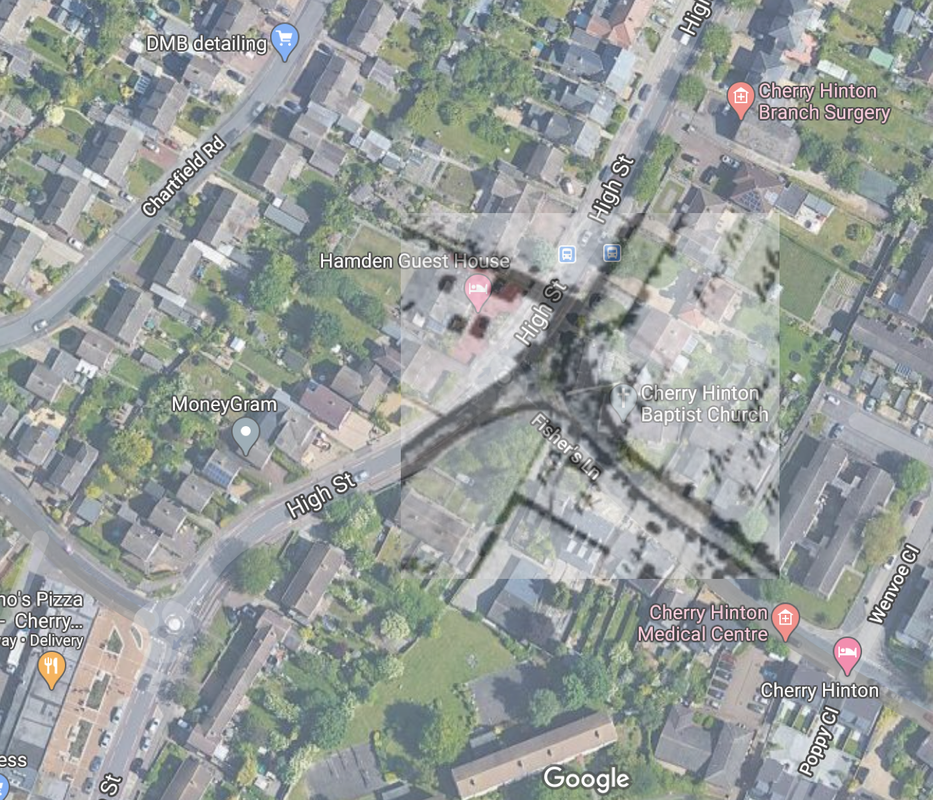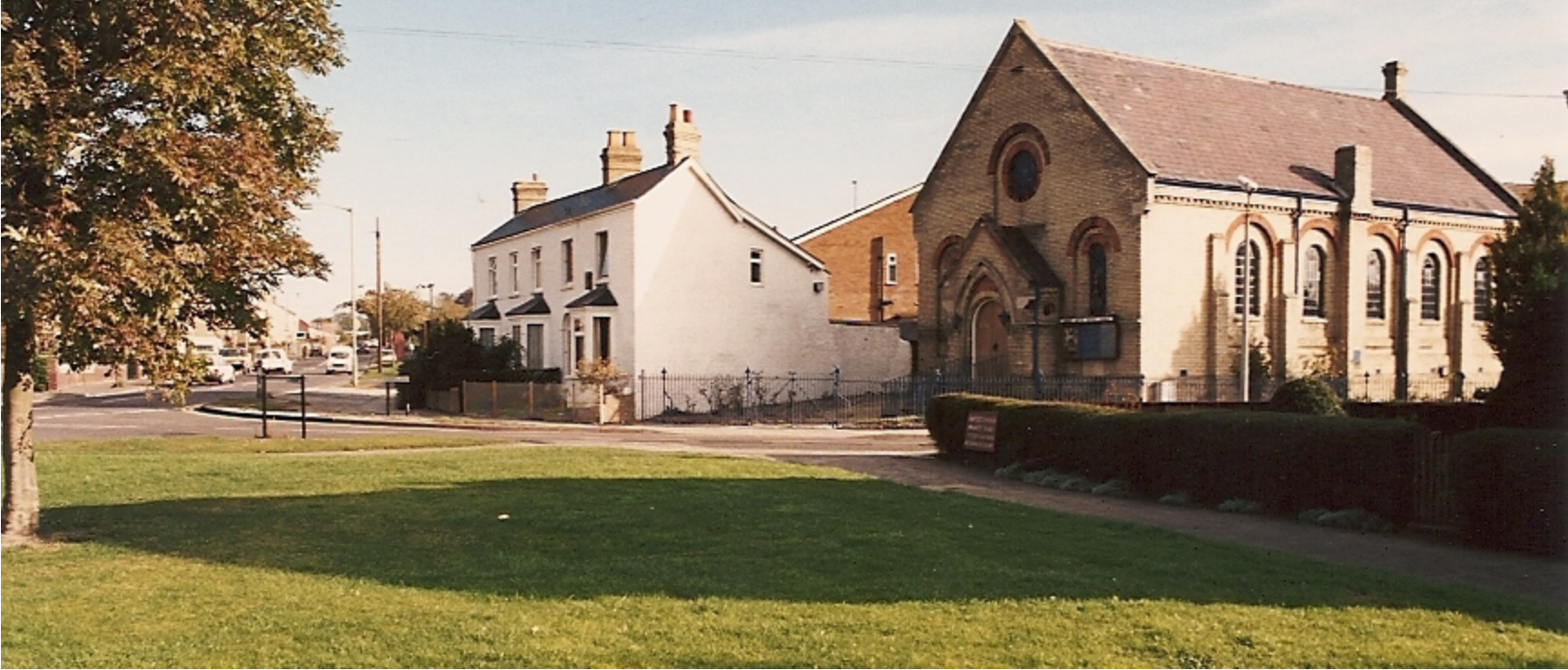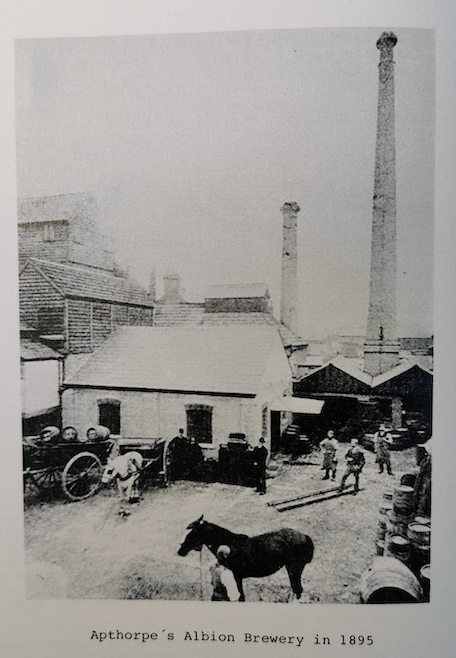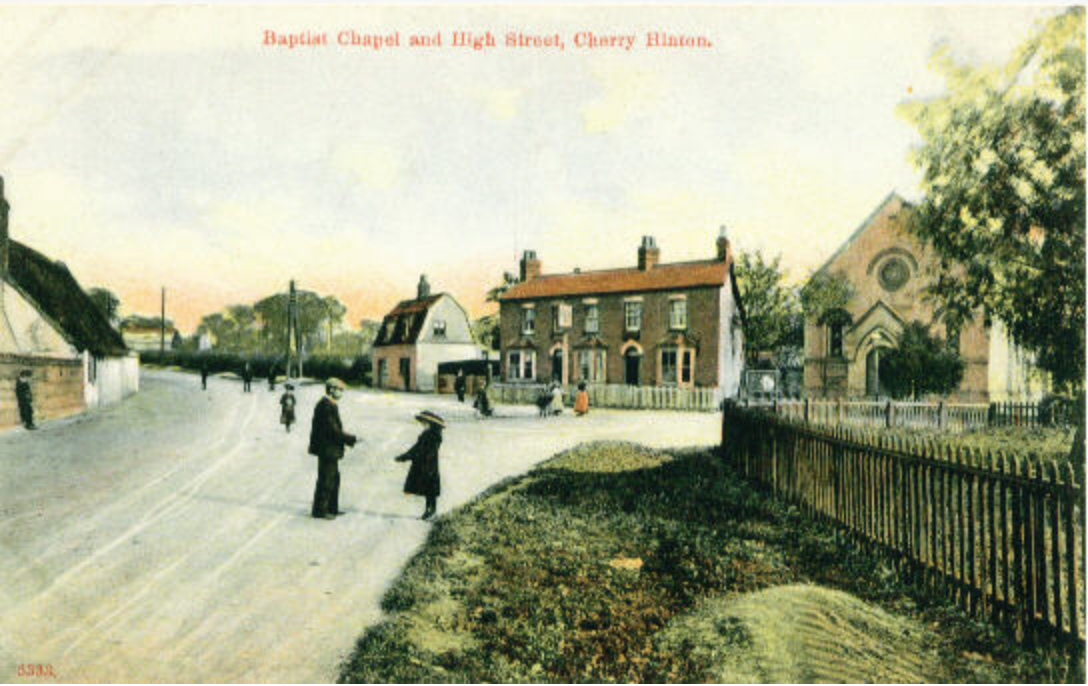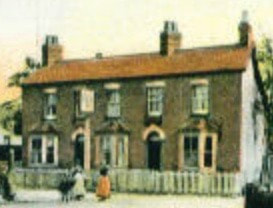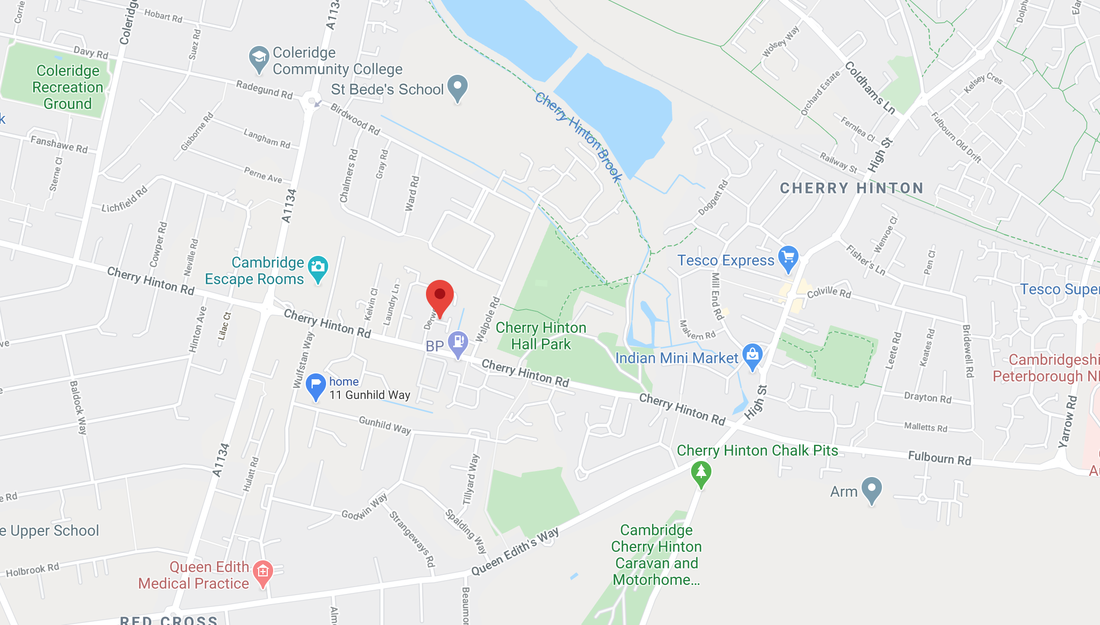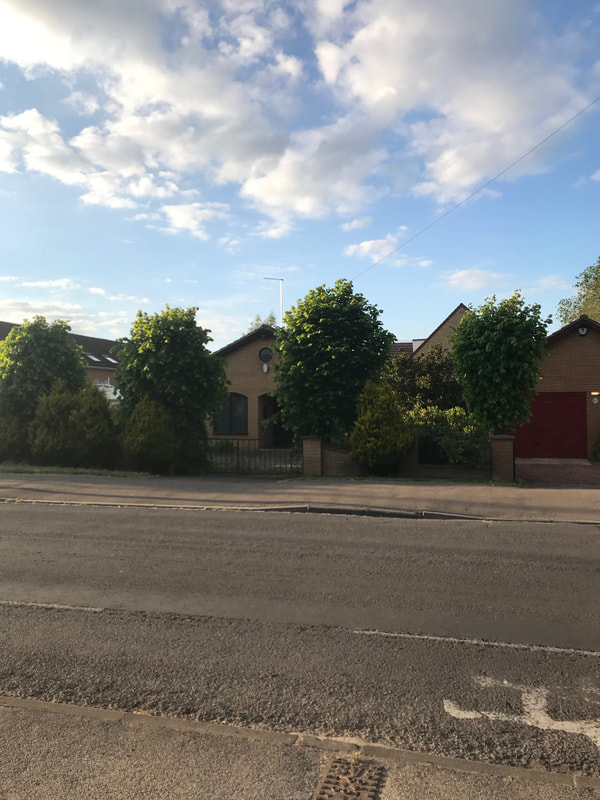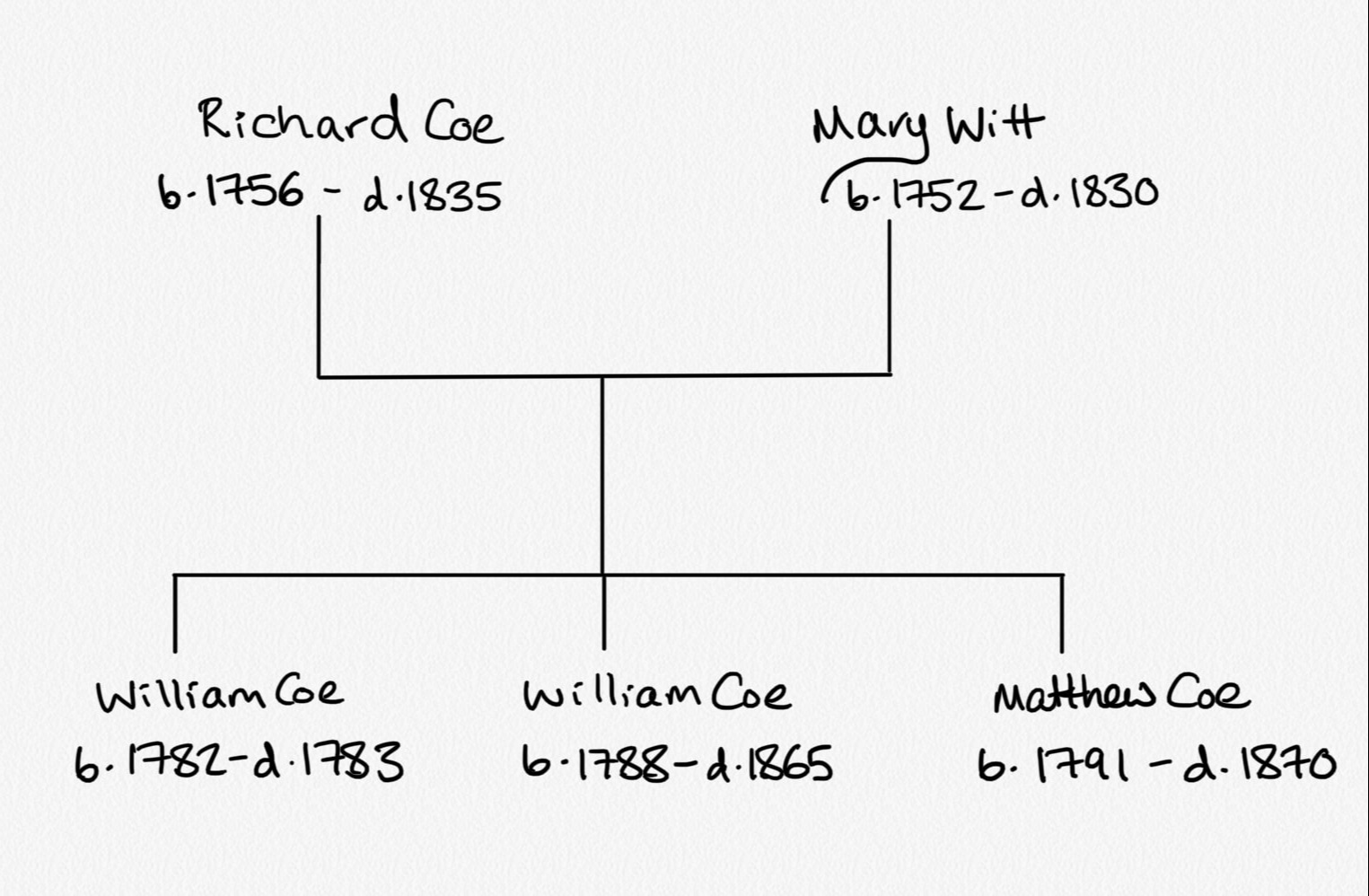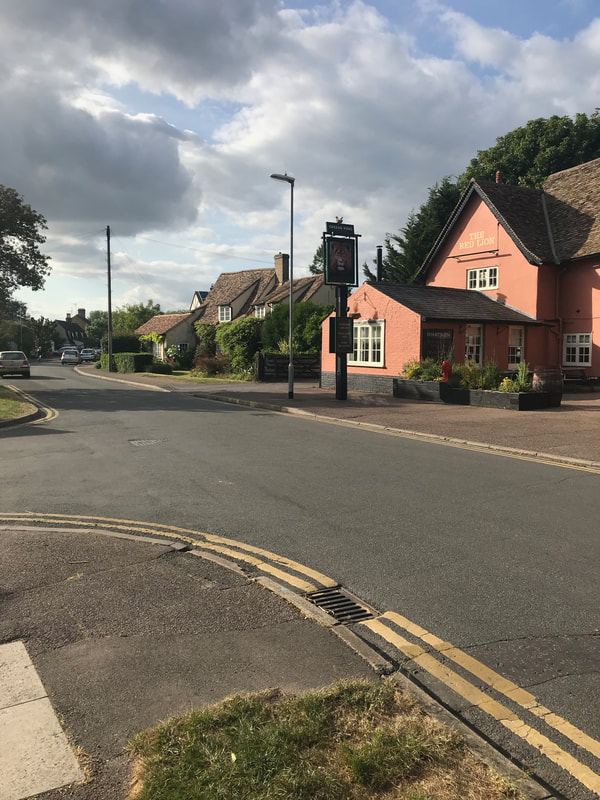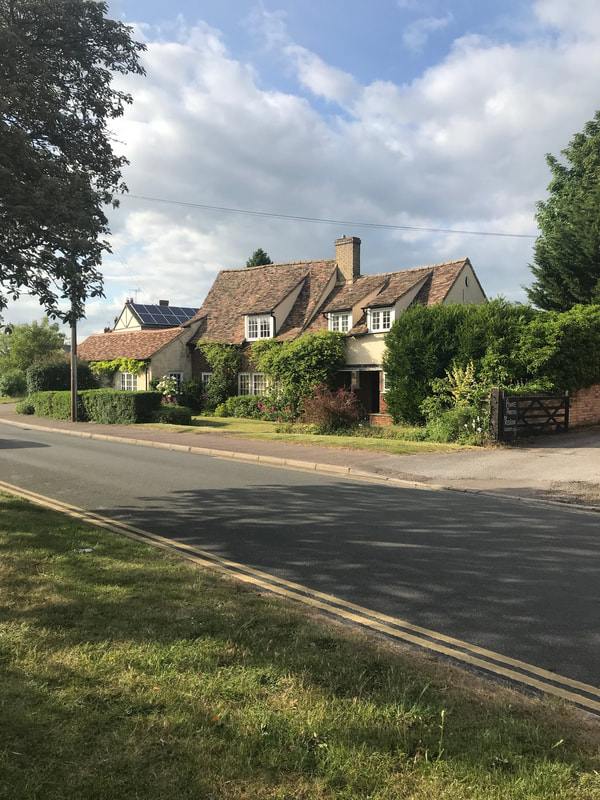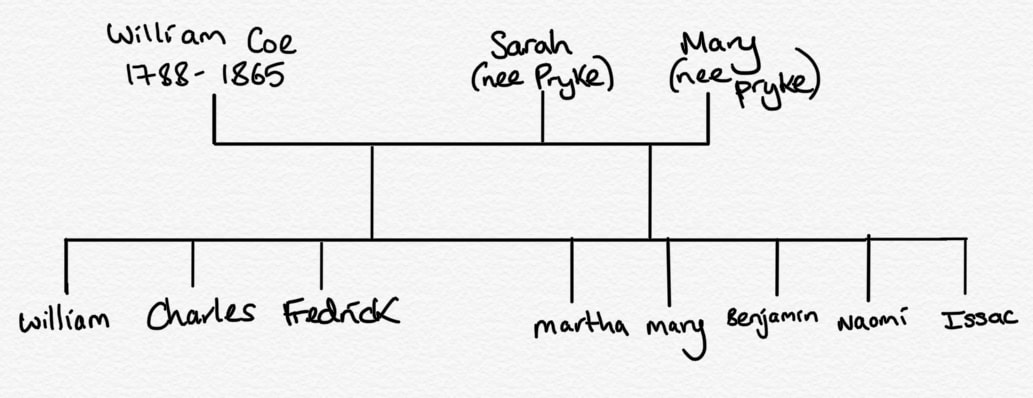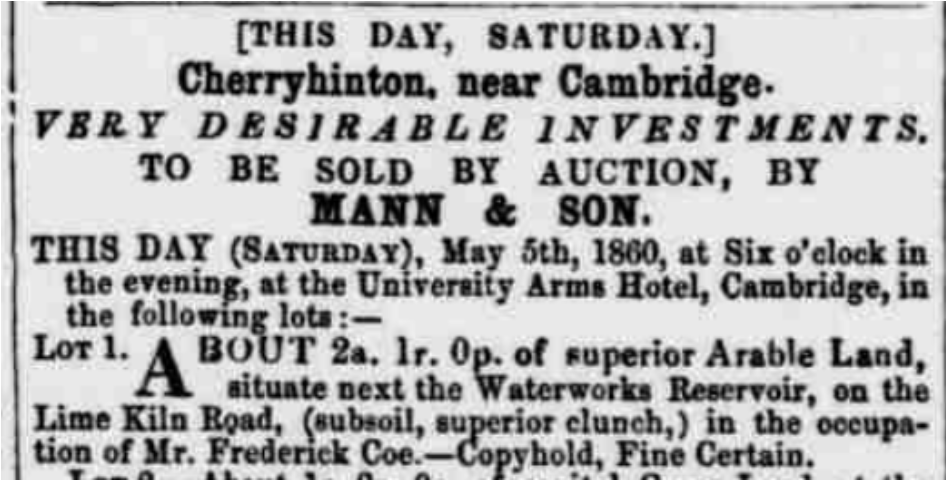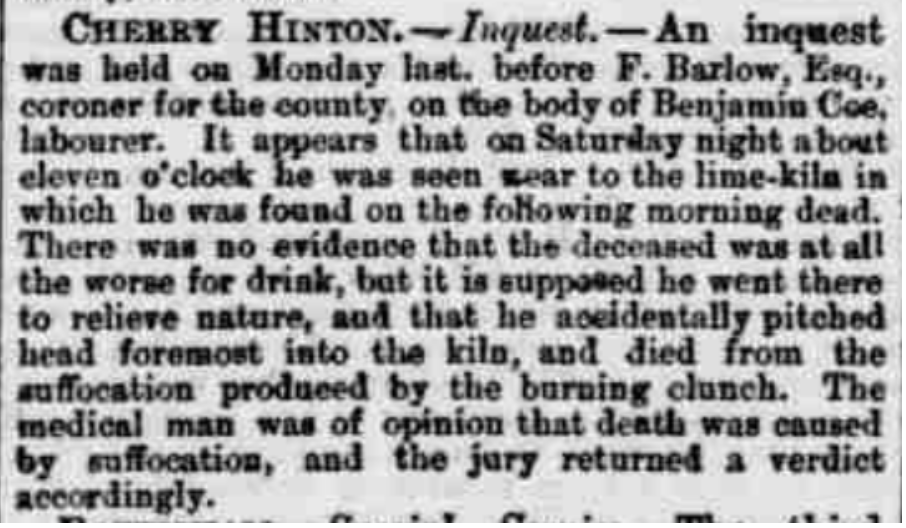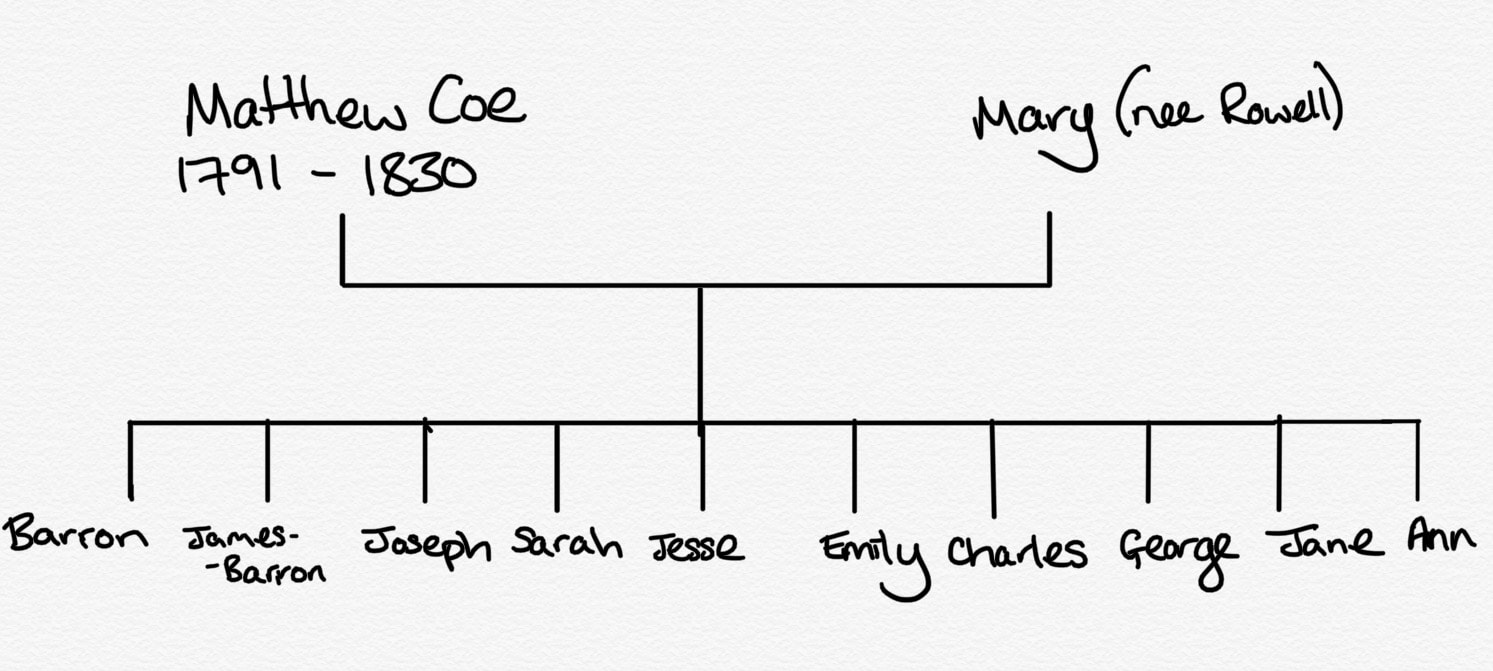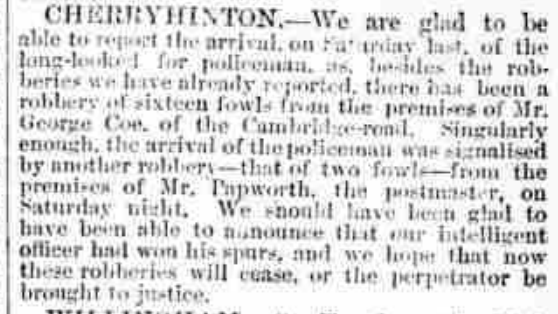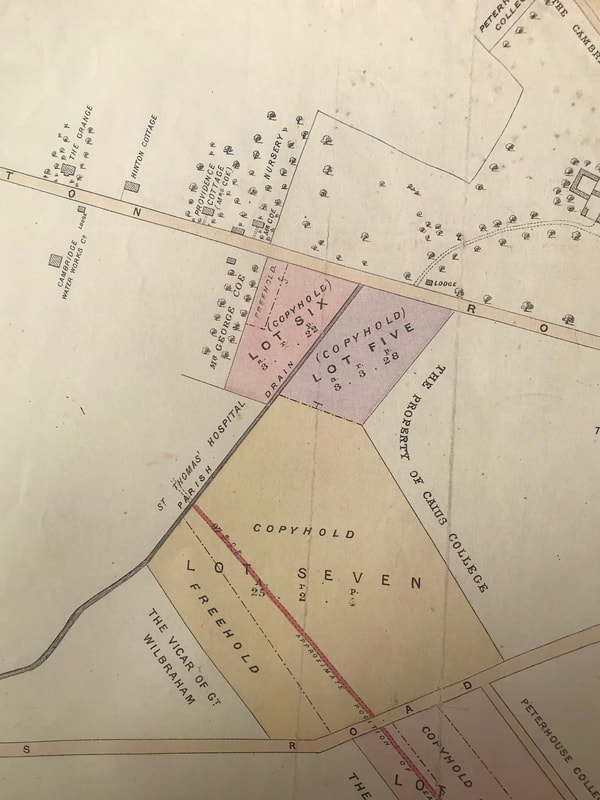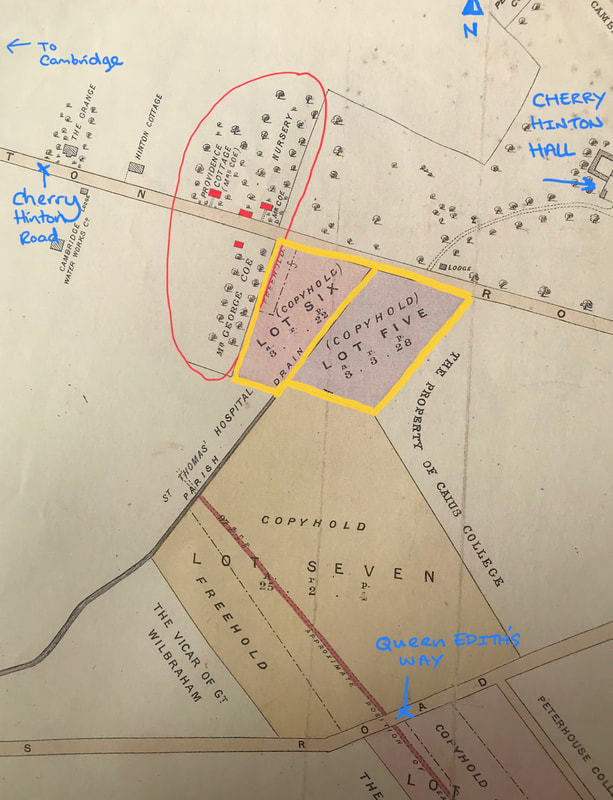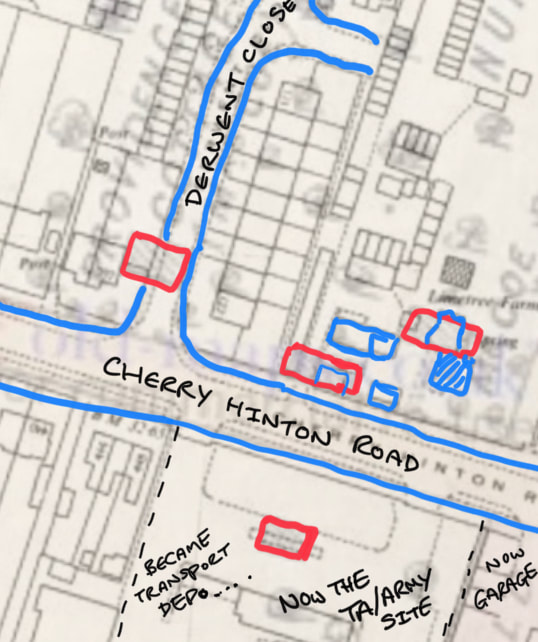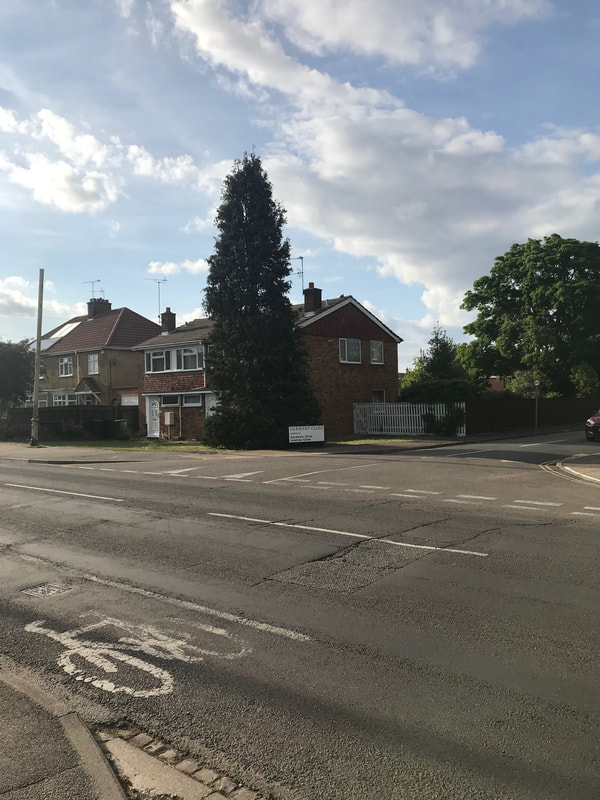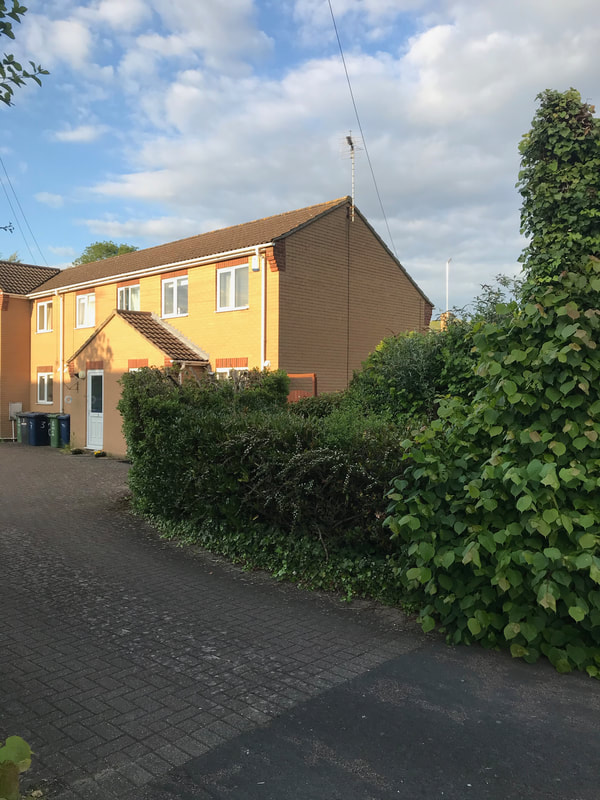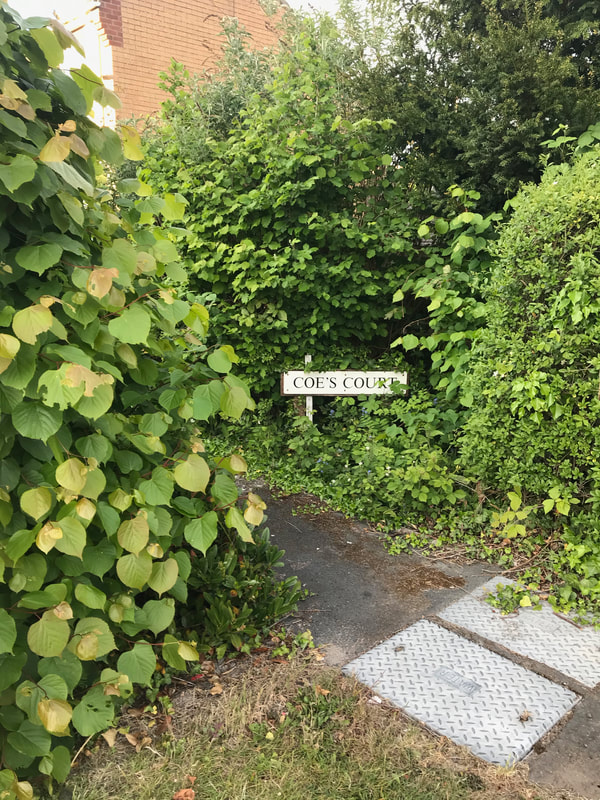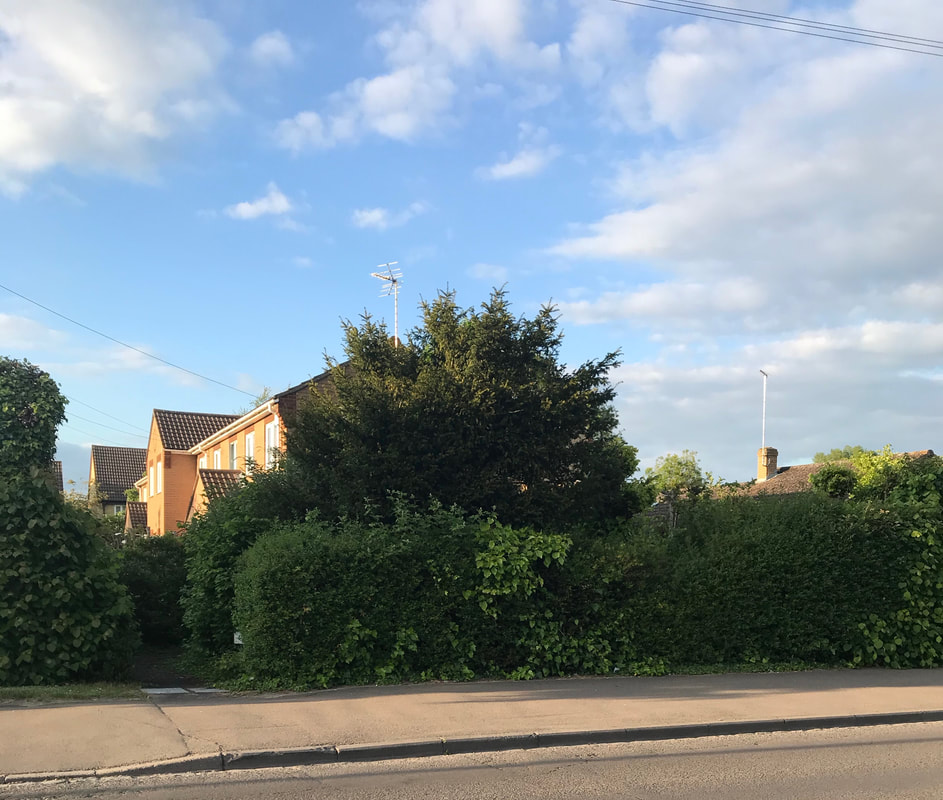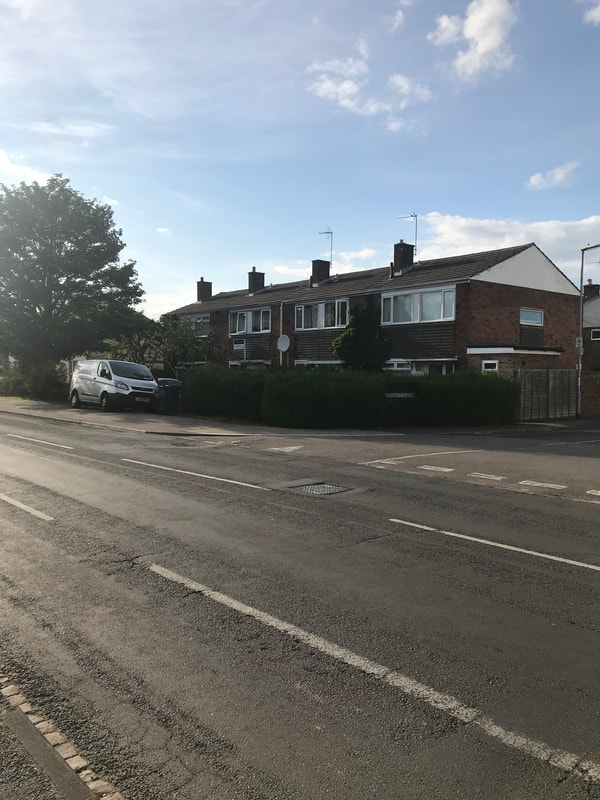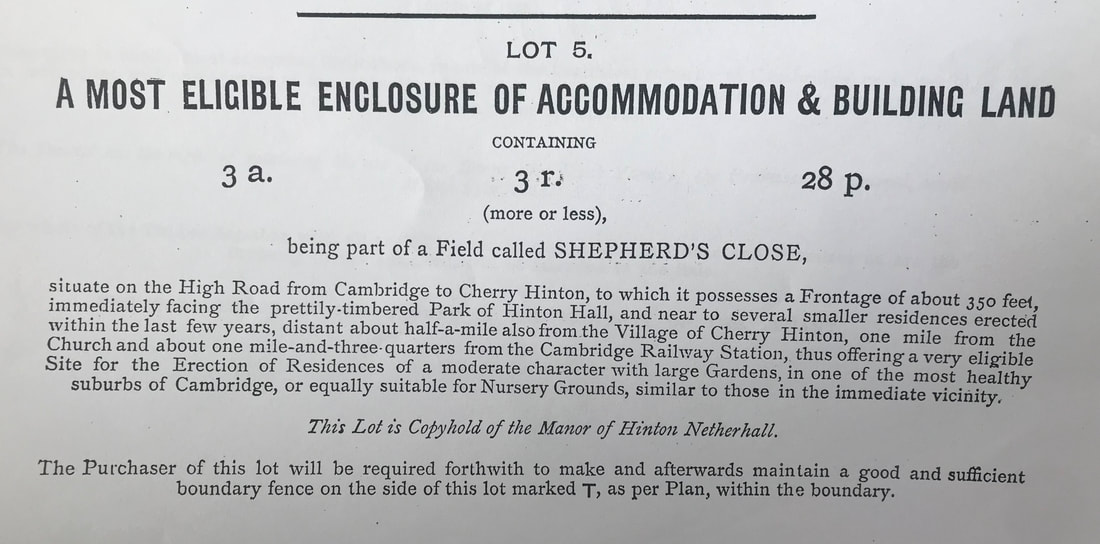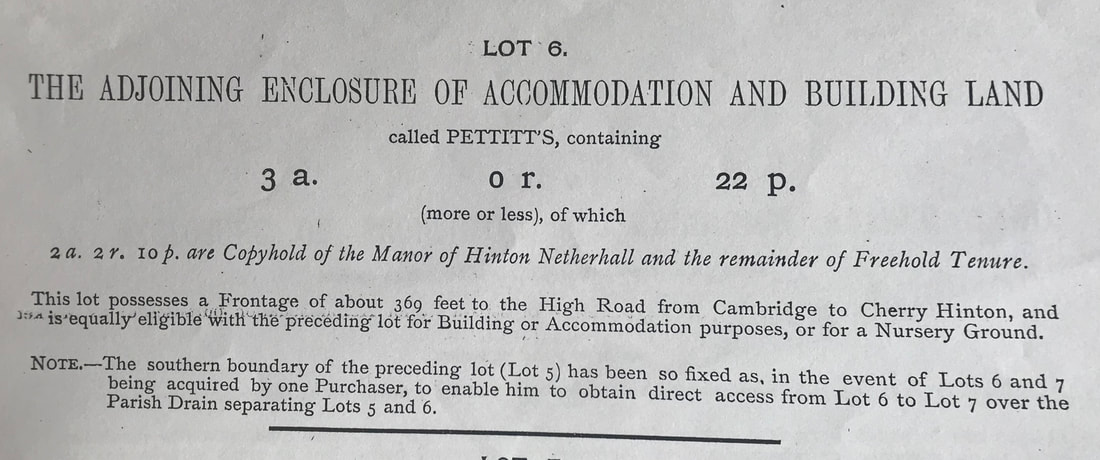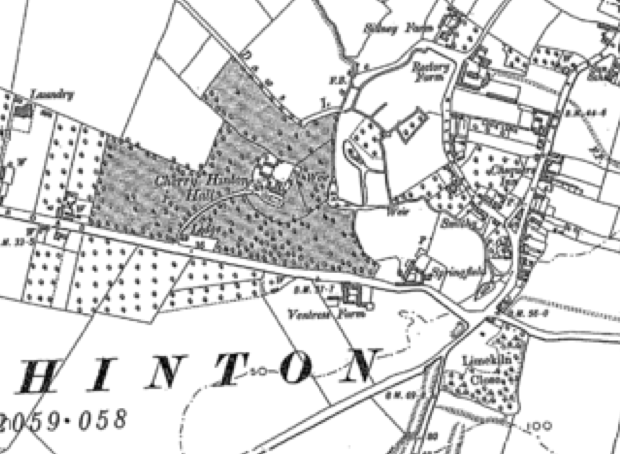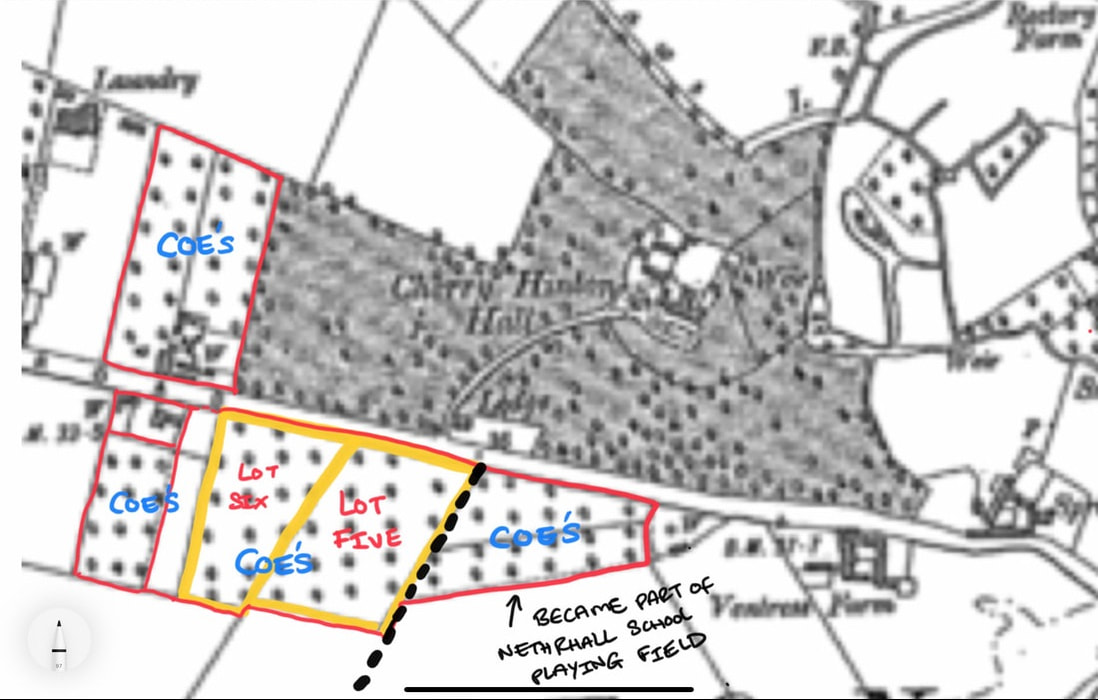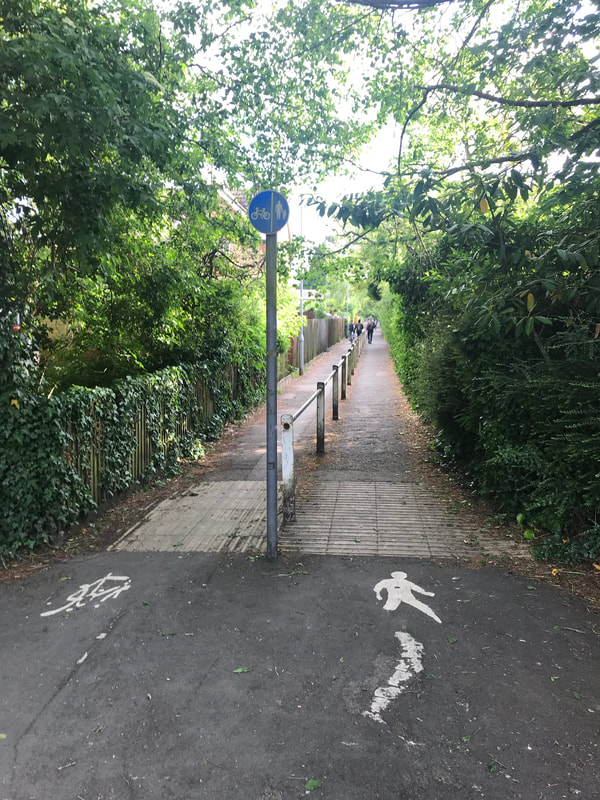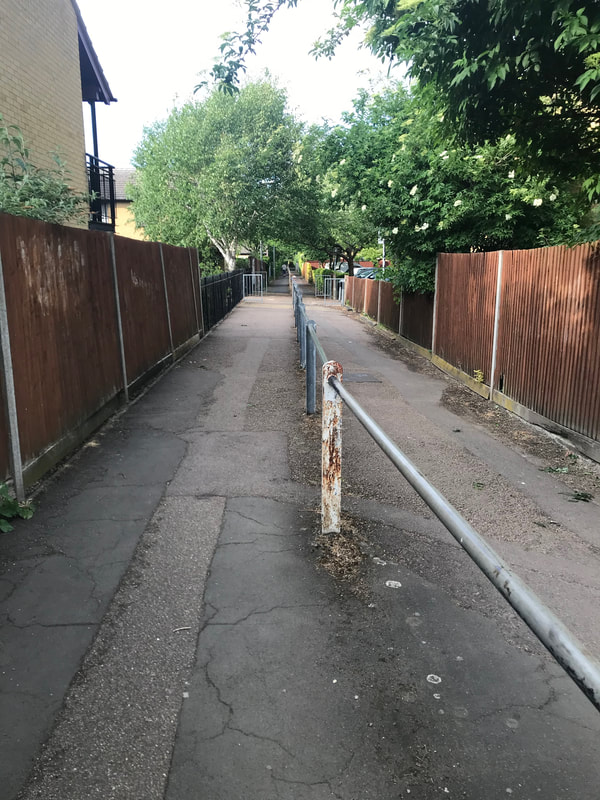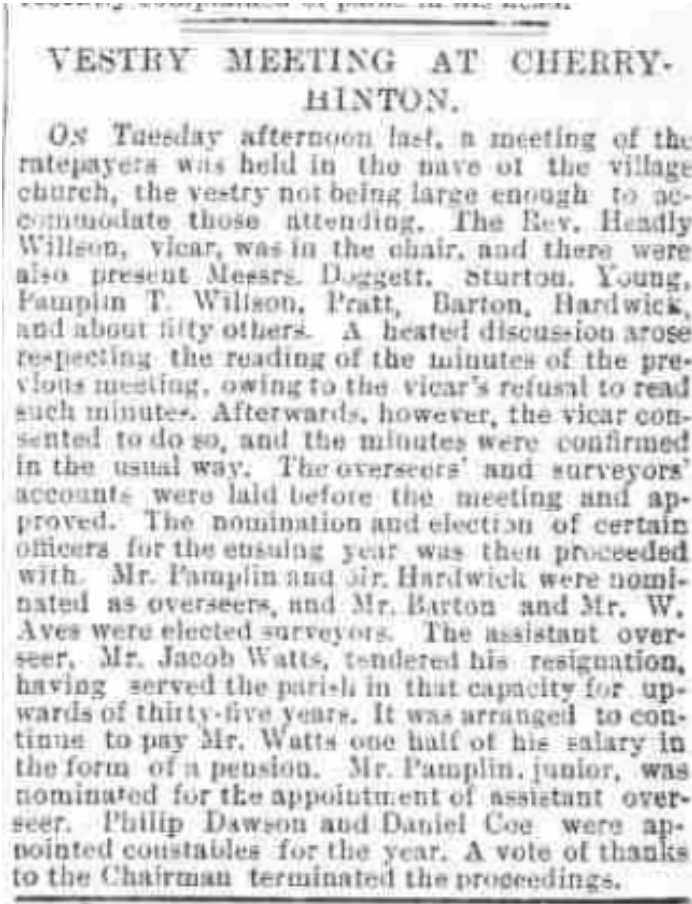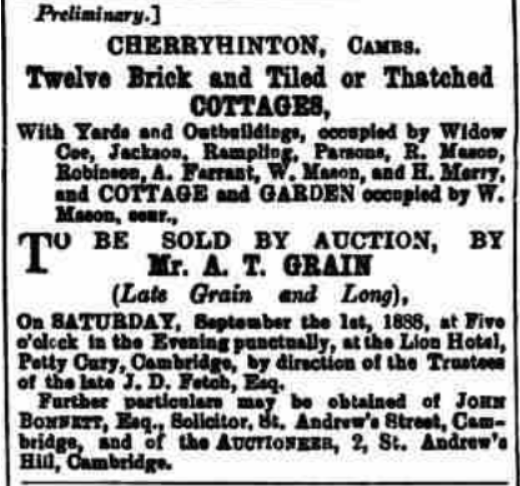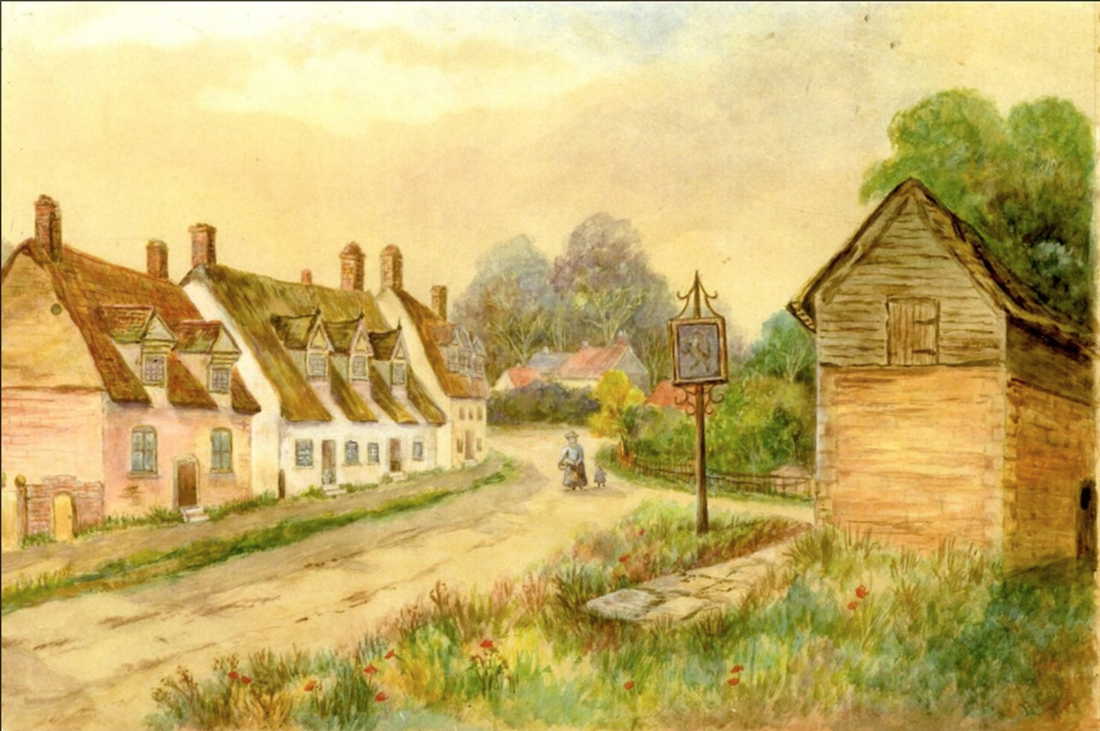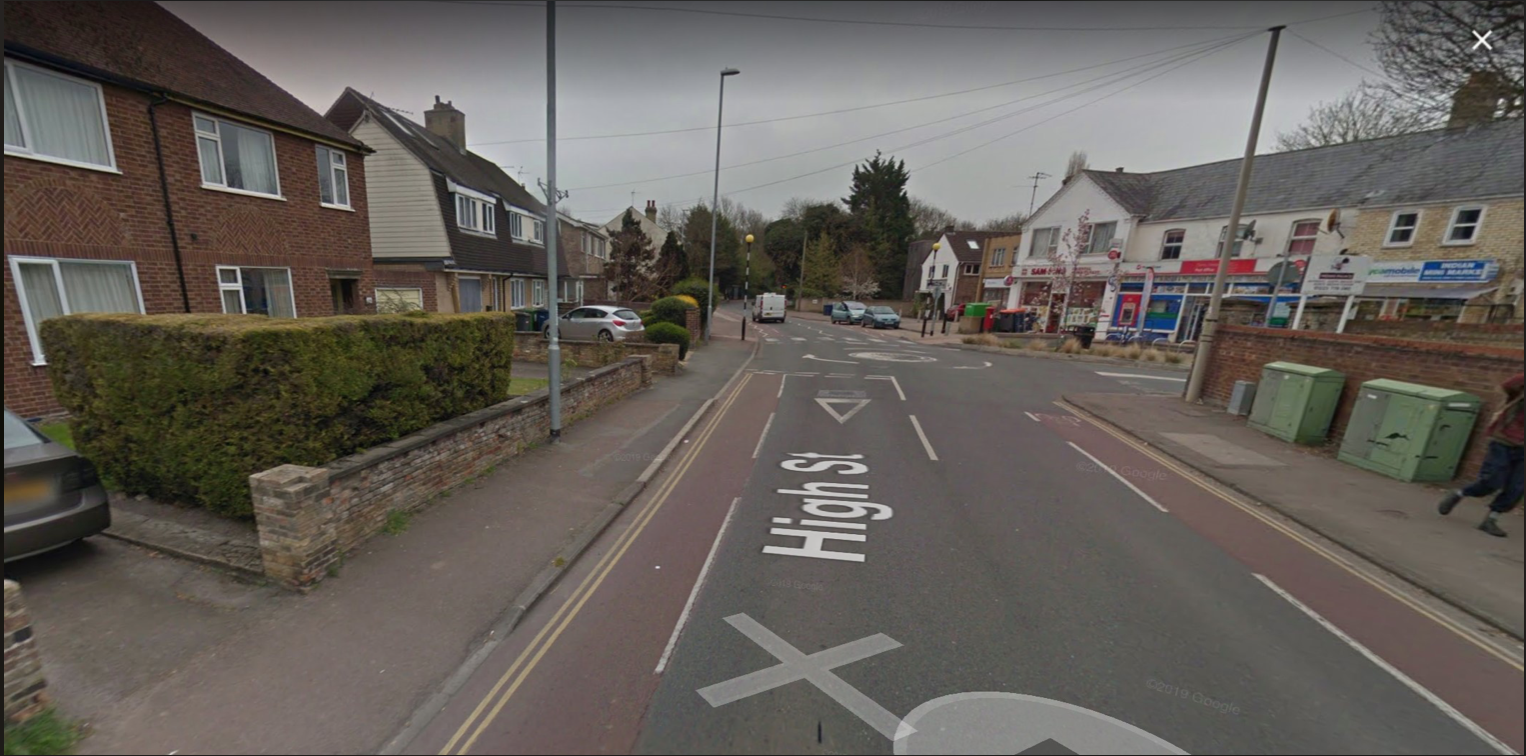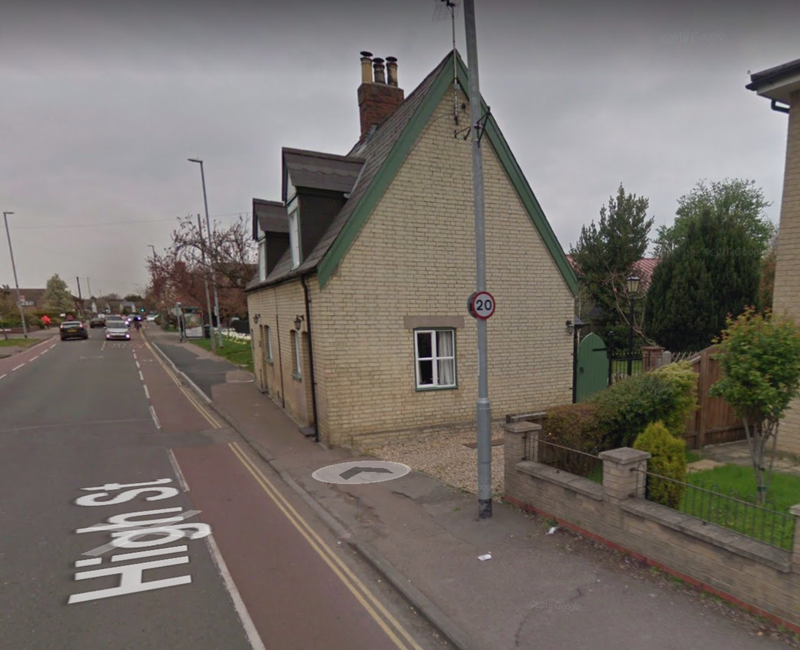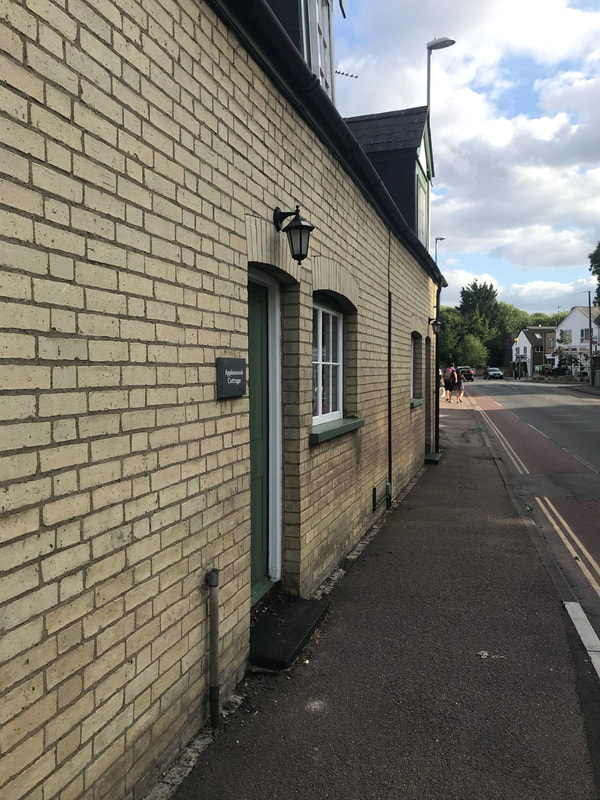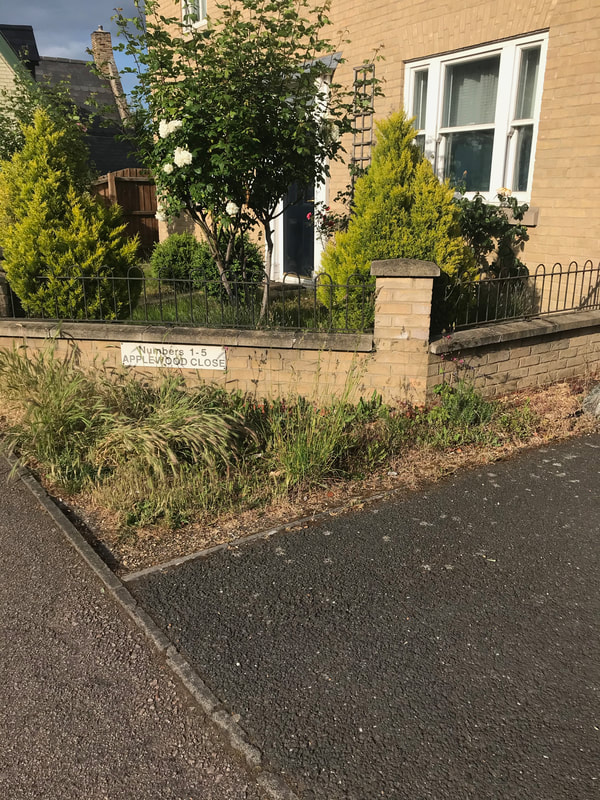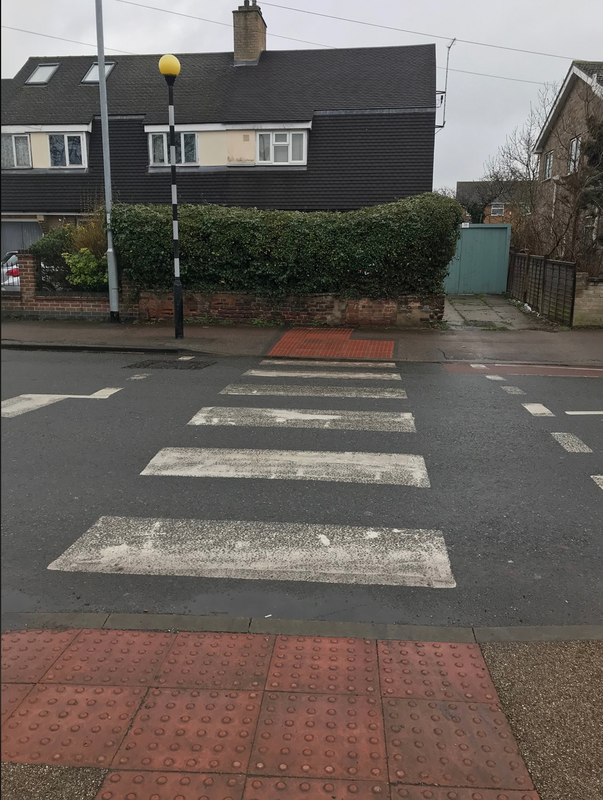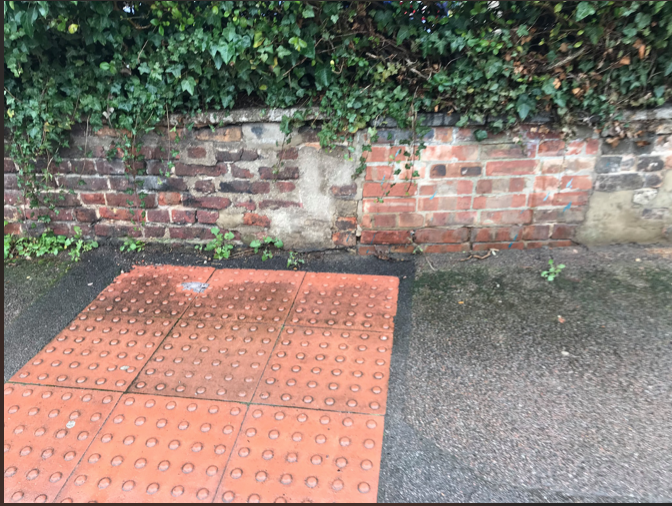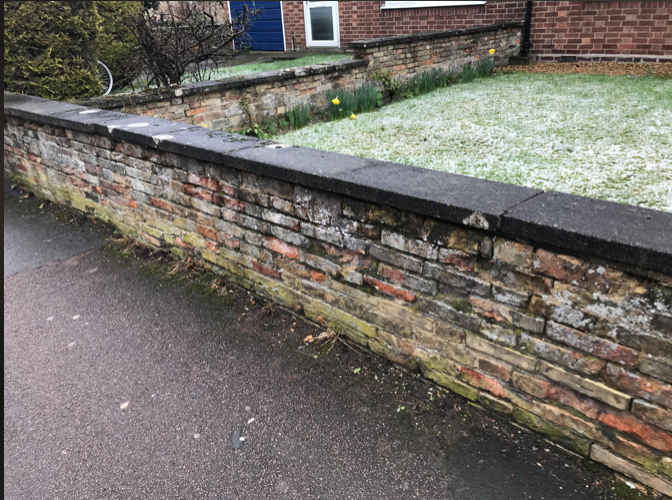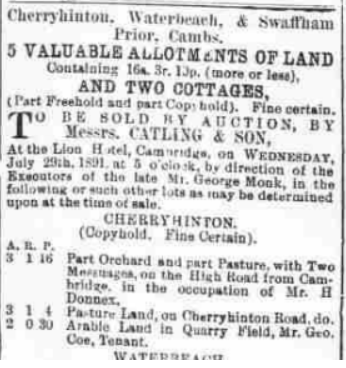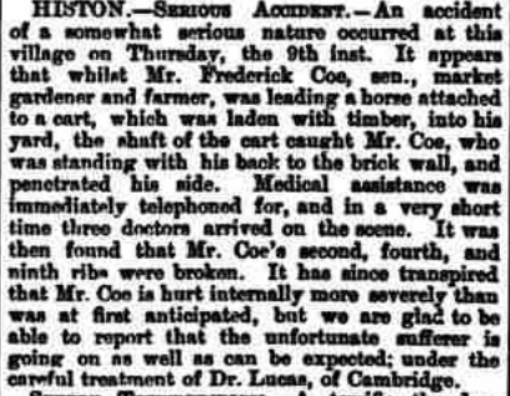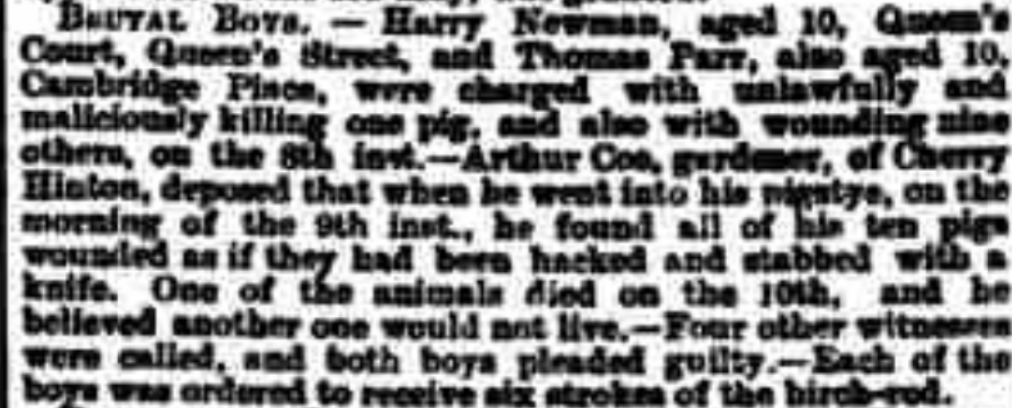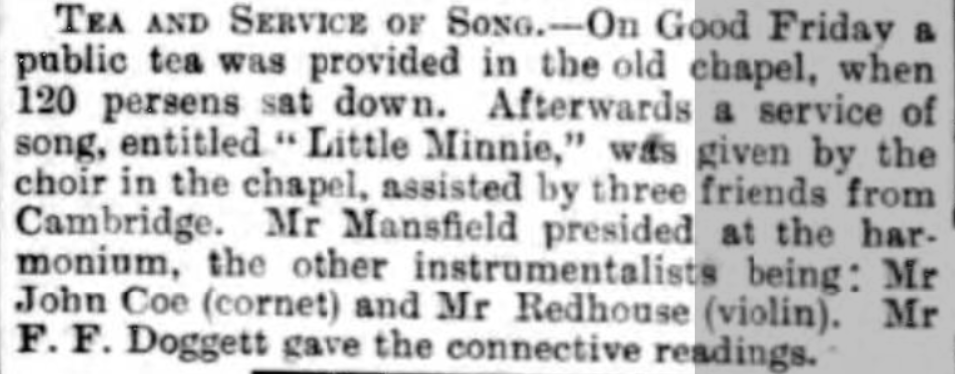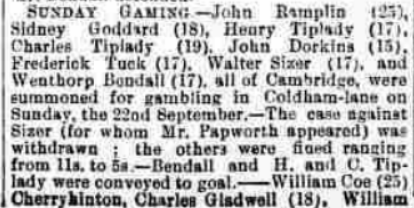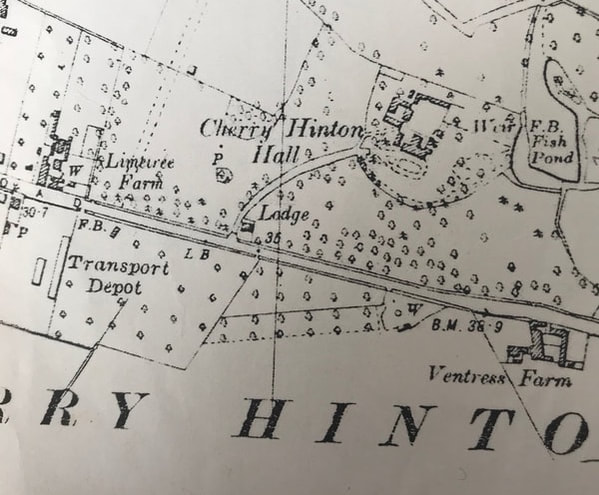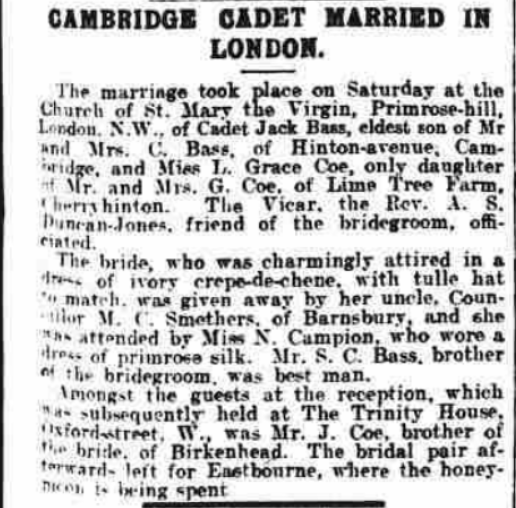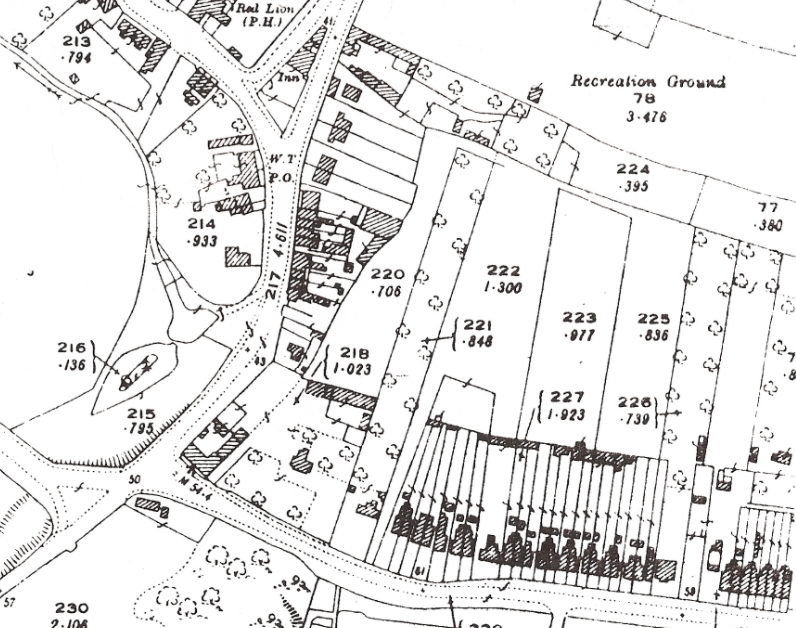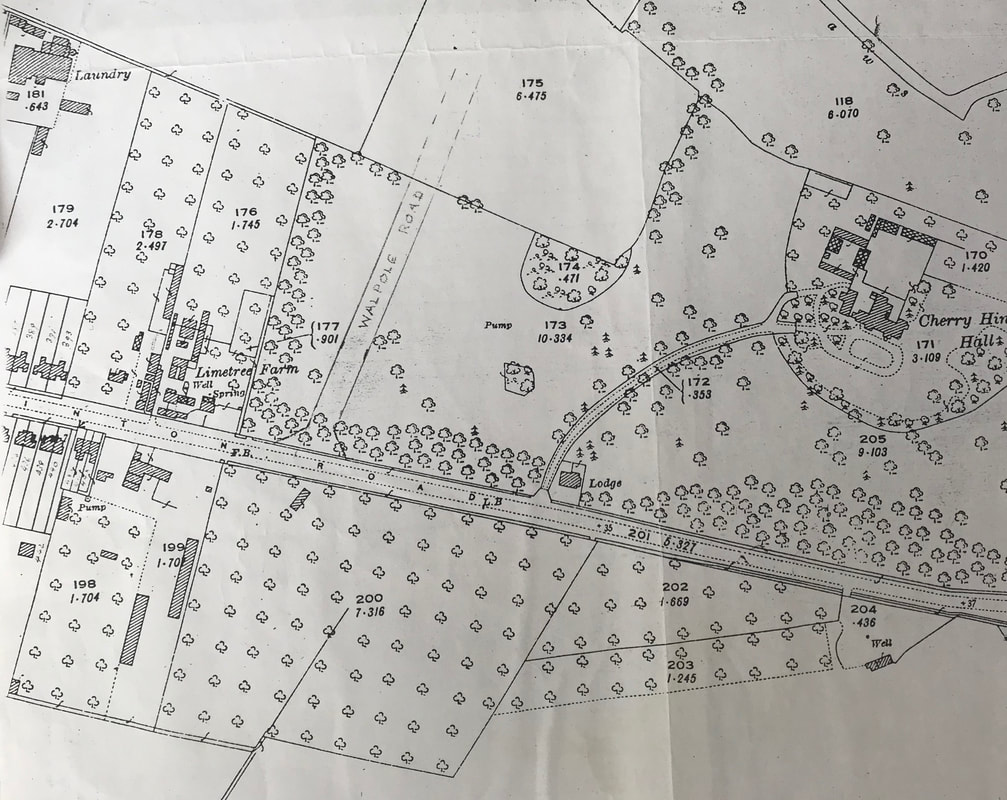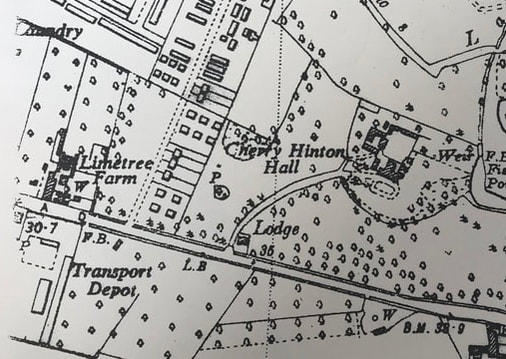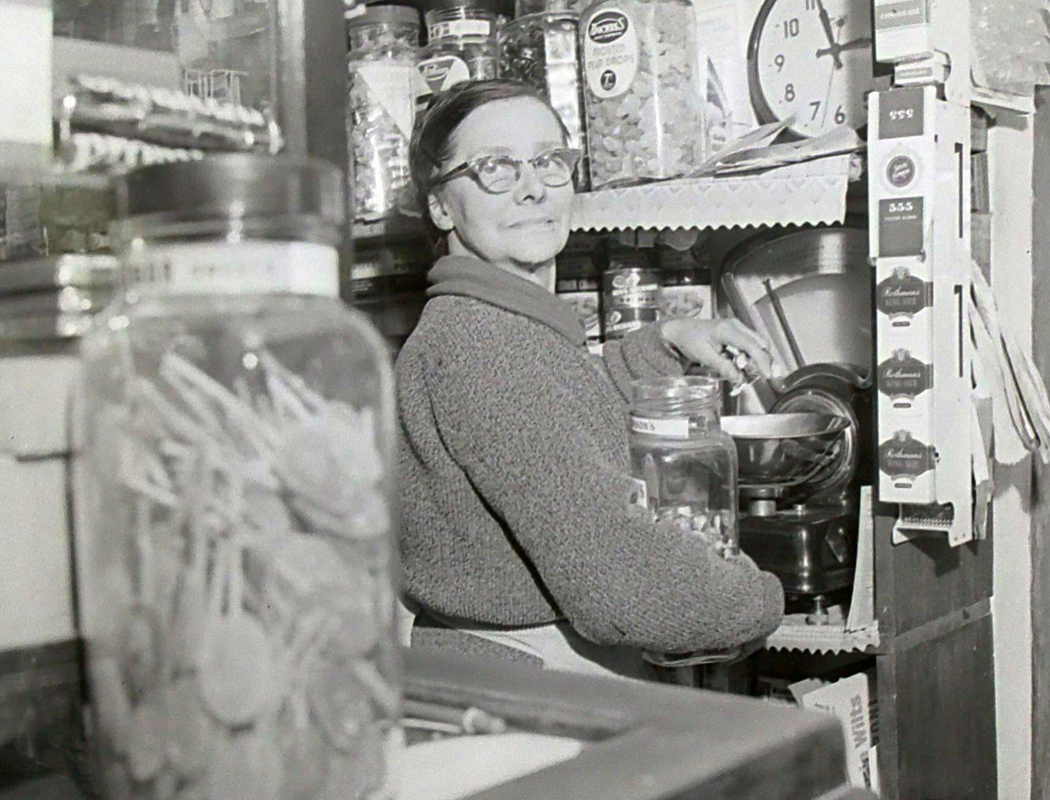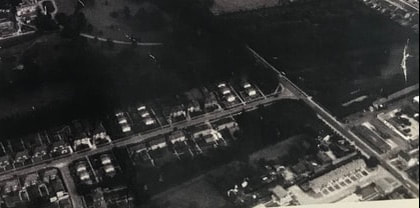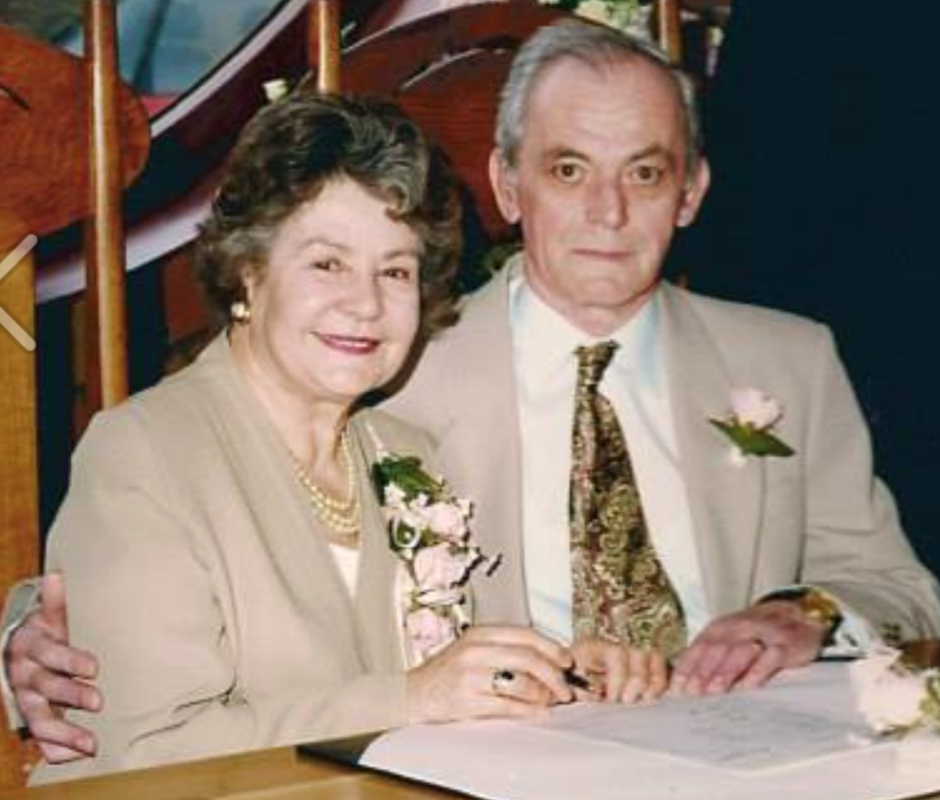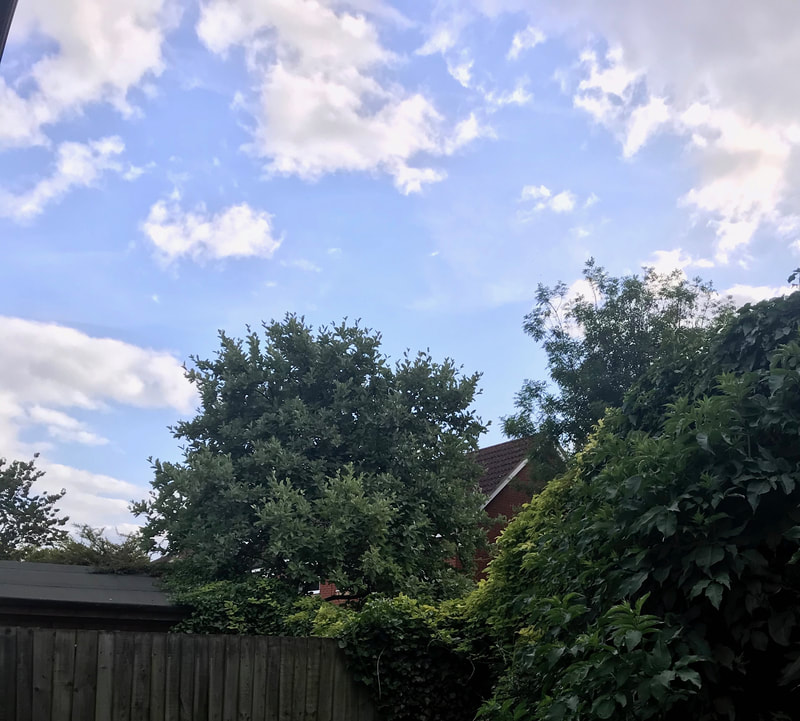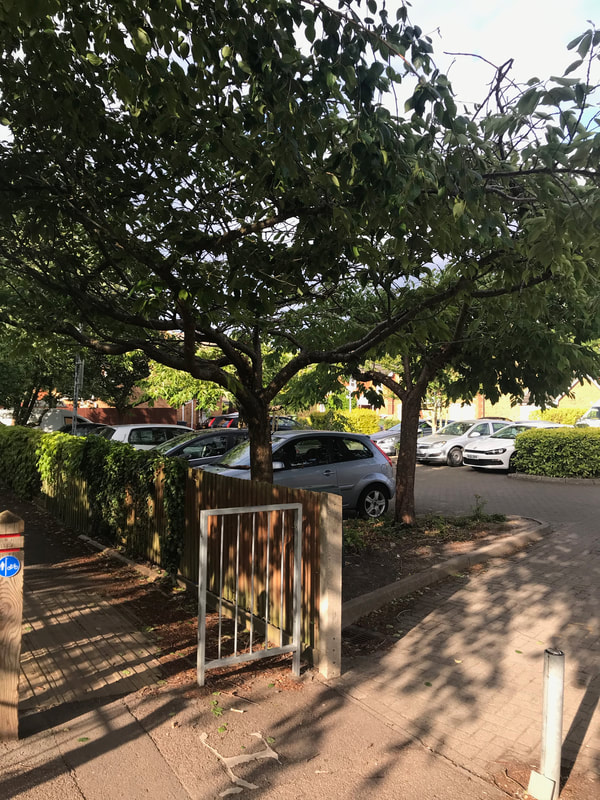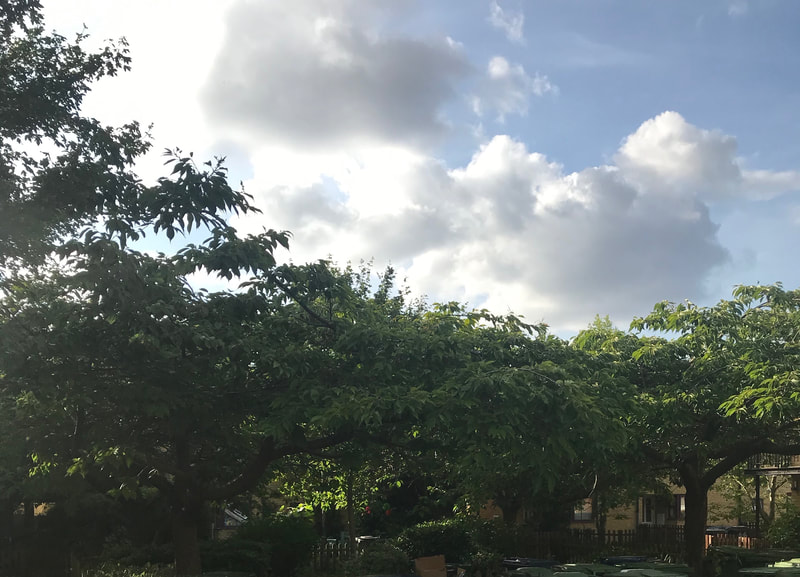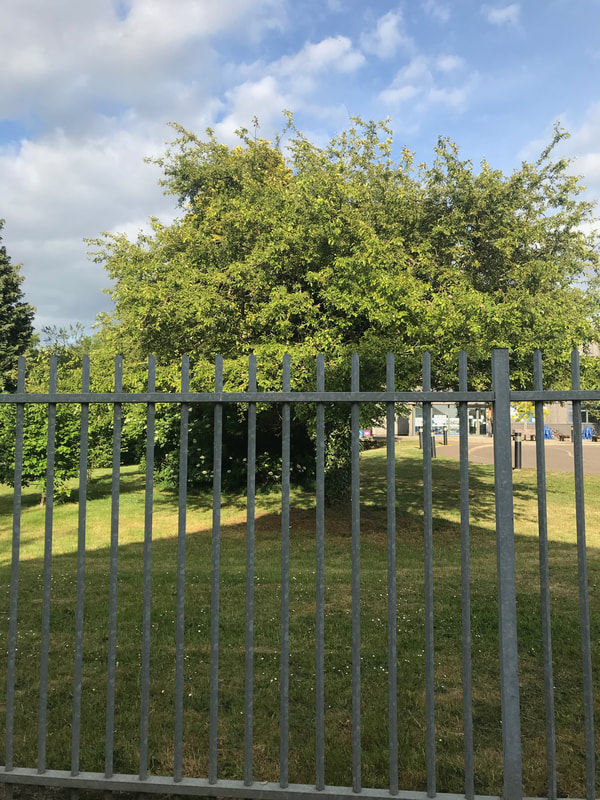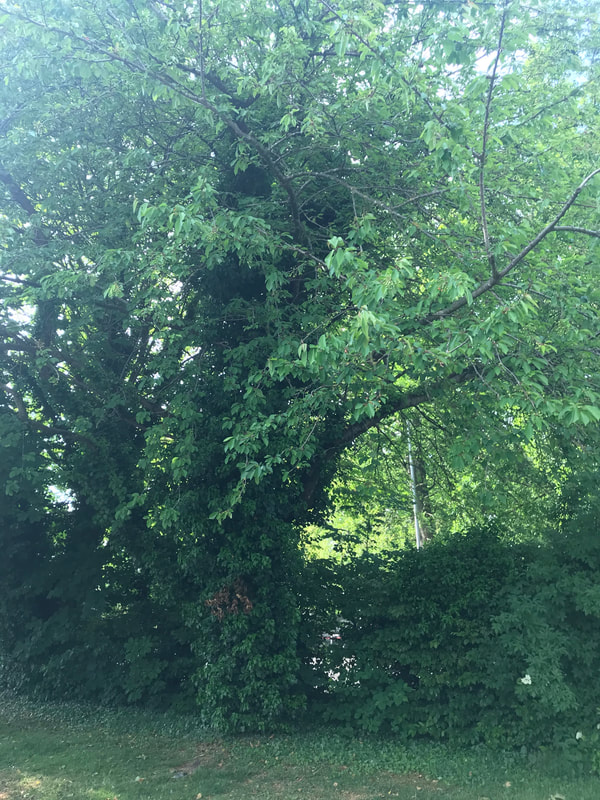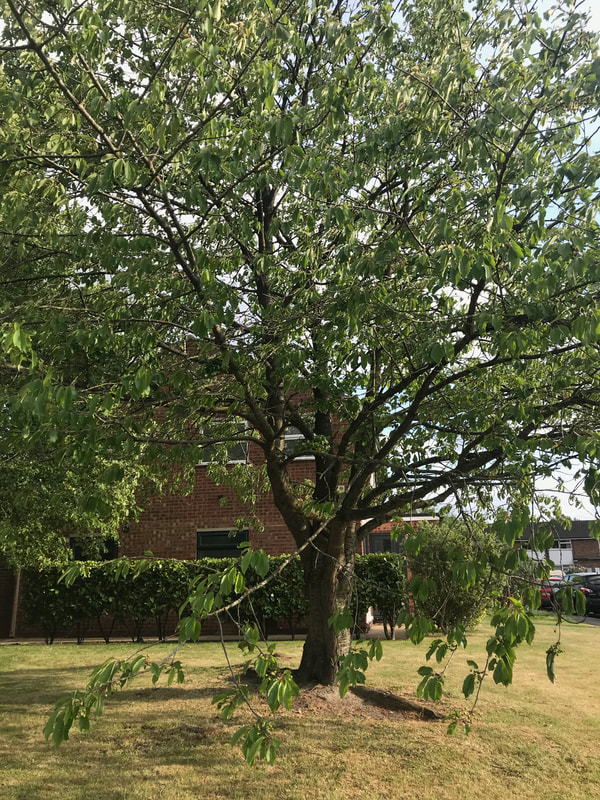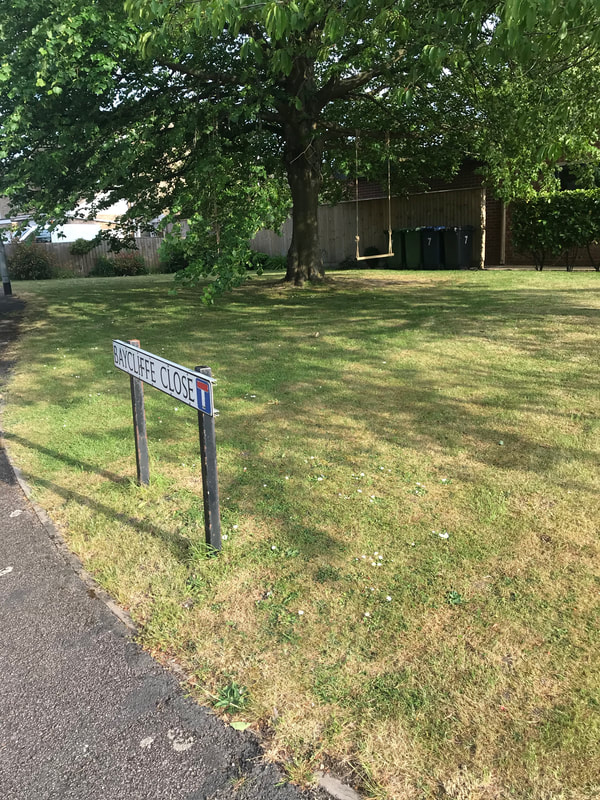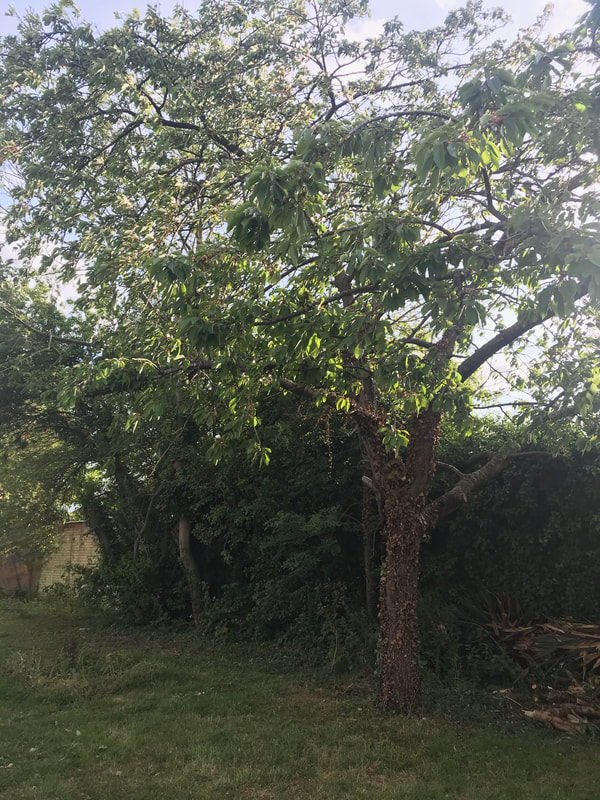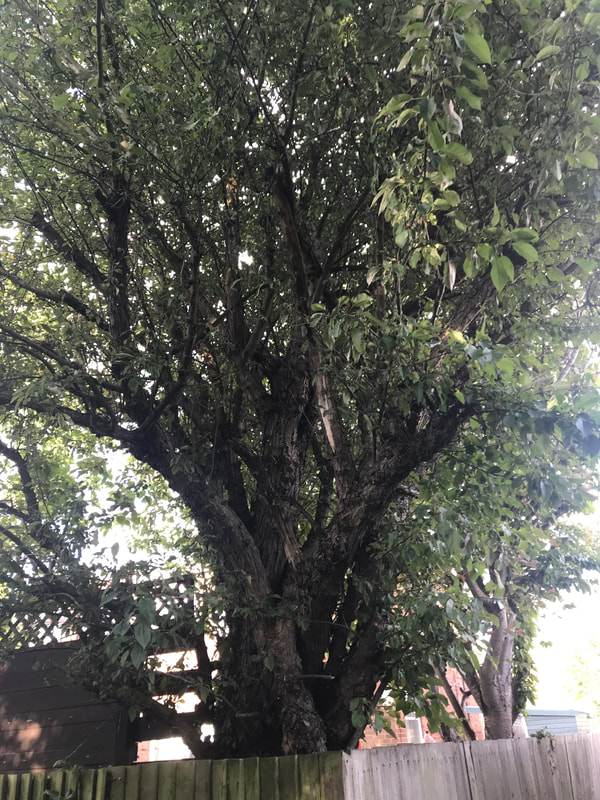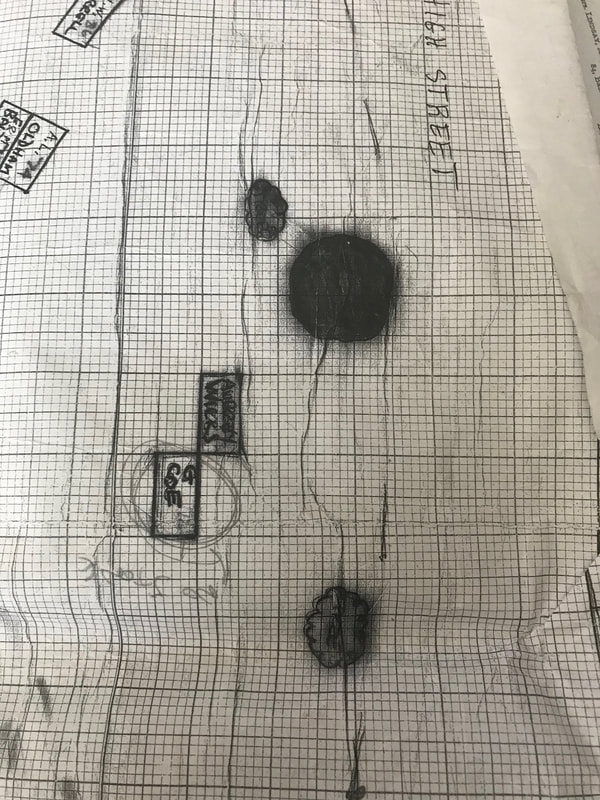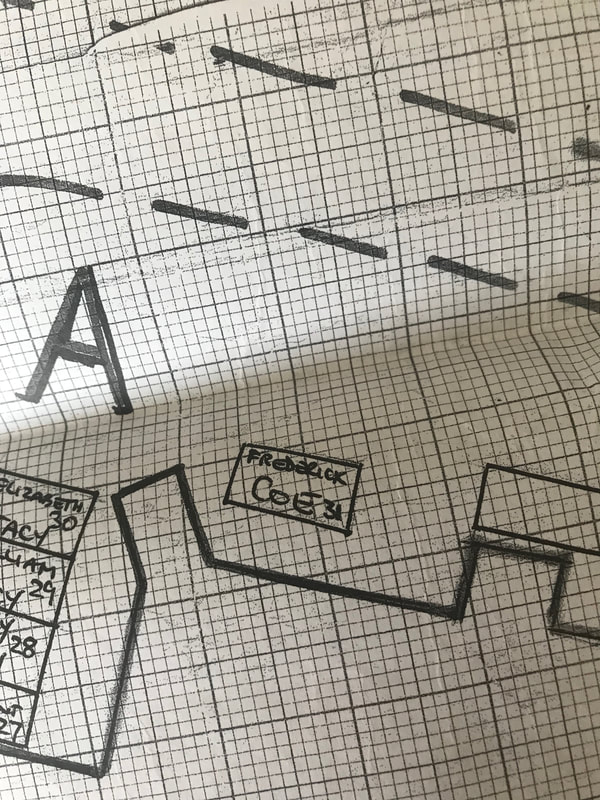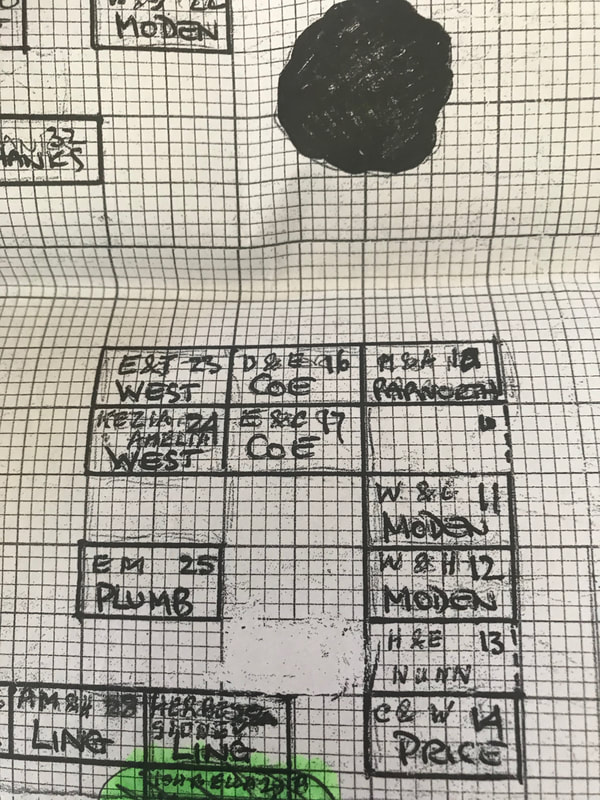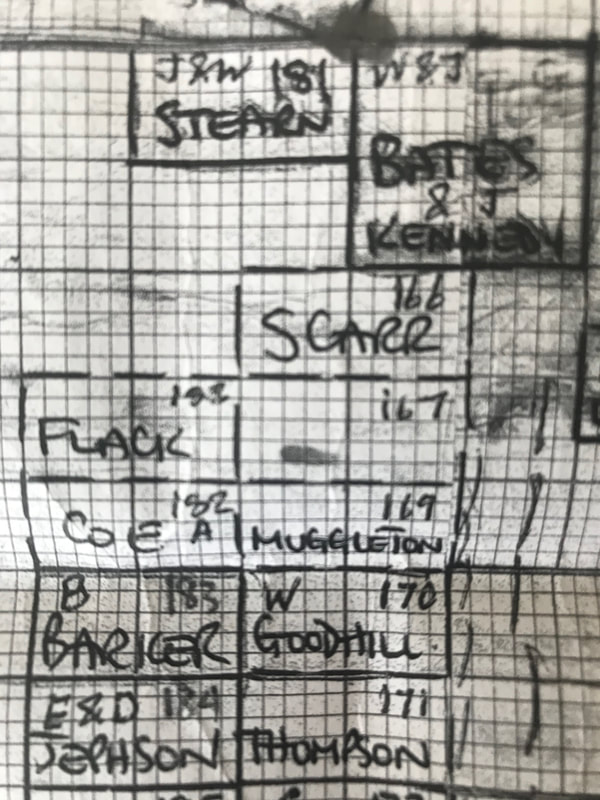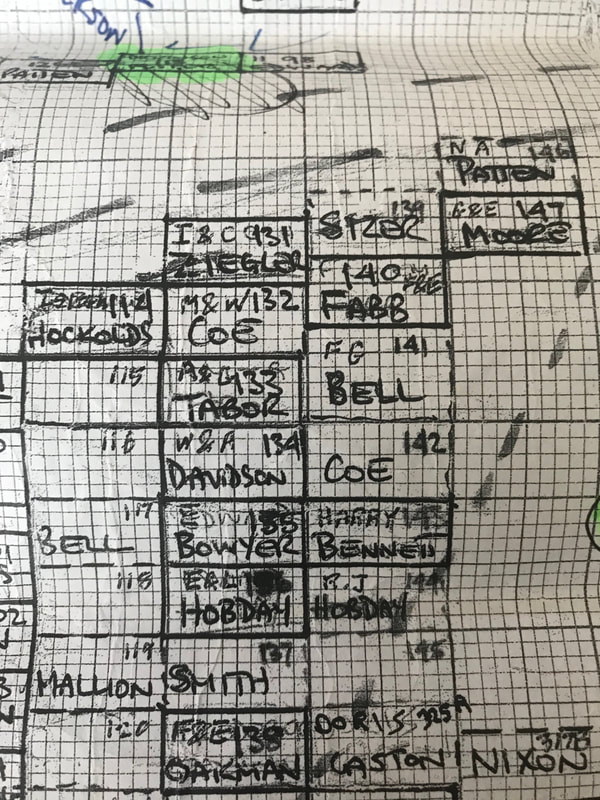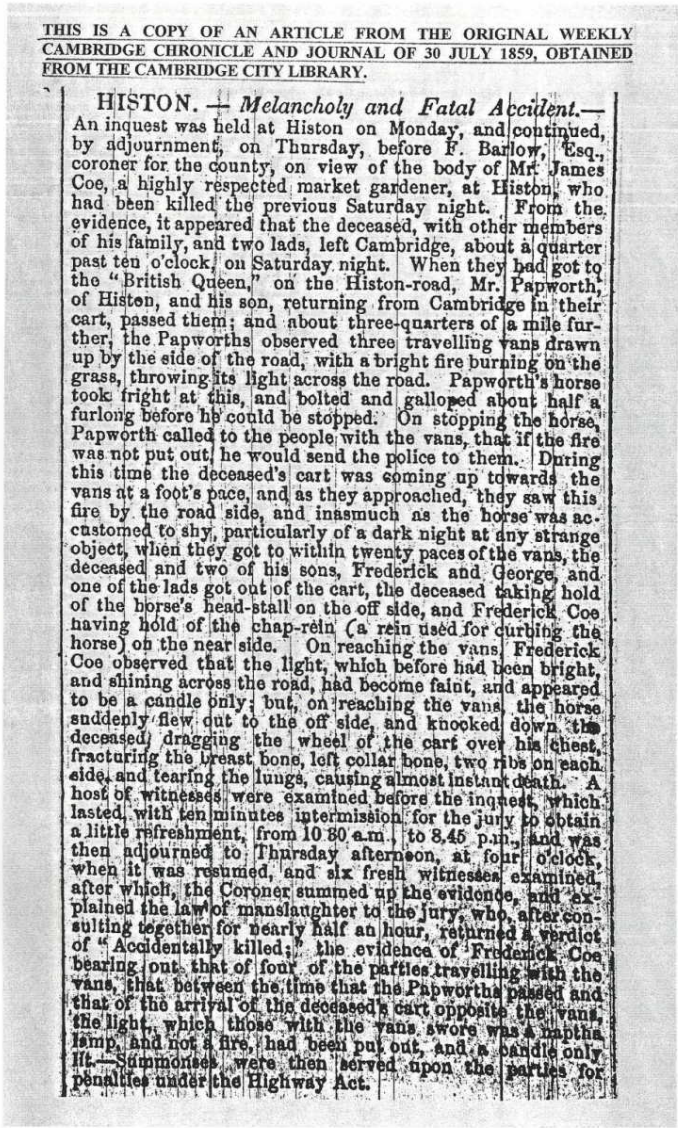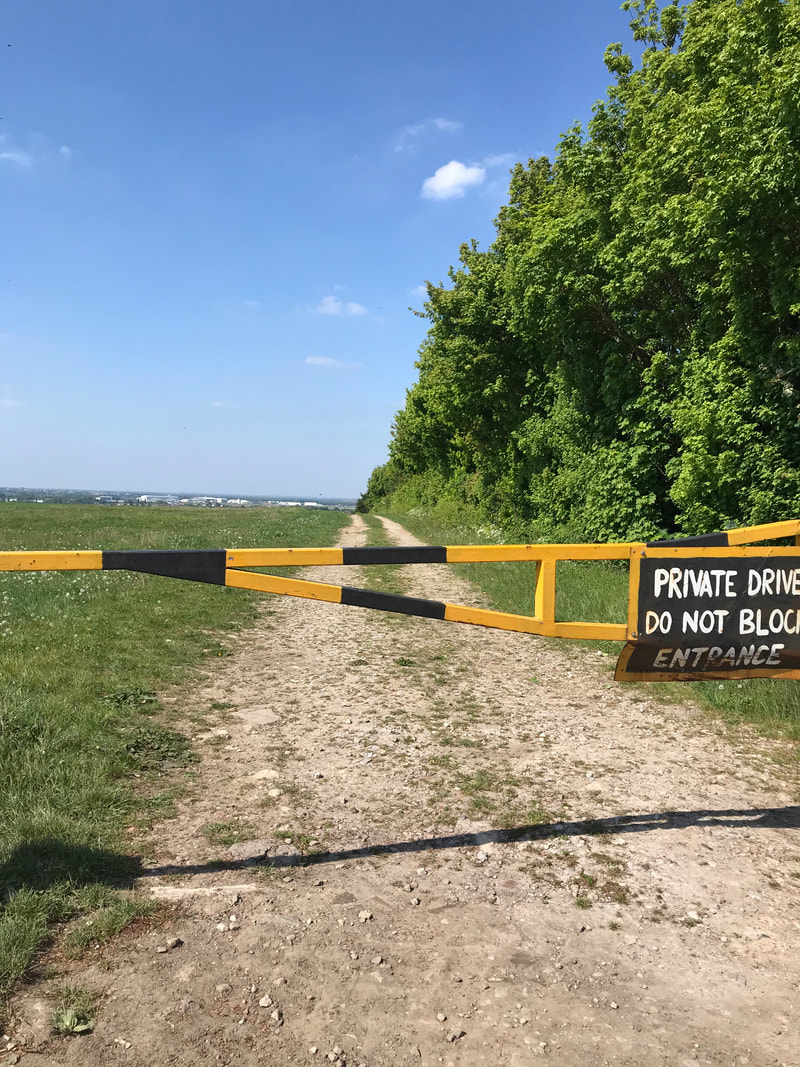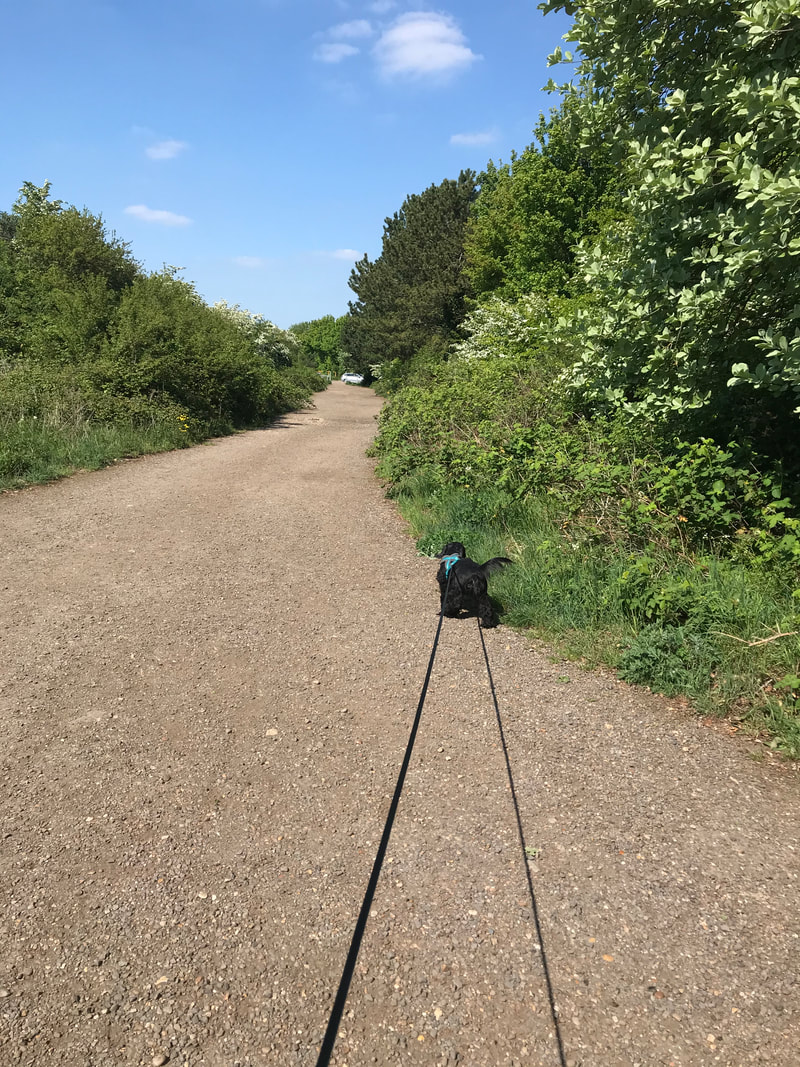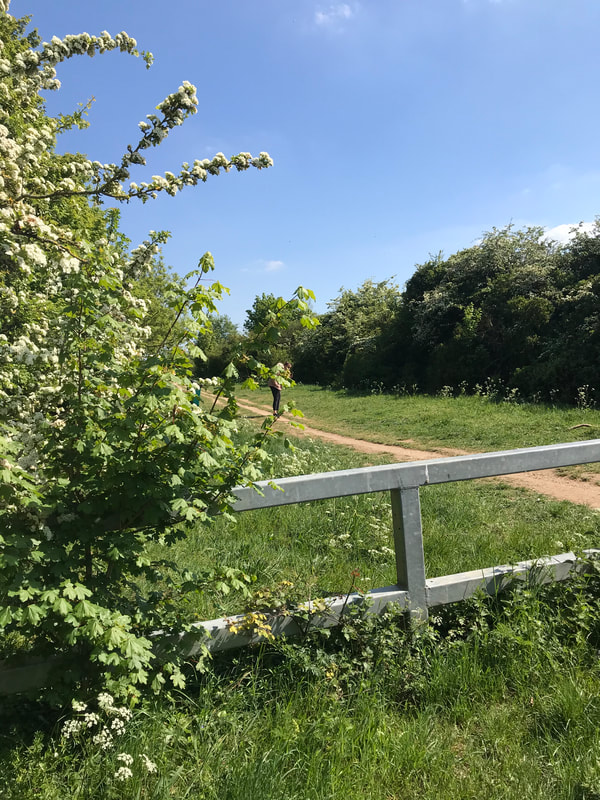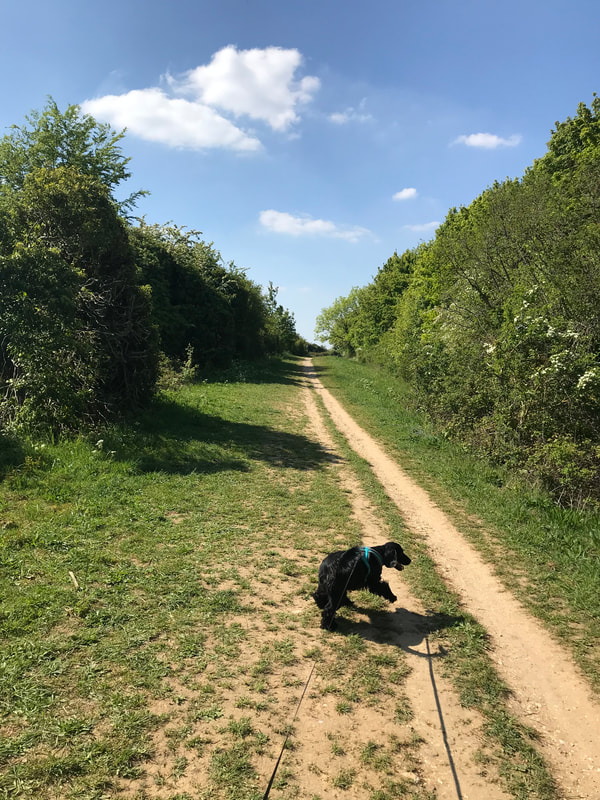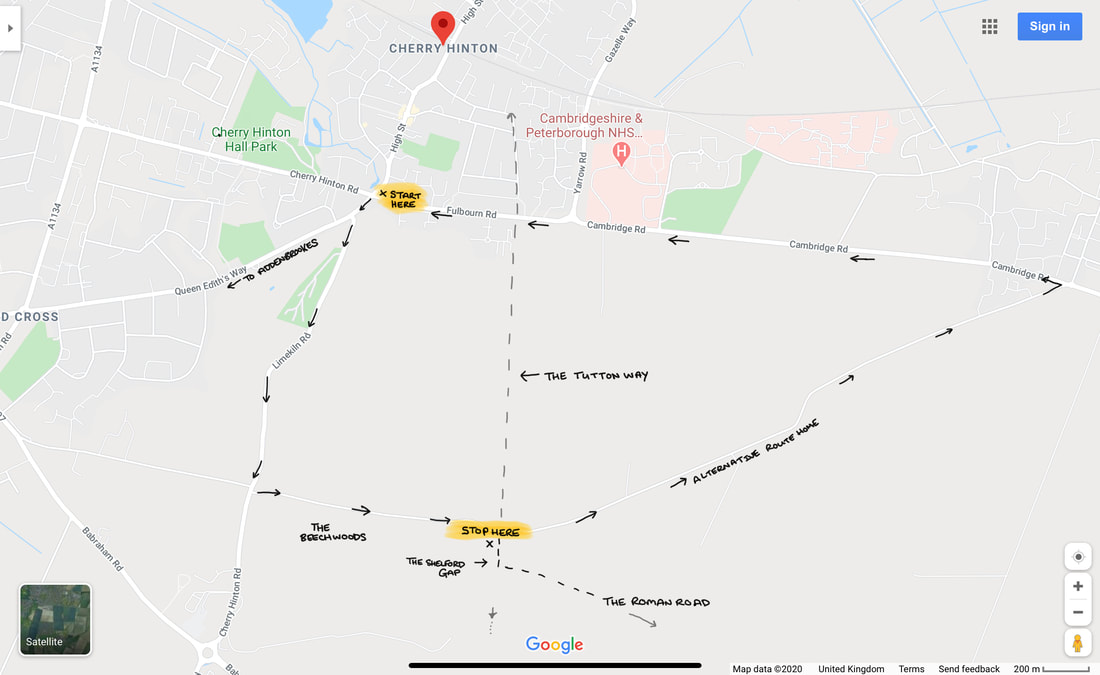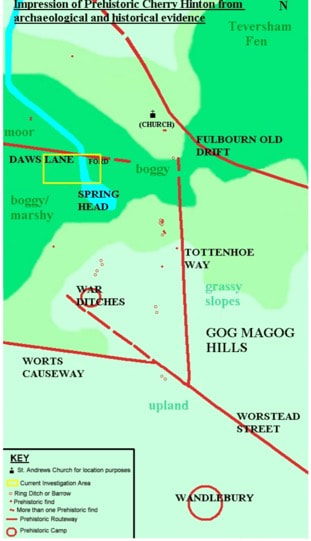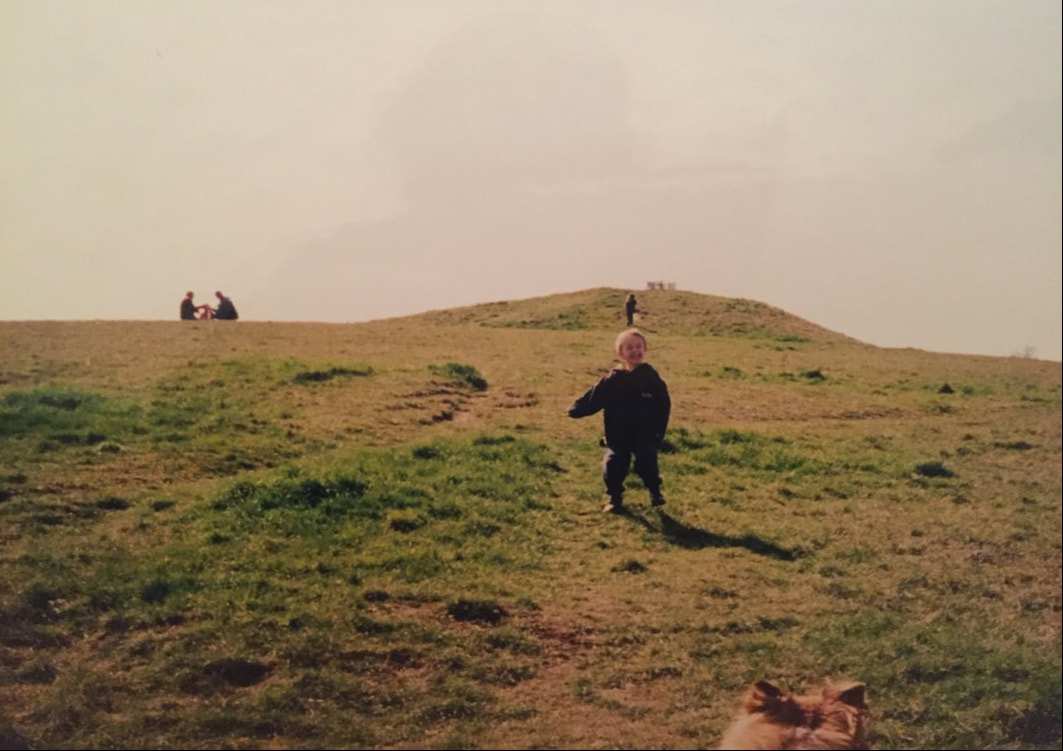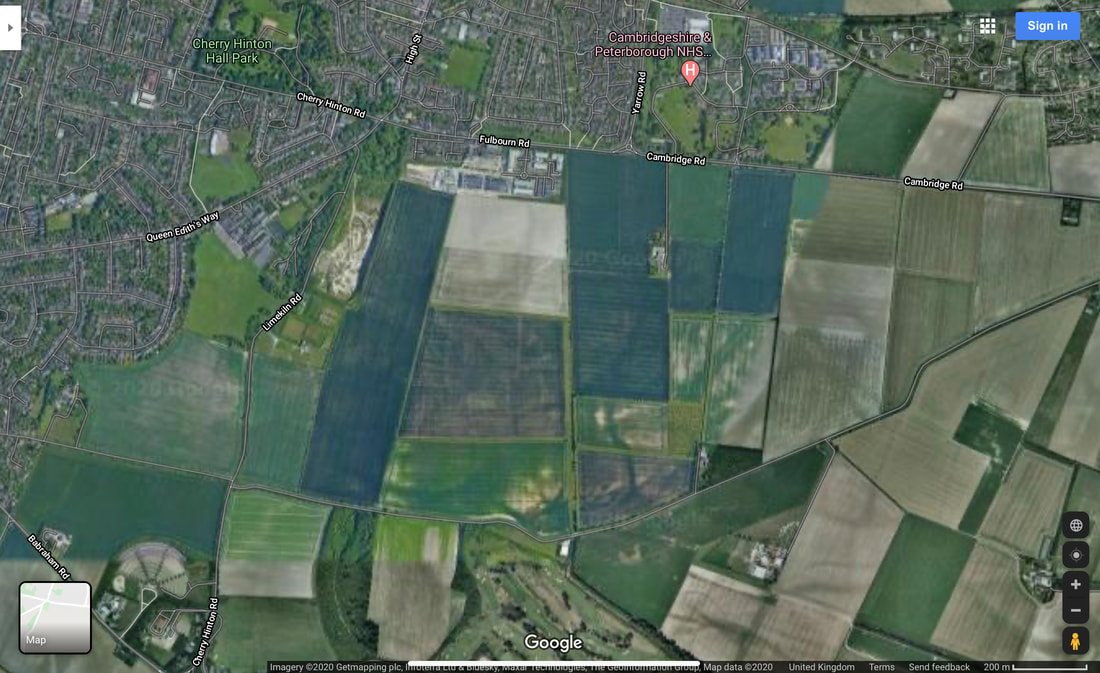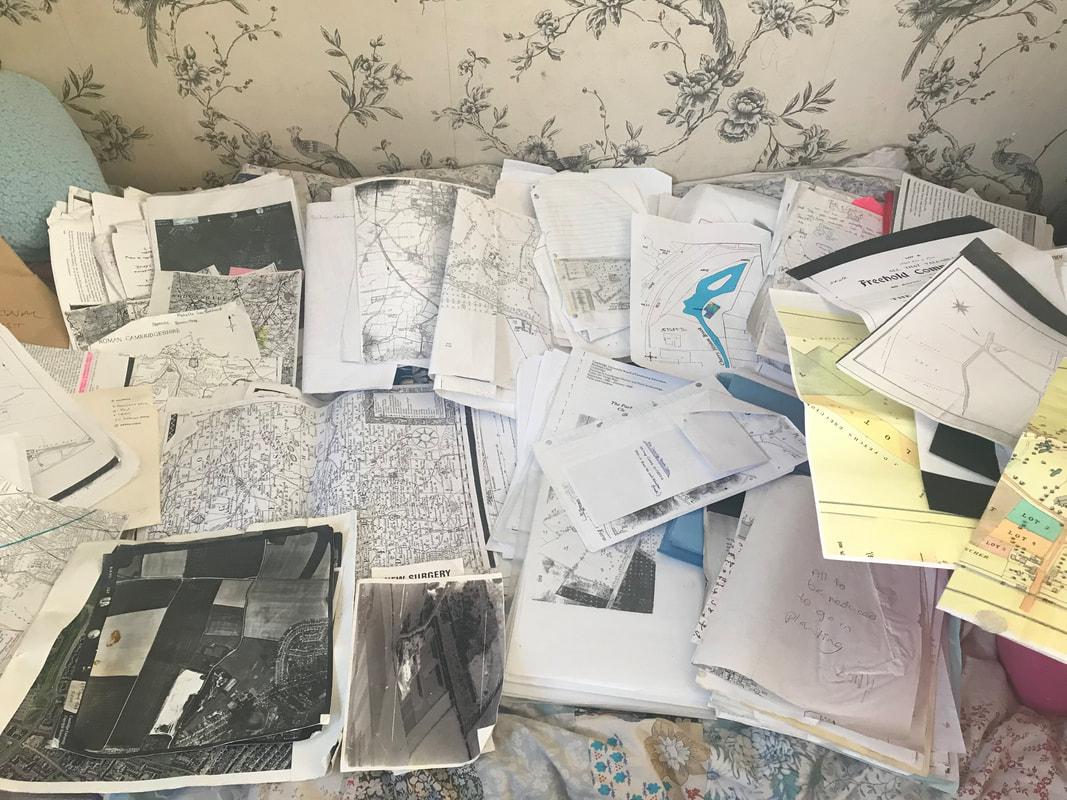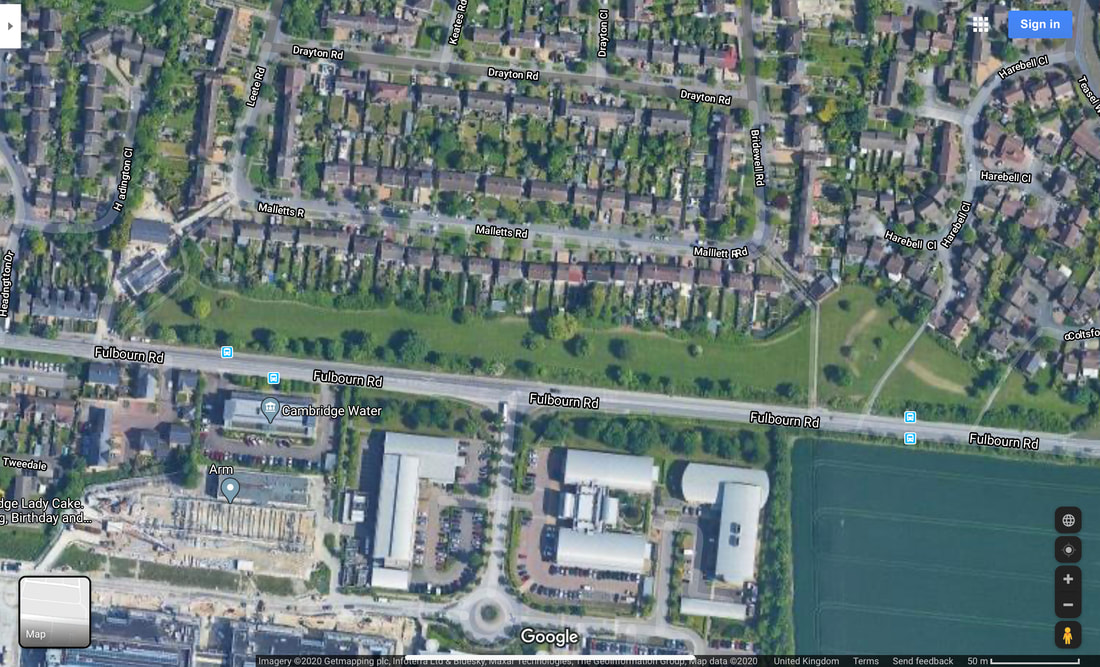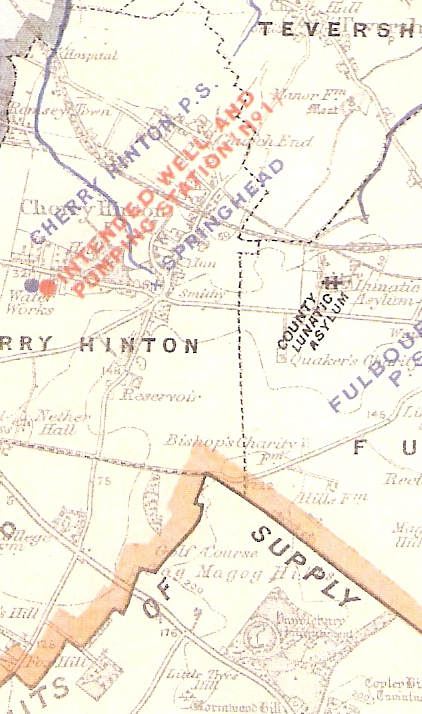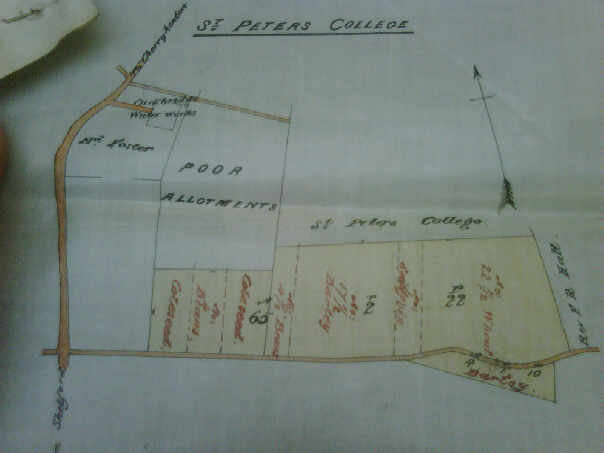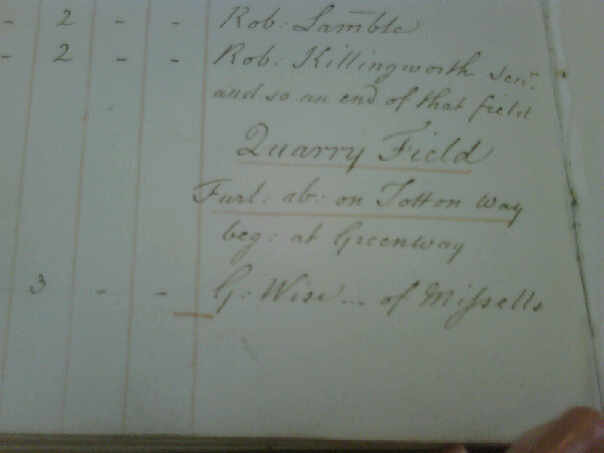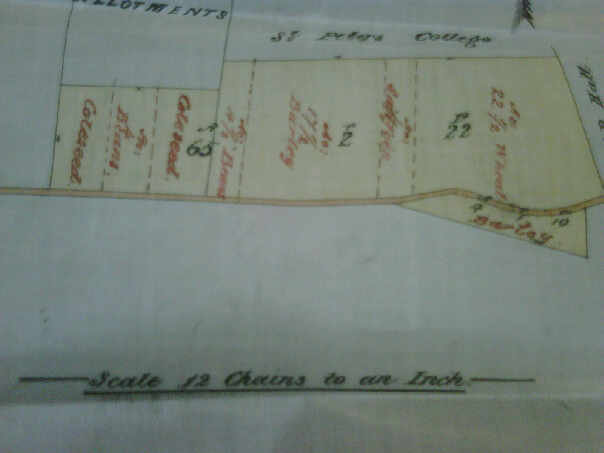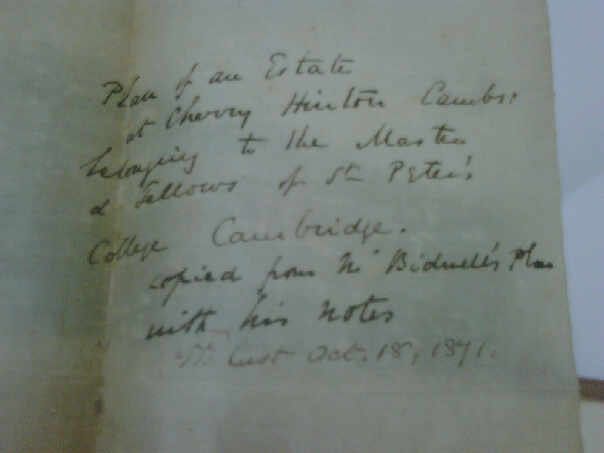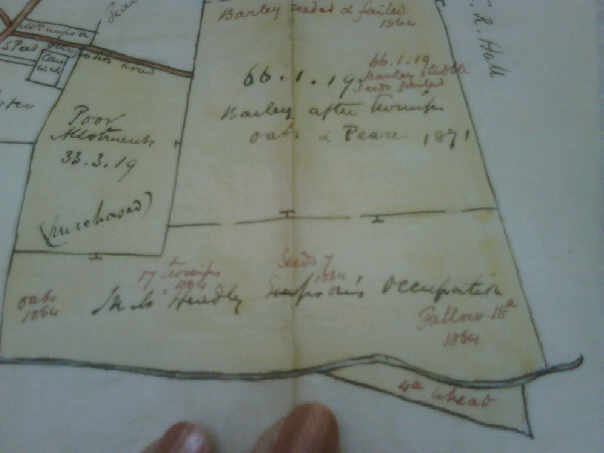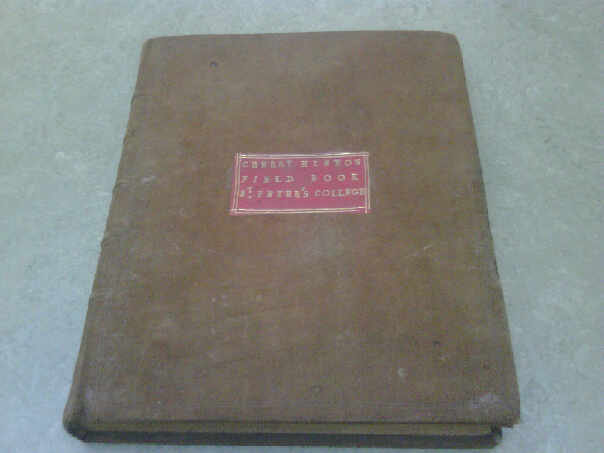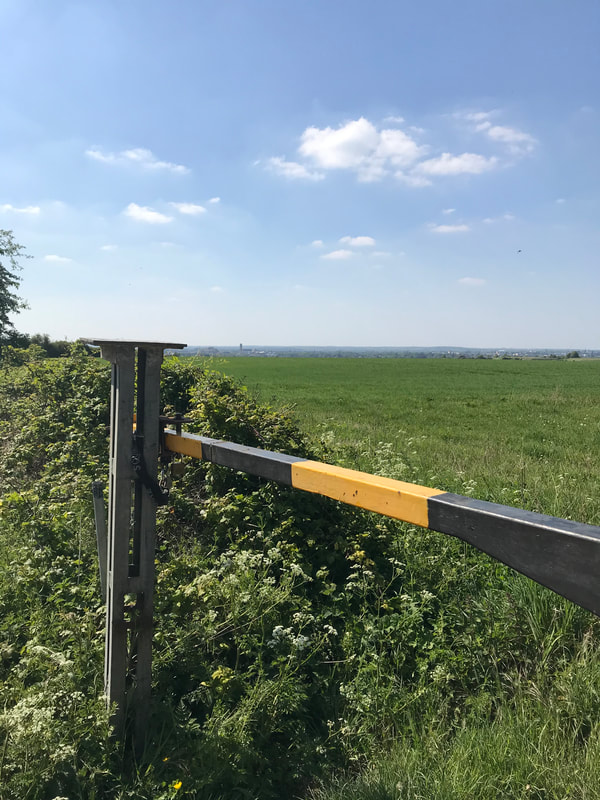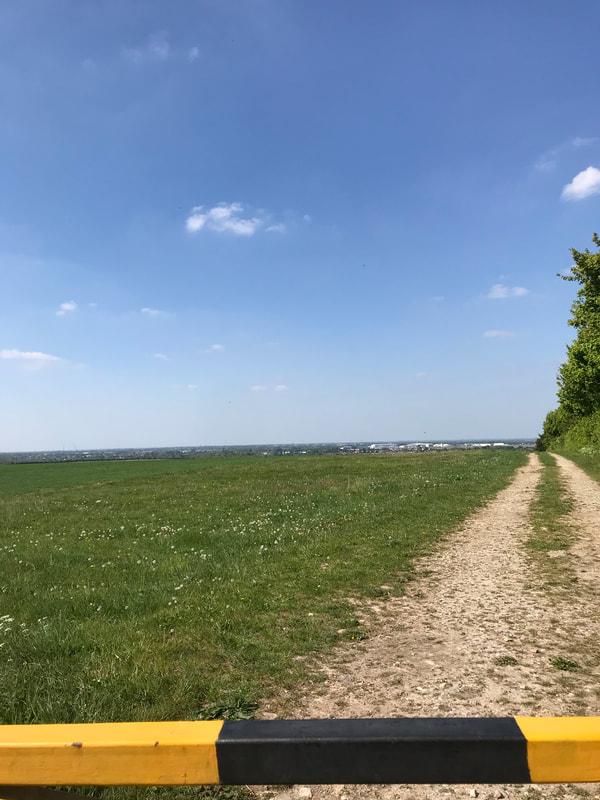|
This memory is taken from the Cherry Hinton Memory Books Collection which were donated to my Cherry Hinton archive. You can read more about the complete collection by clicking here:
Cherry Hinton Memory Books Introduction I am now taking each memory/story and posting them individually on here, adding in any pictures to illustrate the memories and any further points of information and research that may be of interest.
Memories of Cherry Hinton by Bryan Stevens
Vic Phillips often mentions me by my nickname “Ziggy”. Ziggy was the owner of the clothes shop in Newmarket Road before he moved into Regent Street “Stylebest”. This shop sold the most modern clothing during the fifties and sixties and it was where I bought most of my clothing, hence the name “Ziggy”. Ziggy gave me a gold tie pin for my wedding in 1959 which I still have. I am now happily married for the second time.
Bonfire nights in the High Street were something special. There was an air raid shelter opposite 197 High Street, where I used to live, and we would fill it up with logs collected from the Spinney. One Bonfire night the fire was so large that it nearly burnt down the telephone wires.
There was a rubbish dump down Fulbourn Old Drift over the railway line and we would go up there with our air rifles to shoot the rats. One day we were up there shooting the rats when the siren sounded from Fulbourn Hospital and thinking someone had escaped we all ran home as fast as we could.
We all talk about the Spinney with fond memories. During the school summer holidays we more or less lived up there, making dens, laying turf for the floor of the den, and cooking on open fires. One day when we were there my dog Gyp caught two rabbits from out of the chalk pits which I took home.
Opposite the Robin Hood pub are the springs where the water for the brook starts. There used to be railings round the springs to try and keep us out but we would get in and try to catch the pike which would be by the island. We would stand on the now stepping stones and try to catch them before they went back to the lake in Cherry Hinton Hall.
In the brook round by the Black Land allotments we would block up the tunnel underneath the bridge with a sheet of corrugated iron so that the water could not escape and we could get it deep enough to swim.
Grandma Coe who used to live at the then 203 High Street was still riding her “sit up and beg” bike when she was 90 years old. I still remember when a horse and cart passed by her house and left “deposits”, she would rush out with a bucket and collect them. She always had the best roses in the High Street.
As you old Hintonians know, my grandfather started the Stevens Brothers Building Company. He built some of the first houses for the Housing Association in Cambridge. One of the last houses they built was the bungalow in the High Street for the Bartram family (the level crossing keepers). They also built the shoe repairers bungalow next to the recreation ground.
The Cherry Hinton History Society have no record of the building company. My only record is a photograph of a cast iron sewage drain cover in the front garden of the house in the High Street which used to be 201 High Street. It reads “Stevens Bros, Builders, Cherry Hinton”. If anyone could help me find out any other information I would be grateful.
Further notes by Michelle:
I would love to find that drain cover, mentioned above, and get a picture of it and photographs of where the houses above mentioned stood. I have had a look along that stretch of High Street but the house numbers have all changed sometime ago and many houses have been pulled down and others built in turn. There is a real challenge now to draw up a map showing the changing houses/buildings and where they were over time on the High Street, along with working out the house numbering system. Once this has been done we will be able to add the information and pictures to a separate article, and in turn to these memories where they mention any particular houses.
One clue from the story above is that Mrs Coe lived at what was then 203 High Street - meaning that 201 would perhaps of been next door to that house, and therefore the Steven Bros drain cover may still be found somewhere there.
I have search the census, electoral and directory information to see if I can find which house Mrs Coe lived at on the High Street around the 1930's-1960's. The only two clues that I have so far are the picture on the left below, which is from the Richard Hoye collection - it is a photograph c.1985 showing a house on the High Street which is still there today (see my picture on the right). Richard Hoye's picture, on the left, has a note beneath it stating "Mrs Coe". The house has the name 'Temperance Villa' on it (for which I have searched many records and turned up nothing on it) and it is dated 1903. If this was the house, 203 High Street, referred to in the story above it is now known by a different number.
The next clue is on the 1911 Census and of the only Coe family on the High Street at that date - it shows Charles Coe living on the High Street with his family "near the school" - Temperance Villa shown above would have been built by this time - and is near the school on the High Street. This branch of the Coe family were certainly living along this stretch of the High Street in 1911, did one of these Coe ladies end up living in Temperance Villa and is this the house referred to above, what was then 203?
We might also be able to work out where 197 High Street, above mentioned, was and in turn know that across the road there was once an air-raid shelter - which may or may not remain in some form.
I have managed to find out a little more about the Steven's Bros Builders business. The picture below shows Albert Stevens and Jess Tabor in Cherry Hinton near the railway line, stating that they are both apprentice carpenters. The photo is not dated but as you will see from the other sources that I've managed to find, below, this helps us get an idea of what the Steven's Bros were doing in their business.
You can see from the County Directory extract below that 'Stevens Brothers' are listed as builders and wheel-wrights.
Then, in this newspaper clipping below from 1936, we find that the Stevens Bros were the undertakers of a funeral! They give the address for the business as the High Street Cherry Hinton. As odd as this seems, to find them acting as undertakers, this was not unusual for joiners or furniture makers and like to do this at this time. I presume it would be because they are able to produce the wooden coffins but that's just my guess as to why this is the case, as in many similar firms across the country years ago - in fact Chippendale in London, the great furniture maker, also did the same, so it really was 'a thing'.
To add further proof that they were listed as builders and contractors but also carrying out undertaker services, you can see more detail on the bill below from 1935. Note the business header on this paper and the house shown.
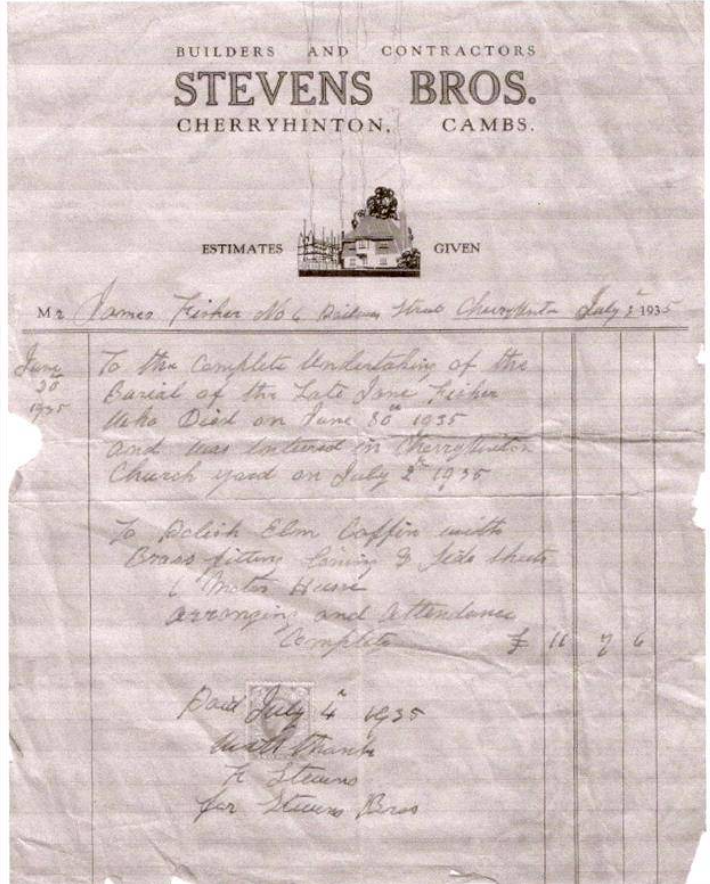 Stevens Bros Builder & Contractors Cherry Hinton. Bill for Undertaker services - CHCAN Donated by Neville Cullup Stevens Bros Builder & Contractors Cherry Hinton. Bill for Undertaker services - CHCAN Donated by Neville Cullup
You can see the details of the business still continuing in 1955 from the newspaper advert below.
 Cambridge Daily News September 24th 1955 - British Newspaper Archive Cambridge Daily News September 24th 1955 - British Newspaper Archive
A very important part of the village has been the British Legion Hall, first a shed-like building that once stood on the main recreation ground and then, when it was rebuilt down Fishers Lane. So many Cherry Hinton memories from both of these two versions of the hall from over the years. The Fishers Lane hall was demolished about 10 years ago and now the houses of Poppy Close stand on its site. I have now discovered that the Stevens Bros were the builders for the British Legion Hut in Fishers Lane, as you'll see from the bill below. This is great to discover and will add a bit more to the story of the firm. Again note the header and picture of the house. They give their address as 77 & 79 High Street Cherry Hinton.
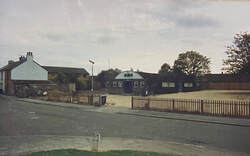 The second British Legion Hut, Fishers Lane Cherry Hinton c.1985 - R.Hoye, courtesy of Cambridgeshire Collection The second British Legion Hut, Fishers Lane Cherry Hinton c.1985 - R.Hoye, courtesy of Cambridgeshire Collection
The picture above shows the Fishers Lane, British Legion Hall, as it was, built by the Stevens Brothers of Cherry Hinton.
Please do feel free to get in touch if you would like to add anything to this story or if you have any further information on the Stevens Bros.
If you'd like to support the work that I do and the archive, why not buy me a virtual coffee, I'd be really grateful and it will help keep me going!
Just click on the green button below :)
2 Comments
Here you will find the complete article by Chris Gifford 'Cherry Hinton 1946 Onwards' - if you haven't done so already, I would encourage you to take a brief look at the introduction page about the memory books and this accompanying article first - which you can do by clicking the link here: Cherry Hinton Memory Books - Introduction
There are three books altogether and this one separately written article - you can find the links to the other books and this article by visiting the Cherry Hinton Memory Books Introduction page, mentioned above, or by searching the index (Categories) on the righthand side of this page or by using the search box on the right.
Cherry Hinton 1946 Onwards Chris Gifford 5.6.12
Chris Gifford Cherry Hinton Memories
“Are you sitting comfortably? Then I’ll begin!” This we heard as infants in the school hall. A short story on the wireless in early afternoon, and afterwards, we had to lay on rush mats to try and sleep. I remember that we had “Music” once a week. A low cupboard running down along one side wall, stored all of the instruments. We boys wanted to get hold of a drum. But as I sat near the opposite wall, all I ever had was the triangle – such a disappointment. So begineth the course for my life. After one Christmas Party in the Hall, we came out to find that it had snowed. We began to make slides, but I had crepe soled sandals which would not slip. So, I made sure that I had leather soled shoes on the following day. Near the entrance to the Playing Field was a small brick kiln, which seemed to be smouldering for days and blackened Pots etc eventually came out. The Sports Days were exciting. We all had roped off areas for each class along the far side of the Playing Field. At one Sports Day, Susan Thompson and her friend were short of a third person. A teacher asked me to join in. The girls were a couple of years older than me, but they were ‘girls’, and I was confident that I would keep up with them. After about 20yards I realised that I couldn’t, and half-way along, they pulled me off my feet. So that I went head-long onto a white line. I returned to my class, looking, and feeling, a right Charlie. I think that we all enjoyed “Tig-Ball”, when one was hit with a tennis ball, one joined the “catchers”, until there was only one person left. Football was our passion. Putting a sleeveless jumper under one’s football shirt to keep warm. Having your mother’s women magazines down your socks as shinpads. Having football boots on already, before one caught the 131 Bus into town. The terrific racket stamping up the stairs to the top deck. Dangerous leather studs with protruding nails. Cutting three or four parallel cuts down one’s leg. Or in my case cutting mums mags to shreds. I have always enjoyed dancing. Ballroom, Barn dancing, German dancing, I liked it all. And I put that down to the lady who used to come and teach us Country Dancing every week. I used to like dancing with a pretty girl with lovely red hair, freckles, and plaits down to her waist. I used to hold the door, as everybody came into the classroom. Quickly whisper to her, “Can I be your partner?” She always said “Yes”. You see that I never had trouble with girls under 12, and over 70. It was the bit in-between that caused me trouble! At our recent Cherry Hinton Reunion at a Fulbourn Pub. I kept saying to ladies, “I’m looking for my Country Dancing partner. Was it you?”. Plenty of giggles, until I asked a rather younger young lady. A look of contempt came over her, and she said, “You had better ask my older sisters!” Boom! Boom! It was clever of our Headmaster to play some classical music at morning Assembly. I liked “The Hall of Mountain King” best. He used to ask us questions. One was, “What is a weed?” And of course, we all gave various plants as the answer. But he said, “Anything in the wrong place. So, a potato could be a weed, or if one dropped a couple of lettuce seeds in the wrong place – they would be weeds.” I have remembered that answer for over sixty years, but the question has never turned up! So, if we have another C. Hinton Reunion, will somebody please ask me the question. Stop me dreaming about that answer! I remember that the teacher asked us to bring a potato to school, as we were going to cut them in half, and make potato prints. Modern ideas even in those days. The following day, I walked to school with another boy, and as we reached the Tin Hut, we remembered – no potatoes. I used to help my dad with planting potatoes, so I knew that they wouldn’t be too deep. Somebody had a vegetable patch between the railway line path and the playground boundary. I told my friend to keep an eye out. Took a stick, ran over to the potatoes, and quickly dug two out. Of course, all afternoon, I was waiting for the headmaster to come into our class, but nothing happened. Another time, the headmaster asked me to take a bundle of old letters to the Vicarage. The stamp on the top of the letters was Queen Victoria. Many of us collected stamps in those days. I kept looking at that stamp, and I gave into temptation, and ripped the corner off that envelope. (Even in later life, I was prone to give in to temptation – not stealing, unless it was a cherry). Then I thought, I’m going to get “told off” for taking one stamp, I might as well have more. I worried about it at the time, but nothing happened. I remember a Vicarage Fete, and they had a painting competition at 6 pence per entry. I did a vase of flowers. A blue vase with some red crosses on it. John and Peter Hedge and their mother were going to the fete. I tagged on with them. The winning entries were pinned up on display boards. There was my painting, but with a girl’s name on it. I told Mrs Hedge, and she went over to tell them the mistake. When the prizes were given out, I was given two fairy cakes worth 6 pence. Disappointed Tunbridge Wells! I never went in for anymore painting competitions. “Turf” cigarettes had printed cards onto the packaging. So, as we walked to and from school, little Eagle Eyes were on the lookout for old ‘Turf’ packets. Brian and Tony Tabor, as they lived at the Chequers Pub, suddenly cornered the market. They came to school with packets full of Turf cigarette cards. The dear boys had emptied out all of the Turf cigarettes and taken the packets. After which, customers were given their cigarettes in small paper bags. Then dad had some pigs down the end of the garden and took some farming magazines. So, when our teacher asked us to look out for pictures of farmyard animals. Tony arrived for school with a whole pile of magazines and gave them out. But there were only a few pairs of scissors, and I became tired of waiting, so ripped out the various pictures. Pasted them in my book, job done. But the teacher was not impressed. This was while in the Tin Hut. The teachers had a chart on the wall to record Tables. One had to say the table and then answer some questions, i.e. what is 7 x 3? 9 x 3? Etc etc. Success meant a star against your name. I struggled to get 2 stars, while some children had 5 or 6 stars. I had forgotten that we had poetry and we had to write out the poems into our books. The neatest one got a prize. We boys discussed the prize as we walked home and decided that it must be a penknife! I won the prize, and it was a book of children’s poetry by R.L. Stephenson! Deep depression as we walked home. A poetry book of all things. Some weeks later in Assembly, the Headmaster asked a question to which the answer was R.L. Stephenson. Nobody knew the answer. He said, “I’m surprised that Chris Gifford didn’t know the answer, after winning that book of poetry by R.L. Stephenson”. Of course, I went as red as a beetroot, having not even opened the book. Last year at the Trumpington car boot, I brought a copy, thinking that I would actually read it after 60 years. But I mislaid it somewhere in my house. Sorry! Mr Stevenson. We were writing with the simple nib pens and had to keep dipping the pens into the ink. When we came out of school one afternoon, a man was sitting outside the Tin Hut with a board of colourful fountain pens. They had wooden bodies. He said that if we brought him a bag of old clothes, we could get a pen. I ran home and got a bag of clothes. My mother being in Town. But he said that these weren’t enough, so I had to run home again, grab my dad’s old pullover and an old jacket, run back again. This time I was given a pen. The next morning in class a lot of us were writing with our bright, new pens. Tony Tabor and I were good friends. By the time we were in the top class, bikes were beginning to become available. I was scared to sit on the saddle at first, so sat on the back mud guard. Spent hours going up and down the lane beside our old house, which led to the Stevens wood-yard and black barn. I was always after wood off-cuts and saw-dust. I took my bike to the Rec. Whilst there, I tried to sit on the seat, as the grass gave a softer landing, if I fell off. Once in the saddle proper I could ride to school. Tony was also riding to school. One day we were racing each other home. Neck and neck, we peddled furiously. Suddenly we caught up with an old man going slowly. I was on the inside and I realised that if I braked to go around the outside of the old man, I would lose the race. I saw that there was just enough space for me to over-take on the inside as Tony on the out-side. We flashed past, and we could hear the shouting and swearing fading into the distance, as we arrived home. A draw! There were a whole bunch of children who lived in Mill End Close, opposite to the Recreation Ground (Rec). We met on the Rec and soon had a game of football in progress. Anybody who turned up – played. 15 a side, 20 a side, it didn’t matter. All that mattered was that the kid who owned the football turned up. Otherwise, we picked sides to play hide and seek (offs). Initially, there was only a swing on the Rec. If one was on the swing, and a Tiger Moth flew up from Marshalls, it made a strange noise with one’s ears. Near the swings stood a circular stand of plum bushes, but with a hollow space in the middle. Somebody suggested going around the circle without touching the ground. Some promenade tree roots in some gaps helped this along. Next suggestion was tig, without touching the ground. Exciting stuff, but usually somebody went home with a dirty handkerchief tied around a leg wound. There were bushes up the sides of the Rec and a line of mature trees across the end. More testing to our climbing skills. One day, Tony Tabor and I rode to the end of the Rec and decided to cut a track through the big trees. So, we spent a happy time with a spade and saw making our dirt track. Making a half circle with short branches on the Rec itself. We began the races beside the big trees, around the half-circle, and then to the trees. Any over-taking had to be done on the half-circle. We used to let other kids use our bikes to race. Plenty of fun, until it was another race between Tony and myself. Just before we went into the trees, Tony’s pedal went into my front wheel, and whipped out several spokes in a split second. My poor father used to spend a long day repairing cars at a garage along Cherry Hinton Road (Cambridgeshire Motors), cycle home, and find more work with our bicycles. We made bows and arrows. Took then onto the Rec to see who could shoot the furthest. One boy had a large box kite, which went absolutely miles into the air. We spent many happy hours trying to make kites out of old newspapers, bamboo strips, glue, paint and string. We had to run at 50 miles an hour just to get those kites up in the air a bit. Catapults were another obsession. As we wondered about, we always kept a good eye out for suitable wooden forks in a “Y’ shape. I found a red car wheel innertube in my dad’s garage. “Borrowed” my mum’s scissors and cut off strips for catapults. I think that nearly every kid in the area, turned up for a pair of red rubber strips. At the end of the Rec was usually a corn field, and we enjoyed making tracks and hiding places in it. Until the farmer sent the local Copper to tell us off. I remember lovely summer evenings when we were all having great fun and our mother coming to the Rec to call us Gifford three in for bed. Looking at the older kids, who were allowed to stay out. There are photos of my father as part of the Chequers Darts Team, in cricket whites in the Cherry Hinton Team, and he was in the Football Team. After he married, he didn’t have the time for any of it – which is sad. Our place of joy was the Spinney. A wild place of small hills and a deep hollow, thick with bushes and some mature trees. To have such a place at one end of the village, opposite the “Robin Hood” pub was brilliant. We used to gather on the Rec. Divide into two teams. One side would dash up to the Spinney to hide, while the other side counted up to 500 (nothing wrong with our village education!). Whoever was caught had to join the Seekers, until only one or two were left. Not being able to find them, sometimes we called out “We are going home!” and all troop out of the entrance. But then creep around the edges, waiting for movement. Then all poured in to give chase. My middle brother Dave (Todd) was extremely cunning at hiding. Once he sat in the middle of a creeper covered bush right beside a footpath. Another time, he climbed a tree and lay on an Ivy-covered branch, going over a footpath. So, we all passed by, underneath him. I once sat under a bush, only to be entertained by a little mouse fussing about. In summer, we used to ride our bikes down the hollow. In winter, we went down on our home-made sledges. There was a tall plant, which when old and dried out, made beautiful spears. The hard root had a long sharp point. We used to stand on a hill. Put the index finger on the end and hold the spear between the thumb and middle finger. Lift the spear up with the other hand, and throw. So, we all lined up on a hill. One, two, three, throw, and a whole shower of spears flew off. Most of us had wellies on. Once when I bent forward to collect my spear, another spear hit my wellie. It went through the top of my wellie, grazed my calf, and made a hole in the opposite side. Everybody was very impressed by the effectiveness of the spears. It was not until many years later, that I realised that the little rascal John Hedge, had deliberately thrown his spear at me! If there were only two of us and we had catapults, we would hide behind two thick tree trunks, about 60-70 yards apart. Then fire lumps of chalk at each other. Chalk was slow in flight and easy to see. So, we didn’t get hit. But if one of us found a marble in our pockets, we called out a warning because one couldn’t see a marble in flight, and it was very accurate. We hid behind the tree trunk, as the marble thudded into it. If any of us had any money, we bought a bottle of pop, and a batch of bread rolls from the bakers, near the Robin Hood. Then go into the Spinney to divide them out. Opposite the Unicorn Pub in C.H. High Street, was a footpath between the houses. It led into the end of the Bakeries very long garden. We chose to walk up this path, because it went past various fruit trees. Especially a heavily loaded Victoria Plumb tree, right beside the path. So, on our way back with our loafs of bread, we would pinch several plumbs. (Still my favourite). But the baker used to wait outside the Robin Hood, for our father to cycle home, we got warned to leave the fruit alone. The smell of that Bakery was gorgeous. Those rolls had a special taste, not like the bland white bread of today. Being the eldest son, our father used to put me on his bike, and cycle to the top of Cherry Hinton Road, to the Cattle Market. He used to buy cheese roll, which had thick slabs of cheddar. Several years ago, I went to the Bury St. Edmunds Cattle Market, and brought some cheese rolls and it was the same taste. I was delighted. Opposite the Robin Hood was the spring, and one could see the water bubbling up, a pile of fine grit moving about. There was an island with mature trees. We put down branches to make a bridge. We got onto the island but several of us had wet feet. The water became deeper, and it was covered in thick weed. But there was a clear patch, and a large Pike could often be seen sun-bathing. One day a group of bigger boys from the Church End of the village, arrived with home-made spears to get the Pike. They were all standing in the water, which had gone muddy, shouting at each other and stabbing the water. It’s a wonder none of them were injured. They all cycled off, but I think, without the Pike, which must have swam downstream to find a new home. At the other end of the spring was a high black metal fence. But we could get our feet between the uprights and walk over to the other side. There was a large meadow, and the stream went on to Cherry Hinton Hall. At the time the Hall was in private hands. The back of the Hall was an overgrown jungle. So, we could follow the stream along and into this brilliant place. If we made too much noise, there was always the possibility of being chased by one of the gardeners. I remember one sunny day, and we were following a track through the jungle. I climbed onto a thick fallen tree trunk and was just about to jump down, when in a patch of sunlight lay two grass snakes. I yelled “Snakes”, and we all ran off in panic. Us little boys had never seen snakes before and were easily scared. There was another set of black metal fencing at the other side of the C. H. Hall, which we could easily climb around and come out at the Brook and allotments. So, we could return home along Mill End Lane. We spent hours and hours down at the Brook, catching sticklebacks. Most of them were 3 spine but occasionally we caught a black 10 spine fish. Usually, it was my brother Dave who caught the 10 spine fish, as he went down the stream of the Wooden Bridge, and just used his hands to catch fish. Further down-stream, where it was too deep to paddle, we had some thread and a cane, tied on a small nut for a weight and a small worm. The bigger sticklebacks would take in the end of the worm, and we would gently pull them out. Sometimes they dropped off but in the Brook. We lived in the “Red House”, which was a pair of old red brick semi’s, belonging to the Church. We were on the High Street, opposite the Chequers, and the Thatched Cottage. It was only a one room up and one down. Very dark inside, and dark twisting stairs. We had gas lights and had to go “over the yard” to an old wooden hut privy. Dad had a large shed next door, where he had a vice, tools, and car parts, as he was a mechanic by trade. By watching him in his shed, we learnt about the various tools and how to use them. We used to make our own trolleys, fishing rods, and sledges etc. Although we left his tools all over the place, I think dad was quite proud of our efforts. One day, Billy Taylor and I were looking around in dads shed. Billy picked up a strange box with a plunger on top. Pressed the plunger and it made a horrible noise. It was a horn from an old 1920’s Taxi. Beside the Thatched Cottage, on the other side of the road, was a large meadow going down to Fishers Lane. The farmer kept a mixture of white bull, cows, and a couple of horses, all in together. We sat on top of the wooden rails and took it in turn to press the plunger. Weerrker! Weerrker! Weerrker! The animals began to run I a group around the meadow. Weerrker! Weerrker! Weerrker! More and more noise. Faster and faster went the animals, until it was like a wild west stampede. They were thundering around. While at the Fishers Lane end, the white bull disappeared right through the hedge. We ran into the middle of the road and looking anxiously to see what would happen. Suddenly, the white bull appeared, coming straight down the middle of the road towards us. We immediately ran for my dad’s shed, and looked out from the doorway, as the bull went past. We stood in the middle of the road again and watched the bull going up towards the Robin Hood. Sometime later, back came the bull with a man on a bike guiding him home. Back in the shed again. A lot of excitement and we got away with it completely. The next house along was a big house made out of chalk/clunch, most probably from the Spinney. There was a long barn at right angles to the house, and a tall pole, which could have been a wireless Ham Radio. Every evening a little owl sat on top of that pole and screeched. Beside the chalk house was a footpath going to Mill End Lane, and so was our short-cut to the Brook. One side of the footpath were trees and bushes, and on the otherside a large meadow with a tall pear tree and a carthorse. The pears were small, red/yellow and sweet. The ripe ones dropped onto the grass, and we would go over the fence, run out to the tree, picking up as many as we could, stuffing them down our shirts. But the carthorse didn’t like us in his meadow, and always chased us out. So, some of us lads went to the Mill End Lane end of the meadow, The horse gave chase, as we others went in for the pears. As soon as he saw us at the tree, he came charging up. But we already had our fruit. For us boys, the best place in the world was Woolworths. They sold what we wanted. Foreign stamps, balsa wood gliders, marbles, and fishing kit. Brilliant. Brian and Johnny Richardson lived on Coldhams Lane, and they had the Cement Works pit beside them. A real source of adventure. Their father took them on bikes right to the end of Coldhams Lane, over Newmarket Road, past the Gas Works and to the River Cam. So instead of sticklebacks, they were catching Gudgeon, Roach, and Perch. Huge monsters in comparison. They told us lads at school and got us all excited. Woolworths sold a beginner’s kit of line, float, weight and hook on a card. Dad got a piece of 1” square board, knocked in some staples, and nailed on a cotton reel, so I could wind on the line, and fix the hook to the staple. Dad found an empty paint tin, and a piece of white bread. Ready. From the Chequers, I cycled up to Coldhams Lane and met Brian and Johnny. That first time seemed a long cycle ride. Too much anticipation I suppose. Soon we were beside the river, and I watched what they were doing. Put my float up to fish close to the bottom. Gudgen shoal on the bottom and bite freely. So, it’s only a couple of minutes before one of us has a bite and swings in a sturdy fish. We only had to fish 3” or 4” from the bank, so it was easy fishing. Time goes by quickly when you are having fun. We gradually moved upstream until we came to the Jesus Green Weir, and that became our favourite place. Fishing became one of our main hobbies. We three Gifford brothers always took our rods in the car, whenever dad took us out. Even coming back from a Hunstanton seaside trip, the rods were with us. Halfway back home he always stopped at an isolated pub right beside the river (A10). We caught some lovely silver bream, another new species for us. Dad always came along with glasses of pop and crisps. We didn’t mind how long our parents were chatting in the pub, and it was always disappointing to have to stop fishing. Brian Richardson became a very accomplished fisherman. After about 50 years I was able to obtain his phone number and we are going to meet up and have a go at fishing again. And of course, it will give us a chance to chat about our childhoods. There was no T.V. when we were young. The Victoria Cinema on the Market Square used to run Sat morning films for us children. The “minors” had a membership card, and sometimes checked the cards at our back of the cinema entrance, beside the Holy Trinity Church. The Mark’s & Spencer shop is now on the site. My friend Billy Taylor had forgotten his card at that morning’s check-up. I went through, and then sneaked my card to Billy behind the back of the checkers. They made us sing songs first of all. The words were put up on screen, and a white ball bounced along the words. Quite boring, unless it was the Woody Woodpecker song, and we could make a lot of noise. The films begum with cartoons, then a serial of a cowboy, detective, or later a space film. One could see the cotton holding up the spaceship and smoke just puffed out of rockets. The serial always ended at a critical point. Was the hero going to survive a tomahawk blow, or a gun shot? How was he going to get out of this tricky situation? Then we had a full-length film, and we loved Tarzan of the Apes, or Cowboys & Indians. After the cinema, we looked around the Markey Square. Our dad used to mend the car of a market trader who used to sell broken biscuits. We used to say hello to him, and he would say “Hello, the Gifford Boys”, and give us a bag of mixed biscuit pieces. Then to Woolworths to spend our 6 pence pocket money. Before catching the 131 Bus back to Cherry Hinton. A group of bigger boys were discussing the Treasure Island film about Pirates etc. I ran home and asked my mother whether I could go with them, and she said yes, which surprised me. It was a very exciting film. Especially when the boy had climbed into the near empty apple barrel and he over-heard Long John Silver’s plan. A Pirate was just about to stab into the barrel for an apple, when land was sighted. Again, when a pirate had chased the boy up to the Crow’s nest, and the boy had to shoot him. Recently, I have been able to obtain a copy of that film and enjoyed watching it once again. On the corner of Mill End Close and the High Street was a Grocers shop. In those days, nothing was packed. So the staff had to cut, pour and pack every item. Consequently, there were very long queues in the shop. I was only about four years old, and my mother used to give me a list and money. The shop was always crowded to the door. All I could see were legs. I used to worm my way to the counter and could just hold up the list above it. Which attracted attention and I was soon served. I remember one woman saying loudly “why is he the last in but the first to get served?” I think that we lived in a golden age for childhood, and we all had a very happy and exciting time.
If you'd like to support the work that I do and the archive, why not buy me a virtual coffee, I'd be really grateful and it will help keep me going!
Just click on the green button below :)
Here you will find the complete contents of Cherry Hinton Memories Book Three - if you haven't done so already, I would encourage you to take a brief look at the introduction page about these books first - which you can do by clicking the link here: Cherry Hinton Memory Books - Introduction
There are three books altogether and one separately written story - you can find the links to the other books and story by visiting the Cherry Hinton Memory Books Introduction page, mentioned above, or by searching the index (Categories) on the righthand side of this page or by using the search box on the right.
BOOK THREE
Book Three “The Golden Years - Cherry Hinton, 1930's-1960's"
Contains memories from: Unknown Christine Wright Mavee Williams Malcolm Jobson Bett Dawson Stuart Nunn Neville Cullup Basil Simpkins Tony Tabor David Gifford Kenneth Gifford
Below you will find the full transcription of book three, copied as it is, with pictures of the handwritten stories to compare (and send me any corrections!). You can choose to read through it here or, for more detail, you can click on one of the names above to see their story individually and any extra pictures that I have added to illustrate their story.
Book 3 The Golden Years Cherry Hinton 1930's-1960's.
Unknown: Cherry Hinton Memories
I was born in the middle of the night in February 1944, in a council house up Fulbourn Road beside the Spinney and at the other end was a big Dutch barn, both the Spinney and the Dutch barn were ideal for children to play in. The council houses at Fulbourn Road were the latest in Cherry Hinton, completed in 1939. They had flushing toilets, a luxury that not everyone enjoyed in England during the 1940’s. I recall in my pre-school days the High Street was not made up and not kerbed all the way from the Robin Hood corner to the school – which was opposite Ling’s sweet shop. We could drink the water from the natural spring opposite the Robin Hood where wild Honeysuckle grew and Moorhens nested on the island. There was a green triangle that made the slip road from Queen Edith's way to Cherry Hinton Road and Mr Scott, who lived in the first house by the Spinney in Queen Ediths Way used to hold Sunday service for the young men of the parish. There were two thatched cottages in the corner of the Spinney opposite the Robin Hood where the late Bricky Mason used to live in one. Turkeys often wandered along the High Street from Stevens Builders Yard where they were being fattened up for Christmas (meat was on ration). In the late 1940’s for pre-school children Cherry Hinton was idyllic with the war over. We had the Spinney, the Recreation Ground, Cherry Hinton Hall, the chalk pits and lime pits, with only the chalk pits still being worked of these – we could roam free all over the village. Fulbourn Road in the late forties and early fifties was home to lots of children. The games we played too numerous to remember all. The council house side was on a sub-road with only one entrance for cars, you could draw anything on the road and play. There were several variations of hop-scotch and with the Spinney and chalk pits nearby there was no shortage of chalk. I recall the game with the most competitive edge, passion, and arguments, that lasted days or until the next time all the children were available for a re-match was rounders – “boys against girls a catch was the whole side out”. On the Recreation Ground then half the size it is now, as Bullard’s Brewery owned the Chequers and allotments behind it, there was Sid Hancock’s bungalow – the village cobbler. The old British Legion “Hut” as the locals called it was a long, mainly wooden structure built on raised concrete stilts, therefore small children could easily move underneath it. The Rec in those days had lots of bushes around it and small copses of trees more natural and evolved than the well organised and designed as today – but much more fun for children. On V.E. day in May 1945 Fulbourn Road children had a celebration party under the Dutch barn. In the late 40’s and early 50’s on a Saturday morning and early arrival was Mr Hardwick who came down the Fulbourn Road with a horse and cart, it was a mobile shop. A thatched cottage caught fire on Saturday morning in the High Street 1955 and the Esso Garage and Petrol Station were built there.
Christine Wright nee Ellison Cherry Hinton Memories 12 Nov 2012
Cherry Hinton in the 50’s & 60’s was very special. I know everyone will say that about their village but it is true. Bert Quinney’s shop – he could serve 10 people at once as he knew who came in for cigarettes & what brand, he knew who paid cash and who had “tick”. I am sure he was the shopkeeper who “Open All Hours” character “Arkwright” was based on. Pledges newsagent in Coldhams Lane used to sell comics which were out of date much cheaper. I used to love going there to get “Bunty”. Greenwoods sweet shop near the railway was so small. In the 70’s Mrs Greenwood used to do chiropody. Our Sunday “paper boy” was Jim Chapman – bringing us the News of the World. We lived in the prefabs in Teversham Drift which were lovely & warm until 1964 when we had to move to Fulbourn Road as they were going to be demolished. The house in Fulbourn Road was a shock as there was an outside toilet & ice on the inside of the windows! Cherry Hinton Infants School with Mrs Holman as Headmistress. She showed my mum (Tess) the drawing I had done titled ‘what I did on a Sunday morning’. It was a picture of my friend Valerie Betts and I playing in the garden of the Red Lion while my mum was inside having a drink. All the other pictures were of children going to Sunday School, going to nana’s, taking the dog for a walk etc. Well, she always told me to tell the truth! Miss Rush riding her ‘sit up & beg’ bike across the playground & all the children jumping out of the way convinced she would run them over. Was there a child in Cherry Hinton who was not frightened of her??? Colville School with Mr Farmer as Headmaster. Being milk monitor & carrying the crates on a cold icy morning & the milk had frozen forcing the top of the bottle was a highlight. Playing tig off ground in the girls toilets & being sent to Mr Farmer for the steel ruler treatment. Daren’t tell my mum otherwise I would have got another clout when I got home. Many, many memories. Christine Wright nee Ellison
Maree Williams nee Stevens Cherry Hinton Memories Nov 2012
My sister and I were born in the front room of Fulbourn Road in 1944, and I lived there until I got married. Growing up in Cherry Hinton was childhood heaven, we spent most of our time playing outside in the road, the Spinney, down the Rec and in the big barn at the end of our road and round the back of the houses there were allotments, no buildings then. My father kept pigs and chickens and Roy Tabor had a shepherd’s hut on his. My father used to walk the sows all the way down the High Street to Mr Fabbs pigs opposite the church. We knew mostly all the neighbours, Tabors, Grays, Chapman, Walders, Clarke, Pearson. We would start building a bonfire weeks before Nov all the road contributing and on Nov 5th used to go with our potatoes. No fancy fireworks then – bangers, rockets, Catherine wheels. We would try and keep embers going for days. We used to be sent to shop in Smiths. – on the bk, and George Parish the butchers used to have a bike with a huge basket on the front, smoking and coughing his heart out, then there was Arkright himself – Bert Quinney with his brown coat on. Love Lane was another haunt there was a scrummy pear tree in the middle of the field ideal for scrumping, messing about down the island and falling in trying to get to the middle, playing in the buttercup field opposite the Spinney, doing a paper round on the new estate after collecting the papers from Jim Chapman in Coldhams Lane We used to walk round from school once a week for country dancing, a lady used to play the accordion, and many happy times spent in the Tin Hut, it looks a bit worse for wear now. We also had lots of dancing etc. in the British Legion Hall down Fishers Lane, mostly every week there were live groups, rock, roll and skittle, Mark Arnold and Jonny Collum absolutely packed, great, happy times.
Malcolm Jobson Cherry Hinton Memories – 20/12/2012 – 75 High Street (after Giffords)
My family, the Jobson’s, mum Mary, dad Tom, Michael, Margaret, Alan and Brian, arrived in Cherryhinton in the early 1950’s from Radwinter End near Saffron Walden. We lived at number 75 High Street in a tied semi-detached home which belonged to the farm owned by Mr Chalk, where my dad worked as a famer. Mr Chalk was also an auctioneer at the cattle market which is now the industrial site at the top of Cherry Hinton Road near the railway. After Mr Chalk died, the farm and the field were sold and now is the Chelwood Road estate behind Rectory Terrace on the High Street. We later moved onto the Colville Road estate to live at No. 10 Drayton Close, my dad still lives there today with my brother Alan. Going back to the house on the High Street, behind there was a builders yard owned by Mr Stevens who had a son called David whom I played games with. He had a elder brother who played football for Cherryhinton F.C. I had another mate named Peter Anderson who lived in Fishers Lane near the little chapel, we all used to go on the bus with the football team to away matches on Saturday afternoons. Some player’s I remember in the team were, Brian Stevens, Peter Dean, Billy Chapman, Mick Colville, Sam Bartrum, Ron Hagerty, to name a few, and the manager was a Mr Denny who lived in Queen Edith’s Way. Opposite our house, and still there today is a little thatched cottage where Mrs Jane Elwood lived, a lovely old lady who used to give us children sweets and drink (orangeade). Behind her house was a field which someone used to keep a little pony, and every weekend a male patient from Fulbourn Hospital used to bring a carrot to feed it. We named him Pony Man. The site now belongs to Tony Mason Plastic Engineers. To the left side of our home was a big white cottage and when the wife died the gentleman had it burnt down, and he went to live in a caravan in in the orchard at the bottom of his garden. My friend Peter’s mum used to work as a cleaner at the big house in the middle of Cherry Hinton Hall grounds. At that time it was used as a play group, and one day, when his mum was there working she let us go down into the cellars which are still there today. It now belongs to Cambridge City Council who hire it out. At the back is a large playing field. When myself and Peter came out of Netherhall School we used to kick a tennis ball to each other on our way home. Later when we were in our teens we met up with a lot more youngsters and we formed a Sunday football team which was called Hinton Rangers F.C. and we became the first team to win the newly formed league by one of our lads named Bruce Badcock and someone from the Cambridge newspaper. I remember we all met round Mick Davey’s house near Queen Ediths School to pick the name of the club and the all-green kit we played in by a show of our hands. At the top of Fishers Lane on the High Street now stands a Guest House, before it was a home to Mr West who owned the Renault Garage at the top of Coldhams Lane near the traffic lights. They also had a son called Martin who used to let me and Peter play snooker on his father’s table. The little hut in the picture with the lamp post outside in Mrs William’s Story was a classroom for the infants school which I had when I went there. We all loved Cherryhinton village as it was then, we knew a lot of people, who looked after the little ones, watched it grow to what it is now, no longer a village, but a part of the City. By: Malcolm Jobson.
Bett Dawson (nee Stevens) Cherry Hinton Memories
In February 1938 we moved from a farmhouse in Shelford Bottom to the new council house in Fulbourn Road Cherry Hinton. My mum and dad and two brothers Peter and John, and my sister Pam. I was 9 years old. We thought we were in heaven, bathroom, hot and cold water, flush toilet (even though it was outside). We all went to the school in the High Street, Mr Bray was the headmaster, the times I’ve stood on a chair and was hit on the back of my legs with a ruler. We spent holiday playing marbles in the street and hopscotch. My father was in the T.A. and went straight in the army when war was declared. During the war there was dances every Saturday in the Legion hut on the Rec, you could hardly move let alone dance it was so crowded, especially when the pubs closed. We used to sit on the bank and watch the army convoys going down Fulbourn Road, on one such convoy there was a fatal accident near Fulbourn Hospital, my father built an air raid shelter in the garden but we rarely used it, it was much better to get under the table when the sirens went. Then we had the evacuees form London, the brightened things up. One or two families stayed in the village after the war. In 1947 the weather was very bad, we had lots of snow, my brother Pete and I had to get in the loft and shovel snow out, the inside of the windows were iced over and you can guess what it was like getting up in the morning and walking on cold lino. Over the years, whenever I’ve been, I’ve always come back to Cherry Hinton it was a lovely place to live, and I’m still living in Fulbourn Road. Bett Dawson (Nee Stevens)
Stuart Nunn Cherry Hinton Memories 04/02/14
I was born on 27th April 1951 to Jim and Joyce Nunn (nee Elliot) and we initially lived in a room on Fulbourn Road next door to the Plumbs. Mum was the daughter of Kathleen and Bill Elliot who lived in Fishers Lane. Bill worked at the cement works and spent a lot of time at the Five Bells in the High Street and I remember on one occasion he fell off his bicycle attempting to get home after a session in the pub. Her mother also lived in Fishers Lane and I believe the family history goes back many years before that. Around the age of about 3 mum and dad got themselves a council house in Drayton Road, dad spent most of his time on the allotment and playing football for Cherry Hinton who were a very successful team in those days. I can remember as a young lad going football training with dad at Stevens Farm in Teversham and I think we were one of the few teams that had floodlight facilities for training. We used to watch the Cherries on the Rec and in the mid 50’s they won the premier division of the Cambs league and I recall seeing such people as Brian Stevens, Peter Dean, Billy Chapman in the team. I remember Mr Rust the hairdresser as one of the driving forces. I used to go to the 27th Cubs at the red hut on the railway line and always went to Auntie Nelly and Uncle Charlie Mason who lived in Railway Street for my tea on a Thursday. Their daughter Ann would always make sure that my ears were clean and that my hands were not dirty before attending Cubs. When I visited Aunty Nelly and Uncle Charlie I used to play with their son Tony who used to shoot birds in the garden with his air rifle and I had the most enjoyable times playing with him. Mum and dad were regulars at the Unicorn where they played both skittles and darts and I can remember as a young boy sitting in the garden eating my crisps and glass of lemonade, the landlord being Reg and Daisy Fuller who would be always bickering with each other but the pub was very much community orientated with lots of Cherry Hinton people enjoying themselves. I used to go shopping with mum at the co-op and was fascinated to see the money shooting around the tubes when she paid for goods. Gran had her groceries delivered from Bowyers but unfortunately their demise came in the late 60’s. In my early teens my friends and myself used to visit Bob Hirsts fish and chip shop in the High Street who used to sell marvellous pickled onions and would always give you a bag full of fritters when you bought your chips. Mum and dad then bought their first house in Claygate Road, Cherry Hinton for I believe in the region of £3,000 and I was lucky to pass the 11 plus and caught the bus from the High Street to Soham Grammar School on a daily basis. When I was 16 dad encouraged me to join Cherry Hinton Football Club and I can remember dear old Bunny Tabor finding it difficult to keep up to date with play acting as a linesman. I was lucky enough to achieve first team recognition and a small amount of success was forthcoming. Most of the players came from Cherry Hinton such as Trevor Chapman, Tony Tabor, Paul Ritson, Barry Witt, Mick Colville, and the rest I just cannot remember. A lot of my early years was football orientated and I can remember in the school holidays spending virtually all my spare time playing football on the Rec. The only other activity on the Rec or near the Rec scrumping in the apple trees in the orchard which backed onto the Rec and we were only caught on one occasion and my god whoever hit us, hit us hard with a very large stick. I think that covers the 50’s and 60’s and my recognition of what was then a great village to live in and I have not lived in Cherry Hinton since my early 20’s and am now semi retired living near to the Suffolk coast. Mum died some 12 years ago and dad recently passed away on 9th December 2013. We have now sold the family house and I must say Cherry Hinton has changed so much, not for the better but I still have very fond memories of my early years. Stuart Nunn 04/02/14
Nev Cullup Cherry Hinton Memories
I was born on 1st October 1936 at 6 Railway Street, Cherry Hinton in the front bedroom that looked out onto the cement works. Next door but one to my friend Tony Mason and his sister Ann. My father Bert Cullup and mother Daisy had moved with my sister June from Fishers Lane to look after my grandfather Jim Fisher who worked for Pamplins Agricultural Engineers as a foreman driving threshing and ploughing steam engines. He was well known as the Steam Engine Man. During the war I remember my father was a nightwatchman for Thompson’s Yard in the High Street. He dug an enormous hole in the back garden, then bought a large car body from Richies in Coldhams Lane and put it in the hole with steps down to the door and covered over with railway sleepers and earth. When the sirens sounded we all got into the home made shelter together with our neighbours from number 4 the Stevens. However my grandfather Fisher refused to leave his bed. I can remember bombs dropping over the railway line in a field close to Orchard Estate. One dropped through the roof of the cement works but failed to explode. However the one that fell on Riches Yard killed his guard dog. I can distinctly remember, even now, the sound of the Doddlebugs as they went overhead. I remember my grandfather James Fisher cycling to nearby villages as foreman to oversee the ploughing and threshing engines from Pamplins who lived in ‘The Battlements’ in Fernlea Close. Nearer to home I can recall at least 4 stacks waiting to be threshed at the end of Fishers Lane which was then an unmade road. The smell and heat from these mighty steam engines that remains with me to this day. Also in Fisher Lane on the right Ray Cawston’s father George kept pigs. He also operated a mobile greengrocery van with his wife Gladys. I remember coal being delivered to the school in the High Street through a sort of trap door in the wall to fire the tortoiseshell stove in the Parish Room (Green Hut) and the open fires in the classrooms. These were tended by the school caretaker Harold Fabb. On cold days in the winter the third pints of milk would be stood around these fires to warm – no ‘health and safety’ then. Regarding memories of the school, I remember a sliding partition between Miss Wilson’s and Miss Rush’s classes which was folded back nearing Christmas to facilitate the playing of numerous simple but enjoyable games. Hester Anderson from Fishers Lane was the school cleaner. A large bell hung in an archway on the roof over the top of the school office with a rope hanging down into the hall. Perhaps somebody will recall it ringing? Owen Fabb was a friend and his father Harold kept pigs and one cow in a field beside Fulbourn Old Drift. During the summer holidays when I was 9, Owen and I hoed almost a whole field of sugar beet. Harold gave me a suckling pig which I took home in a home-made wheelbarrow, to a sty in the garden. I called the pig Marco Polo as we were studying the adventures of Marco Polo in Miss Lilley’s class. One Saturday morning I remember Harold wanted to get the cow out from its stall. He tied a rope to her halter and round his waist. After some considerable pulling and swearing the cow bolted pulling Harold halfway across the field with both ending up in a ditch much to my and Owen’s amusement. When I was 10 years old I developed a TB hip and was sent to a hospital in Shropshire. The school P.T.A. sent me 2 books and Sylvia Horner sent me comics. My own mother wrote to me every day, including Sundays for 5 years, she also sent food parcels twice a week because the hospital food, before the NHS, was quite awful. Five years later, after an operation, when I returned home, most of my contemporaries had finished secondary school. I learned to walk again, then Mick Bentley and I made a table tennis table in a large shed in Steven’s Builders Yard in the High Street. We hired the Parish Room (Green Hut) and started a table tennis club. Among the members I remember were Ken Harrison, Fred Rentcomb, Peter Tyrrell, Peter Dean, Peter and Michael Boland and some local girls. We met most Friday nights and entered a good team in the Cambridge League for several years. Opposite the Parish Room (Green Hut) in 1956 Lings shop was bought by Ted and Audrey Cunningham with their young daughter Sally. They introduced me to their niece Janet then 16 who I married in 1959. That same year I bought the bungalow and show repair business from Sid Hancock after working for him for 7 years. I continued the business until April 2013. These are just a few of my memories of a Cherry Hinton childhood – perhaps I should write a book!
Basil Simpkins Cherry Hinton Memories Nov 2014
I was born 31st Jan 1941 at 36 Mill End Road, the youngest child of Ralph & Irene. I had two older sisters Daphne & Beryl, who have both sadly passed away. I remember the blacksmith at the top of the road and Chalks Farm at the bottom. One incident I have always remembered was when my mum cycled by the brook through to Mill Road with me on the front I pointed to a Barrage Balloon in the sky & we both ended up in the water! I remember seeing the ration books hanging on the line to dry out. Before I started school I played with Susan Thompson, who lived next door. I learnt that it’s not a good idea to chase women after chasing her round her rockery and cracking my head on a rock! When I started school in the village I was in Miss Wilson’s class and we drew on little chalk boards. At the end of the day the children who had been good had a turn on the rocking boat. I then went to Miss Rush where I peaked and was top of the class (the only time!). I remember the start chart with the times tables on it and instruments mentioned by Chris Gifford. In Miss Dunnett’s class I think we made made models with Homerton students. I enjoyed playing football and cricket in Mr Read’s class. I passed the 11 plus and went to the Central School with Chris Gifford, Dicky Pilsworth and ? Stevens. Tony Mason went to the “County”. I had happy years there, especially enjoying chess, football & cricket and maths. At Cherry Hinton School I also remember country dancing with Mr North. We did a display on Sports Day and I danced with Doreen Fabb. Around the village I remember playing on the Rec. with Tony & Brian Tabor, Peter & Michael Boland, John & Peter Hedge, John Cornell, Chris Gifford, Brian Grey, Billy Taylor & others. There was a track at the top of the Rec. for riding bikes between the trees. Ray Causton had the best bike. Billy Taylor would take his air pistol & rifle up there and if we were lucky he let us have a go. We played in the brook – building dams and fishing for sticklebacks. My sister and I would go through Cherry Hinton Hall grounds across the wall at the lake, around the springs and into the High Street. I was not allowed to go in the Spinney but of course I did! We loved building dens, making fires and playing “offs”. I remember bikes being ridden up and down the hills. I once borrowed Chris Gifford’s bike (I didn’t have one), came off halfway down, Brian Tabor came behind and his pedal hit my eye. I told my parents I had fallen over on the Rec & hit my eye on a brick! I had a black eye for ages. In the hard winter of 1947 I remember we went into the field at Fishers Lane where there were icy pools. Margaret Boland was the first to run across the ice, making it crack! I joined the Cubs in 1949 and loved the Cubs and Scouts, with Mr Ward the Scout Master. We had summer camps at Pakefield and Cromer and weekends at Pampisford Hall. We went in the back of Steven’s lorry. One Bob-a-Job I remember making sausages for George Parish the butcher with Michael Boland – very unhygienic! During the holidays we would go out on all-day cycle rides, sometimes Newmarket or Royston. I must have been impressed with Royston because when I married in 1966 I moved there and have lived there ever since! Tony Tabor also married that year. We have remained good friends and meet up regularly – often reliving happy childhood memories of Cherry Hinton.
Tony Tabor Cherry Hinton Memories Jan 2015
Sorry, my memory is not good!! I lived in the Chequers Public House on the High Street, Cherry Hinton with my mum Nellie, dad Jesse and brother Brian. I remember going to school with Basil Simpkins, Chris Gifford, Bill Taylor, Brain Gray, also Peter and Mick Boland. I also remember the butcher George Parish and also the shoe mender Sid Hancock (that was before Nev Cullup took over the business). We had an Anderson bomb shelter in the back garden of the Chequers and Brian and I would play in and around it, I remember one of us fell down the shaft and hurt ourselves badly, but I can’t remember which one of us it was!! Our father had a newspaper business and we would go with him very early in the morning to collect the papers from the train station, then we would help to deliver them around Cherry Hinton houses. When we were old enough we both helped mum and dad by serving in the Pub behind the bar, there were lots of great characters – Bags Chapman, Cyril Murrell. Wonderful memories.
David Gifford Cherry Hinton Memories – Ex – 75 High Street. Opposite to the Thatched Cottage. June 2018.
We went to school one day, and found some tyres in the playground. They were for a race on Sports Day. A boy was to sit inside the tyre, and another boy to push it along. Billy Taylor asked me to sit inside a tyre. When the race started, Billy gave a really big push, and away went the tyre over the finishing line, and continued until I think somebody stopped the tyre. When I looked back, I was the only one over the finishing line, thanks to Billy. When I first went to school, I played with the bigger boys. One day a boy called me toddler, so I ran after him to hit him. All of the boys began to call me toddler, which after a time shortened to Todd. So Todd I was throughout my life. When I was about seven years old, we were told about Cave Men at school, and I thought that I would like a Cave. So I took a spade and fork down to the bottom of our garden, next to Mill End Close. I began to dig a hole. Soon, some boys came by, and asked me what I was doing. When I told them, they came into my garden to help. More boys came by, and they helped too. But then I put the fork into my foot. It hurt, so I got out of the hole. By this time there were too many boys to dig. So some of them went onto the Playing Field (Rec). They returned with sticks and green plants to put over the deep hole. They had just finished, when my mother came to see what we were doing. She was not happy at all. Some of the gang had gone into Mill End Close. My mother was telling them off; when she stepped back onto the roof of our hole, which gave way, and she fell in. The gang ran off to the Playing Field, but I couldn’t run as my foot hurt so much. I didn’t know that my mother could speak a foreign language. I didn’t understand one word, but I knew that I was in for it when she got out of our hole. Yes we had a great childhood. They were happy days, but sadness too. After some years, I went to C.H. High Street. I knew that it was just before John Cornell’s 50th birthday. So I bought a card, and gave it to his mother to post. Some weeks later, he phoned me, and that was great. He said that he would look me up, but it didn’t happen. That year I was told that he had died on the way home from work. Only 50 years old. I have had a good life. I became a Christian in my teens. I live near St. David’s in Wales, which is not much bigger than Cherry Hinton in the 1940’s. I can look out of a window and see a line of hills two miles away, and the sea in another direction. It is great! Todd.
Kenneth Gifford (Kenny) Cherry Hinton Memories 2/04/2020
Hi, My name is Kenneth Gifford (Kenny). I’m the youngest brother of three, Chris and David (Todd). Mother “Dot” and dad “Sid”. We have lived in the forties and fifties in the oldest house in Cherry Hinton High Street opposite the old Chequers Pub run by the Tabors. A big Tudor house with a large garden which went right down to Mill End Close where a lot of our friends lived. My first recollection of growing up in Cherry Hinton was sitting on a little seat on my mother’s bicycle at the age of three and half going to pick potatoes in the large field running down the side of Fulbourn Old Drift opposite the parish church. The church where I was nearly stopped for going because I would not sit quietly. Like others, we also all went to the Baptist Church where I remember the Smith sisters would be teaching in Sunday School. Owners of the lovely little grocery shop near Roots Bakery. The school has already been mentioned by others, I can only add that it holds some of my happiest memories. Mr Farmer and my form teacher Mrs Rush, I can still remember running home to tell mum and dad that Mrs Rush had given me the “ruler” across both calves for being cheeky. Me!! I remember one school Nativity play, the school hall was packed, people standing at the back and sides and four young boys were shepherds in the field looking after their sheep. Itchy blankets, tea towel on the head, sitting around a pretend fire. I only had one line “The star is very bright”. This unfortunately came out as “Cor Blimey me, it ain’t half bright in’t!!” My mother took days before she would leave the house. Someone said “A star was born”. The games of conkers and marbles played in the playground were legendary. We always collected an abundance of conkers from the conker trees on our way to school. During September, just past Lover’s Lane was the farmers field which had a very large walnut tree. Iron Railings right along the path with just one bent railing just enough to squeeze through!! But there was always a very large unfriendly white horse just waiting for us. So with carrots in one hand one of the boys would try to lure the beast to the other end of the field, many a times I would just make it back through the railing!! The Rec was another source of fun. Crawling under the British Legion Hut just behind the cobblers bungalow, especially when the dances were being held. We would watch our hero’s playing football during the winter and cricket during the summer. I never thought that I would receive a telephone call in 1962 from Joe Denny asking me to cycle to the Abbey Stadium as three of the first team forwards were either injured or unavailable to play against Girton in the Creake Shield Final. A dream first half saw me scoring the first and third goal in a 6-2 win, followed by my first beer back at the Chequers Pub with the men. My dad was so proud but it put me off beer for life!! Behind the trees at the far end of the rec was a very large corn field where we would run through trying to find the skylarks nests, to no avail. Who can remember the time during the forties when the army put on a show on the rec with all their equipment/guns etc and letting off canisters of “smoke screen” for us youngest to get lost in. As somebody has already mentioned the freedom which we enjoyed during this time. Half penny bread rolls hot from the baker before spending most of the days in the “Spinney” playing “offs” and later riding our bikes up and down the big hills. I also remember always going to the Spinney to pick wild violets and primroses on Mothering Sunday for our dear mothers. We built our own trollys and sledges for the mad rides down Lime Kiln Hill during the winter and summer. How we all reached adulthood I never know. I nearly forgot about the snail races on the front path outside our house and the time in our back garden when about six/eight of us dug a large and deep hole to reach Australia. One evening my mother returning from the Chequers after playing in the ladies Darts team managed to fall right down in the hole. I learnt some of my first swear words that evening. Dear dad had to climb down to recue her. Needless to say the hole was gone the following day. Like others I’m now in my seventies but I can still look back and say “What a great time to be born and spend my early childhood in such a wonder village as Cherry Hinton” I now live in Comberton. Kenny Gifford.
If you'd like to support the work that I do and the archive, why not buy me a virtual coffee, I'd be really grateful and it will help keep me going!
Just click on the green button below :)
Here you will find the complete contents of Cherry Hinton Memories Book Two - if you haven't done so already, I would encourage you to take a brief look at the introduction page about these books first - which you can do by clicking the link here: Cherry Hinton Memory Books - Introduction
There are three books altogether and one separately written story - you can find the links to the other books and story by visiting the Cherry Hinton Memory Books Introduction page, mentioned above, or by searching the index (Categories) on the righthand side of this page or by using the search box on the right.
BOOK TWO
Book Two “The Cherry Hinton Gang” Those Golden Years
Contains memories from: Bryan Stevens June Stevens Pat Clarke Julie Smith
Below you will find the full transcription of book two, copied as it is, with pictures of the handwritten stories to compare (and send me any corrections!). You can choose to read through it here or, for more detail, you can click on one of the names above to see their story individually and any extra pictures that I have added to illustrate their story.
Book 2 “The Cherry Hinton Gangs” Those Golden Years.
Memories of Cherry Hinton by Bryan Stevens
Vic Phillips often mentions me by my nickname “Ziggy”. Ziggy was the owner of the clothes shop in Newmarket Road before he moved into Regent Street “Stylebest”. This shop sold the most modern clothing during the fifties and sixties and it was where I bought most of my clothing, hence the name “Ziggy”. Ziggy gave me a gold tie pin for my wedding in 1959 which I still have. I am now happily married for the second time. Bonfire nights in the High Street were something special. There was an air raid shelter opposite 197 High Street, where I used to live, and we would fill it up with logs collected from the Spinney. One Bonfire night the fire was so large that it nearly burnt down the telephone wires. There was a rubbish dump down Fulbourn Old Drift over the railway line and we would go up there with our air rifles to shoot the rats. One day we were up there shooting the rats when the siren sounded from Fulbourn Hospital and thinking someone had escaped we all ran home as fast as we could. We all talk about the Spinney with fond memories. During the school summer holidays we more or less lived up there, making dens, laying turf for the floor of the den, and cooking on open fires. One day when we were there my dog Gyp caught two rabbits from out of the chalk pits which I took home. Opposite the Robin Hood pub are the springs where the water for the brook starts. There used to be railings round the springs to try and keep us out but we would get in and try to catch the pike which would be by the island. We would stand on the now stepping stones and try to catch them before they went back to the lake in Cherry Hinton Hall. In the brook round by the Black Land allotments we would block up the tunnel underneath the bridge with a sheet of corrugated iron so that the water could not escape and we could get it deep enough to swim. Grandma Coe who used to live at the then 203 High Street was still riding her “sit up and beg” bike when she was 90 years old. I still remember when a horse and cart passed by her house and left “deposits”, she would rush out with a bucket and collect them. She always had the best roses in the High Street. As you old Hintonians know, my grandfather started the Stevens Brothers Building Company. He built some of the first houses for the Housing Association in Cambridge. One of the last houses they built was the bungalow in the High Street for the Bartram family (the level crossing keepers). They also built the shoe repairers bungalow next to the recreation ground. The Cherry Hinton History Society have no record of the building company. My only record is a photograph of a cast iron sewage drain cover in the front garden of the house in the High Street which used to be 201 High Street. It reads “Stevens Bros, Builders, Cherry Hinton”. If anyone could help me find out any other information I would be grateful. For the version of this story with pictures and added notes, please click HERE
June Kathleen Stevens (nee Buffett) Cherry Hinton Memories
I was born on Friday 13th June 1930 at 39, High Street, Cherry Hinton in my grandmothers little thatched cottage which sadly no longer exists as all three were demolished to make way for shops. We were fortunate to have a general store and post office next door – Mansfield’s. Mr Mansfield was also our landlord. We had no gas, electricity or water in the cottage; cooking was done in the oven heated by the fire (which was never allowed to go out) or on a small paraffin stove. Water was collected in pails from the pump in the road outside Mansfield’s, in later days a tap was installed in the next door cottage garden. I don’t remember the name of the lady who lived there but the Fuller family lived in the one adjacent to grans. Fred Fuller spent many years driving what was called ‘the clunch waggon’ from the chalk pits up to the cement works, back and forth many times a day. The water carrying was a chore mostly carried out by the man of the house – in later years my boyfriend came in handy for the job! Grandad (Albert Buffett) was a road worker in his prime but after retirement I can remember him smoking his pipe, leaning on the gate at the top of the path and watching the world go by. The gate and railings were taken for the war effort but Grandad died in 1938 so didn’t miss them. At one time, he had an allotment round on ‘the black land’ and very productive it was. As a special treat, I was ferried there on the crossbar of his bike. Gran (Elizabeth Buffett, nee Clarke, whose father owned the bakery and store in Weston Colville) remained in the cottage for many years and I lived with her after we had relocated back to Cambridge from Norwich in 1946. My dad, Noel Eric Buffett, moved back to take over running the Self Motoring Garage on Hills Road. In his youth he was a milkman delivering by horse and dairy float in the village. This mode of transport soon became too slow, so he decided to be adventurous and started up a taxi service. I still have his first driving licence dated August 1922, he was 19! The service became quite popular, the local builders, Stevens Bros hired him every year to take them to Yarmouth for their day out at the races, I particularly know of this event as I am married to Bert Stevens’ second son Roger and the tales were told many times by Roger’s grandad. As teenagers we had a great time in dear old Cherry Hinton, the Rec being a favourite meeting place. The village had the usual celebrations at the Queen’s coronation, I Particularly remember the football match on the Rec – girls versus boys. I believe the girls won although we had a distinct advantage – the boys had their hands tied behind their backs! My good friend Joyce Elliot was a major player in our team and gave no quarter!! We also had the run of the Spinney, fishing for tiddlers down the ‘island’ opposite the Robin Hood and bike races down Lime Kiln Hill which would be very much frowned on by health and safety these days. How surprising that we al survived (Joey Ling did break his arm once!) Roger has just reminded me of when he played football in the field at the top of Fishers Lane – before the game, everyone was required to remove the cow pats! A wonderful ‘growing up’ time in Cherry Hinton, writing this has made me recall so many things, the book is a great idea, long may it continue. Regards to all who may remember me – June Kathleen Stevens (nee Buffett).
Pat Clarke Cherry Hinton Memories 3-9-12
My memories as a kid in the 50’s & 60’s in Cherry Hinton, from Pat Clarke, nicknamed ‘Pixie’, from birth by: Ted Chapman, Dick Tabor & Bunny, when they first looked in my pram and saw my ears. I remember looking from my bedroom window, out over the hill at the fields to the Beech Woods from 62, Fulbourn Road which is not there now because they pulled it down to make way for the new houses, most families used to go to the Beech Woods in the summer for picnics and spend all day there. I also remember at Fulbourn Road, families having chickens and hens in their back gardens, also homing pigeons which Bill Chapman from 56 and my brother Ron had who was born at my nana’s house, 34 Fulbourn Road, my nan also took in Doug Kitson from a baby such a good women. Ron used to bring pigeons home on the 131 bus down his shirt from the Catholic Church when he got home he used to be covered in pigeon shit!! I remember playing in the Spinney and chalk pits in the summer holidays all day long, helping with the harvest in the summer, going down the High Street on the tractor to Chalk’s Farm, also cutting down branches in the spring for Bonfire Night. Everybody from Fulbourn Road was there, such fun and such good memories. I remember going down the High Street nicking the empty beer bottles from the crates at the back of the Unicorn then going into the Off Licence and getting the money back on them from Reg & Daisy for a pence for sweets or crisps. I also remember going on the coach on a Saturday to see the best village football team at that time. The coach used to take us to the away game. In the 50’s, they had the best team in the Cambs league at that time, with such good players like Big Stevo “Ziggy”, Bill Chapman, Peter Dean and don’t forget Ollie Chapman who helped with Cherry Hinton football club for many a year. What a great man he was. On a Sunday you would see on the washing line all the football shirts hanging out to dry at 56 Fulbourn Road which Queenie, Bill’s mum, had washed, where on a Saturday night, Ron my brother & myself would go and watch TV, there would be Well Fargo, Dixon of Dock Green and not to forget the 65 Special etc! You would see Peter Dean who was dating Bill’s sister Shirley at the time who later married. Christmas time at the Robin Hood Bill’s dad, Ollie my own father, “Nobby” Phil Clarke, Luffy, Rocky Root & Tubby Tabor all singing their heads off, also most Saturday nights, in the High Street, there was Smith’s where we used to get sweets. Next door was Parish Butchers on the corner of Mill End was Co-op where my mum used to send me for some groceries. Sometimes the ladies who worked there would get me to sing Elvis? With a broom as a guitar then give me some sweets. I also remember my mum going to the butchers which is now the Building Society and our dog followed her in and pinched a lump of meat and over to the Rec to eat the lot. We had to have him put down as the butcher wouldn’t accept payment for the meat and reported it. I remember coming home from school straight round my nan, where she would have the tea-pot out or on the table and loads of home-made goodies ready, like Jam Roly Poly and Spotted Dick and also Suet Pudding. 9 times out of 10, Eddie Long would be sitting at the table with my nan, they were great friends at the time. I played football from the age of 14 for the village football team (The Cherries) from the 60’s right through to the late 70’s till I was in my 30’s. We had 4 teams at the time I started in the youth team. I remember playing Cambridge City Youth in the Cup on the Rec on the first pitch they roped it off, there was about 600 there and we won 3. 0. I did finished in the First Team, when I first started playing we got changed in the Unicorn. What days there were, I loved it and would do it all over again if I could. I could go on and on. Anyway I will never forget great peachy life. Bunny Tabor, Bill Chapman, Trev Clapman, Dick Tabor, The Roots, Gentles, Pearsons, Bakers, Vic Phillips and one old mate, Barry Hawtins, Such good times, NEVER FORGET “Pixie” – Pat Clarke Sorry Pixie again, I forgot Meadly Gray and his sister Evelyn & Grayson Tabor and his blind brother Russ playing football in the road and laughing his head off, all good fun as kids. Thanks for all your memories, “Pixie”
Julie L Smith (nee Plumb) Cherry Hinton Memories
Formally Fulbourn Road (4 doors up from the Robin Hood and Little John) The stories so far have triggered a lot of my memories and stories from my dad about Cherry Hinton who all of his family were CH people. Dad, Len Plumb or as everyone knew him ‘Doggy’, as he always had a dog, somebody in one of the previous stories mentioned horses in the High Street, well dad used to bring the working horses down to wash them down in the spring near the Robin Hood and Little John the would mount one and gallop at speed with 6 more tied up behind the High Street, he often got told off for this, he then lived in one of the houses next to the level crossing with 2 brothers and 4 sisters, so there will be a lot of stories lost. Dads regiment was billeted back to Scotland were I was born and then we moved back to CH just after the war at the end of 1945, so my own memories start from here, my thoughts are triggered by many of the names of previous writers. We lived in Fulbourn Road before it was straightened, our front garden went up to where the car park on the other side of the road is now, and before traffic lights were positioned. I with Richard Tabor and Trevor Chapman and others “whose names are often mentioned in previous notes” would be always in the Spinney and chalk pits looking for meteorites, then we’d speed down the road on carts made up from old prams and end up in the Robin Hood next to the big stone that according to us had Little Johns footprint on it “traffic what traffic”. School like many others was in the Green Hut with teacher Miss Rush and Mr Reed who gave me the slipper, many years later he came into the hairdressers that I had just started work and said to everybody “I gave Julie here the slipper”. I digress. Back to better memories, can anybody else remember the day cattle got out of the train that had stopped at the crossing, they came charging down the road, can’t remember the date but we were in school. My family now cannot understand how we would sit on the church wall collecting car numbers and collecting the confetti. One of my walks from home in Fulbourn Road, to my aunts (married Gordon Plumb) in March Lane, was as you walked up the High Street you had to pass field with bull’s in, I used to bribe a school friend who used to live near the scrap yard (Richies) in Coldhams Lane, to come with me pass the field near where the bookie’s shop is now, to see my aunt who had been evacuated here in 1940 from London. She lived next to Mrs Daniels who kept pigs. One of the places where they did washing and ironing for the University is a shed opposite the Unicorn pub, dad’s step mother was one of them, and aunt Eileen did the ironing, later married Noel Buffett. Also, opposite the Unicorn was our and Mr Birds back drive to the Gardens, as many people will remember collecting flowers and vegetables from Birdies garden next to dads, you would have to go past Don Smith’s bakery ovens. Up to and possibly the early 70’s the patients from Fulbourn Hospital used to come down the High Street, accompanied by nurses to spend their pocket money. Fulbourn Hospital and Colville School used to run the local St John’s Ambulance Brigade where I attended, I only joined for the uniform. In Fulbourn Old Drift was the coal merchant, Mrs Potter, I had to stand and count the sacks that we had delivered. Another memory is of all the turkeys near the brook by the bridge, they disappeared to be replaced with static caravans for a time, now all houses. Cherry Hinton Hall was the nursery school and baby clinic. My aunt told me the extra land in the Recreation Ground was part paid for by the village people! Is this right? I didn’t realise how much freedom we had until you look back on it. Cherry Hinton was a village, even the local policemen knew everybody. Dated: 27-12-13
If you'd like to support the work that I do and the archive, why not buy me a virtual coffee, I'd be really grateful and it will help keep me going!
Just click on the green button below :)
Here you will find the complete contents of Cherry Hinton Memories Book One - if you haven't done so already, I would encourage you to take a brief look at the introduction page about these books first - which you can do by clicking the link here: Cherry Hinton Memory Books - Introduction
There are three books altogether and one separately written story - you can find the links to the other books and story by visiting the Cherry Hinton Memory Books Introduction page, mentioned above, or by searching the index (Categories) on the righthand side of this page or by using the search box on the right.
BOOK ONE
Book One “The Cherry Hinton Gang” Those Golden Years
Contains memories from: Mick Covill Bill Chapman Kay Smith Diana Lilley Ann Gentle Chris Kirch Gill Rapley Sue Gentle Ronnie Clark Tony Mason
Below you will find the full transcription of book one, copied as it is, with pictures of the handwritten stories to compare (and send me any corrections!). You can choose to read through it here or, for more detail, you can click on one of the names above to see their story individually and any extra pictures that I have added to illustrate their story.
Book 1 “The Cherry Hinton Gangs” Those Golden Years.
Mick Covill 4th Jan 2011
‘Yess’ .. I do hold Cherry-Hinton with a great love & fondest memories. I myself was not born in Cherry Hinton but was born and lived in Broad Street of East Road Cambridge, born in 14-Aug-39. Can only just remember the last part of the war air raid shelters and the Anderson shelter we had in the living room which we got under when the air raid sirens went off. My mum & dad moved to Cambridge when he got a job with Ralph Thompson as a painter. We then were offered a council house in either Trumpington or Cherry-Hinton but as the house in Fernlea Close were built by R. Thompson and the yard and offices were in Fernlea Close my mum & dad chose Cherry Hinton. We moved to Cherry Hinton when I was about 9 years old into number 6, the beginning of my life in Cherry Hinton. I always remember Bert Quinney’s shop just in the High Street. You used to go in like a dark cellar where they sold most things. They then had a house & shop front built at the front of Fernlea Close, where we used to do most of our shopping. Bert Quinney used to be the local Bookies runner, and my dad used to give me some money wrapped up tightly in paper & say take this up to Bert’s. Bert who used to call me Billy - don’t know why – used to slip the money under the counter. If dad won any money he would send me up to Bert’s & I would say “have you anything for dad”. Bert would say “I will have a look” and then produce another bit of paper wrapped around money and say “here you are Billy” and slyly pass it to me to take back home. Bert Quinney’s shop was always open from early morn to late at night, he was a good man, friendly and kind. One of my early introductions to Cherry Hinton was when Kenny Sutcliffe, who I did not really know, wanted to have a fight with me and my brother John. If I remember we declined and ran home. My sister Marie and I went to the Catholic School in Cambridge, so we knew Ron Clarke and his family, also the noble family and the boys Peter George and Paul who lived on the High Street. Their father George was the bone collector from all the butchers. I suppose my introduction to the friendship that Cherry Hinton was to offer me was passing my 11 plus exam and going to the Central Grammar School. Here I met and was in classes with John Anderson, who lived in the prefabs in Church End, and Ray Williams or chick to most people who lived in Queens Meadows. Also, Tony Short who lived also in Fernlea Close. I used to do a paper round which was run by Jim Chapman, Bill Chapman’s uncle, I did Pen Close, Shepherds Close, Fishers Lane and worst of all, Fulbourn Old Drift. The drift was not very nice as it was very dark and everybody had guard dogs, which were not that friendly. Jim Chapman ran the paper business from the back room in the Chequers Pub run by Tony Tabor’s mum and Jesse his dad. The years slowly passed and there are memories of all the new families moving into Cherry Hinton i.e. the Medow’s family, the O’Reiley’s - Paddy, Patric, Phillip, Brendon, Fergie – very poor families. I used to go scrumping walnuts with Paddy in Chalk’s farm off the High Street and finished up with stained hands which lasted weeks. There was Jimmy Davidson, Mick Williams, who I think went to the County School also moved in. When recalling names there was a great friends Peter Boland & Mick Boland, who lived down Mill End Road with sisters Margaret & Liz, also Stan Paine who lived in Rosemary Lane. While I drift from name to name let’s not forget the Youth Club which was held in the old Cherry Hinton Infant School by the Labour Party members an old record player playing the latest hit songs and then the skifle groups who and about, and then the Youth Club held at the Lower Netherhall School and also the dances held in the British Legion Hall, Fishers Lane, where all the latest budding groups played. At these events all us Cherry Hinton boys and girls danced the night away and if I remember correctly no alcohol. Flashes come back to me now of the Queen Edith’s school dances where the lads would sit in one corner of the room reading in Cambridge Blue, a paper with all local football results and pictures. Must not forget my friend J Poulter who I met at Central School and I introduced him to the Cherry Hinton way of life and am sure he then made many, many friends. Down the Red Lion pub, run by Norman and Joan, we played darts and bar billiards and on a Sunday morning we all played football which could last up to 2-3 hours and then we would go to the Red Lion for a drink. Norman would have loads of orange drinks lined up for us all which quenched our thirst. Must not forget Cherry Hinton great such as Brian Stevens, Peter Dean, John Bertram, Danny Buttress, Mick Scoett?, Matt Lindsay. I think ... could go on and on and write page after page. The pages I wrote may not have been of historic or exciting events but a small glimpse of some of the people I met from school to growing up and can say Cherry Hinton is in my blood. I love it, maybe I love the past more than the present because it has changed so much. However, I thank all those people and friends who made my life in Cherry Hinton such a wonderful life. Yours Mick Covill
Bill Chapman’s Story Written 26/04/2011
I was born in Fisher’s Lane and then moved to Fulbourn Road when I was two months old. I went to school with my sister Shirley. We used to walk along a path which was called Long Walker (which started at Fulbourn Road and ran along the back of Cherry Hinton Rec where Colville Estate is now. How the High Street has changed! There used to be a cottage on the corner, opposite the Robin Hood (just outside the Spinney). An old man, Mr Clark lived there. In the Spinney, gypsies would often park and live there sometimes. At the junction of the Robin Hood there were no traffic lights as today, but a little slip road from Queen Edith’s Way to Cherry Hinton Road and then the other road went straight across to Cherry Hinton. There was a little triangle green in between where Mr Snowy Scott used to preach on a Sunday evening. Mr Scott used to grow his own tobacco. On the left hand side there was a big hole (where a bungalow is now), we used to sledge there (it was called Prior’s Field). Sheep were herded by the Creek Brothers from the Chalk Farm (off the High Street) to fields at the back of Fulbourn Road (near the water softener where the water company is now.) Next to the water softener there was a big barn where all of the wheat sheaves were gathered and stacked and threshed with a threshing machine. There used to be loads of rats and mice around there. There also used to be hare hunts that came through the village with all the hounds and then chase the hares at the back of Fulbourn Road. Taffy Lloyd (from Queens Meadows) was the local poacher. He would put snares out in Lime Kiln Quarry and you would see him coming home on his bike with rabbits across the cross bar. Percy Tabor was the nightwatchman at the chalk pits (where the caravan site is now). Luffy Tabor used to drive the steamroller through the village, and he was a great friend of my dad. Rarzo Tabor was the landlord of the Robin Hood. Dad, Luffy, Rocky Root and Tubby Anderson used to sing around the piano at Christmas at 56 Fulbourn Road (where we lived). There were two bakers: one in Fulbourn Road called Don Smith’s – the other one was in the High Street – Root’s Bakers. Then there was George Parish the butcher. Across the road there were two cottages next to the shop. There was another butchers opposite the rec (where the Building Society is now). Next to the Rec was Sid Hancock’s (the cobbler) shoe shop. Then the Chequer’s Pub run by the Tabors. Across the road from the Rec was Steven’s Building Yard where we used to keep the football marking machine. My dad (Olly) used to mark the football pitch. My dad was well known in Cherryhinton because he helped run the football club. My mum and dad were good parents. Next to Love Lane (where the bank is now) there used to be a smallholding with chickens and ducks in a field. Next to that was Chalks Farm (roughly where Desmond Avenue is now). There was a big drive where they took cows across the High Street to the field opposite. There was a big pond in the field opposite (roughly where Colville Road is now). Further on opposite Fisher’s Lane there used to stand a big tank filled with water. On the corner of Fisher’s Lane, I used to go to Chapel with my sister Shirley. We would be dressed in our Sunday best. Next to the Chapel (towards the railway line) were a row of 4 cottages (only 2 now) and then a police house. This was occupied by Mr Laddington who was the village copper at the time. Mr Bartram was the crossing man who was in charge of opening the railway gates (he was the father of my friend John). Just over the railway was the green hut where we went to youth club and played table tennis. Neville Cullup was a very good table tennis player. The school next door in an old building which has now been pulled down. Tommy Bray was the headmaster and he lived in a house next door (next to the Green Hut). Just across the road was the Five Bells pub and Quinney’s store where I used to buy my sweets. B.C.
Memories of Cherry Hinton from Kay Smith
I lived in Mill End Close until I was 17 years old. I think we were all very lucky to have lived in such a small safe community. In Mill End Close most of our parents were married just before the war and as was usual most of our mother’s either didn’t work or had part time jobs – unlike today. My parents bought the house when they married in 1939 and my mother’s 1st cousin bought the other half of the semi so I was fortunate as an only child to have 4 cousins next door, namely Cynthia, Charlie, Diana and David Lilley. Diana being 3 weeks younger than me, Chris and Lorna Ketch, Ann and Sue Gentle, John and Christine Cornell and John and Peter Hedge, all similar in age lived in this great little cul-de-sac. We all went to the village school together, walking safely through the village without parents coming with us. We had Miss Wilson in reception class – with orange juice, cod liver oil and malt. Plus, the small bottles of milk, which in winter we stood beside the large ‘turtle’ heaters to defrost the ice. We had Miss Rush in the second class and I remember her saying as we left the class that we had to leave the bead frames behind but take our fingers with us. I think it was on Friday mornings in assembly that we heard a record played but I only remember the Flight of the Bumble Bee and Finigal’s Cave. Perhaps they only had 2 records. I also remember Jeffrey Rheimen singing Greensleeves – he must have been good or brave! We had some sad momentous occasions when Mr Bray died and also when we were in Miss Dunnetts class someone came into class and whispered in her ear and she announced, “The King is Dead”. There was a great celebration on the Rec for the coronation and everyone dressed up in fancy dress. I was a black cat. I also remember watching the hunt leaving from Chalk’s Farm – an amazing sight. We used to go to Ling’s sweet shop opposite the school, and buy packets of crisps from Smith’s shop with the salt in the blue paper and hot bread from Root’s – all in the High Street. Our favourite play areas were the Spinney, catching sticklebacks in the brook – and falling in. I went to church on Sunday mornings and then to the Baptist Chapel for Sunday School afternoons. The vicar was Fatten Forrest who drove an amazing car and used to bring carrots to school for us to eat in a wheelbarrow. He always seemed very shy but was very kind to me. When I went to see him about getting married in the church but no longer lived in the parish he suggested I use a different address – so my marriage certificate gives Ann Gentle’s address and the Gentle’s very kindly let me get ready and leave the from their house.
Cherry Hinton Childhood – Diana Lilley
As Kay has said, I also lived in Mill End Close, my parents bought the house in 1938 and my mother lived there until she died in 1995. They were truly very happy days, the whole of the Close very good friends – always helping one another out – I remember in the summer all the mums and dads loading up old prams with games and equipment and food, and we would walk over Lime Kiln Hill to the Beach Woods – We would spend the whole day there playing rounders, cricket etc. using the trees as our posts. The parents would light fires and perhaps cook sausages etc. on to eat. We used to have a great time, and then again walk home. We were always very safe having games in a very wide area, and never any fears hanging over us. Kay also mentioned memories of Junior School, many of which I can remember. One thing Kay did not mention that I remember, was when we heard our 11 plus results, we individually went into see Mr Farmer, as it was then, and told our results. From school we were taken to Coldham’s Common swimming pool in our final year to learn to swim whatever the temperature in an unheated pool. Thereafter I would spend many days there at the cost of One Penny for the whole of the day. Playing in Cherry Hinton and spending a lot of time in the Spinney. I remember walking to the Robin Hood corner and seeing the patients from Fulbourn Hospital out for a walk. They were all tied together and were resting on the wall outside the Robin Hood Public House, before walking back. I found this very frightening. I could have been no more than 10 when Kay and I decided we would cycle to Balsham, which was a fair way. On arriving at my great aunts who had a farm, and I loved to visit – apart from the outside loo – (a shed with a wooden seat – with a hole in it). She said “Does your mother know where you are”, well as we said “No, why, should she, we are quite safe” – to which she fed and watered us and sent us home. I went to Cherry Hinton Church with my brothers and sister on a Sunday and continued on to confirmation classes in the vicarage with Mrs Forest. The vicarage was a very large rambling house – we used to sit in one of the rooms for our class – and the ceiling was peeling off on to us. It always caused quite a laugh. Needless to say I did get confirmed in 1956 at St Pauls Church on Hills Road, and I did get married in Cherry Hinton Church in 1964. When we were old enough, I delivered papers for Mr Seal – both morning and evenings, before and after school daily and on a Saturday I worked for Mr Bird the greengrocer in the new shops in the High Street when Colville Road was developed. As mentioned previously in this book, I also had to deliver to Fulbourn Old Drift – a very dark and not a very nice place to be in the dark mornings and evenings, likewise, the caravan site on Bennett’s Farm, Mill End Road. I often had to get my dad to come with me. Coronation year 1952, Kay’s family were the first in the Close to have a television and I remember each family having a time slot in which to go around and watch the occasion. They also had a motorbike and side-car which I remember being taken in when I was 11 to fetch my first pet dog Mick, and I also married a Mick! There are many things in this book already that I recall – the cycling through either the Tins or the Snakey Path to the secondary school and later on to work. Quinney’s shop open 7 days a week – when mums ran out of something on a Sunday – he would sell it to us – and then wrap it in newspaper to disguise what we had. It was illegal to sell certain items on a Sunday years ago. We were extremely lucky to have had our childhood in Cherry Hinton – we were well cared for and looked after. Very happy days. Several of us have flown the nest, but we still keep in touch regularly, for lunch and a chat – Kay Smith, Chris Ketch – Ann Gentle, Gill Fordham and myself. We are friends for life.
Cherry Hinton Memories Ann Gentle
I lived in Mill End Close with my parents and sister Sue – who is 3 years younger than me. We were a close-knit community only 22 houses in the Close, and all the children played together. I went to the village school and was in the same classes as Vic Phillips, they were happy days. I remember us giving Mr Reed? our class teacher the bumps on his birthday, he took it all in good sport, I remember going to Mr Ling’s shop and buying 1p OXO’s to eat as we could not buy sweets because of rationing. I still like them now. The summer holidays were great, we had the run of the village, going tiddler snatching in the brook, climbing trees on a ree?, many’s the time my dad would have to come and get me down as I got stuck up a tree. The Spinney was another favourite, my mum didn’t like me going up there but it did not stop me. My dad kept racing pigeons and Tony Tabour and many of the boys used to come and see them. Vic my dad went to Crystal Palace with your mum and doing the High Jump I think they went to the same school. 1927 was the years I think they would have been about 14 years old. The High Street was a lot different to what it is now, there were 2 farm cottages at the top of Mill End Close they belonged to Chalks Farm. The Jonson's lived in one of them. The farm was where the hunt used to go from, and we used to go and watch. In autumn we would scrump walnuts I have always liked them. opposite the farm there was a field with a pond. In the winter it would freeze over and we would skate on it. One day on the way to school I decided to have a go, the ice wasn't very thick and I fell in afraid to go home and tell my mum I sat in school all day in wet clothes. When I got home, someone had told mum she made me have a mustard bath to stop me catching cold. We used to go to parties in the Chequers pub they were great fun. I left Cherry Hinton in 1963 when I married J Holmes. We lived in Chesterton for many years and had two sons I now live in Landbeach. My son Kevin now lives in my home in Cherry Hinton having bought it when my mother died so the connexion still goes on as I come back home quite often. Ann Holmes
Some of my memories of Cherry Hinton – Chris Ketch
Our Cherry Hinton is unrecognisable from the one of today. There was only one pavement along part of the High Street, small gas street lamps and Chalk’s Farm on both sides. I remember a bull being in the field in summer and skating on the pond in winter. Twice a year the sheep were herded through the High Street, no traffic calming then, thank goodness. I too was a Mill End Close girl, living there for 20 years with my parents and younger sister Lorna. The Millers, Janet, Roger and Sally, lived 2 doors away, Jackie and Danny Buttreas? across the road and Les, Win and their son Richard “Bonzo” King next door. As the girls have said before, it was a safe, happy environment in which to grow up in. Everyone’s parents respected each other, the mothers calling each other Mrs, not using forenames and all extremely hard working. School was a good experience then. Mrs Runnett getting us to chant times tables in the tin hut, Mrs North playing her piano accordion and being flung around by the boys who hated dancing. We often played marbles after school, rolling them down the High Street on the way home. In the winter we made long slides on the ice and formed an orderly queue for a “go”. It was also where I met Gill Fordham, my very good friend who came to live on the “new estate”. She is an adopted Mill End Close girl now. The wonderful Bernard Reed was the best teacher ever. How he remembers us all I will never know. Sports days were a great occasion. The MC used to be Mr Thompson, Susan and Caroline’s father. Margaret Boland was a terrific runner, I did beat her once but only once. I remember Billy Taylor rolling one of the Richardson boys along in a huge tyre in one of the races. Gill and I came third in the three legged race on our last sports day. We won a comb each and we got a big cheer when we collected our prize and it felt like an Olympic medal. Summer holidays were long and the best ever. Groups of us would disappear all day in the Spinney, on the Rec or the Beech Woods. Sometimes we would club together to buy a hot loaf from Roots the bakers to eat on the Rec. If it was wet we would play Monopoly in Di Lilly’s dad’s shed, for hours on end. Church, Sunday School and Bible class was the plan for Sundays. We took a few pence for the collection but Lorna decided to pay a visit to Ling’s sweet shop sometimes and spent her collection money on sweets. Our mum found out when bubble gum stuck around her mouth. After Sunday morning service we would pick up an ice cream block from Quinney’s shop which he wrapped in newspaper. This was kept on the pantry floor as we had no fridges then. As teenagers we went to youth club in the school hall and the British Legion Hall in Fishers Lane where some good local bands played live. No alcohol or drugs then but we had a really great time without the need for either. Today, I live in Fulbourn where I see several old school friends. John Richardson works very hard in his woodyard at the bottom of my garden. Horace White is landlord of the Six Bells and lives near me. I also see Tony Mason around the village and Herbie and Marie Williams. All of them are still so friendly. Great memories of very happy days spent in Cherry Hinton. - Chris x
A New Life in Cherry Hinton – Gill Rapley nee’ Fordham
I came to Cherry Hinton with my parents Bill and Chris and my sister Margaret in 1952. We moved into one of the new council houses in Leete Road on the Colville Road estate. As newcomers we were not welcomed by all the villagers, some obviously thought this influx of strangers would change the life of this small community and not for the better! I well remember the terror of standing in the playground on my first day at the primary school next to the level crossing and knowing absolutely no-one. That school with its coal fires, outside toilets and overflow class in the Green Hut was, it turned out, a wonderful place of learning with headmaster Mr Farmer, teachers Bernard Read and Miss’s Rush and Dunnett who enabled many of us to pass the 11+ and move on confidently to High School and Grammar Schools. School holidays were spent in the Spinney, on the Rec, blackberrying on the Roman Road and exploring the Beechwoods. There were huge steam rollers in Pamplins Yard and Mr Fabbs equally huge pigs to feed in Fulbourn Old Drift. The Norman Cement Works along the Tins path was always fascinating with the huge cauldron of liquid cement constantly being fed by the chalk lorries from the pits in Lime Kiln Road. The Green Hut with Brownies, Guides, Cubs, Scout groups, youth club and table tennis club was our social centre. I learned to Jive there to Paul Anka, Everly Bros and Elvis and I also fell in love for the first time, all such bitter sweet memories. There were more pubs than shops when we first arrived but eventually Mr Seals newsagents, Mr Bowyers grocery shop and Mr Birds greengrocers augmented Bert Quinney’s and Lings sweet shop. The friends I made all those years ago thankfully remain my friends today – I see Chris, Kay, Di and Anne quite regularly and so many of “the boys” now spend their retirement on the allotments on the Black Land where Mary and I spend a great deal of our time. Cherry Hinton was a good place to move to in 1952 and it is still a good place to live in 2011 and I am thankful for it. – Gill
Sue Gentle March 2012 Mill End Close
My sister Ann (Gentle) brought this notebook of reminiscences to show me. Reading them made me want to contribute so here goes! I have lived in the Pennine Hills almost twice as long as I lived in Cherry Hinton but my memories of my happy childhood are vivid. As others have mentioned we were so lucky to have had the freedom to roam, climb trees, make dens, go on long cycle rides. We would run home at lunch time then rush out to play again. Or sometimes we would take picnics which meant we were away from home for hours. This did not cause any parental concern as it would have me with my children. As already mentioned by Kay, Mill End Close was a new build just before the war and most of the houses were bought by young newly married couples. Because of this a lot of children were born there, including us. As a consequence, we were never short of playmates. One of my first memories was of the close being flooded and having fun paddling in the road with our shoes on. The year before I started school Peter Hedge (who was one year older than me) broke his arm so was off school. He and I went up the Rec to play on the swings (yes, with a broken arm!) Whilst there a hunt passed by heading for what was then the fields beyond. We were so frightened by the noise the dogs made – we swang as high as we could to escape them. Now when I hear a lot of dogs barking I think of this. I remember walking to school with Christine Cornell and her pet chicken Billy. When we reached the level crossing we told Billy to go home, and it duly did. One day I took my little doll to school – she was my pride and joy. On leaving school some boys in my sisters year (was it you?!) took the doll off me and when it was returned it had one leg missing. I cried all the way home. The leg went missing by the level crossing. Because I was so upset my dad went to look for it in the dark with Mr Bartrum the crossing keeper. He had a paraffin lamp. The leg wasn’t found but the next morning my doll had a wooden leg carved by my dear dad. It was even more special to me after that. We loved to climb trees at the top of the Rec. How pleased I was with myself when I managed to get from tree one to tree seven without touching the ground. My sister got stuck up one of these trees and had to stay there until our dad came home to rescue her. I thought her a bit of a sissy! We learnt to do things on our own like riding a bike and swimming. The former by getting on by a bench seat on the Rec and by falling off when wanting to stop. The latter by spending much time at Coldhams Lane swimming baths which I remember as always being cold. It didn’t bother us though. I loved school especially Mr Read’s class. His classroom was of a wooden construction that was separate from the rest of the school, it was near the railway line. One day, when I should have been paying attention, I counted the number of freight coaches there were passing by. I hadn’t realised Mr Read had stopped talking and was looking at me. When he asked me how many coaches there were (I still remember there were 23) I had to write out 23 times “the goods train engine was pulling 23 coaches”! We had a great time in Mr Read’s class doing project work. One project I was involved in was a study of the flora and fauna in the Brook. This was an excuse to have fun! He would allow us to go to the Brook in project time and we would come back invariably late and wet having paddled too deep or fallen in. Imagine a teacher giving pupils that freedom now! How fortunate we were. Our parents had modest lifestyles but they gave us a very rich and secure upbringing in Cherry Hinton – Sue (Gentle) March 2012
Ronnie Clark 12-6-09
I remember in the 1950’s when Cherry Hinton had the best village football team in Cambridgeshire, and around the 1950’s when Cherry Hinton was a village, sadly no more. Farms up the High Street, Smiths bakers in Fulbourn Road. A piano playing all the old songs on a Saturday night in the Robin Hood. I remember the sheep being brought from Fulbourn Road down the High Street to Chalks Farm. Old Ken Baker riding side-saddle on the big Shire horse, chewing a bit of straw, delivering muck for the allotments behind Fulbourn Road. Those were the days. Walking to school from Fulbourn Road down what was classed as Long Walker (a path which ran from Fulbourn Road to Fishers Lane) before the council estate was built. And the other footpath which ran from between Fulbourn Road and the old Dutch barn over the hill to the Beech Woods. No longer there (but could be if the locals had it opened up). I remember Mr Ollie Chapman, 56 Fulbourn Road. He used to cut my hair for sixpence on a Sunday morning. If I did not keep still he would clip my ear. Oh those memeories. Catching rats and rabbits when they done the harvest, the foreman from Chalks Farm, Mr Dawson, could not catch us. I remember Bill Chapman, who I owe so much for what he did for me, and was one of those players along with Peter Dean, Brian Stevens who would be todays £50,000,000 football players who played with pride. I could go on and on. Always dreaming but the times have gone, two other men I must mention are Douglas Kitson, who was like a brother to me, sadly no longer with us, and Bill Taylor from the High Street who also I owe so much to. I was born in Fulbourn Road, no. 34. Nickname Nobby. Cherry Hinton, thanks for the memories.
Tony Mason's Tale (born.1-12-41) June 2012
Lived at 10 Railway Street next door but one to Nev Cullup in a road where everyone knew everyone with a real community spirit. Kelly Ling a good friend of my sister Ann lived about halfway along the long row as did Marglin? Bird, Rodney Smith, Andrew Tabour and Richard Hallam? We had wonderful bonfire nights in those days with everyone mucking in building the bonfire and pooling our fireworks and potatoes for roasting later. Nev who still works in the village as a cobbler in his mid 70’s needs a medal for he was struck with TB as a child which severely disabled him but he was brilliant with his model aero engines and later so good at table tennis. My memories of Cherry Hinton are really happy ones as it was such a wonderful rural village in the 1940’s and 1950’s and just a fraction of its present size. There were no houses between Fishers Lane and Jane Elwoods old thatched hut still stands next to the library, there was just a lovely meadow with cattle and horses grazing amongst daisies and buttercups but in the winter it flooded in its lower part to form a small lake on which we would float an old tin bath using a slab of wood as a paddle and when frozen it was brilliant for slides. In summer if the cattle were not using the field, it was used for a rounders or cricket pitch by the chapel the quality of the pitch being questionable, but we did have David Shepherd (yes the England cricketer) play on it. He and Bob Jones used to help out at the chapel whilst they were at Cambridge University and on Sundays they would stay with Joyce and Stuart Hill in Fishers Lane (Sue and Jane Hill’s parents), poor Jane had a hole in her heart and went through much surgery as a child at Guys Hospital in London, I think it was the early days of heart surgery. There were just a few houses in Fishers Lane with a field on the left hand side where they held the village feast after the war and just beyond this field Prefabs were built to help house families of troops returning. At the bottom of Fishers Lane, which was quite short, were large fields stretching across towards Fulbourn Hospital where as a young one it was marvellous to watch the old binder making sheaves of corn which were stacked to dry before being pitchforked onto carts some horse drawn and some by an early tractor pulling them back to Chalks Farm which had a beautiful avenue of walnut trees roughly where the chemist and bookies are in the high street. It had a grand old farm house, surrounded by fields to the front going up the hill as far as the railway and very large barns built of chalk blocks and timber. Mr Chalk was the auctioneer, Grain? and Chalk, later to become Cheffins. He also had land to the south of Fulbourn Road where he grew corn and in winter moved his sheep well up the hill in compounds of bales, when they first came out, where the shepherd had his living van, dog with horse and cart so he could keep a close eye on the lambing as it progressed. Behind Chalks Farm was a winding part of Mill End Road where the road followed the shape of the brook which ran open in those days, not in pipes as now. There were fields and stables where the wealthy of the University had their beautiful big horses kept which later became a riding school. Further down Mill End Road was Arnolds Farm which again had tennis courts to the side of a large farmhouse with lots of corn haystacks in the farmyard. A steam engine would arrive in autumn/winter to power the thresher which sorted grain from the straw. This farm had an ex-prisoner of war Hans working on it, he was a friendly chap who used to let us ride on the trailers up to fields to the north of Fulbourn Old Drift and to those near the cement works north of the railway. It was great fun and mum would get one to take a bag with me to glean the loose ears of corn for the chickens and straw for my rabbits. Mr Fabb (Doreen’s father) had quite a lot of pigs in a large shed in a small field on Fulbourn Old Drift where I used to go with him at feed time and when he was ploughing it was great to hitch a ride on his old Fordson tractor which ran on paraffin. Next door to us in Railway Street lived Ray Coustons grandparents. Rays father used to come in a large van and sometimes we would go to the colleges to collect the vegetable cast offs which after he had sorted out the better veg at his Fishers Lane yard he would take the rest for his pigs that he kept in Church End somewhere near where Listers old building used to be. Dr Stracham lived in the big house in Church End used to give us school children a real treat in the autumn term by bringing a whole barrow load of apples into the playground. Another real treat in those days was the strawberry teas they used to do on sports days. We would all sit at great long tables with white tablecloths in the playground like a street party. Back in the High Street was Lings shop just above the railway line on the corner of Railway Street. I always remember queuing in a really long queue on a Tuesday evening when they first had ice cream delivered. Between Lings and the old 5 Bells was nurse Armanents? thatched cottage, she was the District Nurse. Between the 5 bells and the old Quinney’s shop (the one you went down steps into) at the rear was a sizable house with Battlements and vast gardens and tennis court which was where Pamplins the steam engine contractors used to live. It was a large business for its day with engines out all over East Anglia. Nev Cullup’s grandfather Jim Fisher was Foreman and many of the workers were housed along the row in Railway Street. Luffey Tabour from Cherry Hinton started as a teaboy/cook for a steam engine gang and later drove engines for most of his life. He told me he would often be in the Lowestoft area for 6 moths at a time. The last steam engine I remember commercially working in Cherry Hinton was when I was quite young in the field north-east diagonally across from the church. When Wimpeys built on it dad always said it should never have been allowed because the land was left to the church for a further graveyard. No wonder there’s no room in the churchyard to bury people now. As a child I used to play in Orchard Estate with Martin Capon?, Teddy Harding, Ronnie Heywood, Dickie Pilsworth, Horace White, Peter Crabb. We used to go fishing in the brook in summer but I always remember Horace leading us through the village to meet a bus at the Robin Hood on which was coming the greatest den builder from Fulbourn (Rocky Root) who needless to say, after waiting for several hours, never turned up. But when he eventually moved to Cherry Hinton to live proved to be a great guy who still tends his allotment by the brook even though he now lives in Landbeach and has proved to be the best roof carpenter I have ever known. Many lovely people moved into Cherry Hinton with the new houses being built all around and the village seemed to have the greatest football team of all time, Brian Stevens left wing (Swavesey always put 2 men on him but he still ran through the pair of them), Peter Dean, Mick Cornish, Bill Chapman, Ron Hagaty, Sam Bartrum, Brian Merry, Bill Taylor, Jimmy Nunn, Winkey Wells, Tom Watson, Pete Bland and many more good players. They seemed to win everything. Brian played for Cambridge United then Leicester City he was outstanding the Beckham of his day to us young ones. In my early days a tramp would knock our door and ask for his dirty old paint tin to be filled with tea, another similar sort of chap but cleaner would come on a bike with a stand that raised his wheel so he could pedal and drive a grinstone on which he would sharpen scissors, knives and shears. In Fulbourn Old Drift there was a small railway siding where a few railway trucks filled with coal would be backed onto for the local coal merchant to unlock by hand into sacks on his cart. Mr Doughty, who had a wooden leg, lived near the siding and worked for the railway trimming the wicks of oil lamps and filling them with paraffin for the railway signals. Doreen Tabour (nee Rowlings) who still lives in the row in Railway Street was relief railway gate lady. Mr Bartrum, John’s dad, was the resident gateman who lived in the old station house. The hunt in the old days which was quite a spectacle, normally left from Chalks Farm but on some occasions left from the Vicarage, the hounds I think came from Gingell? of Horningsea, they looked magnificent. Steven Bros Builders yard used to be next to Mr Bendalls old thatch which after a fire became the site of a garage but is now housing. The blacksmith shop, run by Kitch Gentle, opposite the Red Lion pub was the place to take glass accumulators to be charged for powering our radio as we did not have electricity, our lights were by gas or oil lamp. Upstairs at the back of the blacksmith shop was a beautiful picture with Springfield Farm on the edge of Cherry Hinton Road. There used to be another farm “Ventress” on the other side of Cherry Hinton Road just slightly along near the start of Cherry Hinton Hall, which again was burnt down for Harold Ridgeon (Sindals) to build more houses. At the top of Fishers Lane just on the High Street was Clintons big drying shed where washing was deposited for the village ladies to wash and iron for the University. Several houses in those days had washrooms in their back gardens just behind their house. It would contain a water filled copper heated by a fire below. Another large shed was at the back of the Steggles house in the High Street next to Joan and Bill Taylors house where tobacco would be dried. On the opposite side of the High Street was the Co-op Shop where later Freddy Reaverone? Was manager they had cables across the ceiling which took the money to the cashier, quite fascinating to watch as a child but the system seemed to hold up everyone because they had to wait for the cashier to process it and send it back the change in a little pot in a carriage zooming across the room against the ceiling – Hi Tek for its day I guess but slowed everyone down. In later days the Rec was enlarged to include where allotments used to be behind the Chequers Pub. There seemed to be a lovely croud of lads came to live in the village, Herbie Williams from Stotfold moved into Leete Road, John Anderson into the prefabs in Church End, he was a brilliant lad, he built such a good hi-fi system, I think he cast concrete into the base of a speaker cabinet he fabricated, the sound was so good that the whole prefab vibrated with the deep base notes. He was always up to something clever. I well remember the time when he made some metal tubes with a tiny hole for the fuse but with thread at the tube end which he would fill with chemicals from I think Jim Davidson which he would ask one to put a bolt at the end and gently tighten. It was nothing to see a massive branch blown off near trunk of a large tree with a horrendous bang as a test that it would work. Followed by PC Plod roaming the neighbourhood for the next few hours when we had to make ourselves scarce. But John’s father was very good at fobbing him off because PC Plod knew very well who had probably done it. I shall never forget the tremendous boom in the toilets (when they used to be underground) in the centre of Market Square) one Bonfire night, I’m sure it must have been heard halfway to Newmarket. I went with Herbie, Stan, John Poulter and others to learn to ride a motorbike at what was the old cattle market at the top of Cherry Hinton Road on Sunday mornings, it was a brilliant system where Hallens and Kings Harpes provided a bike for each of us to learn on off the road around the cattle market lane system. Needless to say we all got bikes which gave us the freedom to roam anywhere from there on. It was a wonderful time you could always tell when Stan was zooming through the village on his fanny barnet, it seemed the throttle only had one position. I remember Vics younger brother Gordon riding pillion on the back of mine whilst Vic was on the back of Stans, Gordon never realised he was going to fly as we took the railway gates going downhill at full throttle – happy days, we were the lucky generation, we had all the benefits of prewar tranquillity with orange juice, cod liver oil, chocolate and later milk at school each morning and in our teens, when most older lads would have to do 2 years in their National Service, which most thought was a waste of 2 years in their prime of life, even that was stopped just a year or two ahead of us. I think the last from the village who had to go were Sammy Bercham, who went into the RAF as did Paddy Reilly, what a smashing lad he was to come into the village with bros. Pat, Fergie and others in the family. Pete Noland I think was the last to go into the army, unless someone knows different. My dad Charlie was a bricklayer who worked until he was 74, quite a heavy job till that age, he would cycle all over as far as Girton but if he was working around town or nearer he would always cycle home at lunch times as well, people were really fit in those days with no cars to get about with. One of my fondest memories is of walking my son David, when he was little, to the cement works to watch the rotating machinery mulching the slurry to meet dad on his way home, David would sit on dads coat on his bikes handlebars with his feet in his basket, I think both of them were in heaven walking back through the Tins pathway. It was such simple things that gave such pleasure in those days, I can’t think of anywhere beter to have been brought up unless we were all living by the coast, maybe Bembridge I.O.W. (Isle of Wight) where Stan, Mick Colville and a group of us went for a holiday one year, before we had 4 chalets in a row at Skegness with a group of 16 of us another year with some of Vics United pals who joined the village lads at the Red Lion. We were a lucky generation. Tony Mason July 2012.
If you'd like to support the work that I do and the archive, why not buy me a virtual coffee, I'd be really grateful and it will help keep me going!
Just click on the green button below :) The Russian Arms Public House
The Russian Arms was a public house in Cherry Hinton, Cambridge, that was positioned on the east side of Cherry Hinton High Street, one house north from the Baptist Chapel, on the junction of Cherry Hinton High Street and Fisher's Lane. The records that I have found, so far, for this pub cover dates from 1867 to 1912. So, we know that it was in existence for at least 40 years as the ‘Russian Arms’.
The present-day map below shows the approximate position of the, now private, house which used to be known as the Russian Arms – marked with the red dot.
Here is a picture, below, of the building as it stands today. It is the building on the left, with the burgundy front door in the center. The top three windows from the left belong to this building, along with the 2 bay windows either side of the front door.
The only physical clue that we have to show us that there was once a pub on this site is the name above the front door, shown below, which states “Russian House 1867”
This clue gives us a solid date for this building and for, perhaps, its deliberate construction for use as a public house in 1867. There are no records of a public house upon this site, named the Russian Arms or otherwise before this date. Although, as we can see from this portion of the Cherry Hinton Enclosure Map of 1806, there were certainly buildings of some kind on this plot.
Here is the same map roughly overlaid onto a modern map - see if you can make out where the roads and buildings relate.
It is very likely, due to the angles at which both the older buildings depicted on the 1806 map and the later Russian House building stands, that they were positioned to face what was once one of the village greens in Cherry Hinton. Traditionally, the often thatched, cottages would line the edges of a village green to face inwards in order to be able to keep an eye of the cattle and livestock overnight when they were brought back in from the common land - just a little further down Fisher's Lane was a small common called Drayton Common (now built upon) which was in use throughout the medieval period. There is still some evidence today of the green at the corner of Fisher's Lane where it joins with the High Street. There was also a large pond (now filled in and built upon) on the other side of the road, on the High Street directly opposite the Baptist Chapel - giving clues to one of the features often associated with a village and it's green - a village pond. Perfect for keeping the livestock watered. It was very common to find a pub within this scene but as I have mentioned we have no records suggesting a pub on this site any earlier that our 1867 Russian House/Arms.
The records that I have found, that mention or relate to the Russian Arms, are as follows (in chronological order):
OCTOBER 29th 1881 – Cambridge Chronicle
“ “Russian Arms” Public House, and 18 tenements mostly brick and slate, ANNUAL RENTAL £133 14s. TO BE SOLD BY AUCTION BY WM. WALLIS, ON TUESDAY, November the 8th 1881, at the “Russian Arms”, Cherry Hinton, Cambs, at six for seven o’clock in the evening, by order of the Mortgagee with the power of sale in the following or other such lots as may be determined upon at the time of sale……. LOT 4. All that New-built Brick and Slate PUBLIC-HOUSE, DOUBLE FRONTAGE, known by the sign of “The Russian Arms”, with a frontage of 66ft. 6in. The house is admirably adapted for business, having the above frontage with large Bay Windows and containing 8 Rooms with Club Room, good Cellar, Range and Copper, also a side gate Entrance to stable, Cart Shed, with lost over, Brick and Pantile outbuilding, etc. There is a Drying Ground to the back of this property with a width of 8ft. and a depth of 50ft. The above is let to Mr. W. H. Apthorpe on a lease expiring the 25th. March 1883 at a yearly rental of £35. Copyhold of the Manor of Hinton Netherhall.”
This is the first documentary evidence that I have found that discusses our pub. You can see from the record that it is regarding the sale of the property. We know from that date of the building, that it appears to have been constructed in 1867. 14 years later in 1881 it is being sold along with some other properties and the auction of all of these properties, along with the pub, is taking place at the Russian Arms itself. Auctions of property often took place in public houses in those days. What we can see from the description of the Russian Arms, is what it would have looked like and how that correlates to what remains today. The description lists the Russian Arms as 'new built', which in essence it was, being about only 14 years old. The large bay windows mentioned are still there today and we get a good description of what the building and pub itself would have been like, inside and out.
The seller of the property is William Wallis, an agent for the Netherhall Manor estate, and the property is copyhold of the Manor of Hinton Netherhall. There were once four manors in Cherry Hinton, two situated in Church End (the north part of Cherry Hinton) - Uphall Manor and Mallets Manor and two more situated in Mill End (the southern part of Cherry Hinton) - Rectory Manor and Netherhall Manor. Netherhall Manor was one of the largest Manors and would have been a physical manor house with a large administrative role in the village. Today there are no manor houses in physical form left -each one having fallen in to disrepair, gone out of use or pulled down. The only one that we do have some evidence of still standing, is that of Uphall Manor, which stands in Church End as a private house now. It was extensively remodelled and changed, the only clues to its original purpose hidden behind later brick encasement. (A separate blog is being done for the manors of Cherry Hinton, where you'll be able to read more there). At the time of this sale of the Russian Arms in 1881, Netherhall Manor was no longer a 'manor house' but was an administrative body which ran the estate and lands still belonging to what was Netherhall Manor.
The other key piece of information within the sale details is that the Russian Arms was being let to Mr W. H. Apthorpe, his lease was due to expire in another two years.
Both William Henry Apthorpe junior and his father W H Apthorpe were both well known brewers and public house owners in Cambridge during the mid-late 1800's. In 1868 William Henry Apthorpe junior had acquired the Albion Brewery in Coronation Street in Cambridge. His father owned the Victoria Brewery in Napier Street. W H Apthorpe senior retired from brewing by 1875 and the pubs that his brewery controlled were passed on to his son. By 1895 the Albion Brewery had at least 50 tied pubs in Cambridge - presumably including our own Russian Arms.
It is wholly likely then, that beer brewed at Apthorpe's Albion Brewery, shown in the picture above, was sold and served in the Russian Arms, here in Cherry Hinton.
An article on Albion Brewery on capturingcambridge.org shows what happened to the brewery after this date:
1896: acquired hy Lacon 1913: E Lacon & Co, brewers, wine and spirit merchants H W Badcock, Granta View, Stapleford, manager 1962: E Lacon Ltd, brewers wine and spirit merchants 1965: Lacon taken over by Whitbreads. Site demolished soon after.
The last date of use of our Russian Arms, being a working pub in the village, is 1912. So from the information given above it would have seen at least one change of ownership and probably brewery - that of the change in 1896 to Lacon.
In the London Gazette 1862 we find further evidence as to which Apthrope - father or son - would have been involved with our Russian Arms:
"NOTICE is hereby given, that the Partnership sub- sisting between us the undersigned, William Henry Apthorpe and William Henry Apthorpe the younger, in the business of Maltsters and Brewers, carried on by us at the borough of Cambridge, under the firm of Apthorpe and Son, was this day dissolved by mutual consent. All debts due to and from the partnership will be received and paid by the said William Henry Aptborpe, by whom the busi- ness will in future solely be carried on.—Dated this 12th day of May, 1862. W. H. Apthorpe.' W. H.Apthorpe,junr." With our building being constructed in 1867, it would mean that the Russian Arms would be in the management of William Henry Apthorpe junior.
Shortly after the notice of sale, in November 1881 we find the following announcement:
NOVEMBER 12th 1881 – Cambridge Chronicle “On Tuesday last, the following property, situate at Cherry Hinton, was sold at the “Russian Arms”, by Mr. Wm. Wallis:-……………… LOT 4. The “Russian Arms” public-house, with cart-shed, loft and brick and pantile outbuilding, copyhold of the Manor of Hinton Netherhall, fine certain, sold to Mr. W. H. Apthorpe for £480.” This shows that Apthorpe junior goes ahead and buys the Russian Arms and becomes owner rather than the tenant of the property. It does make me wonder though...If the Apthorpe's were the first to run a pub there and if they didn't actually build the building itself (as tenants only, why would they have?) then perhaps the naming of the pub "The Russian Arms" was simply due to the house being called "Russian House" as we can see remains the name above the door today. This means rather than searching for reasons for naming a pub the Russian Arms, the line of enquiry falls to why the original building was named Russian House. I would, at this point, be inclined to think that the Russian Arms was so named after the house itself....although....having said that...surely it was built for use as a pub rather than converted - if we go by the sale description of the building? this is a little mystery to solve!
We can see that the pub was still in business in 1887 as it is mentioned indirectly when an announcement is made in the Cambridge Newspaper regarding two cottages that were being sold next door - notice that Fisher's Lane is referred to as "Chapel Lane" due to the Baptist Chapel which was built in 1870. This name doesn't seem to be used very often in the records and today retains the preferred "Fisher's Lane". There wasn't another small lane next to the Chapel which could have had this name that can be discovered as of yet.
March 4th 1887 – Cambridge Chronicle “CHERRY HINTON, CAMBS Two Freehold Cottages in Chapel Lane…..and Two Brick, Stud and Tiled Cottages, situate next “The Russian Arms” Public House, …..”
In 1888 we find an entry that shows the Russian Arms still going strong and playing its role as an integral part of the community, when an inquest is held at the pub - again, along with auctions, sales and various club meetings, village pubs were often used to hold inquests and court session.
JANUARY 20th 1888 – Cambridge Chronicle “INQUEST – Mr. C. W. Palmer, the county coroner, on Wednesday, held an inquiry at the “Russian Arms”, Cherry Hinton, into the circumstances attending the death of Blackman Flack, aged 57. The deceased had been an outpatient at the Hospital, and died rather suddenly on the 11th inst. A post-mortem examination, made by Dr. Perkins, showed that death was occasioned by consumption, and a verdict to that effect was returned.”
In 1893 we again find reference to the Russian Arms through an announcement regarding the sale of some cottages next door.
MAY 26th 1893 – Cambridge Chronicle “Two Cottages, Brick, Stud and Tile built. Situate next the Russian Arms Public House….To be sold.”
Then the final newspaper entry that I can find for our pub, dated 1894, is in regard to another inquest held at the premises:
SEPTEMBER 7th 1894 – Cambridge Chronicle “A FATAL FIT An inquest was held at the “Russian Arms”, Cherry Hinton, on Wednesday evening, by Mr. A.J. Lyon, County Coroner, on the body of Susan Merry aged 49, who died somewhat suddenly on the previous Tuesday morning. David Merry, a labourer, the husband of the deceased, said on Monday afternoon, while his wife was washing, she fell down in a fit. She was subject to fainting fits, but on this occasion she did not rally as usual, and she never spoke again. He did not send for a doctor, as he thought she would come round; he had known her to be in a fit for six hours. There was no change in her condition from the time when she was seized until just before she died.- Mrs Sarah Watts said when she was called to the deceased she was lying insensible on the floor of the kitchen. She remained in that condition for two or three hours. The doctor was sent for when witness though the deceased was dying.- Dr. Nicholls, of Fulbourn, said he had made a post mortem examination of the body, and was of the opinion that death was due to heart disease. It was doubtful if a doctor could have done any good had he been sent for at the time of the seizure. The jury returned a verdict of “Death from natural causes.”
It is worth now checking the census returns to see who was actually living in the building over the years and to see if we can find a solid date when the building stopped being a public house.
The first entry that we have for the Russian Arms is in the 1871 Census - about 4 years after being built. Census returns were done every 10 years, the previous return was for 1861 - before our building was erected. I did however search the entire Census entries from 1841 - when they started - through to 1861 just in case there was any evidence of a pub previously on the same site but there was none.
The following details are given in 1871 Census: Russian Arms, High Street, Cherry Hinton, Cambridge Thomas Merry, born in Cherry Hinton, aged 33, Head, Beer House Keeper - living with him are; Charlotte Merry, born Little Wilbraham, aged 32, shop keeper - along with Fred Merry, 1 year old and George Merry 1 month old, both born in Cherry Hinton. Notice that Thomas is running the 'beer house' but that his wife Charlotte is noted as a shop keeper - was this her occupation elsewhere in the village or town of Cambridge or did she run a small shop from the pub premises? A couple of doors up from Thomas and Charlotte are further members of the 'Merry' family - perhaps Thomas' parents. They are predominantly Agricultural labourers.
In the 1881 Census the following details are given:
Russian Arms, High Street, Cherry Hinton, Cambridge Thomas Merry, born Cherry Hinton, aged 44, porter - living with him are; Charlotte Merry, born Little Wilbraham, aged 44 - along with Mary A Merry, aged 13, scholar, George Merry, aged 11, scholar, Frederick Merry, aged 10, scholar, Sarah Merry, aged 7, scholar and Rosina Merry, aged 2. No mention of Charlotte being a shopkeeper and Thomas is listed as a porter - beer porter? or an additional occupation? Their daughter Mary A Merry wasn't listed on the previous census, so was presumably staying with relatives when the last census was being taken. Frederick and George are still there and in the intervening ten years Sarah and Rosina Merry have been born.
In the County Directory, Thomas Merry is listed as a Beer Retailer and shop keeper in 1869 & 1879 and Beer Retailer in Cherry Hinton in 1883.
The 1891 Census tells us the following:
Russian Arms, High Street, Cherry Hinton, Cambridge- Sarah Fuller, aged 58, born Essex, Little Bury, Widow, Publican with her are her daughter Mary Ann Fuller, born Cherry Hinton, aged 36, Laundress and her son Charles Henry Fuller, born Cherry Hinton, aged 34, Carrier. As you can see from the above, the Merry family are no longer at the premises. Sarah Fuller was married to Charles Fuller and they had previous lived in Mill End, Cherry Hinton. Charles senior had been a railway labourer. After he had died Sarah takes on the business of running the Russian Arms. Sarah Fuller is listed in the County Directory as a Beer Retailer, Cherry Hinton in 1892.
1901 Census is more vague with its addresses and there is a possibility for the occupants of the Russian Arms, listed on the High Street, Cherry Hinton but it doesn't distinguish where exactly on the High Street or if it could be the Hopbine, Five Bells or the Russian Arms - all of which were on the High Street at this time. Annoyingly it does note the names of The Robin Hood, The Unicorn and The Red Lion - at least it rules those ones out. Even with reading through the addresses in succession it is still not completely clear - we do have an 'Inn Keeper' on the High Street called Jane Nightingale who is a widow from Barnwell, Cambridge and is living on which ever premises it is with six of his children aged from 11 -27 (all of whom were born in Trumpington - two of the girls are working as laundry workers - a well known Cherry Hinton profession). At the moment we can't say for certain if this is the family who are then living at our pub.
An interesting article in Ale -Cambridge & District Branch Newsletter Issue 391 February 2019 - discusses the interesting character of Joe Nightingale from Trumpington who's second wife was Jane Nightingale. They had been running the Volunteer pub in Trumpington. When Jane was widowed she came to Cherry Hinton and was running the Russian Arms in 1901. So it would seem it was the Nightgales at the Russian Arms at this date. "....his evidently very sturdy widow probably carried on in the Volunteer for a short time, but by 1901 she (along with much of her brood) had moved on to the Russian Arms in Cherry Hinton...." You can read more about this here: https://www.cambridge-camra.org.uk/wp-content/uploads/pdf/Ale391.pdf
The image above shows us what the Russian Arms would have looked like during its working existence, this is very roughly dated to around 1910. I will place a zoomed in version below so that we can see the pub and its sign a little better.
We have more luck with the 1911 Census, which gives the following information:
Russian Arms, High Street, Cherry Hinton, Cambridge; George Burch, Head, aged 38, born Ipswich, Publican. Annie Burch, wife, aged 36, born Eastmeon, Hants, married for 15 years, 7 children - all survived, assisting in the business. Florence Burch, born Eastbourn, Sussex, aged 14, domestic day girl. Winnifred Burch, born Eastbourne, Sussex, aged 13, school. Daisy Burch, born Eastbourne, Sussex, aged 11, school. Fred Burch, born Portsmouth, aged 10, school. Edgar Burch, born Cambridge, aged 9, school. Dorothy Burch, born Cambridge, aged 6, school. Edward Burch, born Cherry Hinton, aged 2. We can see that the pub is still running in 1911, the Burch family in residence. Given the age of Edward Burch, their youngest at 2 years old and being the first of the children born in Cherry Hinton, suggests that the family are relatively new to the village and therefore perhaps not that long in the pub itself.
We cannot yet access the 1921 Census until January 2022 when it is to be released. So now I shall turn to the County and Village Directories to see if we can find out anything else.
So far, I have been hitting a dead end for anything after 1911 to say that the pub was still in use and no records coming up for the Burch family placing them still there, so as it stands we know that the pub was still going in 1911 but that is currently the end date we have for its use.
The Lost Pubs (www.closedpubs.co.uk) project gives us the following information:
"The Russian Arms was situated on Cherry Hinton High Street. This pub closed in 1912 under the 1904 Compensation Act." Mike Petty (www.mikepetty.org.uk) also mentions this, in his compilation on Cherry Hinton, taken from historical newspaper reports: 1912 07 26 Licensing: Cherry Hinton Russian Arms, 12 07 26 1912 11 15 Licensing compensation for Cherry Hinton Russian Arms 1935 07 05 The Five Bells was one of five fully-licensed houses in Cherry Hinton. In 1920 the Hop Bine, next door, was done away with and the Russian Arms had been closed in 1912. Lacons the brewers said the extra penny on beer had hit sales. The Five Bells had been ringing harmoniously for a good many years to the comfort and convenience of the inhabitants and should be allowed to continue to ring a litter longer. The licence was renewed - 35 07 05b From these reports we can see that the Russian Arms ceased trading in 1912 and became a private dwelling house. The Russian Arms had closed as a result of the 1904 Licensing Act. It seems that the idea was to reduce the numbers of licences in congested areas, and compensation was paid under the Act. Under the Licensing Act, 1904, in the seven years from 1905 to 1911, 7,318 licensed premises were closed with compensation. Of these, 6,880 were in England and 438 in Wales. http://hansard.millbanksystems.com/acts/licensing-act-1904
Please do get in touch if you would like to make a comment or have any further information. More history and information on the other pubs in Cherry Hinton coming soon....
If you'd like to support the work that I do, why not buy me a virtual coffee, I'd be really grateful and it will help keep me going :)
Lime Tree Farm stood on the northern side of Cherry Hinton Road, more or less opposite where the Army Reserve Centre and BP garage are today, on the other side of the road, a little to the west of Cherry Hinton Hall. The Coe family lived there for over a hundred years, originally market gardeners, growing produce on the surrounding land and fields, by the 1950's a tea room and small shop had opened at the farmhouse run by Mrs Elsie Coe, eventually becoming a small independent shop run by her daughter-in-law Mrs Eileen Coe in the 1980's, after the market gardening had ceased. In the 1990's Mr Cyril Coe and Mrs Eileen Coe sold off the remaining farm surrounding the main house, where the modern Coe's Court was built. They then had a bungalow built on the site, facing Cherry Hinton Road, for themselves - the old house eventually being demolished, as the new development continued. Mr Cyril Coe died in 2006 and Mrs Eileen Coe died in 2009. This ended the Coe family line at the site of the what was Lime Tree Farm. The old pollarded lime trees along the front of the site still remain today, and many people who have lived in the area still remember visiting the little shop that was once so popular.
Location:
We can look at what we know of this area, before Lime Tree Farm came in to existence but it would seem that we are looking at the creating of the site as a farm being in the mid 1800’s.
Before Enclosure took place in Cherry Hinton, in 1806 - which ended the old, medieval open field system and divided the land up into different parcels and shapes, with new landowners coming in, some roads altered and new ones laid out - the site where Lime Tree Farm stood would have been quite marshy here and there, as it lay on the lower, flat land, which until the mid-late 1800’s was not fully drained. It is unlikely that there was anything built on this site before Enclosure. Within the open field system, the site lay within one of the large open fields of Cherry Hinton, called Bridge Field. From the two older surveys that we have of the parish, prior to Enclosure there is no mention of a farm within Bridge Field. (Saxton survey 1592 & Tracey survey 1733). As is the case with the pre- Enclosure and Enclosure maps c.1806, there is no noting of any building upon the plot that was later to become Lime Tree Farm.
It is likely, that with the opportunities presented by the new divisions and alterations of the land around the parish, when Enclosure took place in 1806, that the land required for the farm was purchased and arranged around that time. Then, with all the new improvements, including the laying out of public drains and roadways, it gave the perfect situation for a new building site and positioning of a farm. Cherry Hinton Road had not existed before Enclosure - instead there was a route, slightly off course of the modern road now, called Long Drove, that only ran a short way from the Robin Hood crossroads into what are now the grounds of Cherry Hinton Hall, presumably because the fields beyond, towards Cambridge (Hill’s Road), were so prone to flooding. As we can see by what Vancouver wrote about this area of Cherry Hinton in 1794:
‘There is a moor of considerable extent lying between the highlands of Cherry Hinton and Barnwell on the north east and at Trumpington and Cambridge on the south west, which at this time is greatly annoyed by the stream which passes through the west end of Cherry Hinton. This moor is sacrificed to the constant height of water in this brook.’ At Enclosure, a plough was employed to drive a straight furrow all the way along from Fulbourn to what is now Hills Road, to create Cambridge Road - now called, Cherry Hinton Road. The main routes in to Cambridge, pre 1806, were over Lime Kiln Kiln to the Three Hills Way (that led into what is now known as Hills Road and then on into Cambridge) or down Daws Lane, an ancient route-way, now a footpath, laying behind Cherry Hinton Hall, along with other seasonal footpaths and route-ways that traversed through the centre and north of Cherry Hinton.
The earliest mention that I can find of the Coe family, living within Cherry Hinton, on the Parish records is dated 27th November 1782 when William, son of Richard & Mary Coe is born.
From the family tree research that I've just carried out on the Coe family, Richard Coe was born in 1756 and died in 1835 (79 years old). He was married to Mary (nee Witt) born 1752, died 1830 (aged 78). They had the following children:
William 1782-1783 - died aged c.1 year old, William 1788-1865 - died aged 77 years old, Matthew 1791-1870 - died aged 79 years old.
The following articles appeared in the Cambridge newspaper relating to Richard Coe of Cherry Hinton, the same Richard Coe as mentioned above:
3rd November 1815 (Cherry Hinton Chronicle, E.Filby)
“On Monday past, Issac Henly and James Howe were committed to the County Gaol, by John C. Mortlock Esq., charged on the oath of Richard Coe of Cherry Hinton, with having on Saturday last broken open his dwelling-house, in the day-time, no person being therein, and feloniously stealing taking and carrying away various articles of wearing apparel and working tools, his property.”
March 3rd 1816 (Cherry Hinton Chronicle, E.Filby)
“Cambs Assizes: On Friday last the 15th. Isaac Henly and James Howe, for feloniously breaking open the house of Richard Coe, of Cherry Hinton, in October last, and stealing some wearing apparel and other articles besides, were each sentenced to be imprisoned six months, and to be privately whipped.”
We then find reference to William Coe, Richard's son in the newspaper article below, stating that he is an owner and occupiers of lands - in the parish. He is amongst the owner/occupiers who had larger areas of land in the parish to manage, indicating that William is in some form of farming.
6th Dec 1816 (Cambridge Chronicle, British Newspaper Archive -BNA)
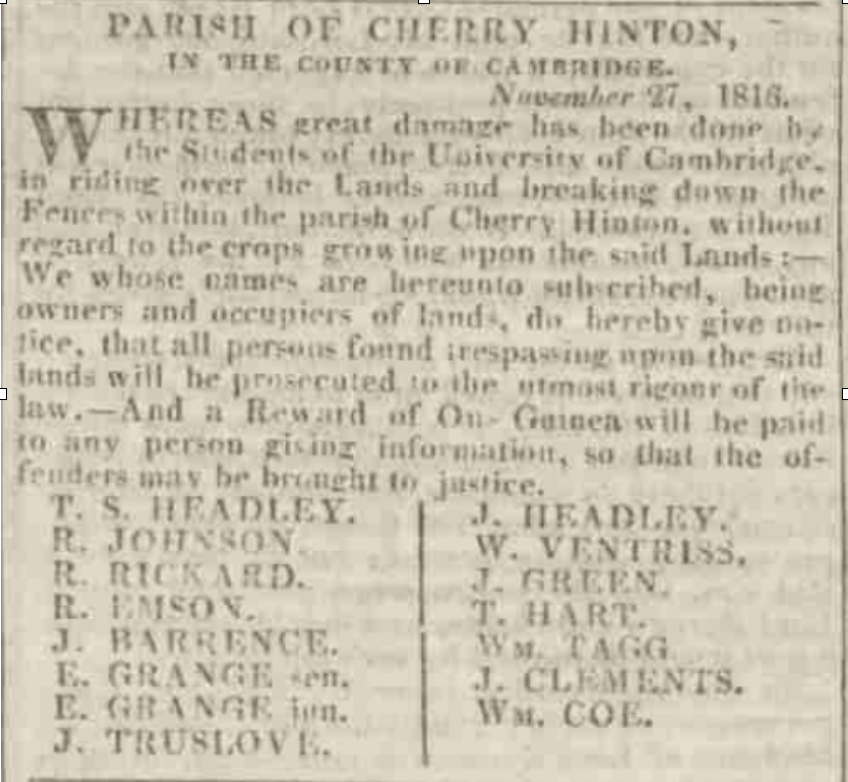
By 1841, On the 1841 Census for Cherry Hinton, we can see that there are three separate Coe households:
Matthew Coe, aged 45, gardener, with his wife Mary aged 40 and their children; Barron aged 19, James Barro aged 17, Joseph aged 15, Sarah Ann aged 13, Jesse aged 11, Emily aged 9, Charles aged 7, George aged 5, Jane aged 3. William Coe, aged 26, gardener, with his wife Charlotte aged 26 and their children; Gabriel aged 7, Arthur aged 5, Walter aged 4, Sarah aged 2, n-k aged 3. William Coe, aged 50, gardener, no wife so presumably widowed, and his children; Charles aged 22, Frederic aged 20, Martha aged 15, Benjamin aged 13, Naomi aged 8, Issac aged 6.
So there is William senior, aged 50, mentioned in the previous newspaper report. William junior aged 26 above is his son. Matthew aged 45 above, is William seniors brother/William juniors uncle. They have all stated their occupation as 'gardeners', this shows that they were in the business of market gardening, and probably orchard managing by this date within the village. It is tempting to start wondering how many of their orchard trees were from the old cherry tree stock which had given Hinton its prefix of Cherry by the 1500's - it certainly leads to the thought that the village may have been a place of orchards for many generations of villagers. They could have started working the pre-existing orchards but of course, they may have started afresh.
In 1850, we then find Charles Coe occupying property in the village, in Mill End, almost opposite the Red Lion pub in Mill End Lane. The property has an orchard, this may or may not indicate the form of faming that the Coe family were to specialise and expand into, soon after with their own farm, with the creation of Lime Tree Farm. This is the Charles, mentioned on the 1841 census, aged 22, son of William Coe snr. This Charles would now be about 31 years old in 1850.
23rd March 1850 (Cambridge General Advertiser, BNA)
Interestingly, next door to the Red Lion pub in Mill End remains one of the very old cottages of Cherry Hinton and it is named 'Orchard House'. This may be because it had views to the orchards around it or just coincidental but it is still worth a consideration.
In trying to trace the branch of the family that went from gardeners in the village to owning Lime Tree Farm, it is worth looking at each of the family lines in the village, mentioned so far.
Richard Coe, the first Coe that we see in the village died in 1830 - before the census records began - leaving his surviving sons, William and Matthew, with their family branches in the village. I have been researching their tree and have the following information so far... Starting with the first son, William Coe:
William Coe, 1788-1865 (died aged 87 years old), gardener, he first married Sarah ?-1822 (nee Pryke) in 1813 and after she had died he married, in 1825, Mary (nee Pryke) 1804-1837 (died 33 years old)- probably her sister.
His children with Sarah were: William 1814-1876 (died aged 62), married Charlotte (nee Missen) in 1834. They had several children including; Gabrielle, Arthur, Walter, Sarah, Mary, Ann, William, Jane and Frederick. They are shown as living on the High Street, next to the Red Lion pub on Mill End Cherry Hinton from 1851-1871 where William is listed as a gardener. The listings suggest that they are somewhere to the east of the Red Lion, where William's cousin Joseph (Matthew Coe's son) is living. This could be to the back area of the Red Lion on the High Street, where the post office area is today or on the other side of the road somewhere [edit: could be the cottages mentioned later in this article that lay opposite where the Post Office is today on the High Street - even possibly Apple Wood Cottage, which still remains today]. By 1881, William has died and his widow, Charlotte, is listed on the census as being a greengrocer, living in the next household from George Coe (Matthew Coe's son and her nephew) who was running Lime Tree Farm. So after William's death, Charlotte, along with her daughter Ann, goes to live and work, on or next to, the site that became Lime Tree Farm, on Cambridge Road (now Cherry Hinton Road). Charles 1818-1873 (died aged 55). Charles married Ann (nee Sizer). In 1851 he is listed as a gardener in Cherry Hinton. In 1861, again listed as a gardener, it is shown that he is living with his wife and children in Mill End Road - so as you can see this now tally's with the 1850 newspaper report shown above. By 1871, they are living in Russell Court, Cambridge, where he is still listed as a gardener. He had several children, including Elijah, Ann, Charles, William, Sarah and Jonah. Frederick 1821-1867 (died aged 46) - Frederick is shown working as a gardener at Hinton Cottage in Cambridge. In 1851 he then marries in 1855 Sarah (nee Beales) and they live in Cherry Hinton. In 1861 he is shown as a farmer/gardener employing 2 men and living, with his wife, on the Fulbourn Road to Cambridge. (* Cherry Hinton Road, as it is today, is referred to most often as Cambridge Road, also Fulbourn Road in the older census) They have 2 servants, one a farm servant and one a house maid. They do not have any children. [edit: if you scroll down to the 1883 map below, you'll see a building named Hinton Cottage, this is where Frederick and his family were living in 1851 until his death. It is just to the west of what became the Lime Tree Farm site and the next house along from Provident Cottage, occupied by Mrs Coe]. His children with Mary were: Martha 1825-1898 (died aged 74) - Martha married James Morley in 1853 and they both moved to 63 East Road in Cambridge, where they remained until their deaths. James was a shoe maker and Martha a Laundress. They have no children. Mary 1836-1868 (died aged 42). In 1844 Mary marries James Banyard, an agricultural labourer, they have several children and in 1851 are shown as living in Barron Lane (now gone) in Cherry Hinton. Benjamin 1828-1869 (died aged 41) Benjamin does not marry or have children - you can read more about Benjamin's tragic death below. Naomi 1833-1877 (died aged 44) - Naomi married Joseph Darley and agricultural labourer. In 1861 they are living in the High Street. Then her husband Joseph is listed as a widow in 1881, living in Fishers Lane. By 1891 he is living in the Almshouses (which are opposite the Red Lion pub in Mill End). They do not have children. Issac 1835-1855 (aged 18).
In 1860, we find reference to Frederick Coe, mentioned above, who is working the land on Lime Kiln Hill, this could have been general arable farming or even orchard farming but it could be that he was running a lime pit or chalk extraction enterprise as these pits were on Lime Kiln Hill and very popular at this time.
5th May 1860 (Cambridge Independent Press, BNA)
However, we now know that Frederick was listed as a gardener at this time (1860/1861), so managing the orchards which were on Lime Kiln Hill at the time is most likely.
Then in 1869, comes the tragic news of the death of his brother Benjamin Coe:
20th November 1869 (Cambridge Independent Press, BNA)
It is worth noting that on the 1861 census, prior to Benjamin's death, he was also listed as a gardener and no mention at that point of him working at the lime pits, which puts me back to wondering if he and his brother Frederick did indeed manage or own one themselves. However, although Benjamin is found dead in one of the lime pits, it was not an accident whilst at work, as it states he was 'reliving nature' on a Saturday night, not that he worked at the lime pits.
Ultimately this brings an end to William Coe's family line for being the ones running what was to become Lime Tree Farm on Cherry Hinton Road. To find out which Coe line did manage the farm, we must now turn to his brother Matthew Coe, to see what happened with his branch of the family.
The question is, with so many of them being listed as gardeners - how many of them were actually working on Lime Tree Farm whilst living in the village - it is certainly a family occupation. How many of them held orchards or market gardens elsewhere or independently?
The second son, Matthew Coe:
Matthew Coe, 1791-1870 (died 79 years old), gardener, he married Mary (nee Barron) in 1820. In 1841 Matthew is listed as a gardener in Cherry Hinton but then in 1851 we find Matthew is listed as living on Cambridge Road (now Cherry Hinton Road) and that he is a gardener of 9 acres! Add to this that the next property along on the census is Park Gate House - which is the lodge house to Cherry Hinton Hall, which was next to Lime Tree Farm - now means that we have our first clear piece of evidence that the site of Lime Tree Farm was in existence by 1851 and in the occupation of Matthew Coe! (*The farm may have been called something else or just Coe's farm, or could have been named Lime Tree Farm from the start but the earliest documentary evidence of the name Lime Tree Farm, the I have so far, isn't seen until 1901).
Matthew's children with Mary were: Barron 1822-1865 (aged 43). Barron married, in 1843, Maria (nee Rowell) and had several children including: Maria, Mary Ann, Jesse, Matthew, Barron and James. In 1851, they were living on Ely Road in Chesterton, Cambridge, where Barron was listed as being a gardener. By 1861, Barron and his family have moved back to Cherry Hinton and are living on the High Street where he is still listed as a gardener. James Barron 1821-1913 (92 years old). James married, in 1860, Mary Ann Darby. Mary is a laundress. They had several children including Alfred, Daniel (who was also a gardener), Naomi, Lilly, Florence and George. They lived on Fishers Lane for most of their married life, where James is listed as a market gardener, before retiring to their son Alfred's house in Romsey, Cambridge. Joseph 1826-1898 (aged 72) marries Susan (nee Fuller) and they have several children including: Harry, Issac, Levi, Rebecca, Joseph, Matilda and Josiah. In 1851 Joseph is a publican and gardener living and running the Red Lion pub in Mill End, Cherry Hinton. 1861 he is just listed as publican, no longer gardener and is still running the Red Lion pub in Mill End. By 1871 they are living on the High Street and he is a bricklayers labourer, in 1881, still living on the High Street, he is working as a railway labourer. They end up, by 1891, living at Cyprus Place, Cambridge, where he is then listed as a bricklayers labourer. Sarah 1827-1912 (aged 85) married James Smethers in 1849. They have several children including; Matthew, Emily, John, James, Fanny and William. Her husband James is an Iron Founder. In 1851 the are living in Cherry Hinton in Grove Cottage on Ford Way (which I believe to be Daws Lane, through my other research). In 1861 they have moved to Shoreditch, London and then on to Liverpool Street, London. After James dies, Sarah remarries Robert Blinco, who is a Shepherd. They live in Swaffham Bulbeck, where Sarah remains until her death. Jesse 1830-1909 (aged 79) married, in 1852, Delilah Cornwall. They have several children including; Eliza Ann, Arthur Cornwell and George. By 1881, they are living in Hay Street, Fulbourn where Jessie is working as a railway plate layer. By 1891 they had moved to Marmora Road, Cambridge where Jessie continued to work on the railways. Emily 1832-1903 (aged 71) married Charles Short, a stone mason and they have several children. They move a lot presumably to do with her husbands job. They go from Hawkhurst, Kent in 1861 to 6, Liverpool Street in London in 1871, then on to Cheetham, Manchester by 1891, before ending up in Bootham, York. Charles 1833-1913 (aged 80) married Elizabeth and in 1861 they were living in Fisher's Lane, Cherry Hinton, where he was listed as a gardeners labourer. By 1871 they had moved to Teversham High Street, where he was still listed as a gardener. They had several children, including: Alfred, Ellen, Herbert, Zellah, Bertha, Mary Ann, Jane and Charles. By 1881 they were living in Bull's Row, Cambridge and Charles had become a railway labourer. From 1891 until his death in 1911 Charles lived at 36 Cockburn Street, where he was a railway labourer until 1901 when he lists as a bricklaying labourer. George 1837-1919 (aged 92) - George married Elizabeth Mary and they had several children including: Jesse, Herbert Matthew and Lizzie Grace. George was the son which took on the farm (site of Lime Tree Farm) on Cambridge Road, from his father Matthew. In 1871 he is listed as living on Cambridge Road (now Cherry Hinton Road) as a Market Gardener and Farmer, farming 15 acres with 3 farmers employed. He is still there in 1881, 1891, 1901 and 1911 with his wife and all at the same place, with the sons Jesse and Herbert listed as Market Gardeners too. See more on George in the below sections. It always starts to get more challenging when they name their children after other family members :) Jane 1838-1849 (aged 11). Ann 1841-1841.
I hope some of you are still with me on this... I write out as I go, to get my notes and research somewhat organised, discovering things along the way and trying to make sure I get some sort of coherent order for myself should I come back to do more delving at some point. With any luck it will be of some interest to you readers out there too.
To recap so far:
Richard Coe comes to Cherry Hinton (no records found yet of his being born here) he marries Mary Witt, a Cherry Hinton girl. They settled down in Cherry Hinton and have three children. William, their first child dies as a baby. They go on to have at least two more children - William and Matthew. Richard's son William marries twice and has several children, some stay in the village others move away and some die young. William is listed as a gardener. Richard's other son Matthew, also listed as a gardener, marries Mary Barron and has several children, again some stay in the village and some move away but his son Matthew is the first known occupier of the site that was to become Lime Tree Farm from at least 1851. Matthew's son George then takes over the running of the farm as a market gardener and lives there, until his death in 1919.
Market Gardening was a style of farming fruit and vegetable produce, sometimes also flowers, as apposed to general agricultural or dairy farming. you can read a little about it here: History of Market Gardening.
The produce was sold direct to customers, markets and restaurants. With the creation of Cambridge Road (now Cherry Hinton Road) after Enclosure in the early 1800's, the positioning of a Market Garden Farm on this road would have been most convenient to access, not only the Cambridge town market and retailers, but also Cambridge train station (and for a short while Cherry Hinton train station, when it was open) to carry produce to the London markets and retailers.
We will now start looking at Matthew's son, George Coe 1837-1919, to see what becomes of Lime Tree Farm and who next takes it over. Along the way, still including a few local articles about the Cherry Hinton branches of the Coe family.
This next newspaper entry in 1878, refers to Matthew's son George Coe....well... hmm :)
6th April 1878 (Cambridge Independent Press, BNA)
As stated previously, George Coe married Elizabeth Mary Veil and they had three children, Jesse, Herbert Matthew and Lizzie Grace. George was the son which took on Lime Tree Farm from his father Matthew. Of George's children, it is Jesse and Herbert who are still living at the farm and listed as Market Gardeners in 1911.
The daughter, Lilly Grace marries first Jack Bass who dies in WWI 16 Aug 1918 in France and Flanders. A good while later, she remarries to Walter Kester and they go on to live in Hills Road, Cambridge. We'll look at Jesse and Herbert Matthew next to see which one takes on the farm, after George's death. But before that, a bit of a catch up on other Cherry Hinton based Coe family news to bring us up to date to Jesse and Herbert.
In 1880, we find a newspaper article describing the robbery of fowls from Mr George Coe's premises (Lime Tree Farm).
October 16th 1880 (Cambridge Independent Press, BNP)
The earliest map, showing the site of Lime Tree Farm, that I currently have, is from some sale particulars of land that is being sold, in Cherry Hinton, by the trustees under the will of John Okes, Esq. - John Okes was the owner of Cherry Hinton Hall, the Hall was built in the 1830's, after John Okes had taken advantage of the land sales post Enclosure. He died in 1871 and most of his land then went into the hands of Cambridge University and Town Waterworks Company (which his brother Richard Okes was part of). John Okes had previously purchased the land needed for the building and laying out of Cherry Hinton Hall, along with a good amount of other plots within the parish. (I will do a separate blog on John Okes and Cherry Hinton Hall, I am also writing the History of Cherry Hinton Hall which will be published in book form shortly.) After his death, many of these plots were put up for sale, as you can see from the map below, on the coloured and numbered lots. The advantage to this is that we now have a good picture of the Lime Tree Farm site.
Below, I have placed the same map again, with some annotations, so it is easier to see what and where we are talking about. The area circled in red is in the Coe family land and property. At this point, 1883, you can see the site of what is to be called Lime Tree Farm. The earliest reference that I have found, naming the site Lime Tree Farm is on the 1901 OS map. I've marked the Coe farm buildings in red. In 1883, we can see that there are three buildings on the northern side of Cherry Hinton Road and one on the southern side. Bearing in mind the purpose for which this map was produced - to show sale plots, always be cautious and remember that not all detail is always shown. However, that said, this map does give a fairly good picture and we can clearly see the extent of the Coe's nurseries and orchards at this point, marked on the map by name and the tree pattern.
If you look at the building on the southern side of the road, marked Mr George Coe. You will see that the trees within this plot are marked as being much more uniform in their layout to those across the road. This would suggest to me that this is a more recent plot or orchard trees, than that of those over the road. It is a deliberately laid out orchard, where as trees on the northern plots are a little more scattered. As for the 4 buildings in total, this is interesting because, as many of us locals may remember, from the time Mr & Mrs Coe (Cyril & Eileen) had their shop at Lime Tree Farm, there was one house and some barns out the back. So this begs the question, which one of these buildings remained as the main Coe family house, the one many of us had been in to buy things from, in living memory. We can not be totally sure which of these four building shown were occupied as dwellings by the Coe family or which may have been farm workers cottages or even which may have been large barns. We can see that there is a building named Providence Cottage and marked as though Mrs Coe owns/lives there. Next to that, abutting the main road is another building unnamed and then follows a third building marked Mr Coe. The main nursery, which became Lime Tree Farm lays out the back of these buildings. Over the road, we have the more formal orchard lay out belonging to Mr George Coe and an unnamed building. (Edit: now known that Fredrick Coe lived with his family, from at least 1851 to his death in 1867, at Hinton Cottage, the next house along to the left from Provident Cottage, shown below. Hinton Cottage stood between Laundry Lane and Derwent Close, on Cherry Hinton Road, where there are now a set of 20th century houses).
Remember that Matthew Coe had been first on this site, on the northern side of Cherry Hinton Road, from at least 1851. Matthew Coe dies in 1870, leaving his son George managing the whole operation. So when we look at this map in 1883, what we are seeing is a site managed by George Coe.
Take note of the the two lots, 5 & 6, which are to be sold and which I have marked in yellow. We will come back to those shortly. First of all, I'd like to just place those 4 buildings, which I have marked in red above, on a modern map to see which one became the Lime Tree Farm house that many of us knew before it was pulled down about 15 years or so, ago.
I have marked the same red buildings that I marked on the 1883 map above, again marked in red on the overlaid 1970's OS map (blue buildings are some of the 1970's buildings) to see roughly where they once stood.
Providence Cottage, which was shown as in occupation of Mrs Coe in 1883, top left of the picture, was demolished when the Derwent Close estate was built c.1960's. any remains are now beneath the road and in the gardens of the houses that now stand there.
The next red building along, moving right on the picture, is again beneath more housing. Now Coe's Court.
Coe's Court, where the second red building stood (barns):
The top right red building, which was marked Mr Coe on the 1883 map, has the building, probably extended and altered somewhat, which us locals knew as Mr & Mrs Coe's shop/Lime Tree Farm.
The 4th red building shown on the southern side of Cherry Hinton Road on the 1883 map and marked next to the orchard plot George Coe, became the site of the old transport depo by the 1960's and is today the Army/TA Centre.
So it appears that it is the top right red building, on the 1883 map, that remained the longest and became the main house.
The next thing I'd like to do is have a quick look at the 1881 census for Cherry Hinton again, to see if we can now place who was living where, out of these 4 buildings and if they were all dwelling houses.
There is no one living in the building on the southern side of the road - suggesting that it was some kind of large barn perhaps. There are three Coe households on the 1881 census, which we can tentatively say correspond to the three buildings. The first building of Providence Cottage has Fredrick Coe - engine driver, with his wife Mary and their children Frederick, Mable, Alice and Arthur. (*Note that this is not the Frederick who had lived in Hinton Cottage because he died childless in 1867. This is Frederick who's mother is mention next). Next along we have Charlotte Coe (widow) greengrocer, with her daughter Ann and grandchildren Nellie and William Reynolds. - although I'll note here now, that I think that it is quite probably that these two listed households of Fredrick and Charlotte's may well have all been within Providence Cottage and that the second red building along, unnamed were barns or such like (not least because I remember playing in those barns when I was young.) Then on the 1881 census, in the third red building on the northern side of Cherry Hinton Road, to the right on the maps above, marked 'Mr Coe' on the 1883 map, was George Coe, market gardener aged 45 with James Shyles, agricultural labourer and servant. This building being the most likely candidate for the original farm house that George's father, Matthew had occupied.
So back to that sale map of 1883 - do you recall the yellow lined plots 5 & 6 that I said we'd come back to? Have a quick peep at them again and then look at the map below from 1885.
Firstly, here are the two lot descriptions given with the 1883 sale map, for lot 5 & 6.
The later OS map of 1885 shows us the site of Lime Tree Farm and the extent of its land and orchards at this date. You will be able to see on the annotated version beneath, that George Coe purchased lots 5 & 6 and even another plot beyond those in a separate sale and turned them all into orchards, as demonstrated by the uniform pattern of trees on the map.
Lot 6 is today where the BP garage is (* as explained in a later blog about Cherry Hinton Hall, the western end of the Hall grounds were sold off in the late 1800's and the Walpole Road estate was eventually built on that patch).
Lot 5 became the Glenmere Close estate. The orchard area to the right, which Coe also purchased (or potentially just rented) became part of Netherhall Lower School front playing field (I can remember playing hockey on that field!). This plot is now under the houses of the Bosworth Road estate.
The black dotted line that I have placed on the map above shows, where today, the passageway that leads from Cherry Hinton Road to the gates of what was Netherhall Lower School, now the Queen Emma School, still remains. Many of us locals will remember going through that passage to either get to school or the Netherhall Youth Club building that once stood on the school site. It is still a popular through route for people living on the Gunhild/Queen Edith's sites to get through to Cherry Hinton Hall and generally just a good cut through, when on bike or foot.
The passage-way between Cherry Hinton Road and Queen Emma School/Gunhild Way, running between what was two of Mr Coe's orchards:
Let's continue down the time line, at what event's were recorded.....
In 1894 - we can see that Cherry Hinton had a Cottage Garden Society, in the article below, of which the Coe family were part of:
July 20th 1894
FLOWER SHOW The fifth annual Show of the Cherry Hinton Cottage Garden Society was held yesterday in the grounds of Cherry Hinton Hall. The weather though threatening at first, was very fair. The Cherry Hinton brass Band played a selection of music during the afternoon and evening. The exhibits were arranged very tastefully in a large marquee. Dr Lyon's fuchsias and geraniums were especially worthy of notice. The judges were Mr. Missen, Fulbourn and Mr A. Coe, Cherry Hinton... (Cherry Hinton Chronicle, E. Filby)
In 1888 at a village meeting, Daniel Coe is appointed constable for the year - this is repeated several times over coming years. Daniel Coe is Matthew's grandson (son of James Barron Coe). See newspaper article below:
30th March 1888 (Cambridge Independent Press, BNA)
In 1888 mention of Widow Coe is made, occupying a cottage in the village. I wonder which one it is referring to - I'll try and find out at some later point - see below:
10th August 1888 (Cambridge Chronicle, BNA)
Decided to have a quick look at the 1881 census to see if there was any correlation of the names mentioned above in that article, with households living next to, or being listed next to one another. There is. We can see that on the High Street Cherry Hinton, in 1881, there are the following families in listing order: Jackson, Merry, Coe, Tabour and then Farrent. All apart from Tabour, matching a few of the names shown above in the article from 1888. So the cottages mentioned above are likely ones that stood on the High Street.
I think I know where these cottages stood...potentially. Some years ago I was arriving at a Cambridgeshire Association for Local History committee meeting in Cambridge Central Library, when as soon as I got in the door, Mike Petty (our brilliant Cambridgeshire Historian) collared me and said, get down to the market (Cambridge) now, there's a painting of Cherry Hinton that is not in the Cambridgeshire Collection and I haven't seen it before. Go and buy it quick! I duly got down to the antiques stall on the Cambridge Market and found the painting in question. Trouble was they wanted £80 for it, which was a lot to me then, anyway, I forgo my bill money and got the painting quick. Later once home, I studied the picture to work out where the view was in the village. I then had a few A3 copies of it made, deposited a copy in the Cambridgeshire Collection and Cherry Hinton Community Archives and then door knocked on a few of the doors of houses, which were stood at the site of the where the buildings in the picture were shown, and sold a few of the pictures to get back some of my bill money. The original painting now lives with Mr David Taylor, chair of the Friend's of Cherry Hinton Hall.
Here is that picture:
This is a view painted from what was part of the village green in Mill End (a Funnel green), where the Indian Restaurant now stands (previously The Unicorn Pub) looking down the High Street towards the Robin Hood. The buildings in the centre of the picture, above the head of the lady, are the old Robin Hood pub - the tall trees beyond are the start of The Spinny and the quarry on Lime Kiln Hill. The area to the left of the lady (our right as we look at the picture) is where Giants Grave and the village green extended to and which the post office and laundrette now stand on. The road branching off to her left is Mill End Road. The pub sign that you see is a sign for the Red Lion pub which is down Mill End Road and was to direct travellers down the road, as they could miss it if they carried on up the High Street. The building standing on the green is most likely the village pound or a storage building (it is not to say that the Unicorn pub isn't there behind our view at this date but it is not the pub itself).The row of cottages on the left of the painting, you can in fact still see the remains of today if you look carefully. The only fully remaining one of these cottages today, which is again behind us in this view, is Applewood Cottage by the recreation ground.
Below pictures of Applewood Cottage and Applewood Close (note the name - does it relate to more of Coe's orchards or just coincidental.) Mrs Coe, mentioned in the news article above, lived along here, maybe in what became Applewood Cottage or one of the buildings shown on the old painting. Note that the style of Apple Wood Cottage is the same of those as in the painting.
The three pictures below show the remains of the cottages, shown in the old painting, that you can still see for yourself today and are in the garden walls of the houses that are there now - you can even see the old doorways if you look closely. The first photo on the left, below is looking across the road from the Post Office on the High Street. Look at the middle photo, look closer in the front garden wall and you'll see the original cottage wall and a now bricked doorway. 3rd photo on the right shows more of the old brick work from those cottages - one of the Coe families houses? Go and have a look when you get chance yourselves :)
Let's continue onward with looking for the Coe's of Cherry Hinton and Lime Tree Farm....
The first real hint, within the newspapers, of the Coe family being involved and keen on growing a variety of market garden produce, comes with the report in 1890 of the Cherry Hinton Flower Show, where the produce shown by J Coe include such vegetables as turnips, potatoes, onions and beans....(which J Coe though?- probably Jesse?)
1st August 1890 (Cambridge Chronicle, BNA)
In 1891, George Coe is mentioned in the sale of some land, - see below - which is not on the site that became Lime Tree Farm but shows that the Coe family were very much part of the village by this point, working the land and being involved in village activities. For example, within meeting reports we find that various members of the family are involved with both the Conservative Club and others with the Liberal Club.
18th July 1891 (Cambridge Independent Press, BNA)
In 1894, we find a Mr Frederick Coe listed, who is a market gardener and farmer. The report however is from the village of Histon, to the north of Cambridge, not Cherry Hinton. It refers to a bad accident that Mr Coe had. But how likely is it that this Coe is related to the Cherry Hinton Coe family? - I don't have him on the Coe family tree yet but it is a very likely possibility that this person, given his profession is part of the same extended Coe family. I will come back to him another time and add to the end of this blog, any links that I discover about this branch of the family, - which is worth looking into because this particular Frederick Coe was born around 1824 in Impington, Cambs. Perhaps we will discover a link to where the first Coe in Cherry Hinton (Richard Coe) came from, perhaps the original family hailed from those parts in the first place? and if you are a Cambridge person you'll know what one of the main occupations Histon became well known for... The Chivers fruit farm and factory, which almost every one in Cambridge of a certain age range can remember working for, or a family member working for at some point - my granny Toller did - I wonder.... given the nature of the Coe's farming if there is any link to what became Chivers... see this is the trouble! A whole new thread to follow and what starts out as a little blog on Lime Tree Farm becomes the start of a book ..... As tempted as I am to go off with this new exciting hint... I will stay in Cherry Hinton for now and maybe add on something at the end of this if I find out more - or I'll just do a separate article on it.
17th August 1894 (Cambridge Chronicle, BNA)
In 1895 we find reference to Arthur Coe as a gardener - most likely Jesse and Delilah's son. If so, this incident occurred on Lime Tree Farm site, as Jesse is shown on the 1891 census, living there at this time.
12th April 1895 (Cambridge Chronicle, BNA)
1899 and more evidence of the family enjoying village life with John Coe playing the cornet in the Baptist Chapel on Fishers Lane. John is one of the Coe grandchildren, somewhere along the line.
4th April 1899 (Cambridge Daily News, BNA)
The William Coe mentioned below is probably Charles Coe's son.
18th October 1891 (Cambridge Independent Press, BNA)
1901 - on the 1901 Os map below, you can see some of the changes that have occurred at the Lime Tree Farm site and the orchards. You can see that the transport depot had taken over the land directly opposite Lime Tree Farm and the dotted, parallel lines marked over the west end of the grounds of Cherry Hinton Hall were marking out where Walpole Road was to be built.
Here's an article mentioning the marriage of George Coe's daughter Lilly, with many members of the family travelling to London for the event. Sadly Jack, her husband was killed in the war, soon after. Lime Tree Farm is mentioned by name in this report.
Friday 24th September 1909 (Cambridge Independent Press, BNA)
So back to which son takes on Lime Tree Farm after George Coe's death in 1919 - Jessie or Herbert? From the newspaper clip below we can see that in 1917, when George Coe was very elderly, that Jesse, perhaps, is already in charge of Lime Tree Farm.
August 22nd 1917 (Cambridge Daily News, BNA)
The death of George Coe is in the papers. The 'Gracie' mentioned is his daughter Lilly Grace.
24th January 1919 (Cambridge Independent Press, BNA)
22nd January 1920 (Cambridge Daily News, BNA)
The probate record doesn't appear to show that much was left, so perhaps, at some time before his death, George had handed over the farm and estate to his son/s.
Herbert Matthew Coe:
Starting with Herbert Matthew Coe 1884-1964. Herbert marries Elizabeth (nee Wright) and they have at least one child, Gracie Elizabeth. They go to live at number 51 Fulbourn Road, where Herbert works as a market gardener with orchards of his own to the back of his property on Fulbourn Road, east of the Robin Hood pub, on the main road through to Fulbourn village. You can see the orchards shown on the 1951 OS map below. There is now modern housing on the site and one of the roads is called 'The Orchards' after Matthew Coe's orchards. (to place yourself - the Cherry Hinton recreation ground is shown top right on the map and the orchards are shown south of this. along the bottom right is Fulbourn Road and running up through the map is Cherry Hinton High Street.)
This leaves George's son, Jessie, living at and managing Lime Tree Farm.
Jessie Coe: Jessie Coe 1883-1973, marries in 1928, Elsie Coe (nee Coxall). They have one son, Cyril. Jessie is listed in the Cambridgeshire electoral records as being a farmer and fruit grower. In 1950, Jessie submits plans to the Council - 'Building bylaw plan and approval for proposed extension to farm shop and Tea Room, Lime Tree Farm, Cherry Hinton Road' (Cambridgeshire Archives: KCB/2/SE/3/9/17630). This suggests that a tea room was already in operation by this point at the site. Elsie Coe ran the tea room and small shop. Jessie and Elsie Coe live at Lime Tree Farm, with their son Cyril, until their deaths, when Cyril then takes over the running of the site.
1939 - The 1939 OS map below shows that although the transport depot is has now taken over land opposite Coe's farm, some of their orchards still remain behind it. This is now the site of the Army Reserve Centre and the back of the Glenmere Close estate.
Below are two advertisements for produce from Lime Tree Farm.
27th June 1939 (Cambridge Daily News, BNA)
12th December 1939 (Cambridge Daily News, BNA)
1950 - On the 1950 OS map below, we can now see that construction of the Walpole Road estate has taken place. The farm still has many of the original orchards that were purchased by George Coe in the late 1800's.
Cyril Coe:
Cyril Coe 1928- 2006, lives at the farm his whole life. He marries Elieen Cooke, who had been previously married and had two daughters. Cyril and Elieen then ran the shop, which was at the front part of the main house, facing Cherry Hinton Road - the one us locals remember the most.
1964 The picture below comes from Mike Petty's Cambridge News archives and it is believed to show Mrs Elsie Coe, Cyril's mother, working in the shop at Lime Tree Farm.
1964 - The aerial view of Lime Tree Farm from 1964 shows the farm in the bottom right, with Dewent Close beneath it and Walpole Road now built above it. You can see the site of the transport depot opposite the farm and the orchards continuing over the road in what was to become Netherhall School lower, front playing field.
1973 onwards...After Jessie's death, his wife, Cyril's mother, Elsie, stayed on at the farm with her son, his wife Elileen and the children. The orchard farming had ceased with the land being sold off and most of it becoming the Netherhall School lower, front playing field.
My uncle married one of Mrs Coe's daughters and as I only lived a little further down the road, on Cherry Hinton Road, I used to go and play with my aunts kids at Lime Tree Farm, where we would climb about in the old barns and hay lofts. I can remember being sent, by my mum, up the road, to go to the little shop to buy a tin of meatballs from Mrs Coe.
By the late 1990's Cyril and Eileen had moved out of the old farm house and had a new bungalow built for themselves next door. They then sold off the old house and the land behind which was once the farm. A new housing site was constructed and is named Coe's Court. Before long, all of the old barns and buildings had disappeared and with Cyril's death in 2006 and Elieen's death in 2009, the end of Lime Tree Farm and the Coe's at the site came to an end.
More pictures of Eileen and Cyril and the shop - coming soon
I have started a public family tree for the Cherry Hinton Coe family on Ancestry, to provide further information and gather more records. You can view it here:
Coe Family Tree
I hope this has been of some interest and use, in particular to Cherry Hinton residents and anyone researching the Coe family tree. Every now and again, I'll come back to this and add, edit and adjust as I get new pieces of data and information. Perhaps, you may feel inspired to do a bit of research yourself, which would be brilliant! I've started listing a few things that could be looked at further, below. This is not extensive of course but just a few things, that are thoughts to follow up. Research is never done and always throws up more questions than answers :)
Further research to be done:
Where did the first Coe come from - Richard Coe, where was he born, what was his occupation etc? Which one of the Coe's first got into the market gardening business? Did they sell their produce at the Cambridge market? what about further afield? or were they wholesale suppliers? What fruits, vegetables and produce were they producing, other than those mentioned in the adverts above? Did any of the Coe's work at the Cherry Hinton Hall kitchen gardens and orchards, when John Okes was in residence (c.1835-1871) or afterwards (c.1930 - 1990) when the Council nursery was in operation at the back of the Hall, producing plants for the counties parks and roundabouts etc? Other that Lime Tree Farm, where else in the village were Coe's orchards and gardens, if any others? Did any descendants go off into other villages and towns, continuing the market gardening business, if so where and are any still running today? How many of Coe's descendants are still living in Cherry Hinton? How many of their original trees, from the old orchard plots, still remain in peoples gardens unrecognised for what they were part of? - couldn't resist having a little general look around for this one - all where plots 5 & 6 would have been and the original George Coe's orchards, shown on the 1883 sale map - see photo gallery below. There were a lot of much older cherry tree stock along with many apple trees and other cherry trees around - separating out what is modern garden planting, to what remains of any of the Coe's orchard stock and the descendant trees is a challenge that would need revisiting. Find out more about Frederick Coe born 1824, market gardener of Histon and see if there are any links to the Cherry Hinton Coe's and also to what eventually became Chiver's of Histon? Other pictures of the Coe family/Lime Tree Farm site.
Looking for old fruit tree stock, from Lime Tree Farm, that may remain today.
Below: Coe burials in St Andrew's Church Yard, Cherry Hinton. These are from the survey's and records which myself and Mr Clarke made in 2005.
Update on the Coe/Chivers connection - so, do you remember the Frederick Coe, mentioned in the newspaper article of 1894 above, who wasn't part of the Cherry Hinton Coe's but was a market gardener living in Histon? I had not only wondered if they was a link to the Cherry Hinton Coe family - still looking at that - but if there had been a link to Chivers of Histon, the famous fruit growers and jam makers...well, there is of sorts. Frederick Coe, his wife Susannah and their children live next door to Stephen Chivers, with his wife Rebbecca and their children - as shown on the 1861 census. The two families live north east of the green in Histon and Steven Chivers is a farmer and gardener of 140 acres, employing 9 men and 5 boys - it is Steven Chivers who starts the great Chivers enterprise. So they were at least neighbours, in dwelling and fields. In addition to this their family links go back a little further as Frederick's father, James Coe, also a gardener is living next door to John Chivers in 1832.
In addition to that the next thing I find out is that Frederick Coe takes a Thomas Chivers to court over damage of his market garden produce - see article below - so although it is not currently a connection in quite the way I'd imagined, it is still something worthy of note and interest.
Although this strays a little from sticking to Cherry Hinton history, I couldn't resist sharing this with you too. The article below describes a tragic incident involving James Coe, Frederick Coe of Histon's father. It struck me how, not only did Frederick witness this incident, but how we had begun our discovery of him with a near fatal incident of his own, which must have reminded him of his fathers fate.
If you'd like to support the work that I do, why not buy me a coffee, I'd be really grateful and it will help keep me going :)
©Michelle Bullivant, May 2020
The Tutton (or Tottenhoe) Way is an ancient route-way that skirts the eastern edge of Cherry Hinton old parish, now Ward, and now also forms the eastern Cambridge City Boundary.
VIDEO 1 of 3 - Tutton Way
I can, so far, trace this boundary from the northern end of Bridewell Road in Cherry Hinton where it joins Fishers Lane, following through the back gardens and the line of this routeway south, to meet up with the small passage way at the other end of Bridewell Road, that leads through on to the Back Field, where it continues on in the form of a paved footway to join Fulbourn Road. It then crosses straight over Fulbourn Road and enters the northern boundary of the Gog Magog Hills, where it travels up through a field edge as a trackway, going first alongside the eastern edge of the Peterhouse Technology Park and then continues up over the hill, in a straight line, through the fields as a wide trackway (currently closed to the public). The Tottenhow Way then meets the Worts' Causeway Road at one of the highest points on the Gog Magog Hills, where, straight across the road, it continues, for a short way, as a wide trackway named the Shelford Gap before apparently ending at the thick hedge line beyond which the Gog Magog Golf Course lays. It also meets the apparent end of the Roman Road, collectively known as Worstead Street or Wool Street. The Roman Road leads off of the end of the Shelford Gap (Tutton Way) in a south easterly direction, in a long straight line for many miles.
VIDEO 2 of 3 - Tutton Way
There is a little bit of a dirt track entrance/parking on the roadside by the start of the Shelford Gap on Worts' Causeway and barriers to prevent vehicles driving down the track but it is a popular place to start the walk down the Roman Road. However, it’s not very advisable to go there alone and there are, shall we say, interesting individual and collective, unusual activities that go on at that spot, particularly as there is a small wooded area alongside the trackway. It is not really very safe to walk up to this point as there is no real safe footpath from Cherry Hinton, so going by bike or car is currently the safest way.
From Cherry Hinton the route is taken, starting from the Robinhood at the junction of Cherry Hinton High Street and Cherry Hinton Road. Go straight over onto Queen Edith’s Way. Take the first turn on the left to drive over Lime Kiln Hill, at the immediate base of Lime Kiln Hill, where there is a crossroads. Take the next left to drive up Worts' Causeway, passing the Beech Woods on your right, continue up the hill until you reach the crest, where you will see the parking area for the Shelford Gap on your right hand side. You will be able to cross the road on foot to look north over the Tutton Way and see the spectacular views across Cambridge, Cherry Hinton and beyond. If it is a very clear day you will also be able to spot Ely Cathedral in the distance (about 20 odd miles away.)
Once you’ve finished your visit you can either go back the way you came or you can continue along the road eastwards, turning right, as you come out of the Shelford Gap on to Worts' Causway, where it then becomes Shelford Road. It will lead you over the hills, with lovely views, where you’ll also be able to see the sails of the Fulbourn windmill on your left as you make the descent down towards the village of Fulbourn. At the bottom of the road you’ll meet with Cambridge Road and mini roundabout, where you can turn left and follow the road straight back to the Robin Hood pub in Cherry Hinton.
I think, on the whole, hardly anyone today knows about the existence of the Tutton Way, other than the people who remember me talking about it when giving local history talks to groups, where I would mention it now and then. I had found out about it from reading old documents, maps and surveys from Cherry Hinton when doing my research on the village over the years. Being stuck in isolation during the lockdown is giving me chance to write up a few things that I’ve been meaning to write about for some time, including the ever-allusive Cherry Hinton Local History book that I’ve been promising to write for years. So, I thought I’d start with writing about a few of the places you can walk to or get to, for nice walks and offload some of the information and theories about the archaeology and local history of the area, out of my head and onto paper/screen, with an idea to start forming the book that I must get done.
Prehistoric Cherry Hinton Map ©Michelle Bullivant 2010
The map above, that I made some time ago, gives you an idea of some of the routeways and sites in and around Cherry Hinton during prehistoric times. I have placed the current main church building of St Andrew's on the map just to help you get your bearings. You can see the Tutton Way (Tottenhoe Way) that we are discussing, you can also see the Roman Road and the projection of its, potentially earlier route. You can also see the hillforts of Wandlebury and the War Ditches. I also mapped out the (at the time) known burial (barrow) sites, showing their relationship to the routeways. It just gives you a basic illustration of the area that we are looking at and makes the point that you can often tell ancient (pre Roman) boundaries and route-ways as they are often have barrows and other markers along their course.
At the end of the Shelford Gap, near to where it meets the Roman Road, were once two locally known barrows, nicknamed the Two Penny Loaves: "Smith's carrier's cart turned right from Fulbourn, heading south into rolling countryside. All the way it creaked ever upwards, till at the top of a ridge they reached an ancient track which was apparently an old Roman road linking Cambridge with Colchester, the way marked by two barrows, called by local people the "Two penny loaves" (Pickwick's Cambridge Scrapboook 1838, Mike Petty) "At this point, where the road returns to its original direction, there are the remains of two tumuli, called the Two- penny Loaves, one of which was opened in 1778, and seven skeletons were found at its bottom ; six of them were laid close together and parallel, with their heads pointing due north, the other lay with its head directed due west, and its feet next the side of the nearest of the six (Nichols's Lit. Artec, viii. 631)" (Ancient Cambridgeshire, by Charles Babington, Cambridge Antiquarian Society)
The picture above (with my son in the foreground and daughter climbing in the background, many years ago) gives you an idea of what Bronze Age burials mounds, or barrows as they are also called, look like. The one above is situated on Thurfield Heath in Royston, not that far away. You may often drive past them at the side of roadways and not realise what they are, a good example is of the one on the A11 as you drive towards Norwich from the 5 went ways roundabout at Barton Mills. The Two Penny Loaves would have looked something like this, standing side by side. However their fate, as with many of these barrows, was that they were excavated and destroyed, with the majority of barrows being ploughed away over the years to only occasionally be seen on aerial photographs as a crop mark on the ground. After lockdown, I will see if the Gog Magog Golf Club will let me go and have a look for the site of the Two Penny Loaves and report back to you if any sign of them remains.
One of the earliest descriptions that we have of the layout of some of the land in Cherry Hinton comes from a written survey of the Manor of Netherhall in the Parish of Hynton from 1592 (Separate articles on the Manors of Cherry Hinton and place names in the area soon). Unfortunately this survey, carried out by Christopher Saxton (you can read about him on Wikipeadia), is a written survey only with no accompanying map that we know of. This means we have to go by the written descriptions within the old open fields of the parish to work out where he is talking about.
The main open field that the Tutton Way traversed was called Quarry Field, it was a large area covering across from Lime Kiln Hill, on the Gog Magogs, eastwards to the parish boundary (the Tutton Way). Saxton gives the following description and land measurements:
"Quarry Field... The Furlong abutting the Totton Way - One piece lying in the lands of ..Junior South - 1 acre, 0 roodes, 5 dawks and 3 pches One piece laying between the lands of Uphall on the east and Gilbert Wise on the west - 0 acres, 2 roodes, 8 dawks and 2 pches" (London Metropolitan Archives, H01/ST/E/106/002) So here we see the first known written mention of the Tutton Way - spelt by Saxton, as 'Totton'
The next reference to the Tutton Way can be found in the Survey of St. Thomas' Hospital Land in Cherry Hinton, 1733 by John Tracey. (Survey of Hospital Propery at Cherry Hinton, by John Tracey, 1733. London Metropolitan Archives, H01/ST/E/107/003) which again was a written survey based within the old open fields of the parish but this time, contained three simple maps. One of which shows the route way, within Quarry Field, called Tutton Way. I'll order a decent copy of the map and place here, after lockdown, so you can have a look.
Here you can read a bit more of a very good, general overview about the Roman Road, written by my friend and colleague Tim Malim. You will see that this link takes you to the Friends of The Roman Road & Fleam Dyke website, where you can have a little bit more of a look at their take on the Cambridge Dykes. I will do a separate article or two about these and The Roman Road myself at some point soon because if I start on these now I’ll get completely side tracked and loose my focus on the Tutton Way - research is never really done!
https://frrfd.org.uk/archaeology-and-history/roman-road/
If you want to know a bit more about Wandlebury, for now, you can follow the link below, to take you to the Cambridge Past, Present and Future website, who look after the Wandlebury site.
https://www.cambridgeppf.org/wandlebury-history And more on the War Ditches can be read here, linked from the Wildlife Trust website who now manage and care for this particular site. https://www.wildlifebcn.org/sites/default/files/2018-05/East%20Pit%20Archaeology%20Report_0.pdf Again, I will write something further on both Wandlebury and the War Ditches at some point soon and post here on my website for you but I just need to focus on one thing at a time or I shall be drawn into writing great reams of theories, arguments and never actually getting anything up and published for you.
The earliest maps and surveys, that I’ve mentioned above, call the routeway the Tutton Way or Totten Way, where as I have seen it also named the Tottenhoe Way on a later map. There are a couple of possible meanings to this name – If we start with the earlier ‘Tutton’ it could be a derivative from the word ‘tot’ meaning fool or idiot, perhaps indicating a more perilous routeway – the fools way. Another thought is that ‘toten’ is the German word for ‘dead’, suitable for an ancient routeway lined with the burials of the ancestors perhaps? However, the later used name of 'Tottenhoe' makes a little more sense in many ways, as Totternhoe is a village in central Bedfordshire where the Totternhoe stone is sourced, now bear with me, as this does relate to our site in some regard – Totternhoe stone is not hard stone, it is a seam of very strong, durable chalk which was quarried in that area for use in great buildings, such as Westminster Abbey. Here in Cherry Hinton, from at least the Roman period, the strong building chalk, known as clunch, has been quarried and in turn used in such buildings as Peterhouse College and Ely Cathedral. You can see the evidence of this at East Pit off of Lime Kiln Hill, in the large open quarries there, which is only a stones through from our Tutton Way. Perhaps the name related to this strong chalk and its quarrying industry. Does the chalk seam run from Bedford through Cambridge? Burwell village, to the north east of Cherry Hinton, also used to have chalk quarries where the Burwell Rock would be quarried for building use in similar ways.
A quick google for you, rather than me spending ages going through the piles of old maps that I have here, reveals some further information, from Cambridgeshire Geological Society, which gives this latter theory more credence as being the most likely for the naming of our routeway. http://www.cambsgeology.org/565-2-3-2
If you go onto the Back Field in Cherry Hinton, at the eastern end where a passageway leads through on to Bridewell Road, you can stand on the Tutton Way as it cuts over the back field in the form of a wide paved pathway, which leads out onto Fulbourn Road. Once out onto Fulbourn Road, you will be able to see that this spot also marks the official Cambridge City Boundary, with a sign, again highlighting the importance of this ancient boundary. The back field is a Cambridge City Council owned green space which local residence use to walk their dogs and the staff, at ARM across the road, come out to have games of cricket and sit and enjoy their lunch. In the autumn there are great amounts of blackberries to be picked and in the spring the boundaries are covered in yellow daffodils. The Back Field runs from the passageway that runs into Leete Road, off of Fulbourn Road and it ends just before the hedges as you approach the roundabout at Yarrow Road, Fulbourn Road junction.
VIDEO 3 of 3 - Tutton Way
The Tutton Way can be seen in the form of an earthwork running along inside the back gardens of the houses on the eastern side of Bridewell Road. My mum used to live down the end section of this road and there was a large, clear slope running up and through her back garden which was not a natural slope but man made.
The map above (which you can see in full on the Cherry Hinton Community Archives website), shows the parish boundary marked by a dotted black line. As it stands and from what we (you and I) now know, the Tutton Way ends were it joins the old Roman Road at the end of the Shelford Gap, however, you can also see that if you were to draw a straight line from this point over the Roman Road, that the Tutton Way would lead straight into Wandlebury hill fort. I would strongly suggest that it did just that, once upon a time.
If you then follow the Tutton Way north, across the field and back towards Cherry Hinton village you come to a point where the parish boundary abruptly turns to the right, up and then to the left again, creating a off set square shape. The point at which the boundary turns is where the Tutton Way ends, as far I can tell at this time. This point is at the bottom of what is now Bridewell Road, where it meets Fisher's Lane in Cherry Hinton. The odd square actually marks out where there was once a some common land, it was called Drayton Common. It can easily be imagined that cattle were put out to pasture on the common land at this point and then driven up onto the higher ground, along the Tutton Way, perhaps in even earlier times, all the way into Wandlebury encampment itself. However, more research and on the ground field work is needed to really test out and explore if this really was the extent of the Tutton Way. It good fun to get out the maps and look on aerial views of the site and see if we can look for clues and trace the line of this old route way any further - perhaps the route continued across Drayton Common to meet at the crossroads by the church, with what is now Church Lane, the High Street and Fulbourn Old Drift? Or did the route turn at some point and join Daws Lane which runs bend Cherry Hinton Hall and was one of the old route-ways into Cambridge? etc. etc..
Below are a selection of photographs that I took of some of the records held by Peterhouse College, who owned a lot of land in Cherry Hinton. I am afraid that the pictures rea not very good quality as they were taken some years ago on an old phone or camera, so I must get back to Peterhouse to get clearer images. The pictures below cover the area around the Shelford Gap and are from the 1870's, recording what crops were grown and if they were successful etc. The important thing of note is that within the written columns Quarry Field is mentioned along with "Furlong abutting the Totten Way" - so the name was still in use for this route way around this date.
As always, research is never finished and theories evolve as more data becomes available but they must all start somewhere - an idea, a clue and most importantly curiosity. I will add to this and any other of my posts as and when I discover some new piece of information to add, in the meantime I hope this has been of some interest to you all :)
If you'd like to support the work that I do, why not buy me a coffee, I'd be really grateful and it will help keep me going :)
|
Cherry Hinton History Pages:
Contents If you'd like to go straight to a specific article or blog post within the Cherry Hinton History Page you can click on any of the post titles in the list below and it will take you directly there. Alternatively, you can use the search box above to search by keyword or you can use the index further below. About & how to use:This is the blog page for my articles, memories and archives relating to the archaeology and local history of Cherry Hinton, a village to the southeast of Cambridge UK. The area covered is the old Parish of Cherry Hinton which today includes the Ward of Queen Edith's. The Categories below are really the keyword index of what is on the Cherry Hinton History Pages. Each is a clickable link which will take you to an article or blog which contains that word or subject.
Categories
All
Archives
May 2024
|
